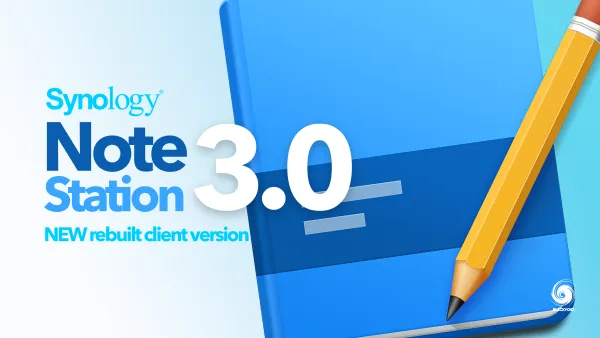Synology Beestation Plus review
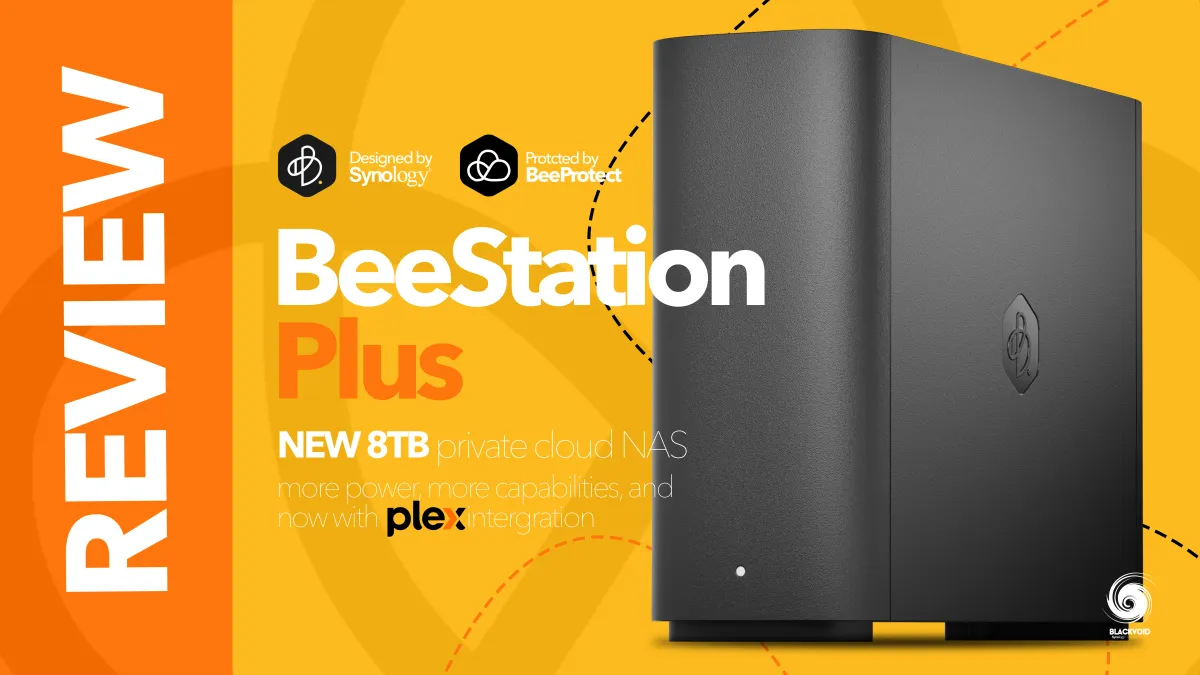
A year and a half ago, Synology introduced the original 4TB Beestation model, just six months after the successful launch of their DAS BeeDrive. The Bee series of devices was a surprising shift for a company known for larger NAS devices and enterprise solutions over the past five years. Nonetheless, the Bee lineup targets home users, teams, and professionals seeking speed on the go or a cloud replacement without hefty expenses or requiring advanced technical skills.
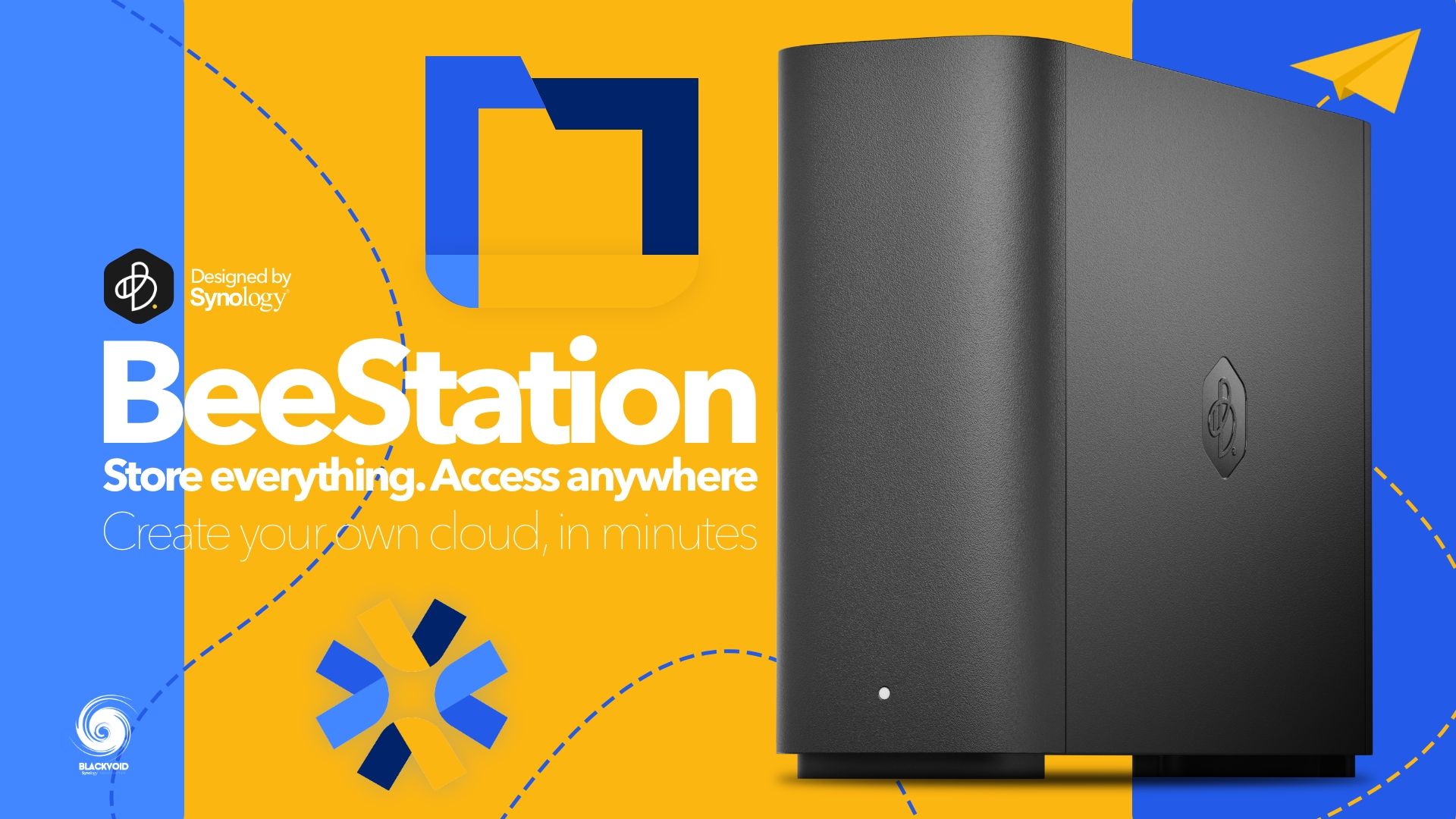
The initial in-deph review of the original 4TB Beestation
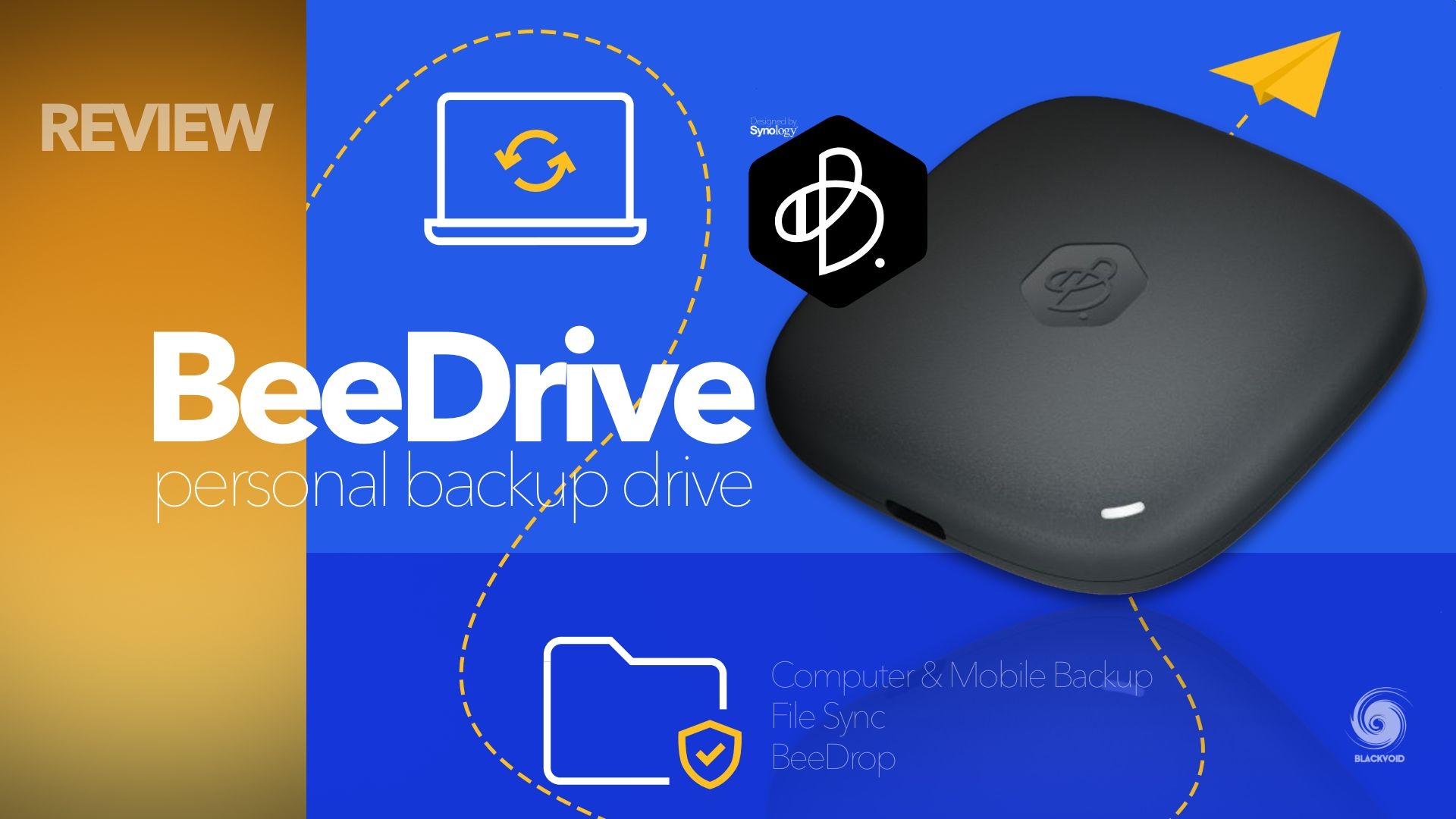
Review of the BeeDrive DAS USB device
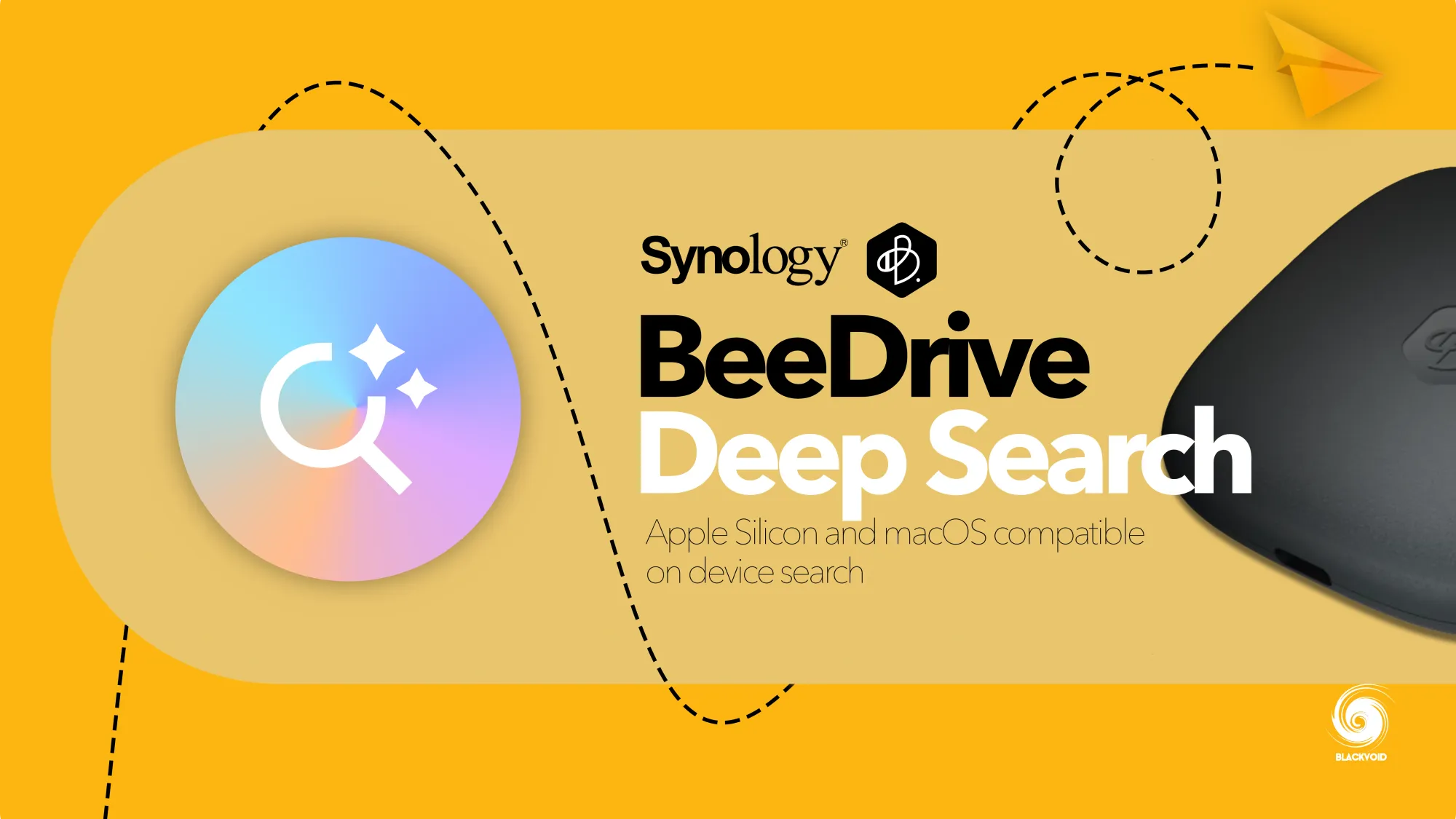
Latest BeeDrive v2.0 brings new AI capabilities for photos and documents
These pre-populated models are equipped with Synology HAT3300 drives, providing end users with a turnkey solution ready within minutes of unboxing. The introduction of the new Plus model highlights the company's commitment to this product segment, offering advanced features such as increased storage and enhanced media management for more demanding users.
BeeStation Plus is designed for data-intensive professionals, households, and small studios seeking a cloud alternative
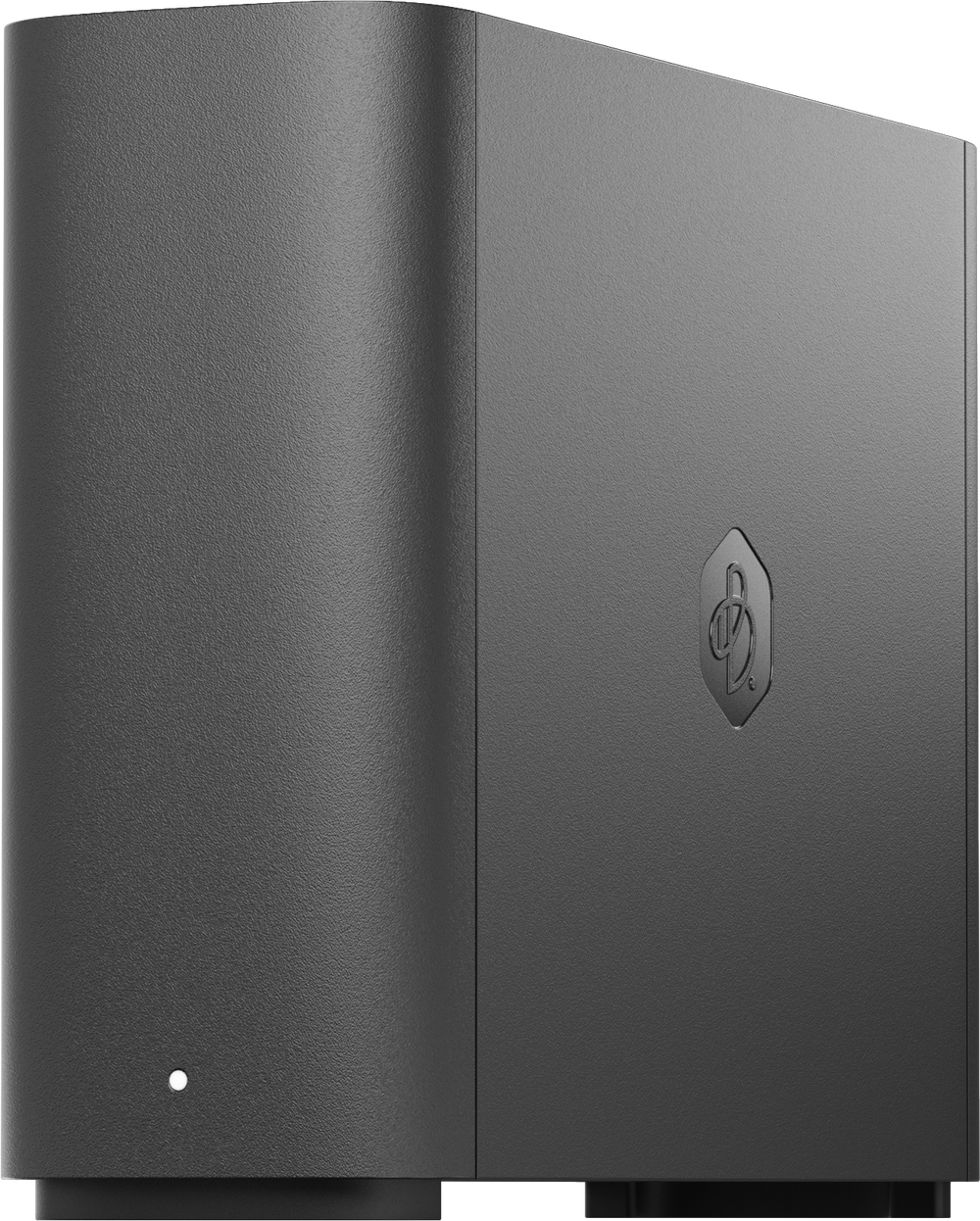
First unveiled at the CES 2024 expo, the Beestation Plus was showcased again last month during the Computex 2025 event, just a month before its official global launch.
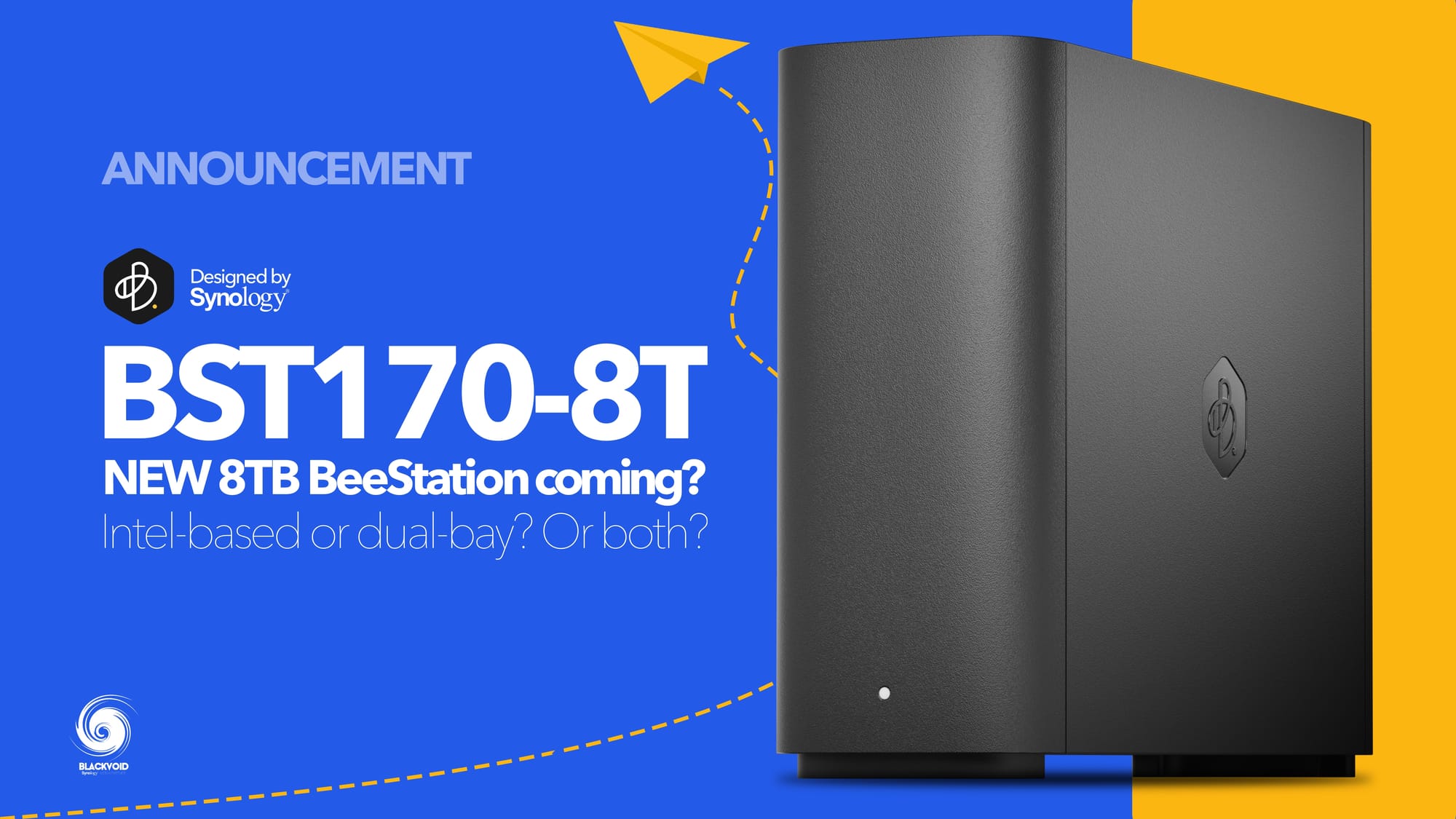
First public appearance of the new Beestation Plus
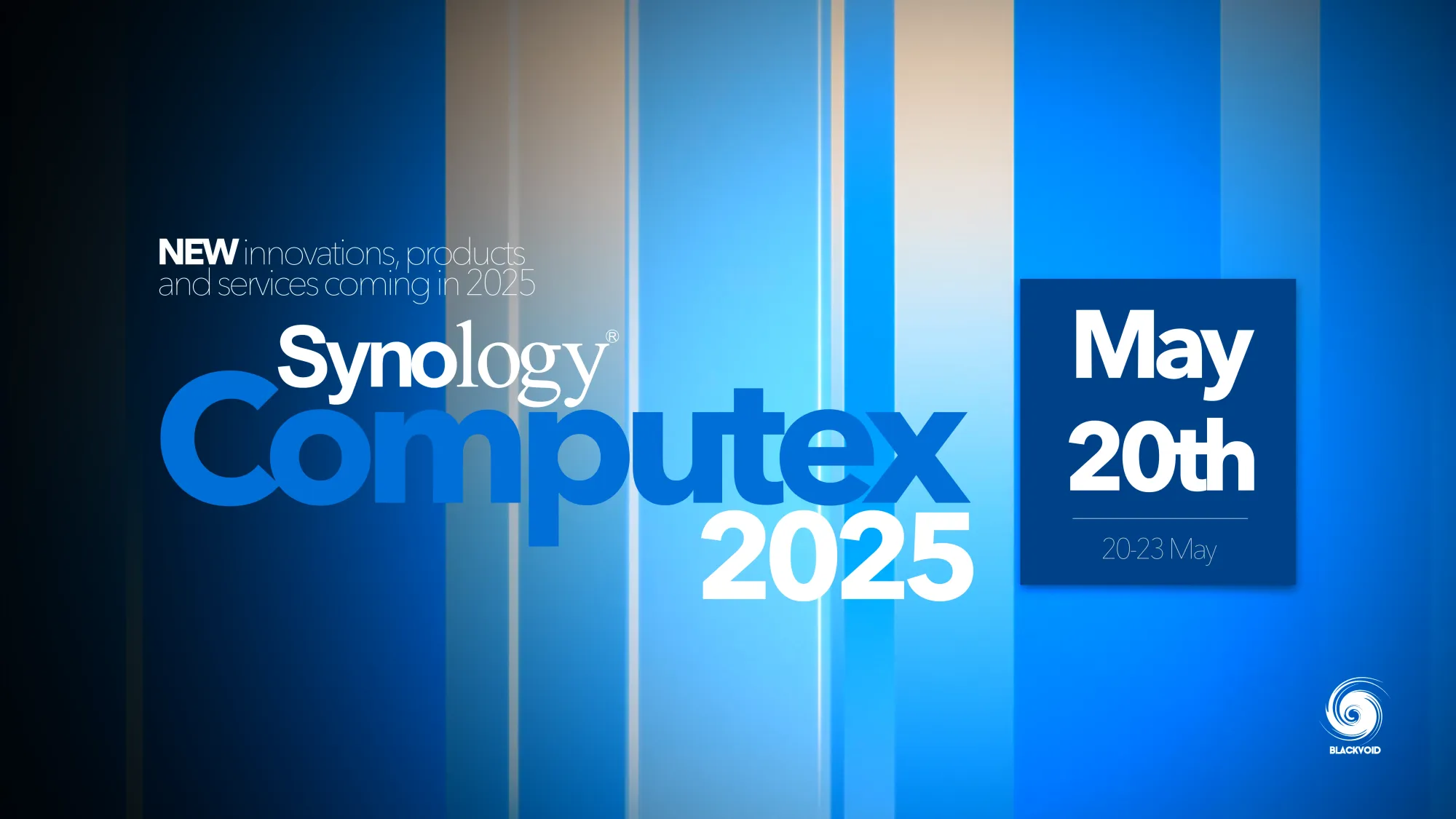
While the focus of this event was more on the new X25 lineup and enterprise segment, the Beestation Plus was also presented
Table of Contents
: Specifications
: Packaging
: Beestation vs other Synology models
: Beestation vs "public cloud" solutions
: Configuration and setup
: Backup options
: BSM, BeeFile, and BeePhotos
: PLEX - private media server
: Mobile BeeFiles and BeePhotos apps
: Conclusion
: Specifications
While the exterior of the Beestation Plus retains the single-bay enclosure and port configuration of the original 4TB version (apart from the new Graphite Silver color), the significant changes lie within its interior, thanks to hardware upgrades and software feature enhancements.
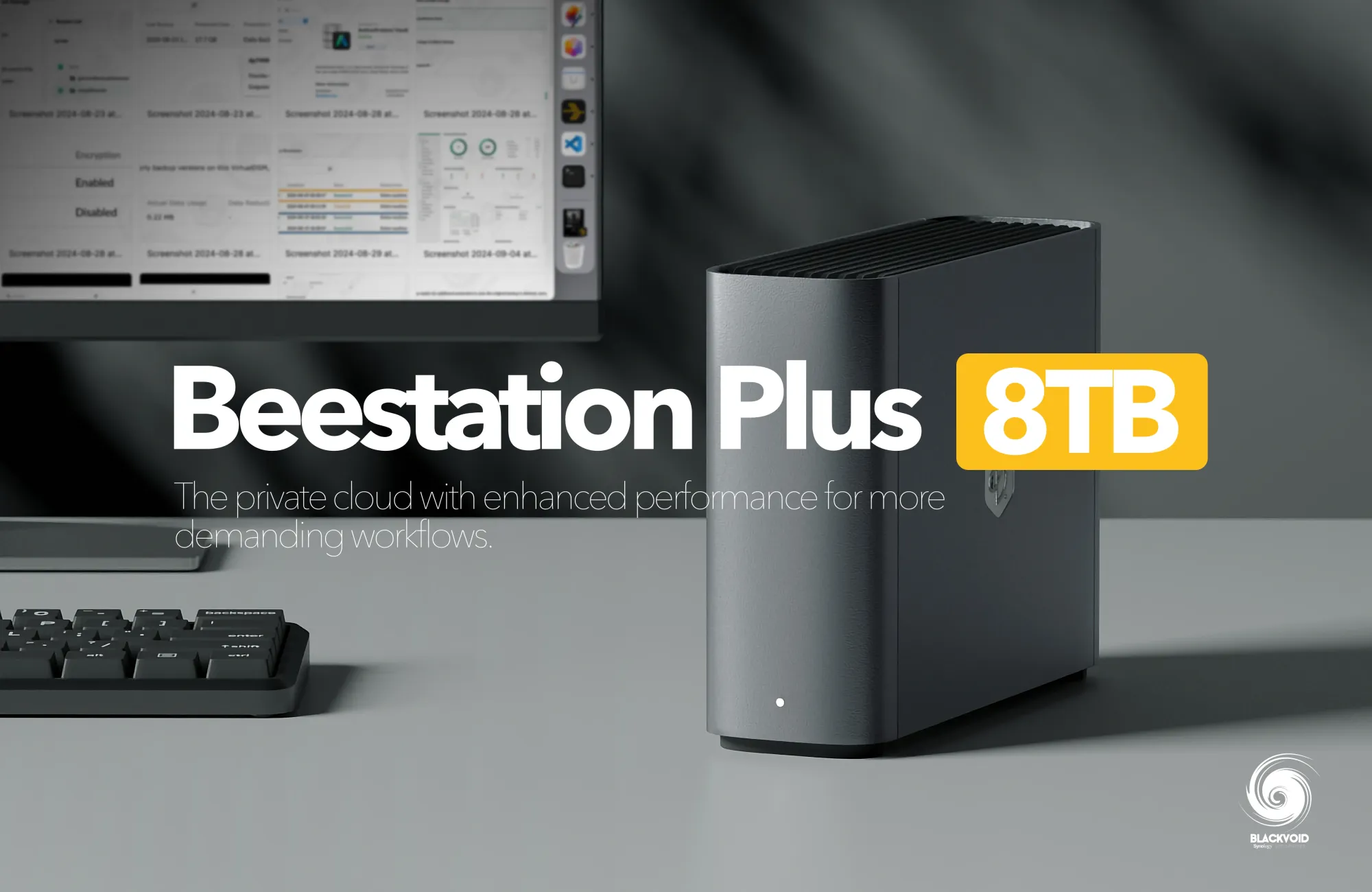
In this iteration, the Beestation switches from an ARM-based Realtek CPU with 1GB of RAM to an Intel Celeron J4125 quad-core CPU with 4GB of DDR4 RAM. Additionally, the internal storage has been upgraded: the new 8TB HAT3310 7200 RPM drive replaces the previous 4TB HAT3300 5400 RPM drive, providing a performance boost and doubling the storage capacity.
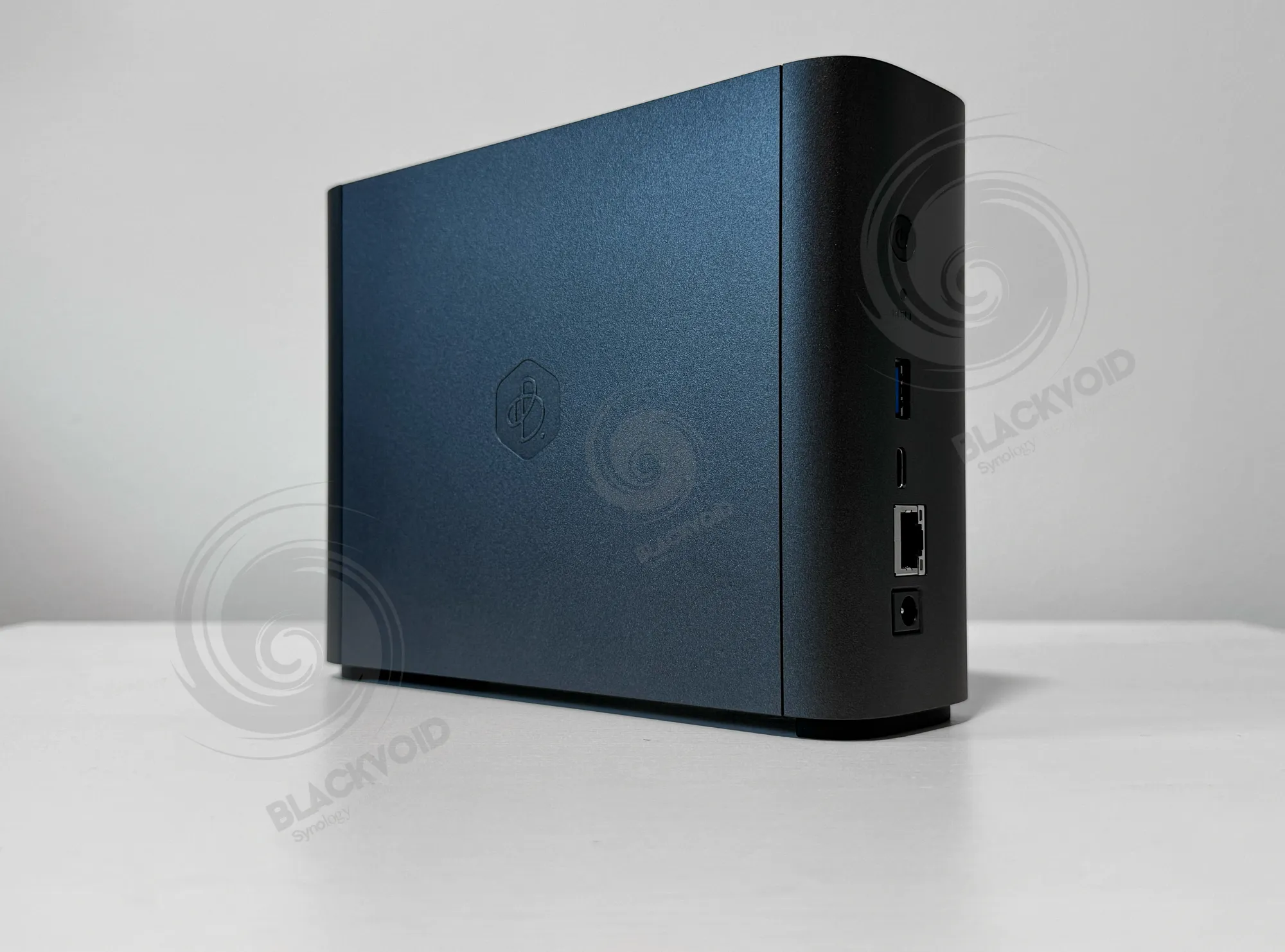

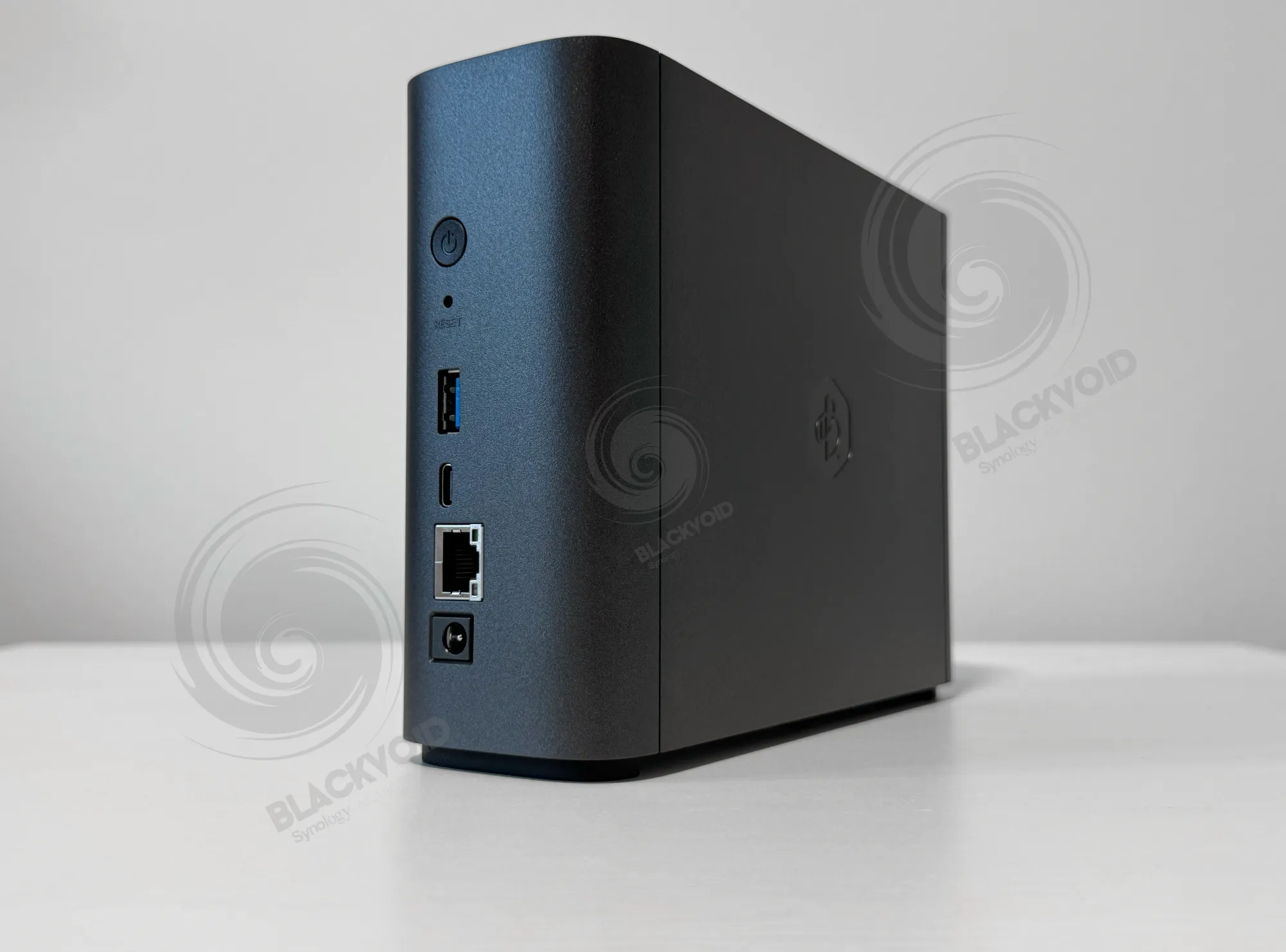
Hard plastic with a bit of a rough finish and zero fingerprints. The bottom is elevated by rubber feet that will leave enough space for the hot air to circulate
Experience high-performance, cloud-like workflows while keeping full privacy and control
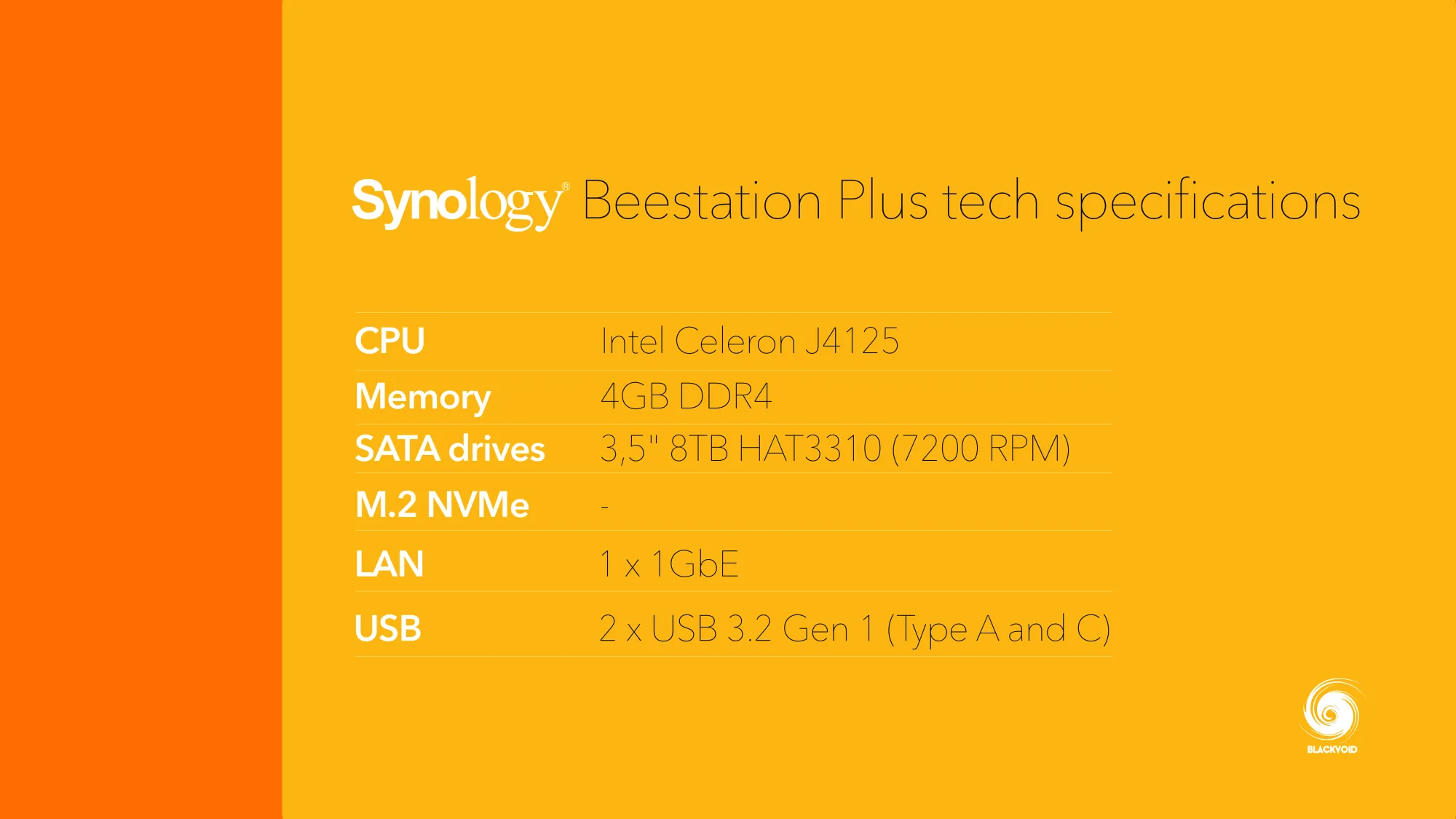
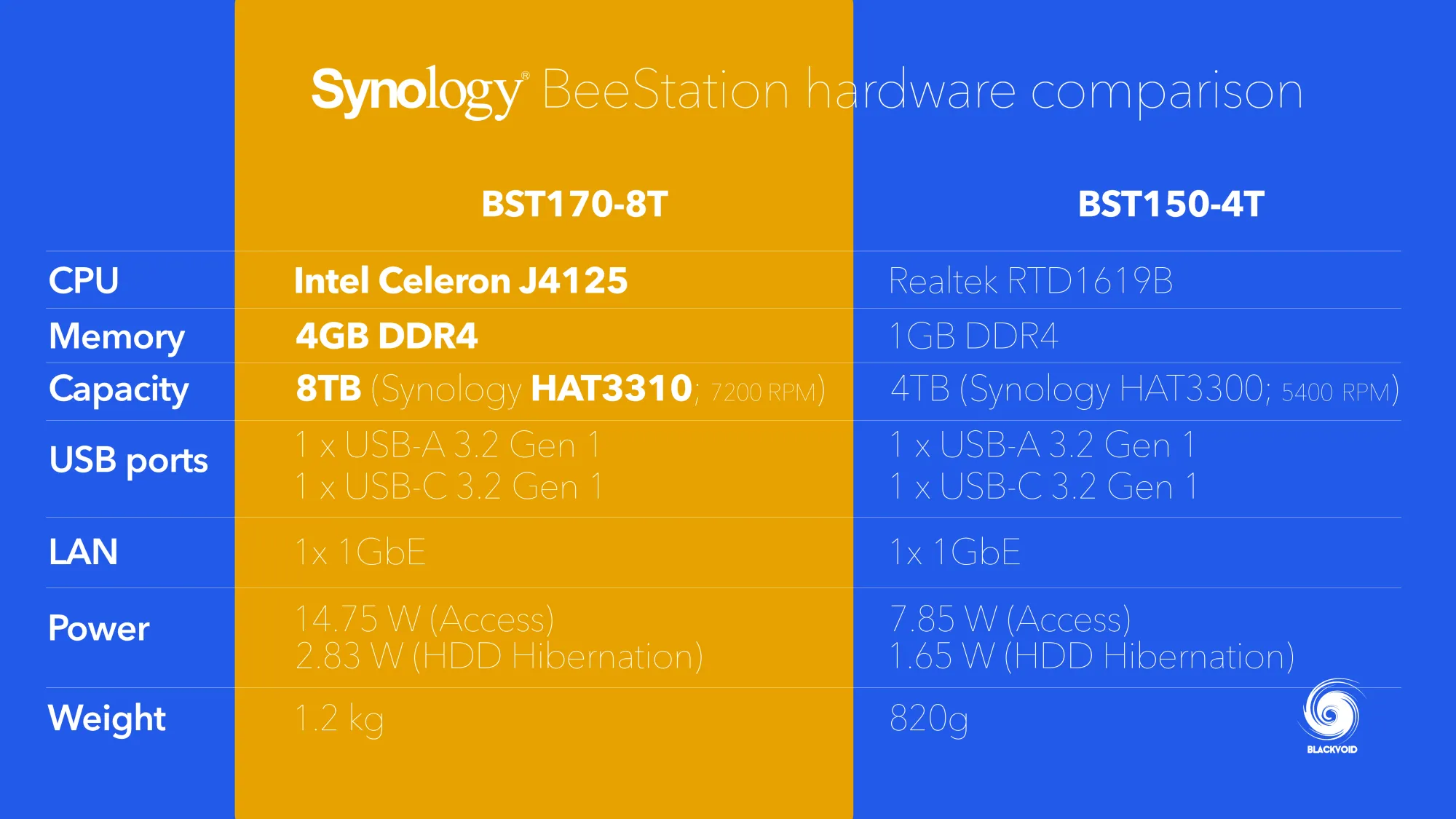
The new Plus model has an additional upgrade: active cooling. This enhancement is necessitated by the larger and faster drive, as well as the more capable CPU, which directly impacts power consumption and weight.

The device's compact format and design suggest it be placed on a desk or in a working environment. However, depending on usage scenarios, the noise—though minimal—might be a consideration. Additionally, the noise from the faster drive may be noticeable alongside the fan, so planning the device's placement accordingly would be wise.
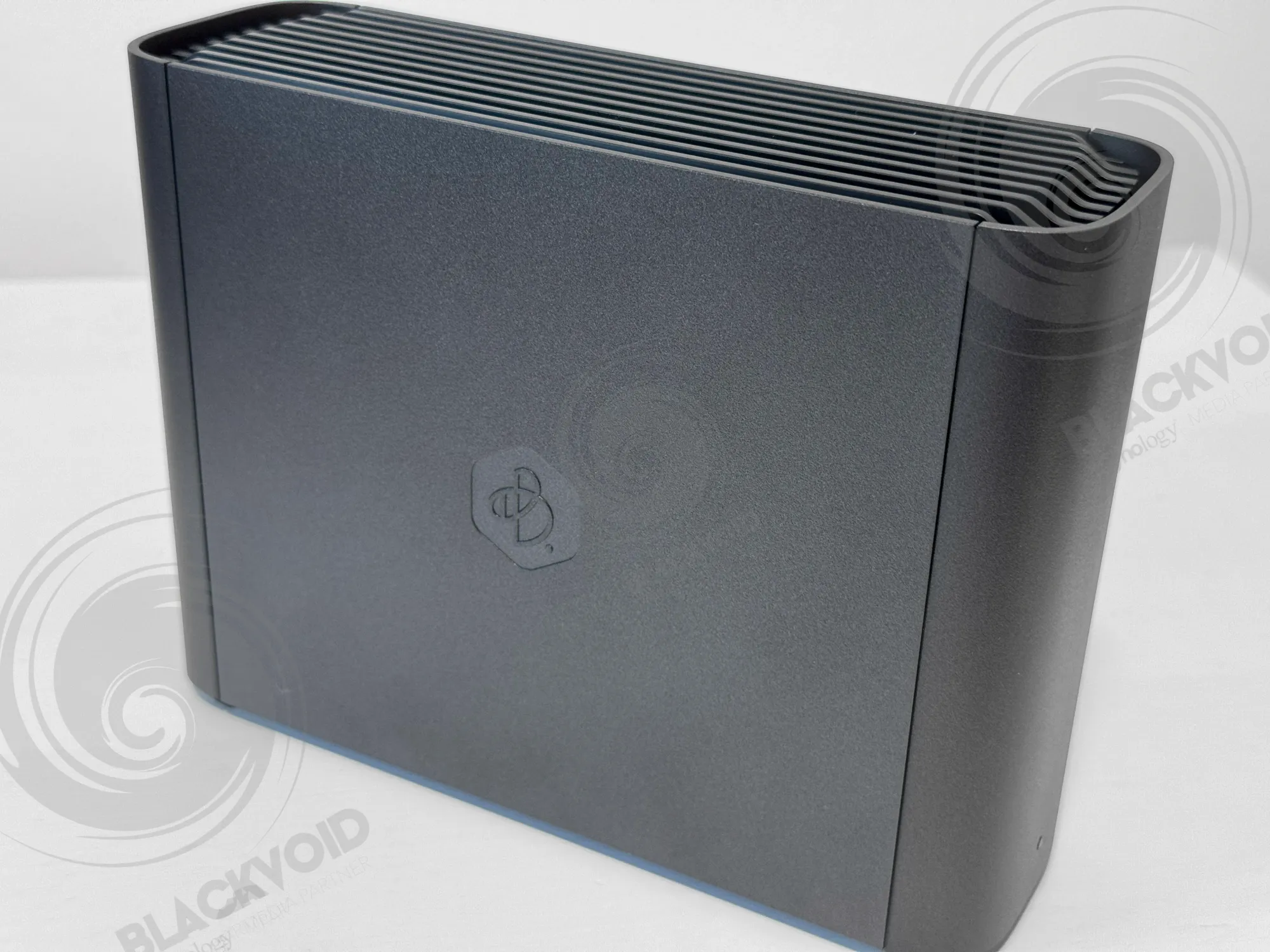
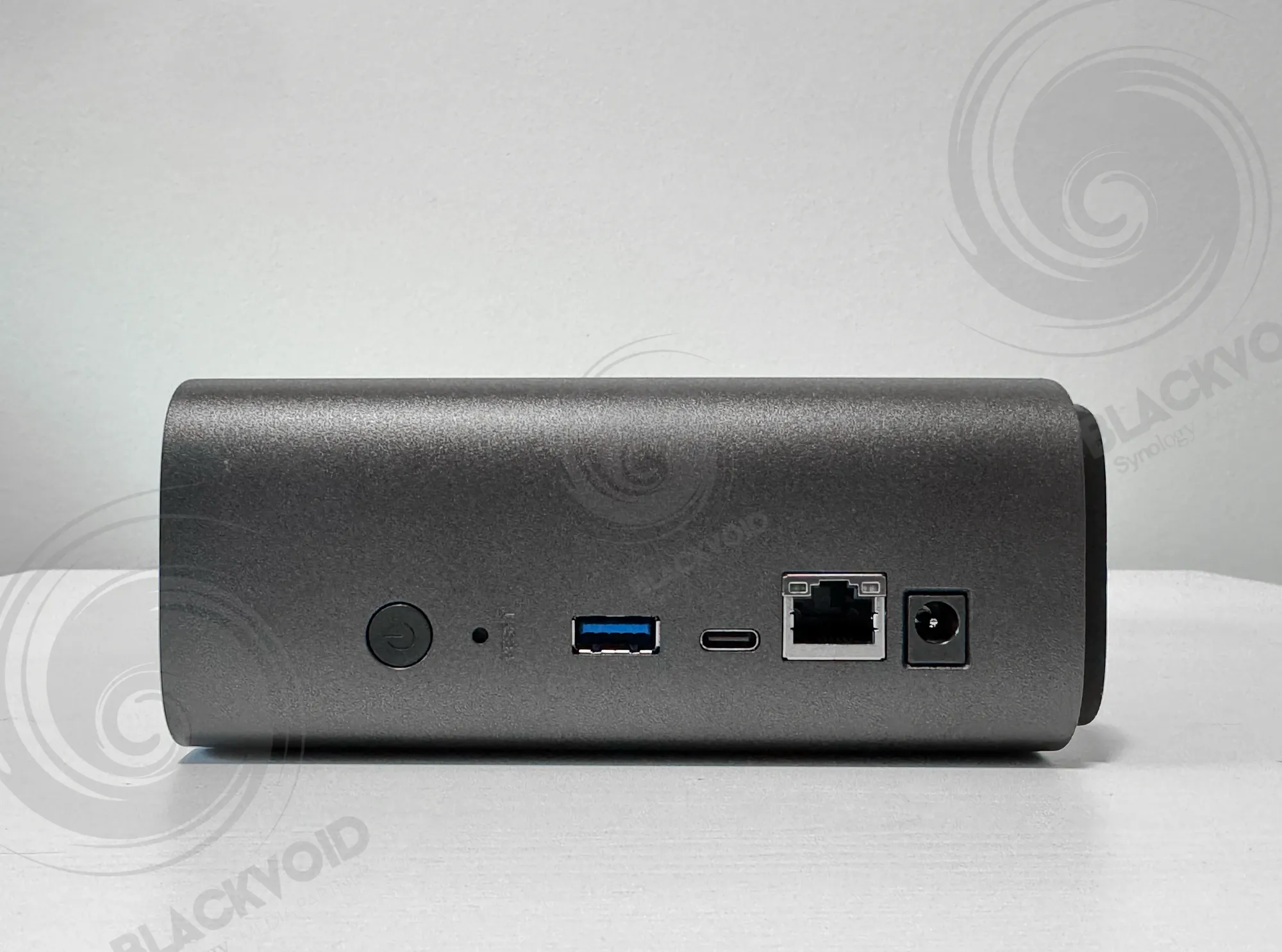
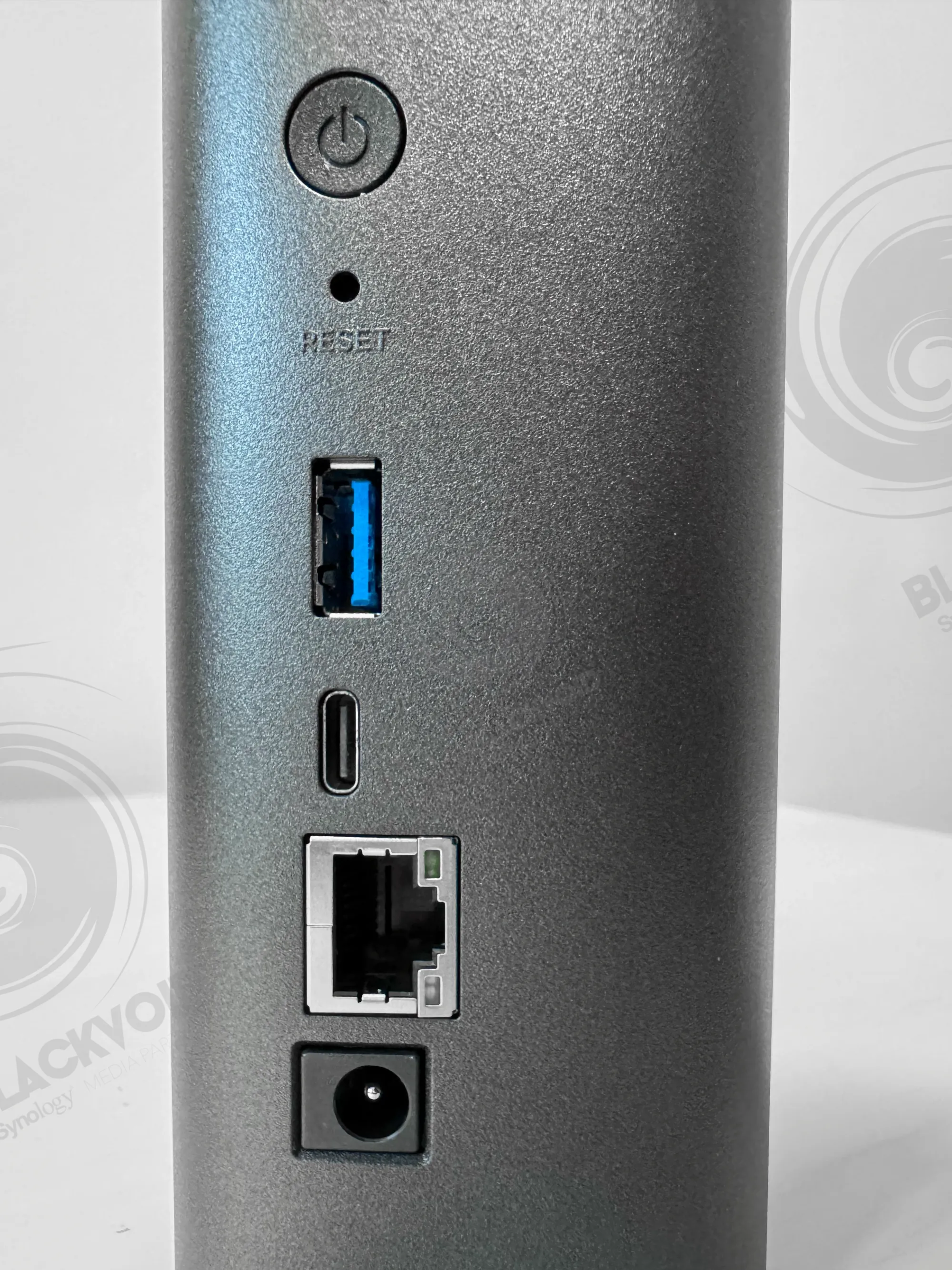
The backside of the Plus model remains unchanged, featuring a single 1GbE network port and dual USB 3.2 Gen 1 ports, available in both Type-A and Type-C. This configuration allows for connecting external devices to back up the BeeStation or transfer data.
: Packaging
The contents of the BeeStation Plus package remain unchanged from previous versions. Besides the unit itself, you'll find a single CAT5e network cable and an external modular PSU adapter. The internal drive is fixed, and there are no tools provided to open the device or replace the drive, as doing so would void the warranty.
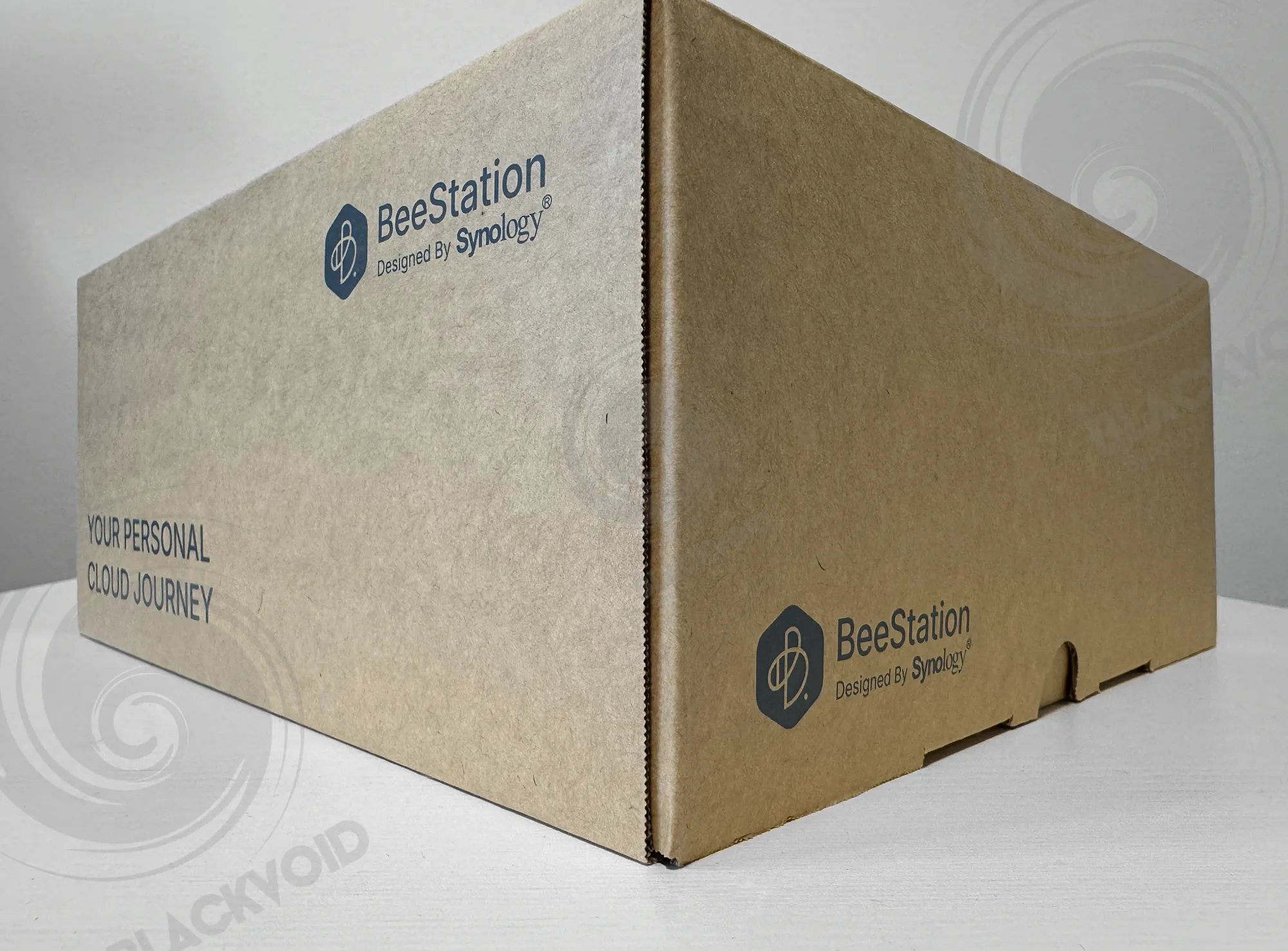
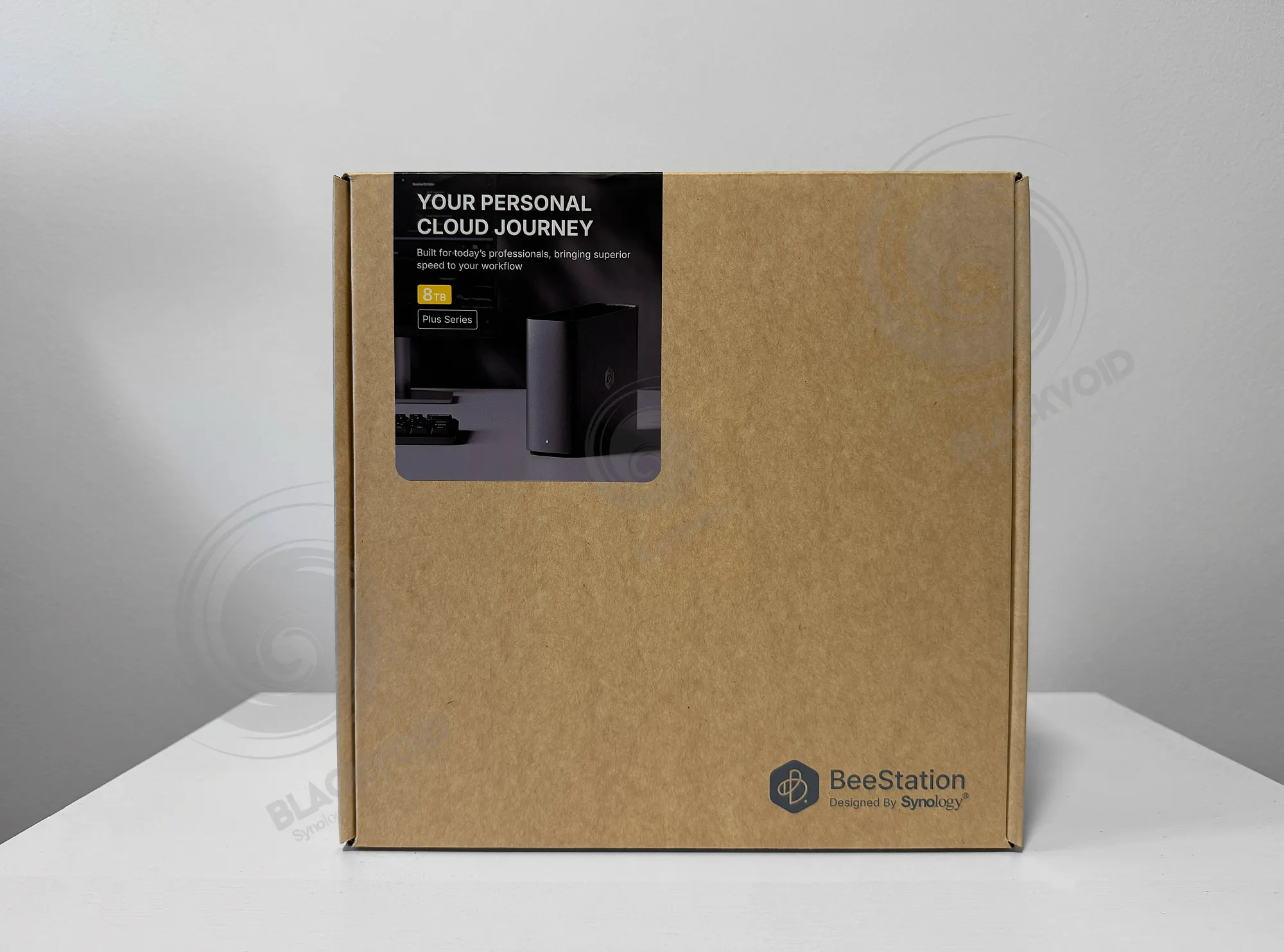
Regarding warranty, the Plus model includes a fixed 3-year Synology warranty due to the hard drive. If any issues arise, the entire unit is replaced rather than just the drive. Therefore, if the unit malfunctions and requires RMA, we ship it as it is and receive a replacement.
Bring data from computers, tablets, phones, external drives, and cloud services to one place and access them anywhere, anytime
Given this setup, it's prudent to ensure there is a reliable backup of the device (more on this later) to maintain access to data in case anything happens to the Beestation.
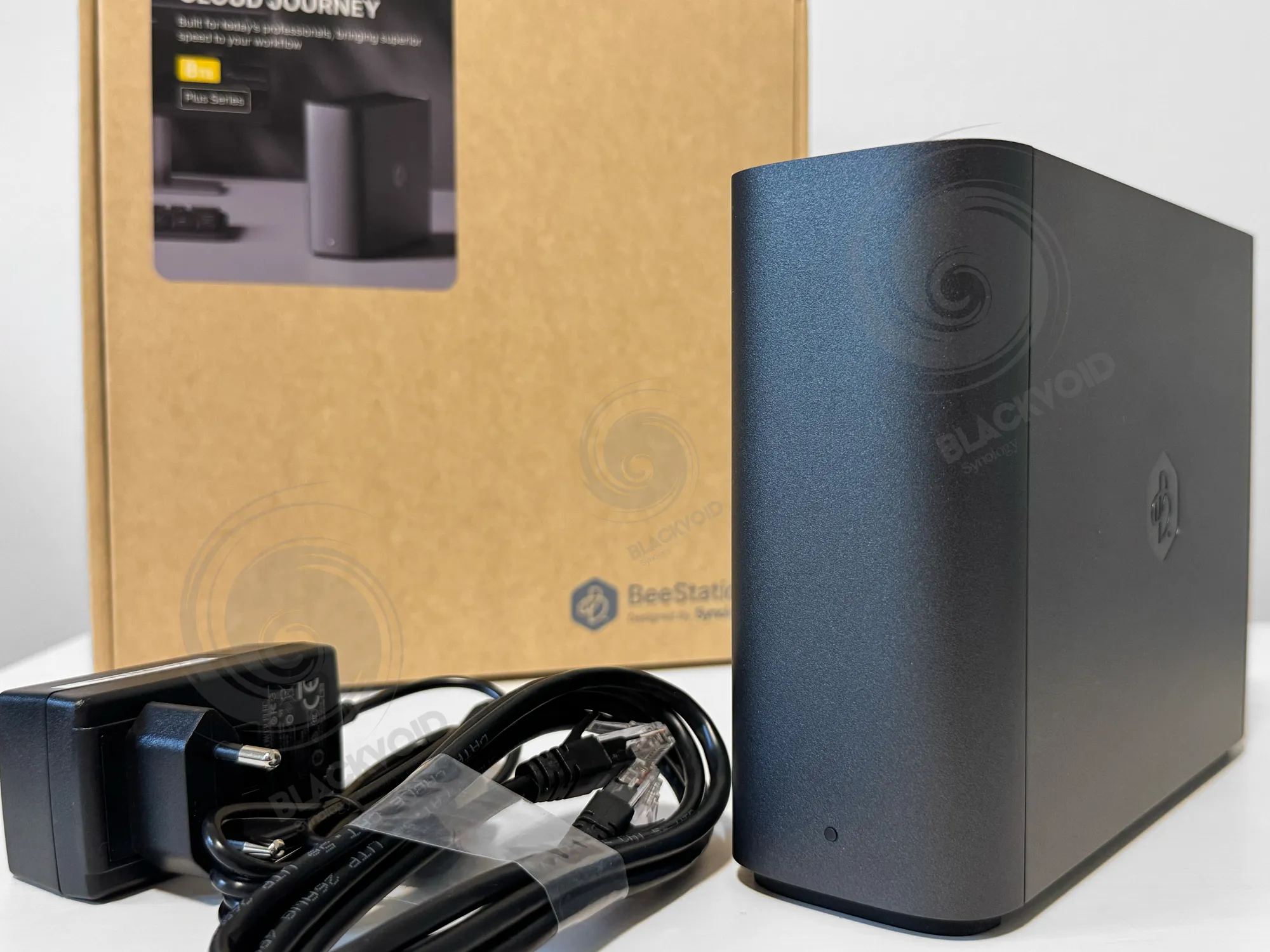
: Beestation vs other Synology models
The launch of the original Beestation marked a shift away from the value-oriented "J" NAS models. Similarly, the introduction of the Plus model raises the question of whether to invest in a comprehensive DSM NAS model or stick with the new Beestation.
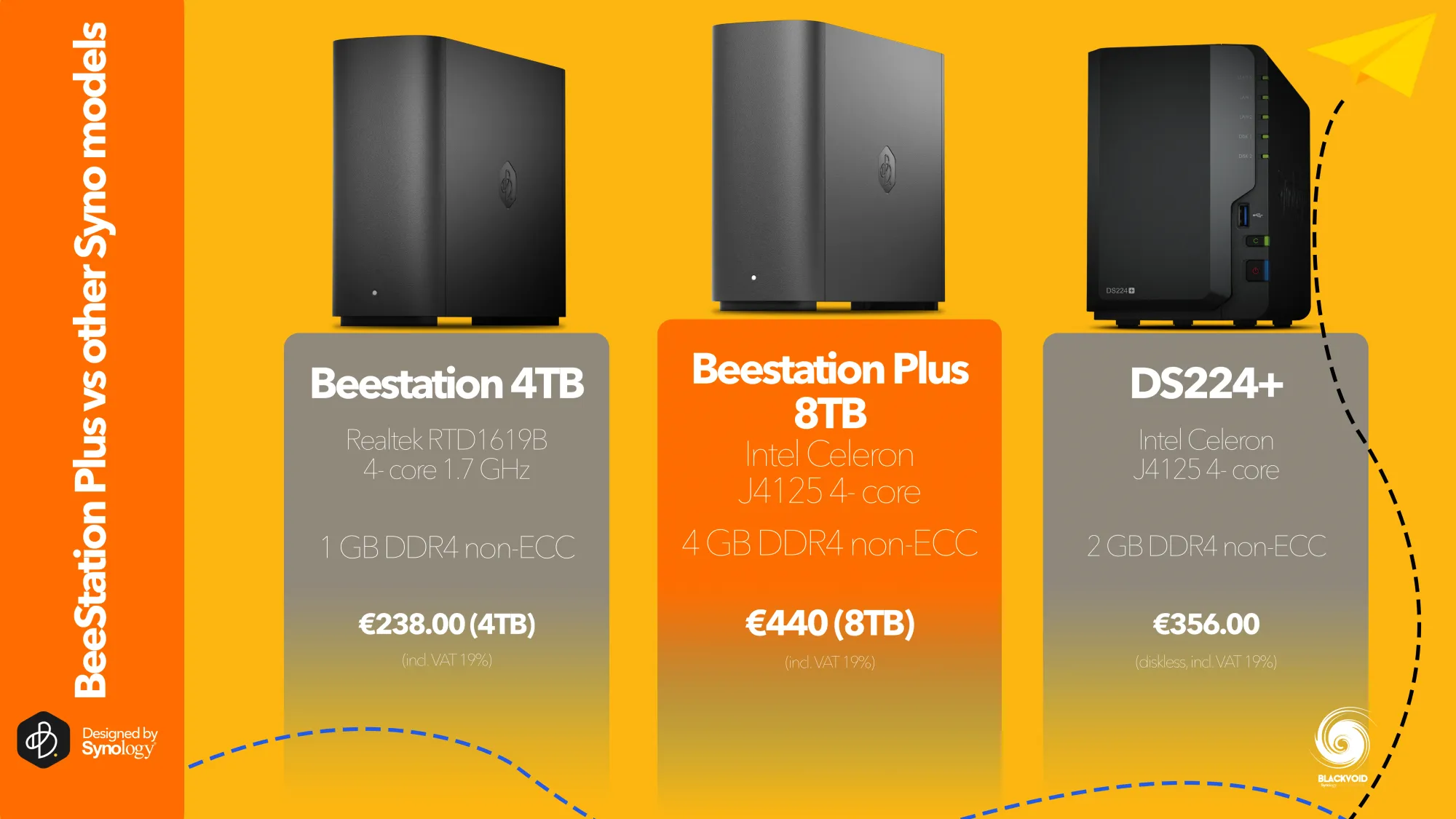
Presently, while Synology continues to offer the original Beestation, it seems impractical to purchase it. Although it costs 50% less due to storage differences, the Plus model provides four times the RAM and a much more capable CPU, delivering new features in the same form factor.
Up to 2.6x the original speed for mobile photo backup, 3.8x for web uploads, and 4.8x for desktop sync compared to Beestation 4TB

Purchasing an 8TB single-drive device might seem insignificant by 2025, but even today, not all users are data hoarders. Some prefer using a remotely accessible NAS for essential data access across multiple platforms.
A relevant comparison would be with the popular DS224+ (or the upcoming DS225+) DSM NAS. This 2-bay model features the same CPU and half the RAM initially (upgradable to 6GB), with a starting price of around €356.00 (including VAT). Adding two 4TB or a single 8TB HAT3310 disk brings the total cost to just under €600.
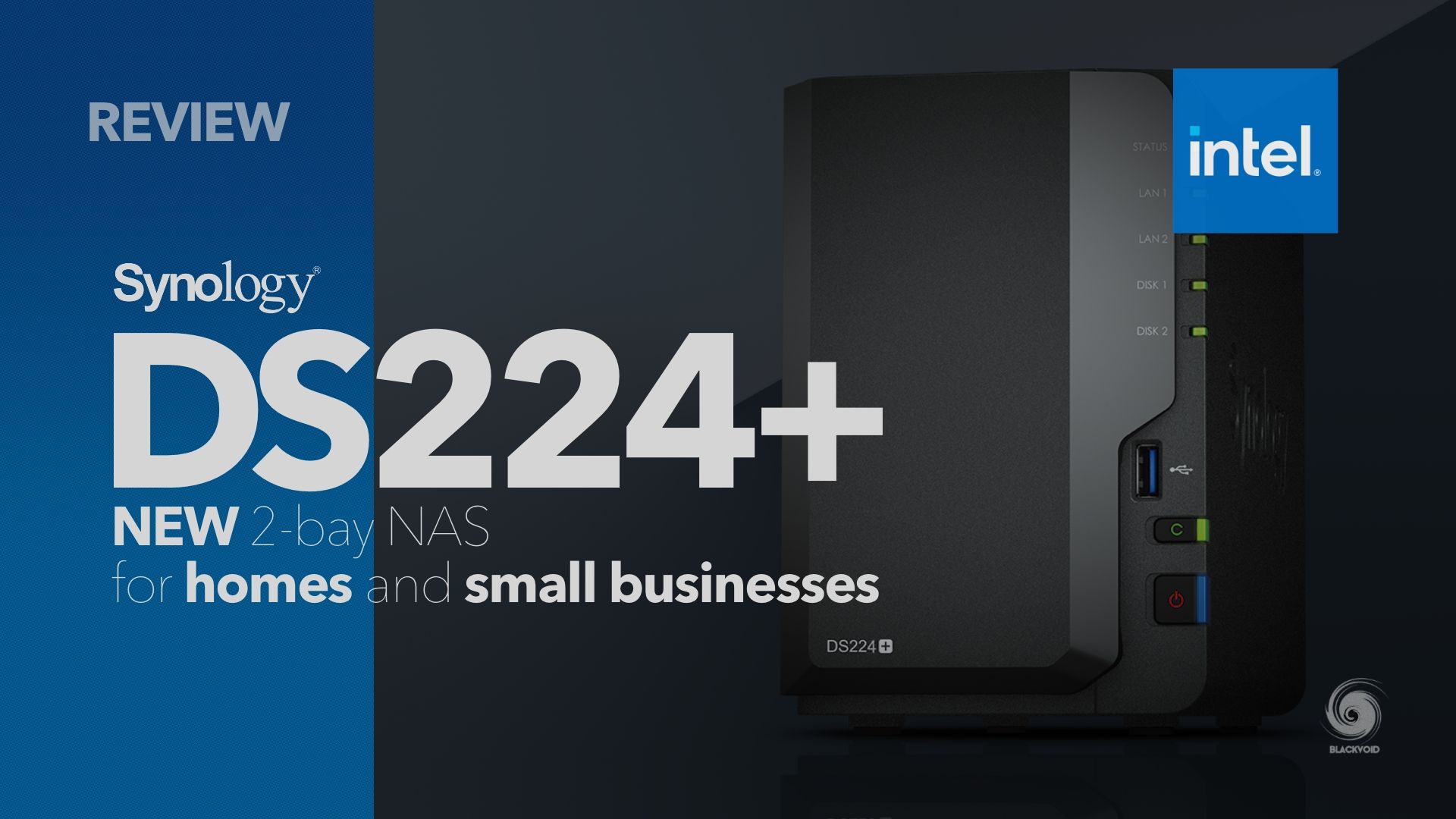
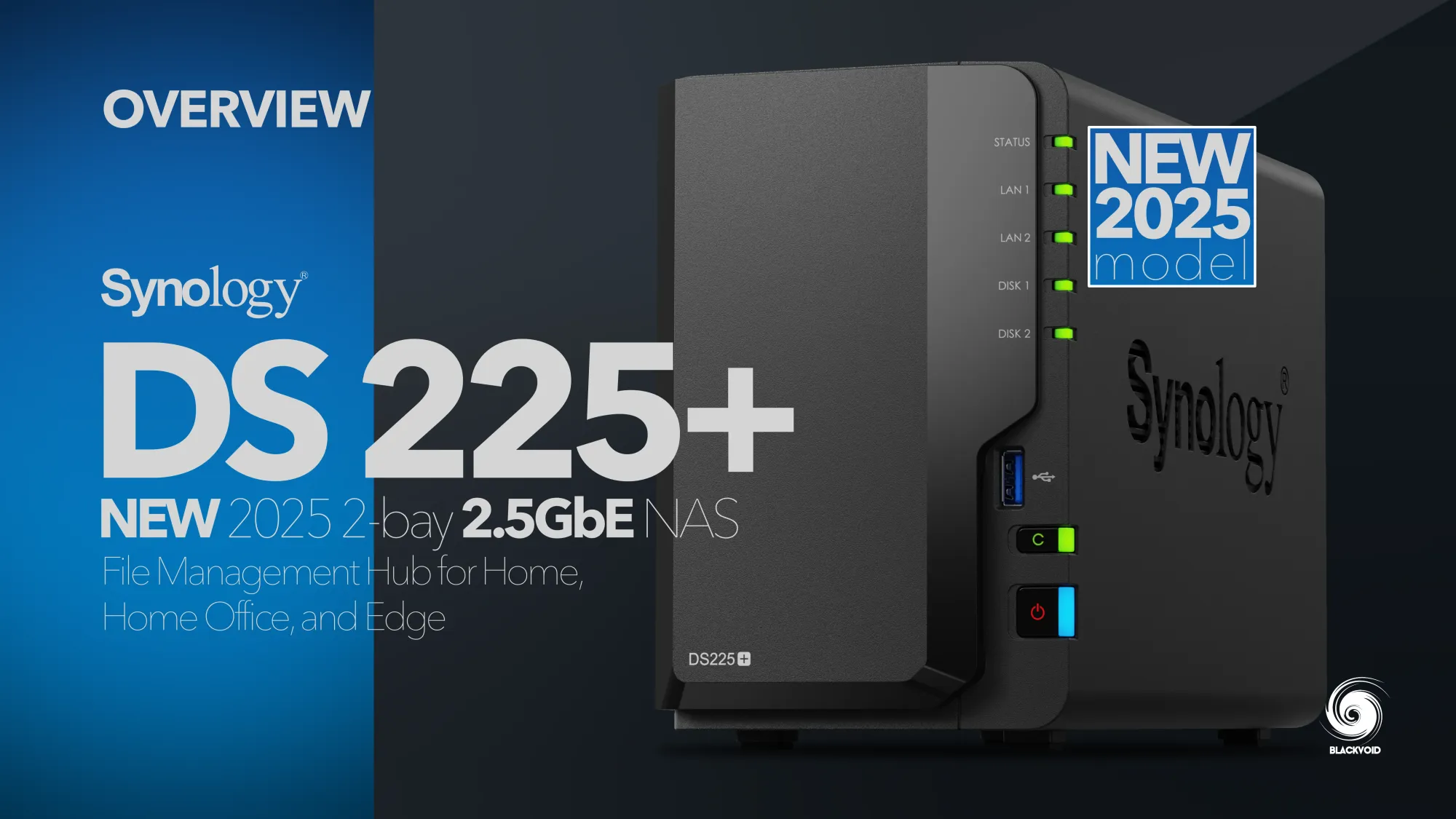
Financially, this does not appeal to those seeking a turnkey solution for essential backup, sync, and sharing operations. However, the DS225+ and similar models offer significantly more features and services. Thus, a direct comparison may not be entirely fair, as both devices cater to distinct audiences.
Ultimately, while the new Plus model may appear to challenge some of the other DSM Plus models, this is not the case, even with the integration of the popular PLEX service. The DS lineup offers flexibility, expandability, and support for a wide range of first- and third-party services. This level of versatility and service implementation is not yet achievable with the second iteration of the Beestation, nor is it expected to be, based on Synology's current plans.
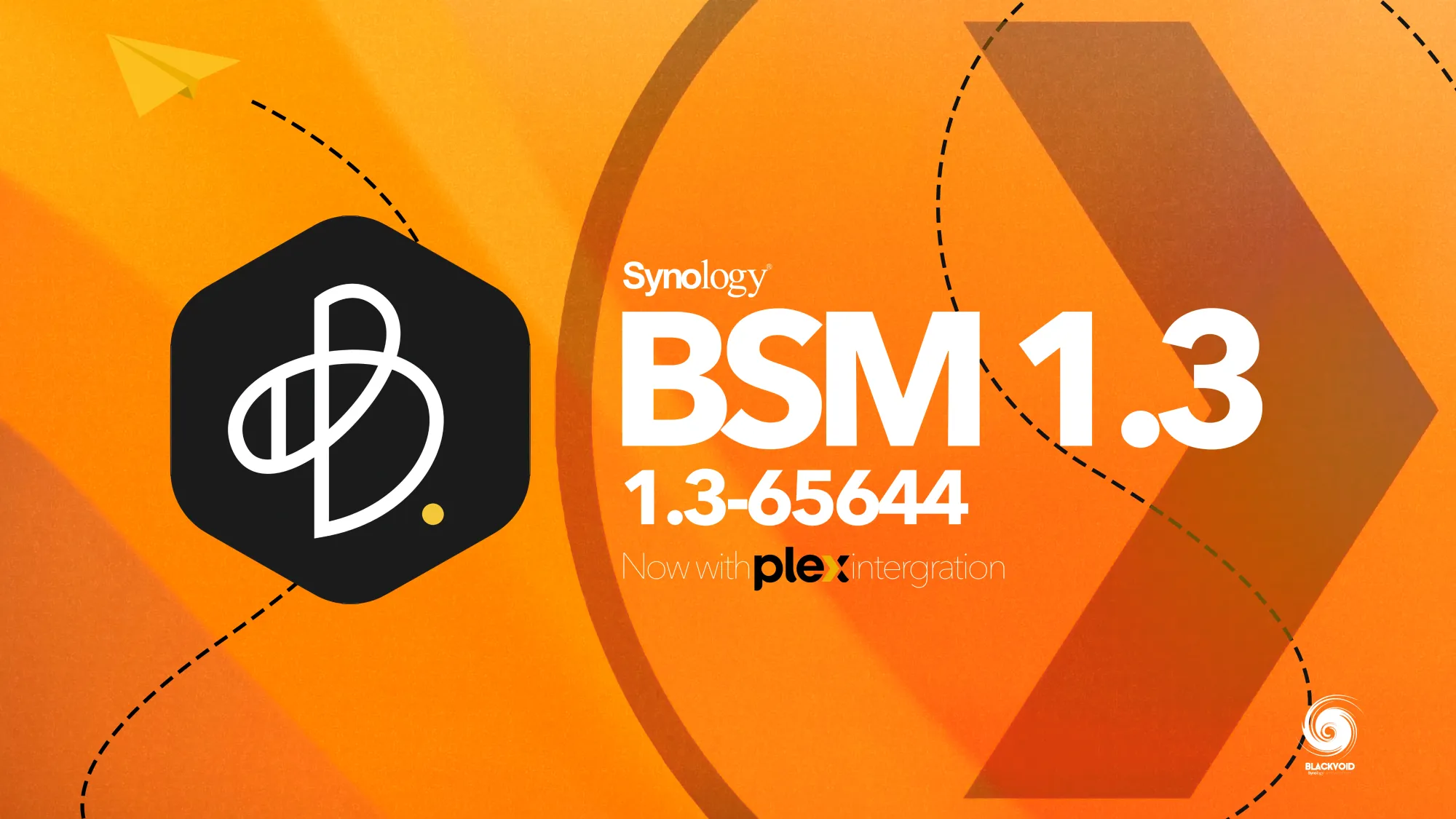
There are still several features that the BSM (Beestation OS) lacks compared to DSM, which might influence more users to opt for a DS-type NAS. Notably, the Beestation currently cannot serve as a Hyper Backup destination. While it can back up to another DS NAS, the reverse is not possible. If this capability becomes available in the future, more users would likely consider the Beestation as their primary or secondary backup destination, given its relatively low price point. This limitation is primarily software-based. Just as BSM 1.3 introduced some compelling features to the Plus version of Beestation, there's no reason why future updates couldn't expand on these missing features.
: Beestation vs "public cloud" solutions
With the rise of public cloud services over the past decade, the question of whether it is worth investing in local storage frequently arises. While self-hosting our own services and data has become much simpler and more accessible due to the availability of high-speed fiber bandwidth, some still consider public cloud services as an option.
Certainly, self-hosting isn't for everyone. However, at some point, utilizing public cloud services can become expensive, and often quite rapidly. This leads to the dilemma of deciding what actions to take: do we continue using the cloud, do we downsize our data, or do we opt for a personal, local cloud solution such as a NAS?
This conundrum inspired the Bee series, which aims to bring personal cloud functionalities to everyone—not just tech enthusiasts.
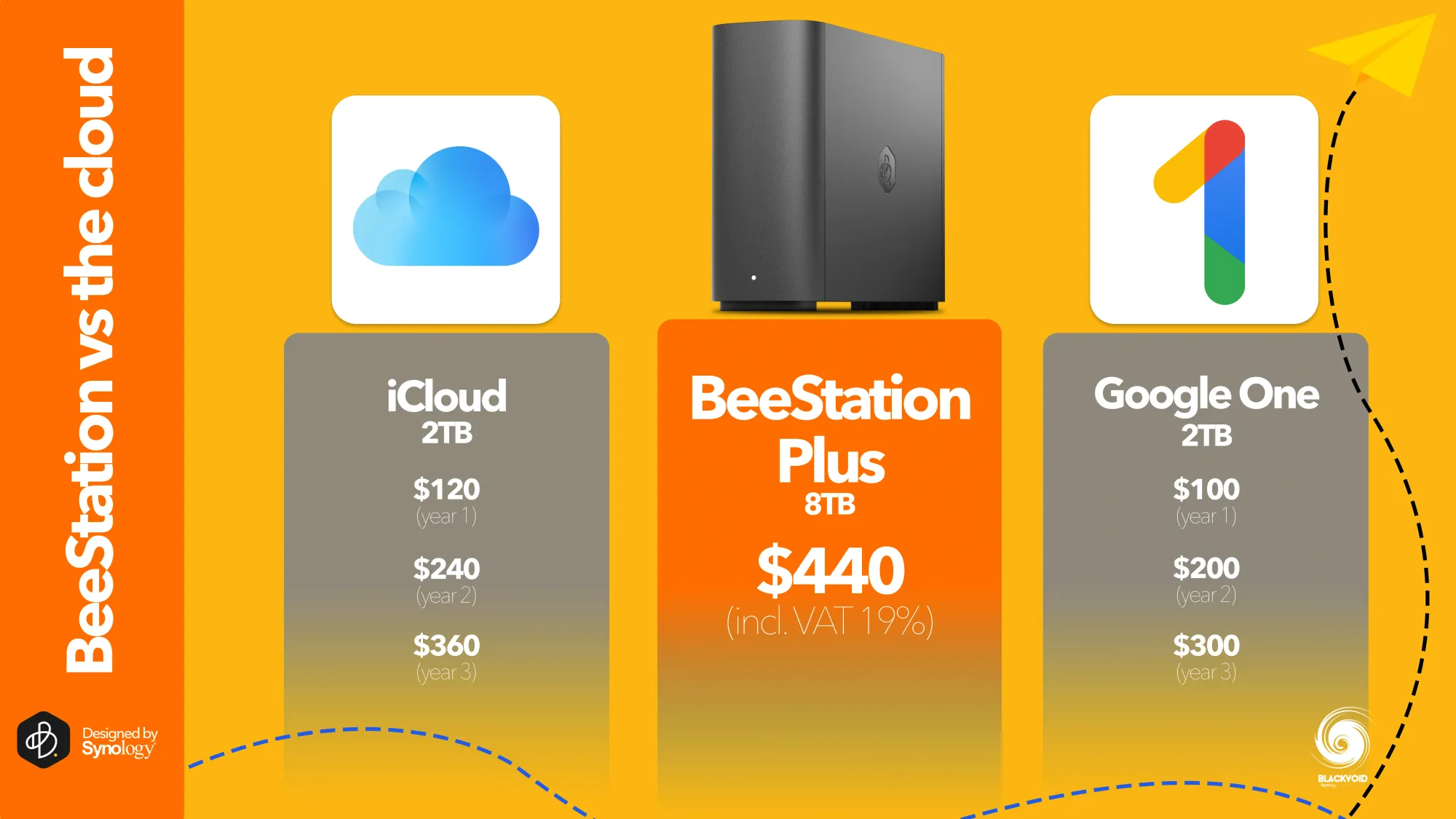
When comparing costs, a single Beestation Plus will likely pay for itself by the third year of using any popular cloud service. Not to mention, you'll receive 3-4 times more storage right from the start. Privacy? Absolutely! Large cloud services are significant targets for hackers and anyone seeking to exploit that vast reservoir of private data.
Maintaining personal or business content on personally owned devices, with appropriate backups, will undoubtedly pay off in the long run.
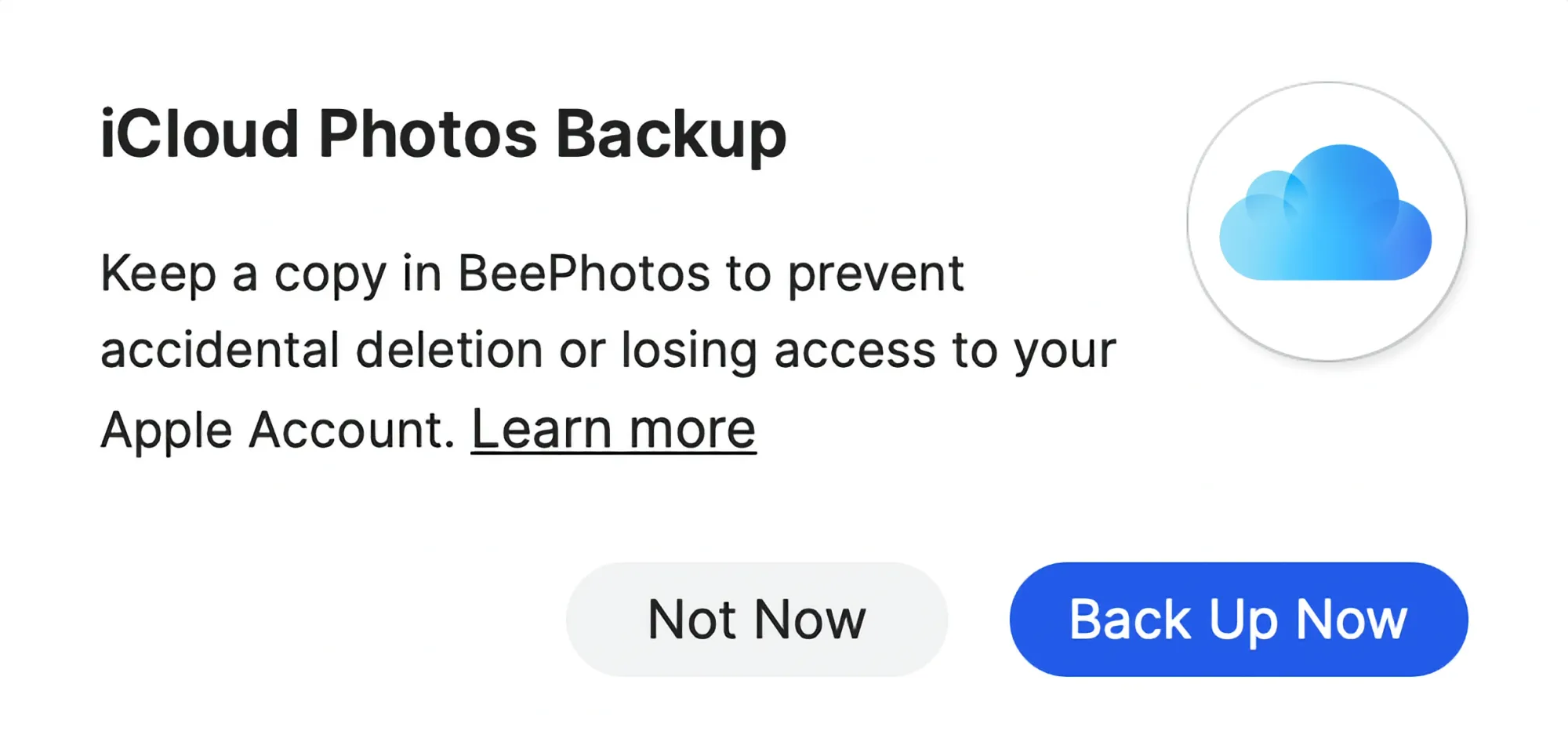
Synology has made significant efforts to give Beestation users, both current and future, the option to migrate from popular cloud photo services. They provide a direct connection to well-known cloud photo repositories, enabling users to download data all at once or gradually over time. This way, the Beestation can handle all the heavy lifting on its own, eliminating the need for IT assistance while ensuring private and secure access to our most cherished memories.
Setting up and using the Beestation is as straightforward as opening a public cloud account. The added advantage is gaining private, personal storage that not only offers more space but is also more cost-effective in the long run.
: Configuration and setup
Regarding setup, the new Plus model, unlike its predecessor, takes only 6 minutes to configure from the initial boot—twice as fast as the original Beestation. This includes configuring the operating system, setting up the QuickConnect name and certificate, and installing the main apps, BeeFile and BeePhotos, even though half a dozen apps are operating in the background.
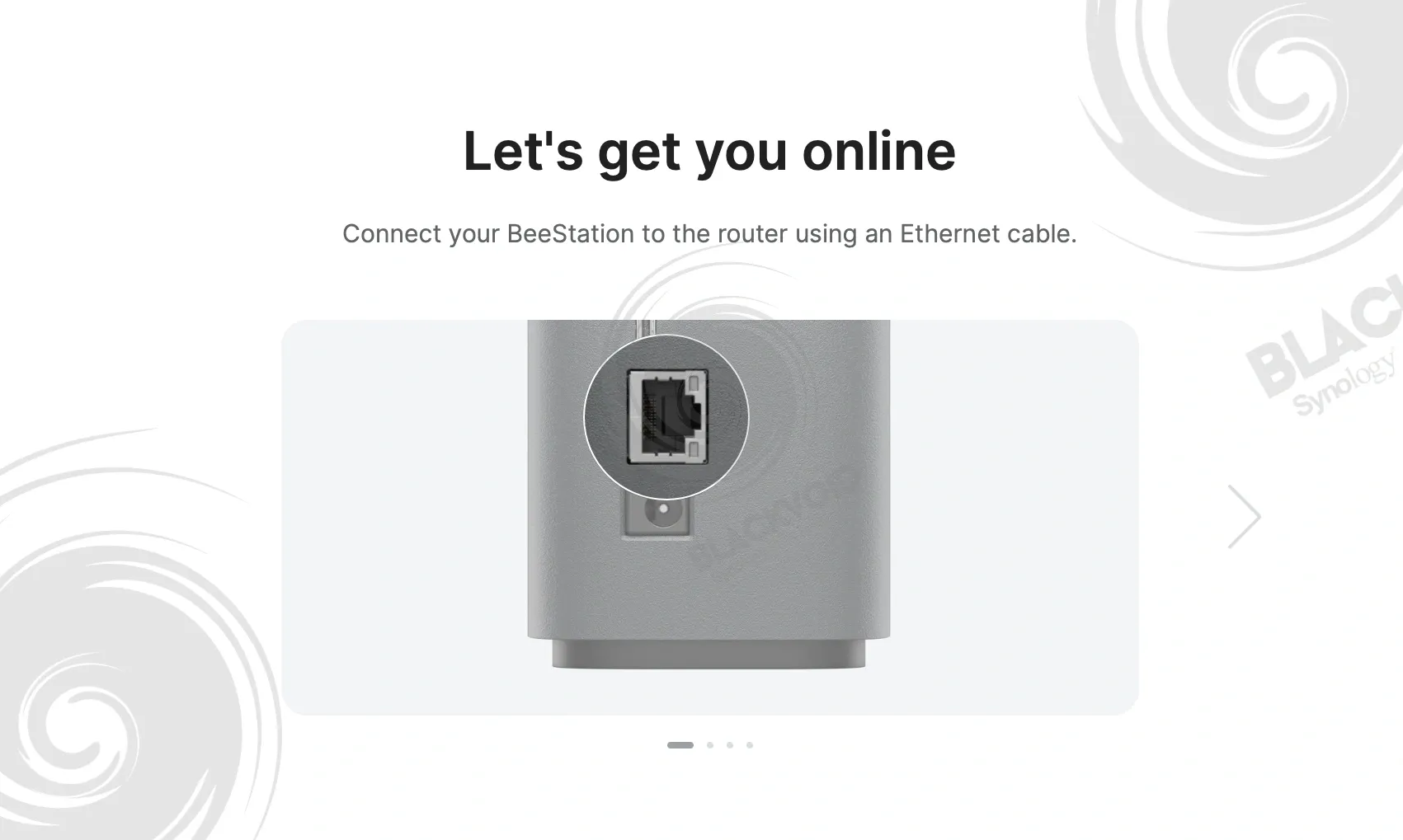
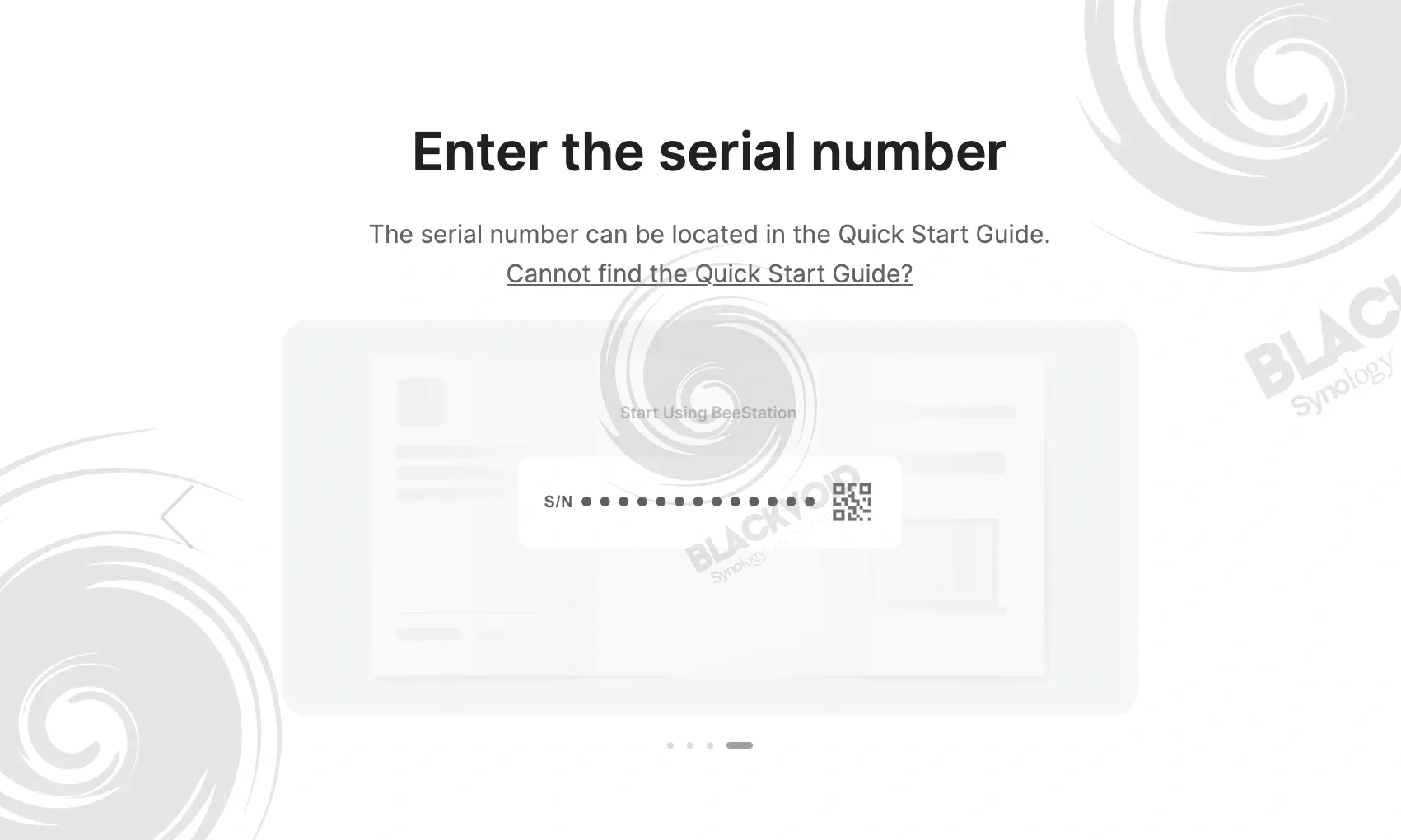
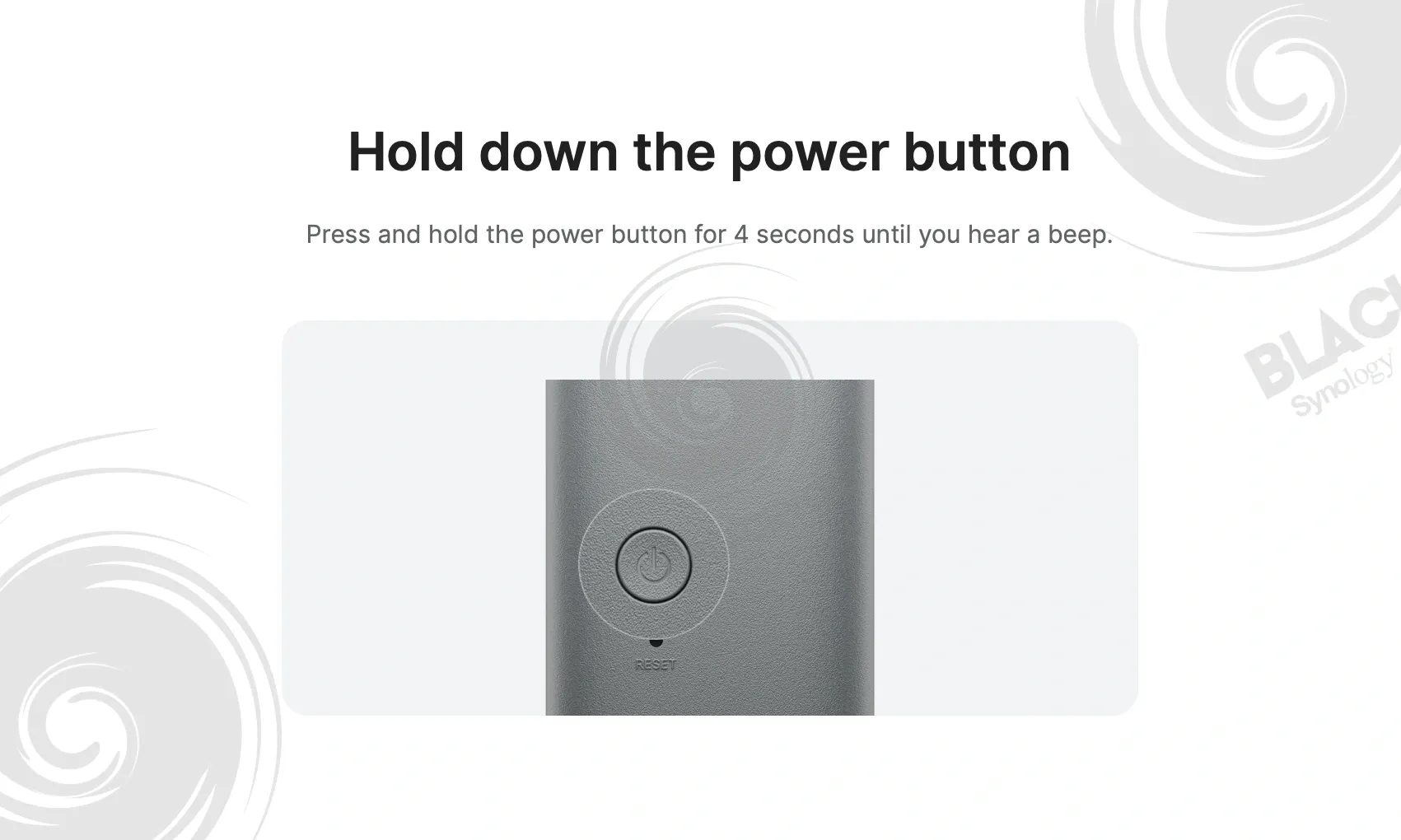
To get the device up and running, the only physical tasks required are plugging in the power and Ethernet cables, entering the serial number, and holding the power button. Once the Beestation initiates its process, it's just a matter of minutes before the main interface screen appears, allowing us to start using it immediately.
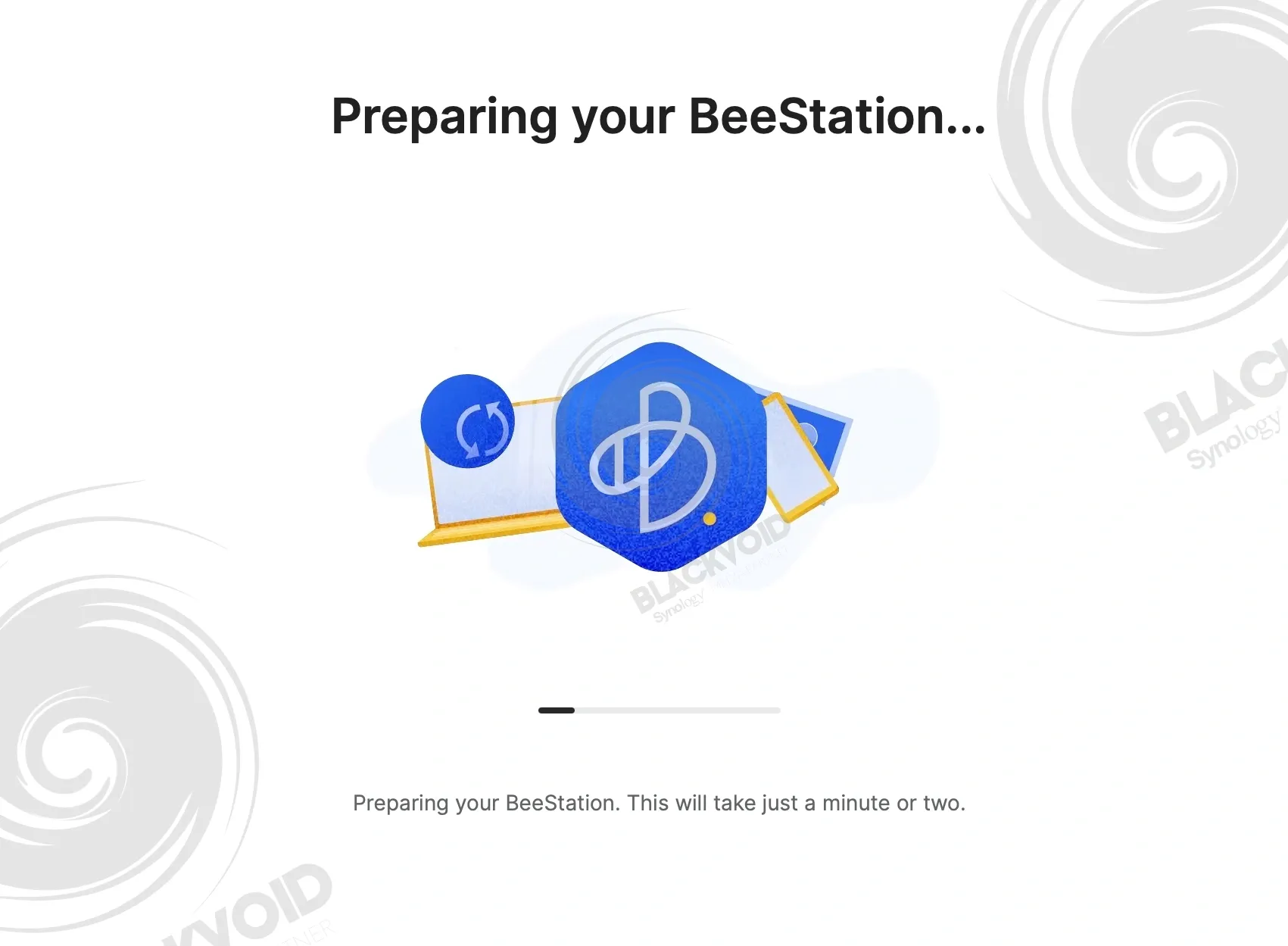
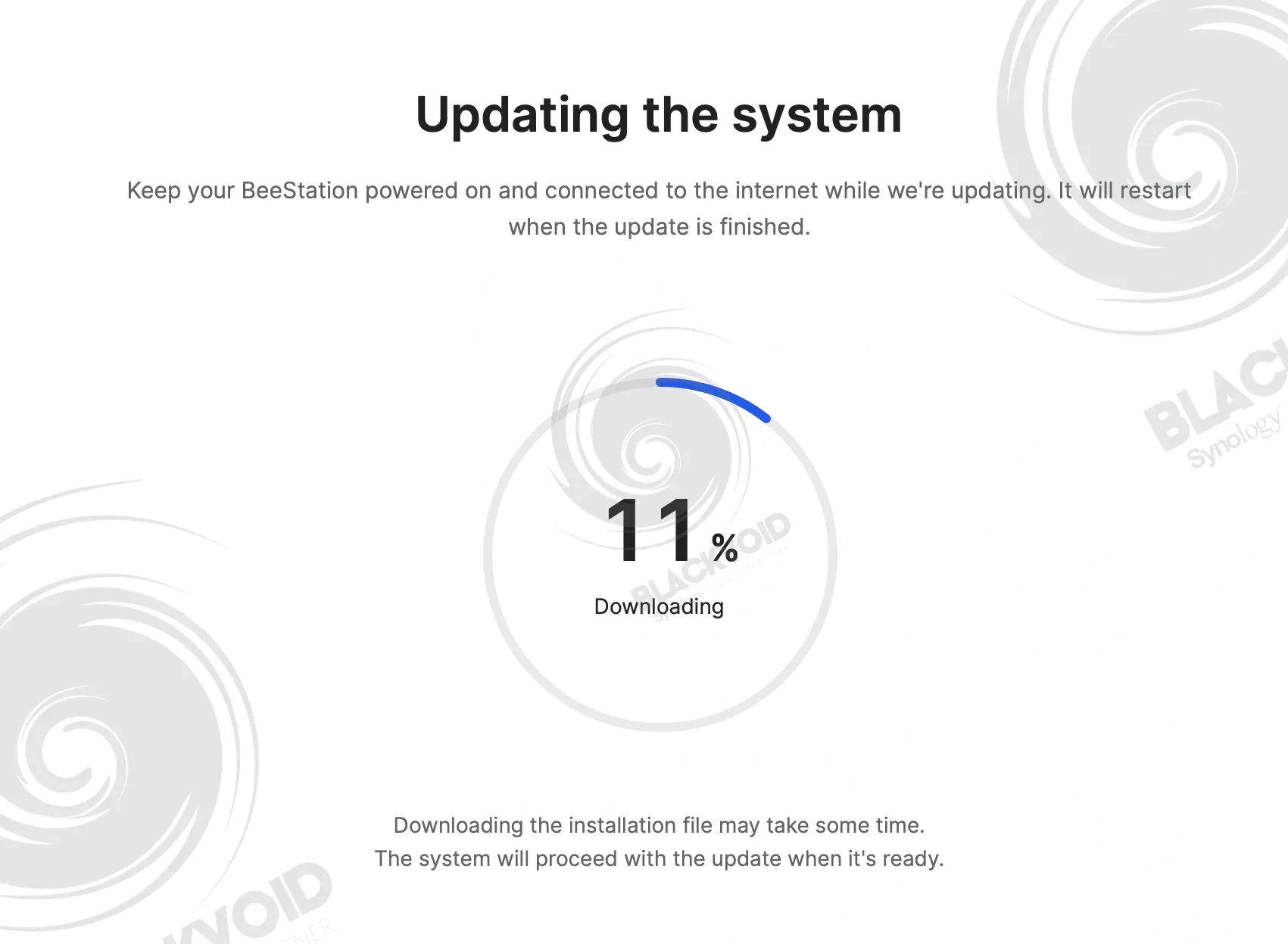
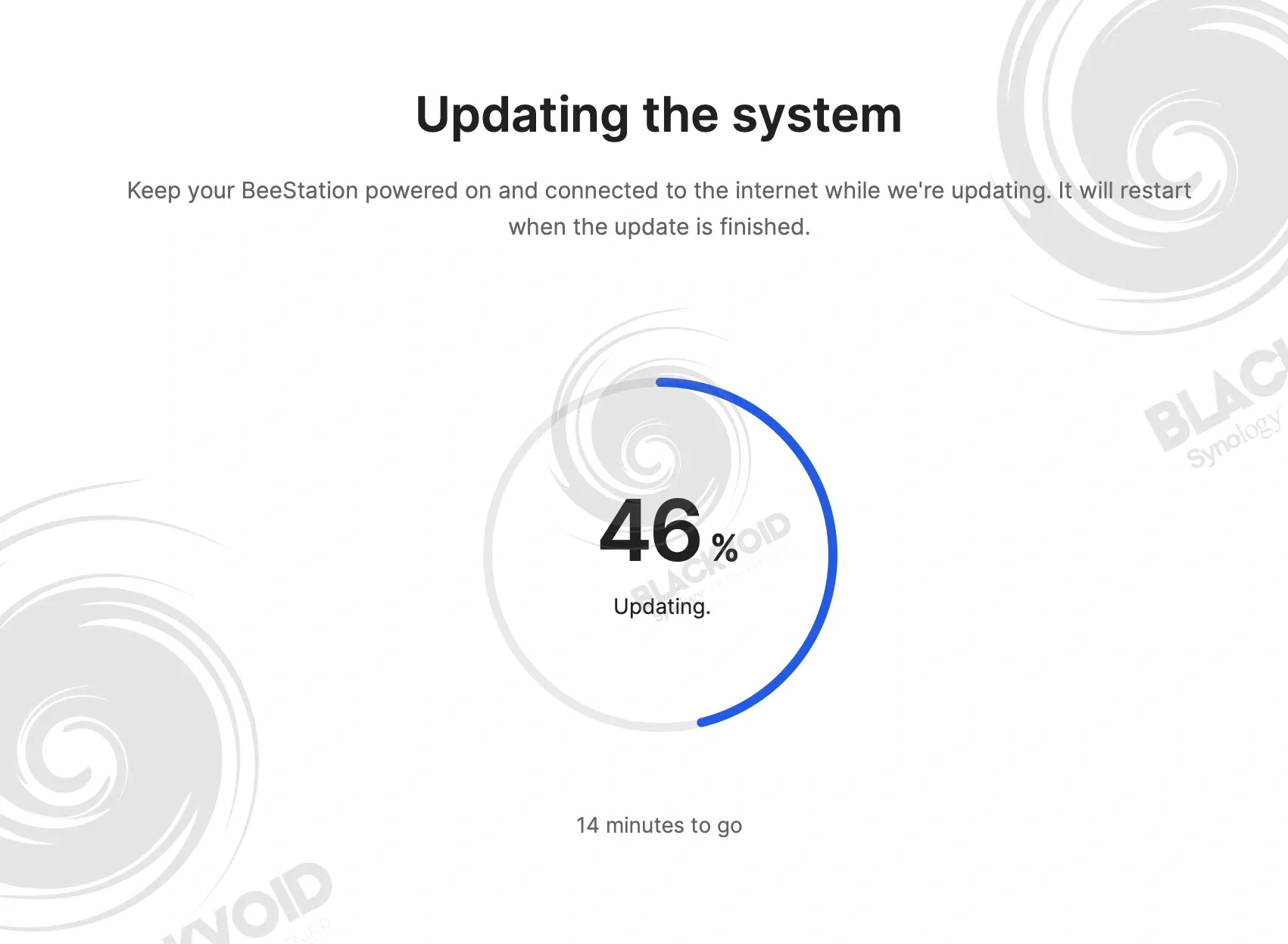
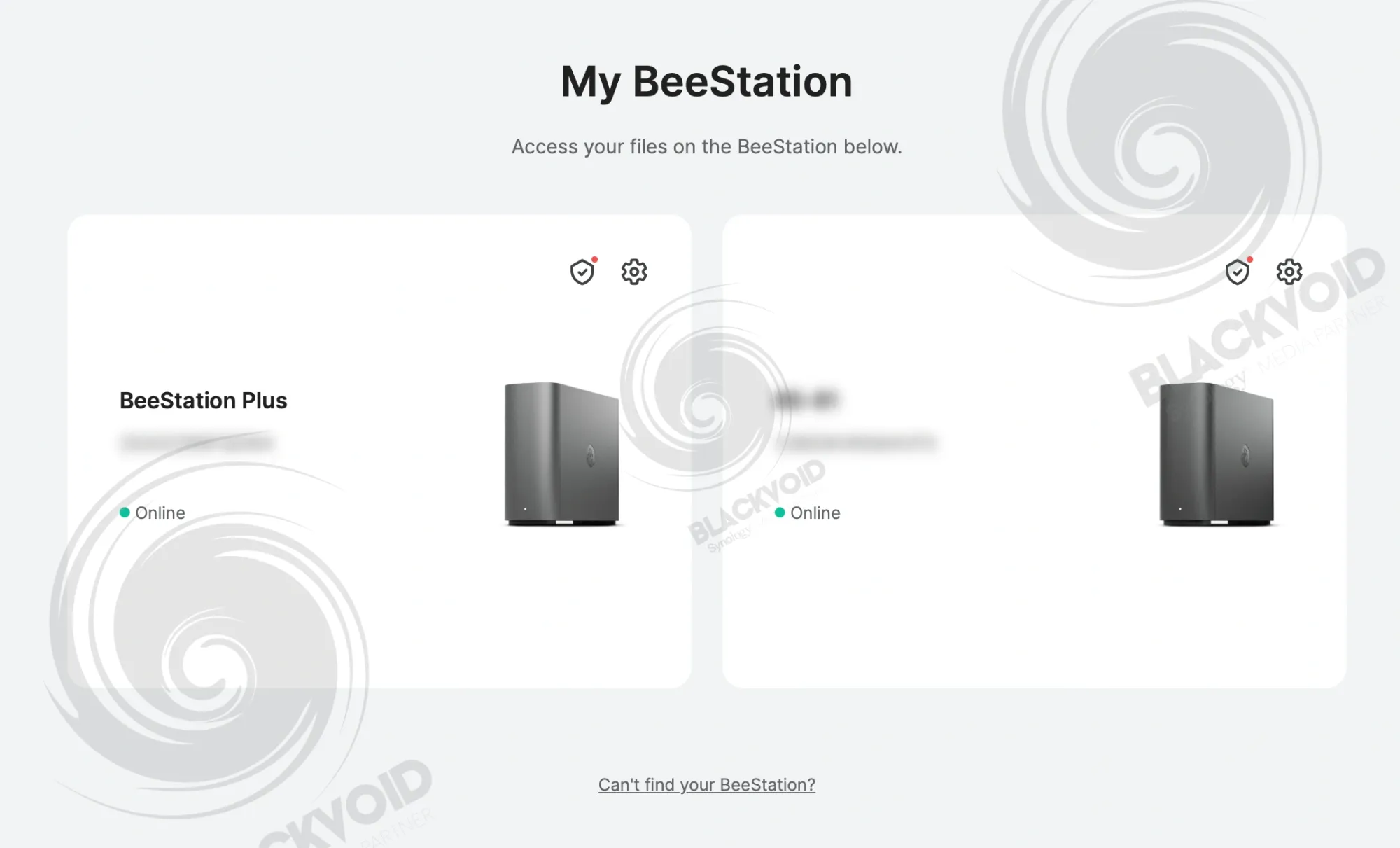
That is it, the setup is completed. Nothing special or complicated. The next screen we will see will be either BeeFiles, BeePhotos, or the System Settings page, depending on the choice made using the portal.bee.synology.com web page.
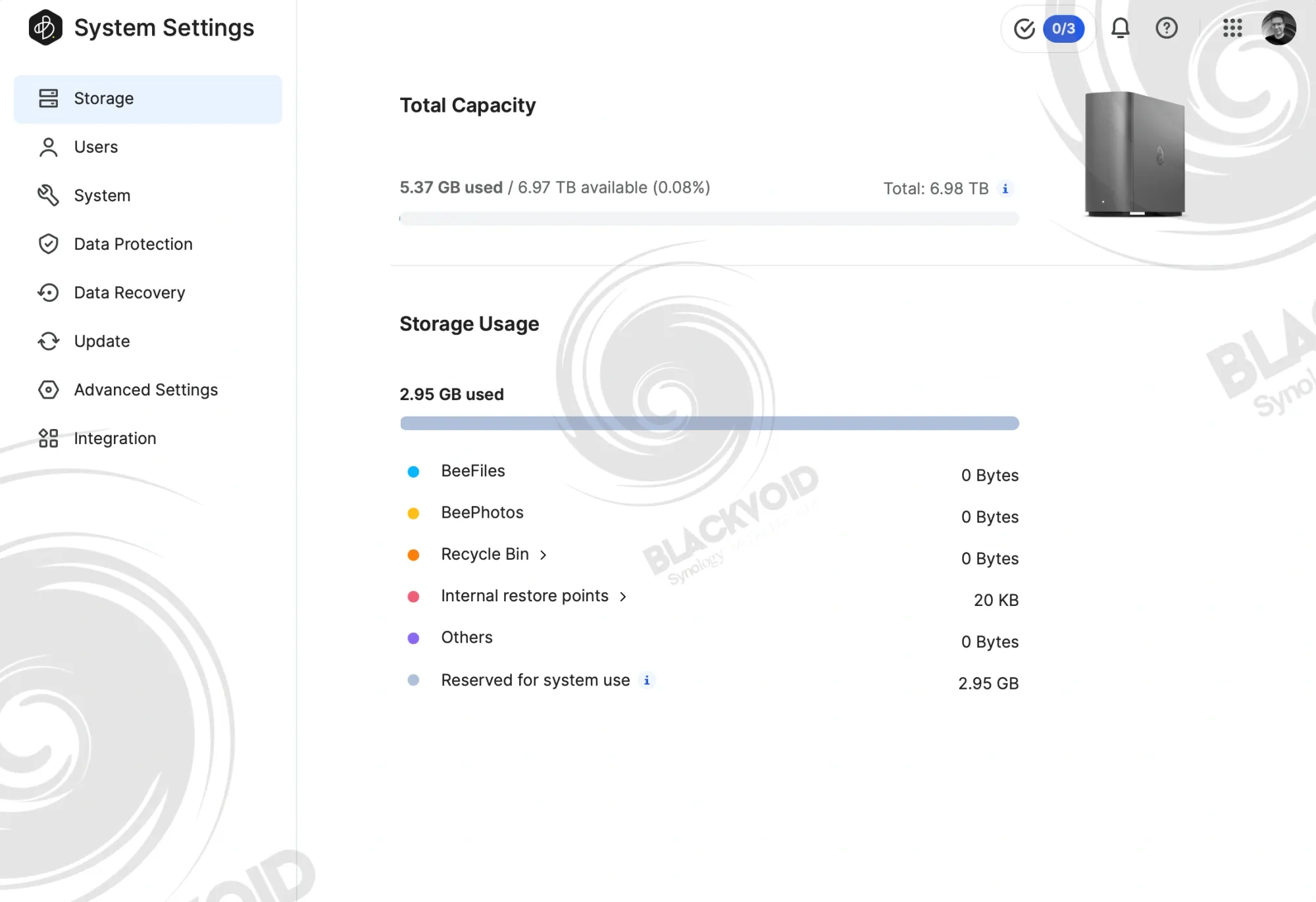
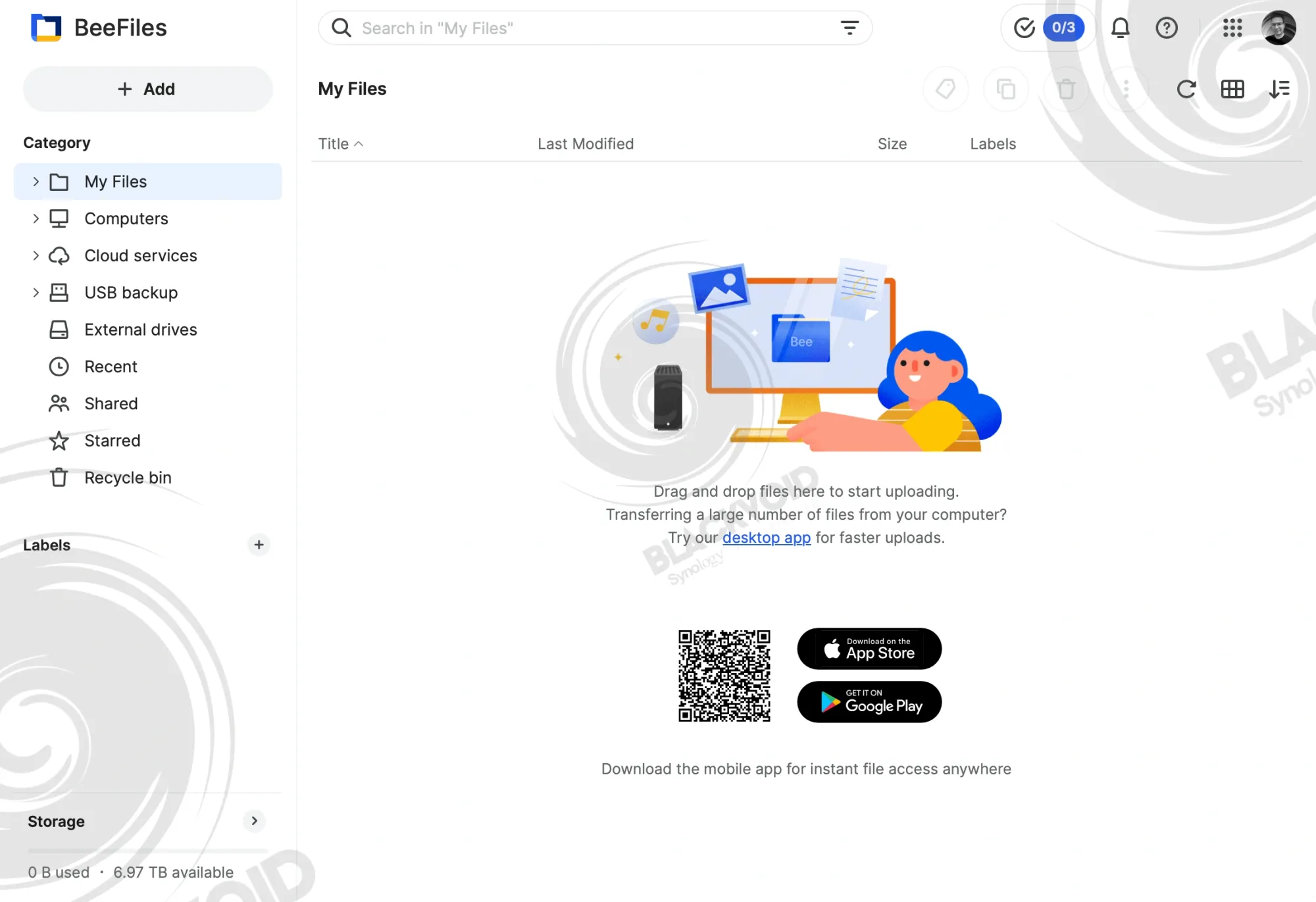
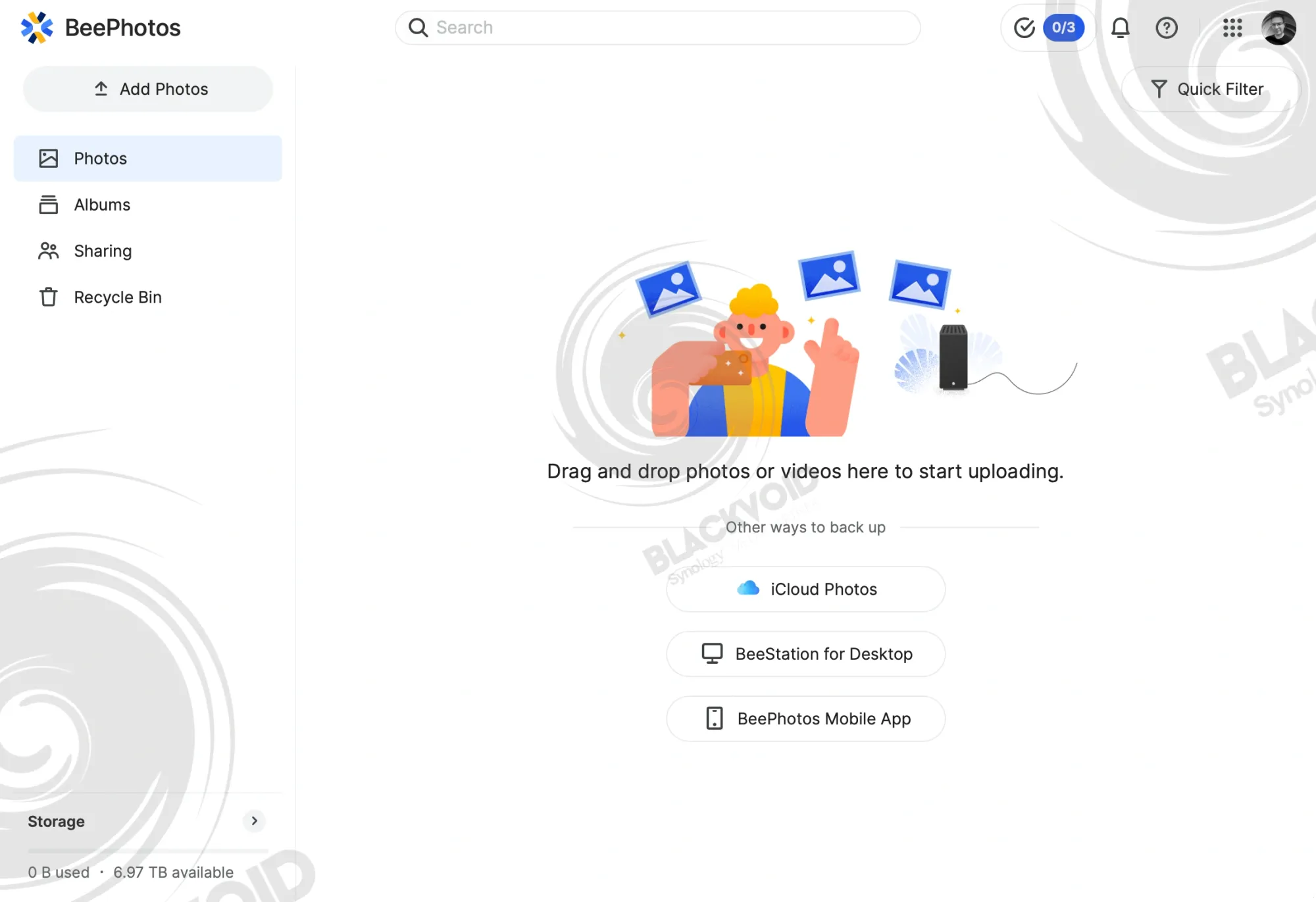
:: System settings
The primary feature of BSM 1.3 is undoubtedly its applications, which offer a range of functionalities for both file and photo management. However, the system settings are equally important. These include user and system configurations, data protection and recovery, along with updates and third-party integrations—available exclusively with the Plus model.
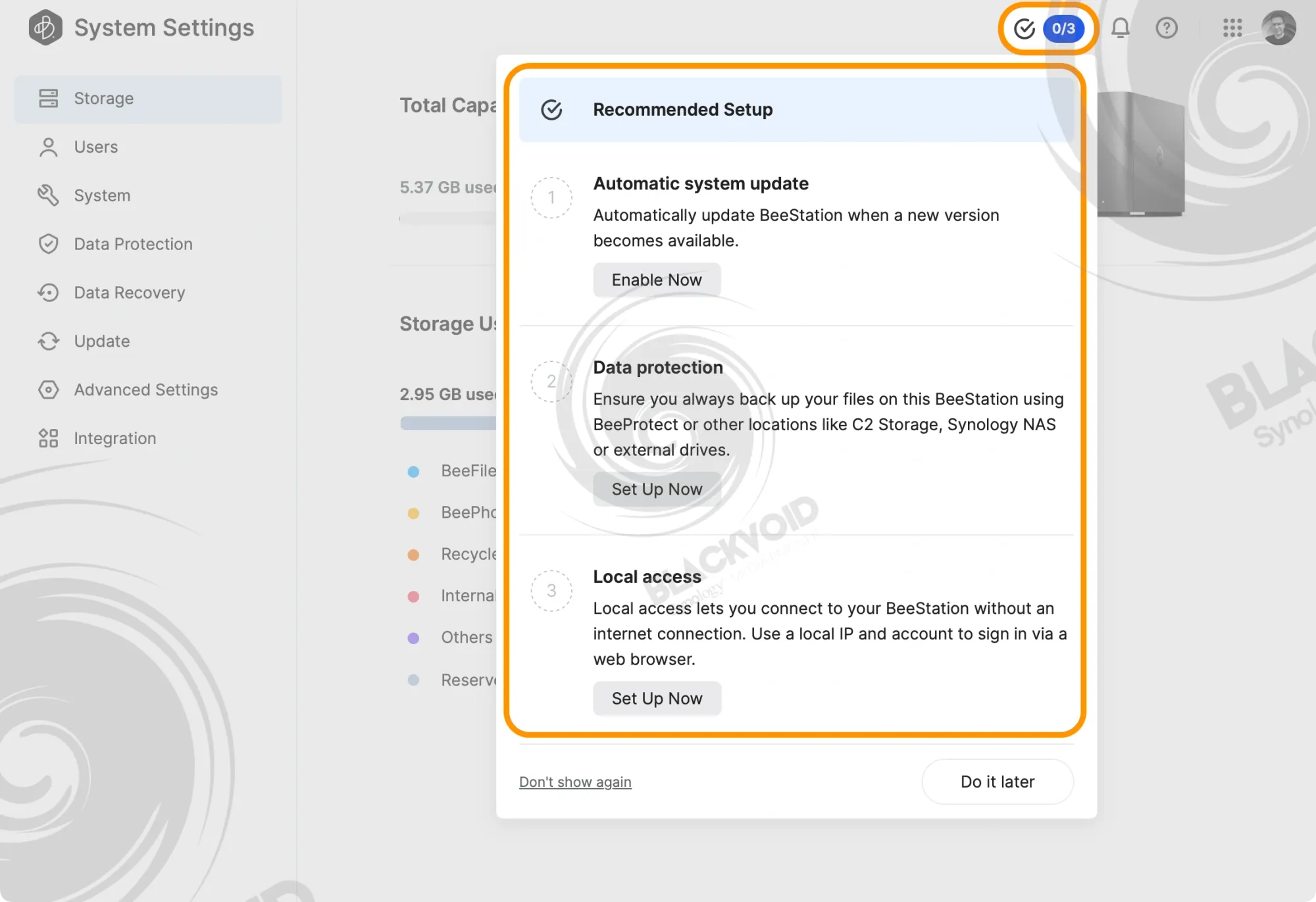
The BSM has significantly evolved over the past 18 months since version 1.0. The inclusion of the "recommended setup" window offers substantial assistance, particularly for novice users, by emphasizing three initial settings: automatic updates, data protection (backup), and local access options in case of issues accessing the Beestation via the official Bee portal webpage.
Although I am generally not a fan of automatic updates on any system, regardless of its size or complexity, I understand Synology's rationale for incorporating this feature in a SOHO-targeted turnkey device.
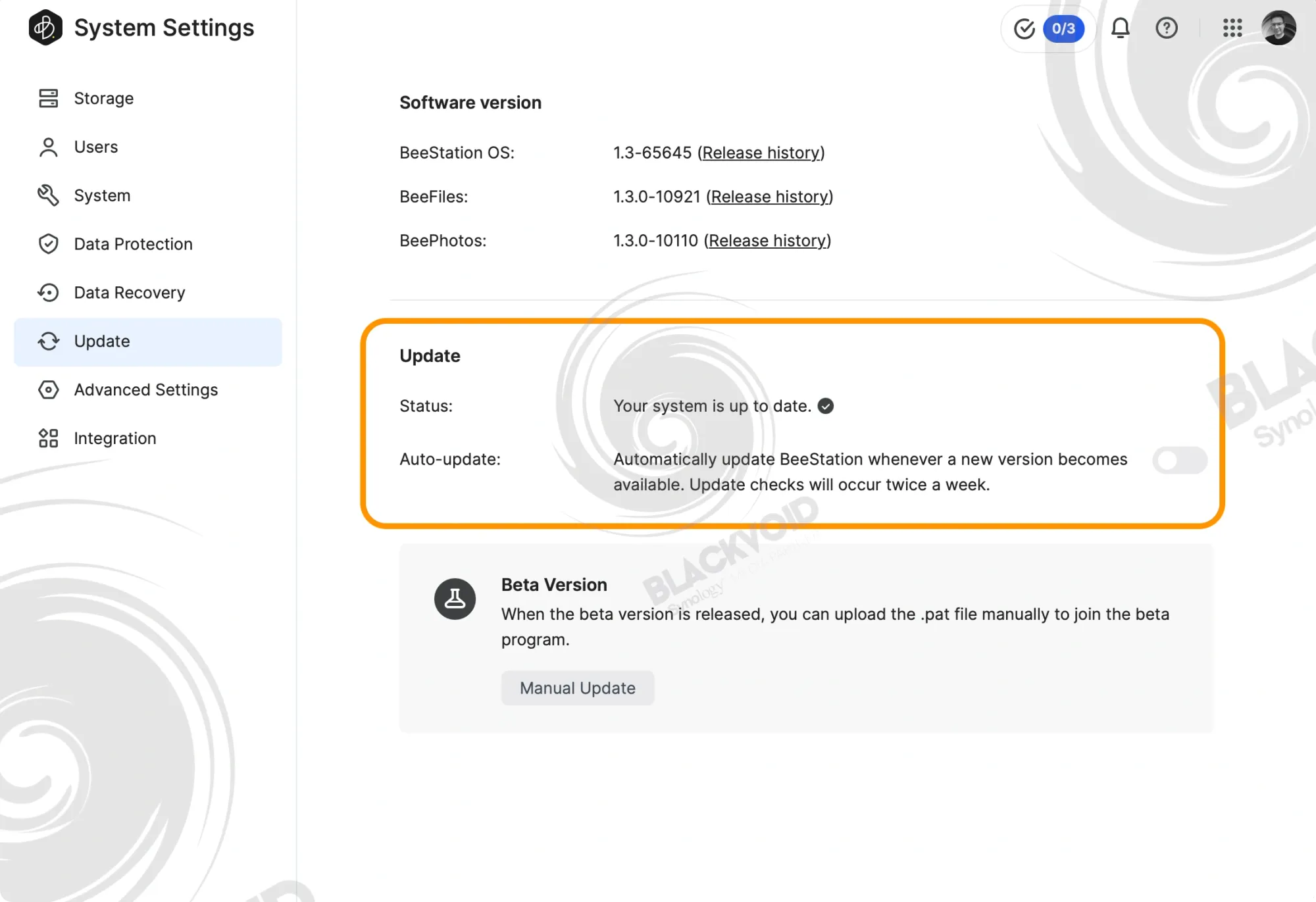
To access the Beestation Plus, users initially navigate to the Bee portal page, which then redirects to a custom-registered QuickConnect URL unique to each device. However, this process requires a continuous Internet connection. If the connection is lost, access to the device will be completely disrupted.
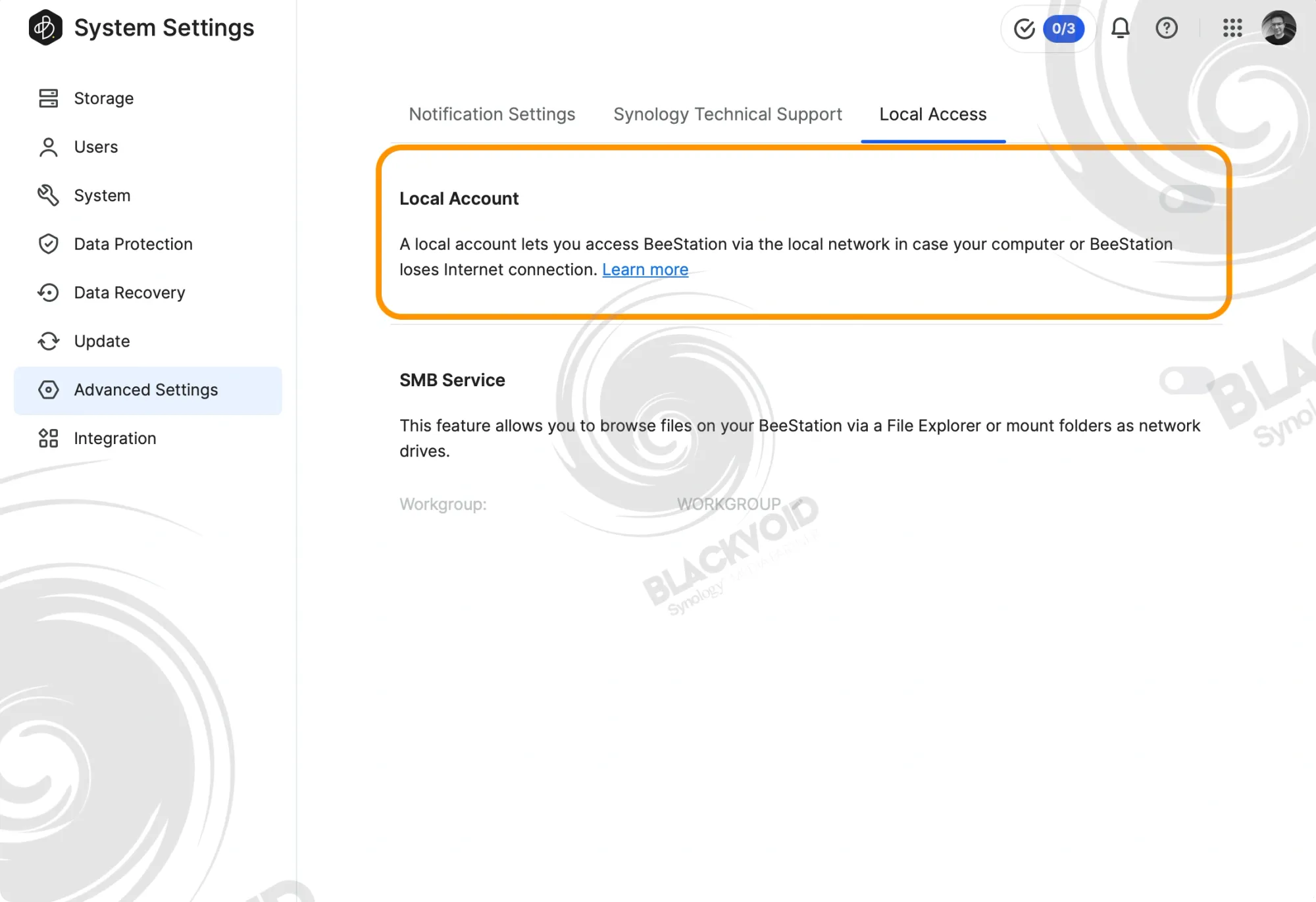
To prevent such a scenario, access to the Beestation can be achieved using the local Beestation account, which is created as soon as the "local access" switch is activated. This setup allows users to access their Beestation through its local IP address using the created local account until the Internet connection is restored.
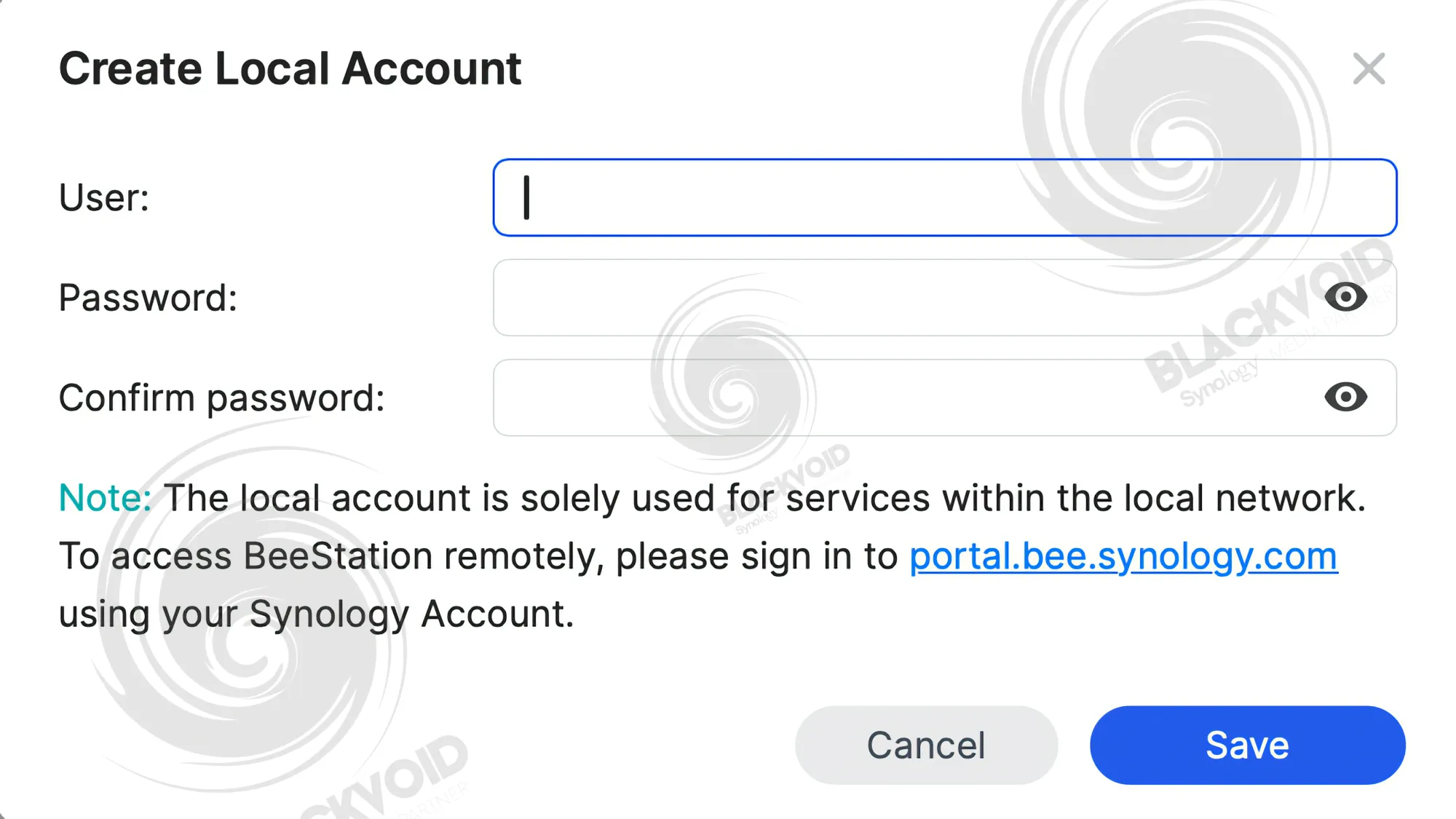
Finally, let's talk about backup. We will delve into this topic in the next section, as it is a critical aspect of data management. Before we explore that, it’s worth mentioning that the system settings allow you to create and invite up to 8 additional users to a single Beestation. Using a straightforward wizard, you can have these users connected to the device within minutes, without requiring advanced configuration or network and port forwarding steps.
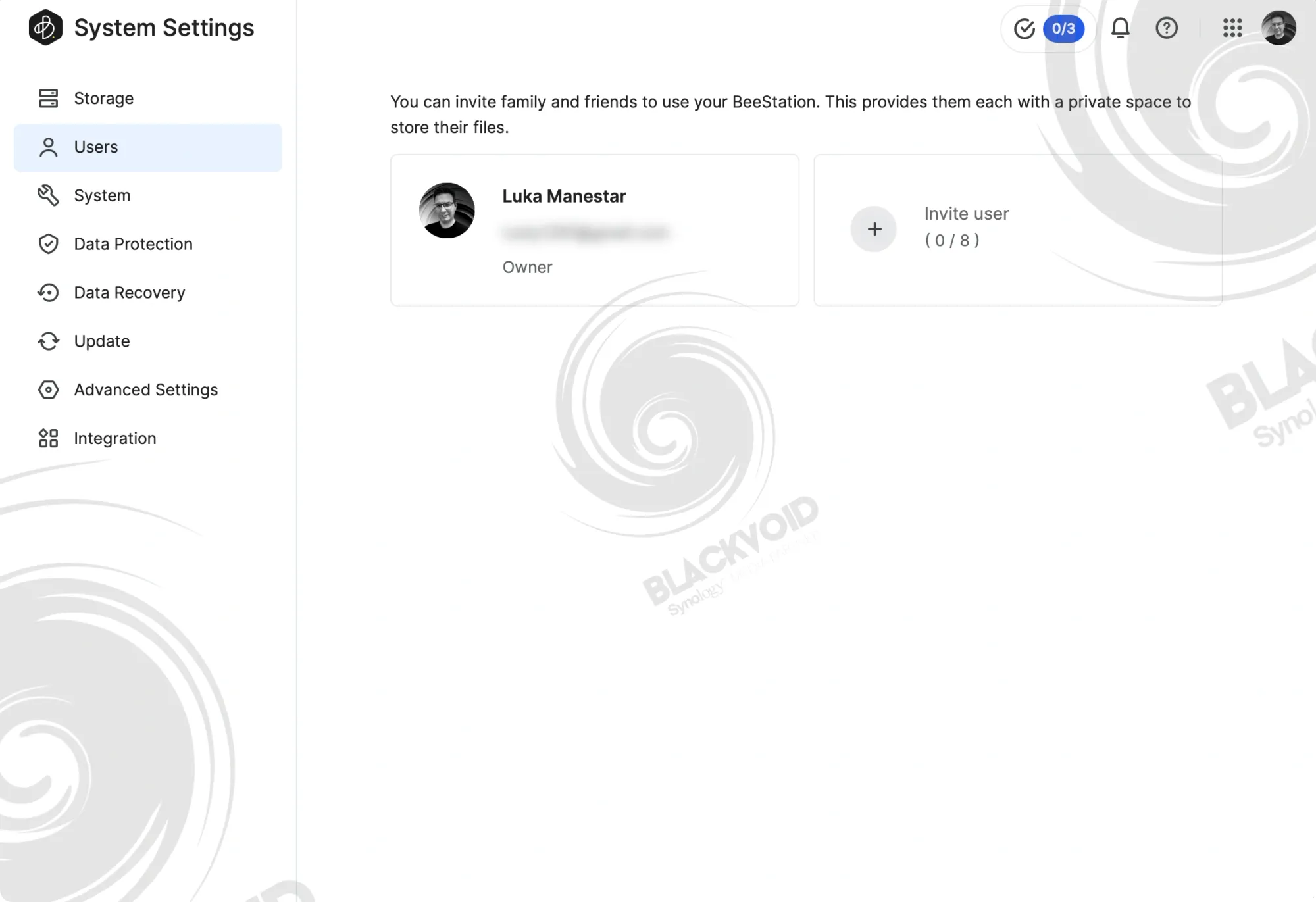
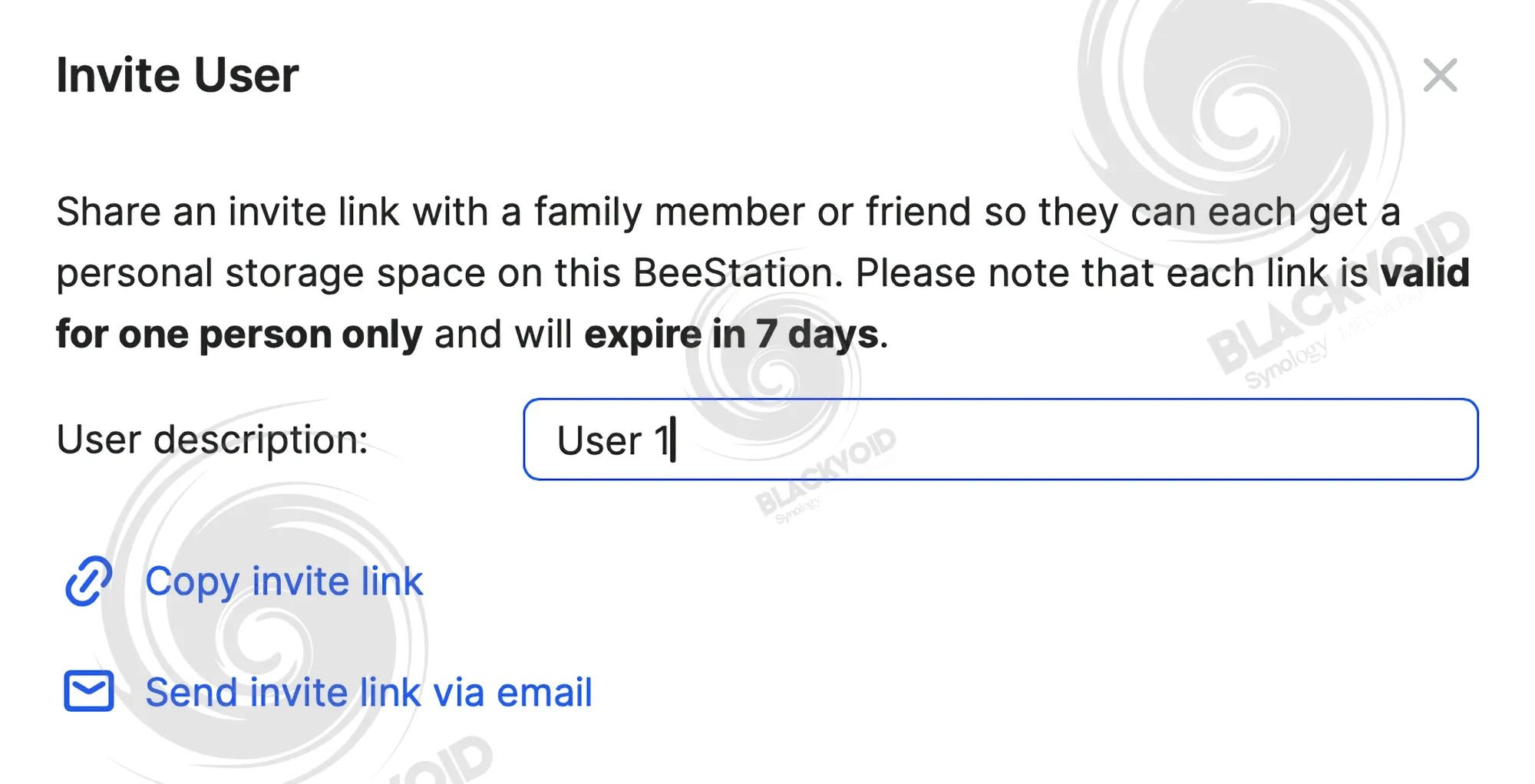
: Backup options
Even though we haven't yet moved any data on the Beestation itself, configuring a backup is a task better configured sooner rather than later.
Compared to the v.1.0, the latest BSM version offers a bit more options when it comes to data backup, including Synology's dedicated BeeProtect cloud service, specifically designed and priced for the Beestation device.
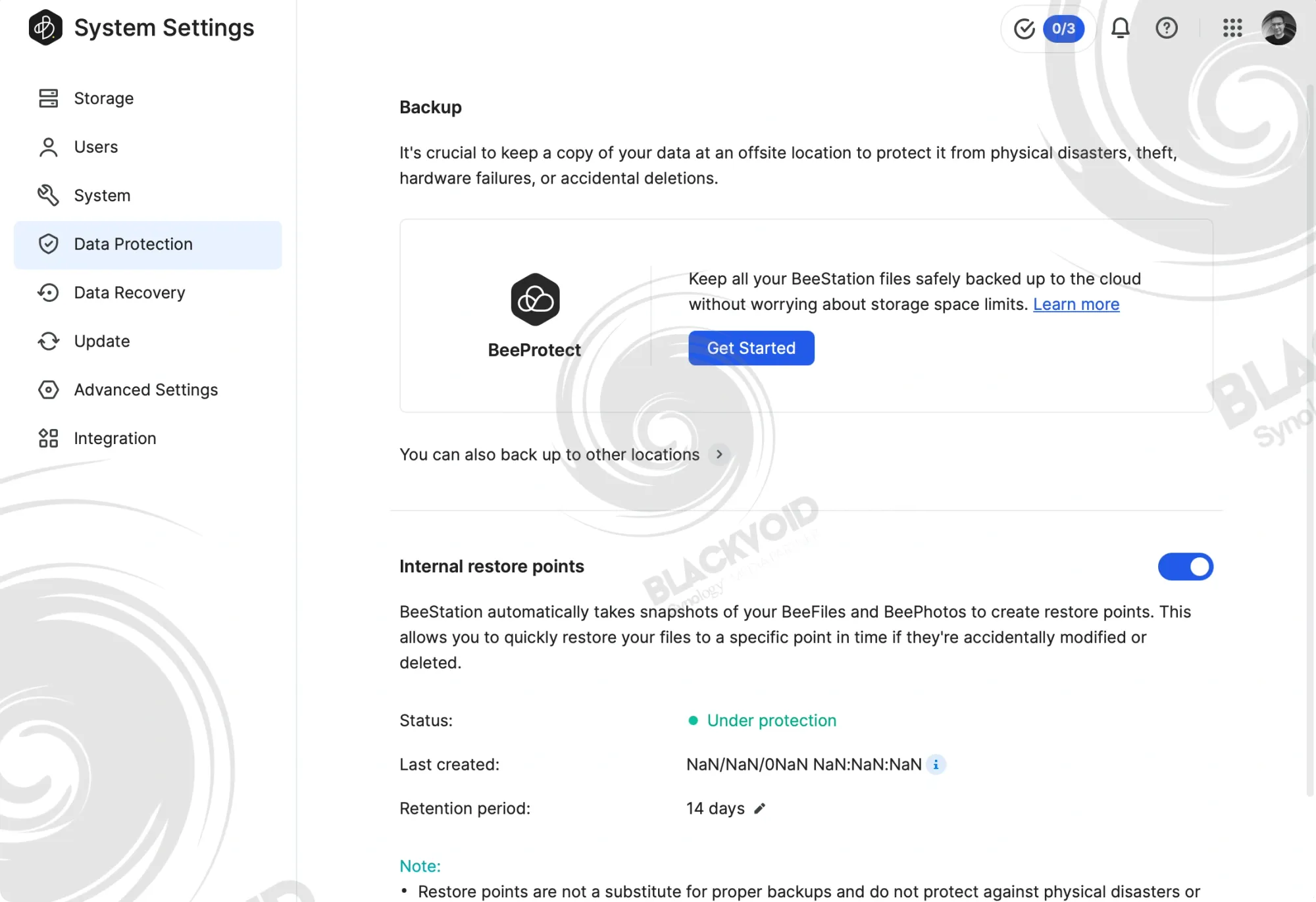
One of the features available is the ability to create internal restore points, often referred to as "snapshots," in addition to traditional backups. These snapshots are both automatic and optional, though they are enabled by default. They have a retention period of up to 14 days, which can be adjusted anywhere between a shorter duration and a maximum of 30 days.
It is important to note that snapshots are not to be considered backups. While they offer an additional layer of protection against accidental file changes or deletions, they do not guard against physical damage to the Beestation itself. Therefore, maintaining a valid backup stored off the device is always recommended.
Speaking of backup, BSM offers a total of four methods: BeeProtect (cloud service), C2 Storage (another Synology cloud service), Synology NAS, and a traditional USB device.

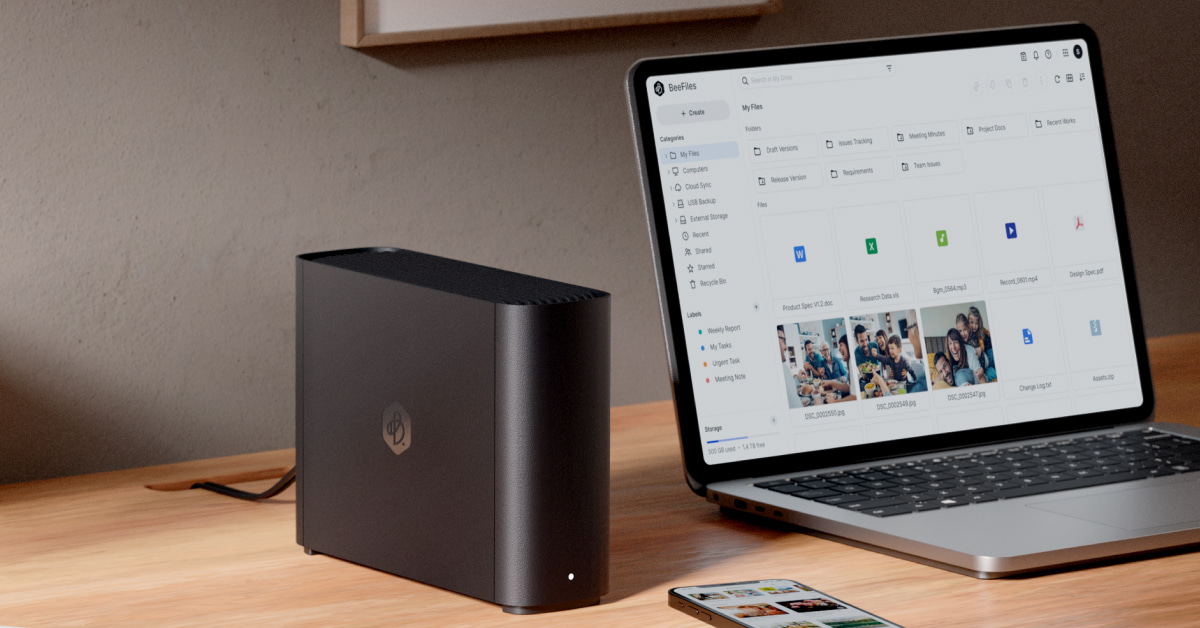
BeeProtect is prominently advertised as a key feature within the System settings, and for good reason. At a fixed price of $150 per year, the entire Beestation, encompassing 8TB of data, can be backed up. In contrast, using Synology's standard C2 Storage service for the same backup capacity would cost approximately $680. Although Synology's service does offer additional features, when examining purely the cost of storage space for backups, BeeProtect is nearly 78% cheaper.
No matter how much data you have on your Beestation, it’s one subscription, one price. You won't need to upgrade for more storage later on.
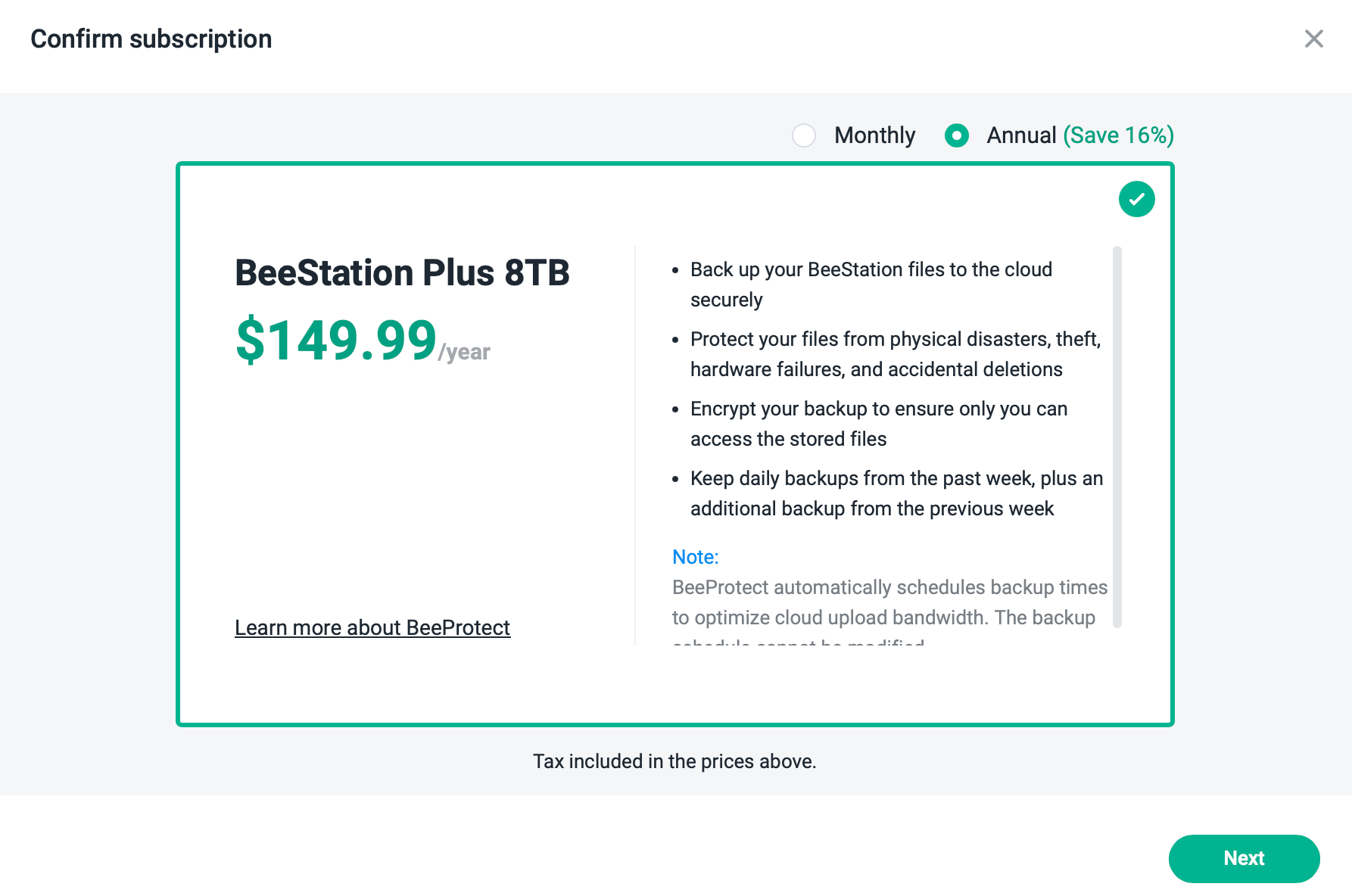
Aside from setting up the subscription and payment method, there's little else to configure with BeeProtect. The backups and their timing are automated and non-adjustable, making it an ideal solution for end-users. This user-friendly approach ensures that less tech-savvy individuals can still maintain a secure and reliable environment.
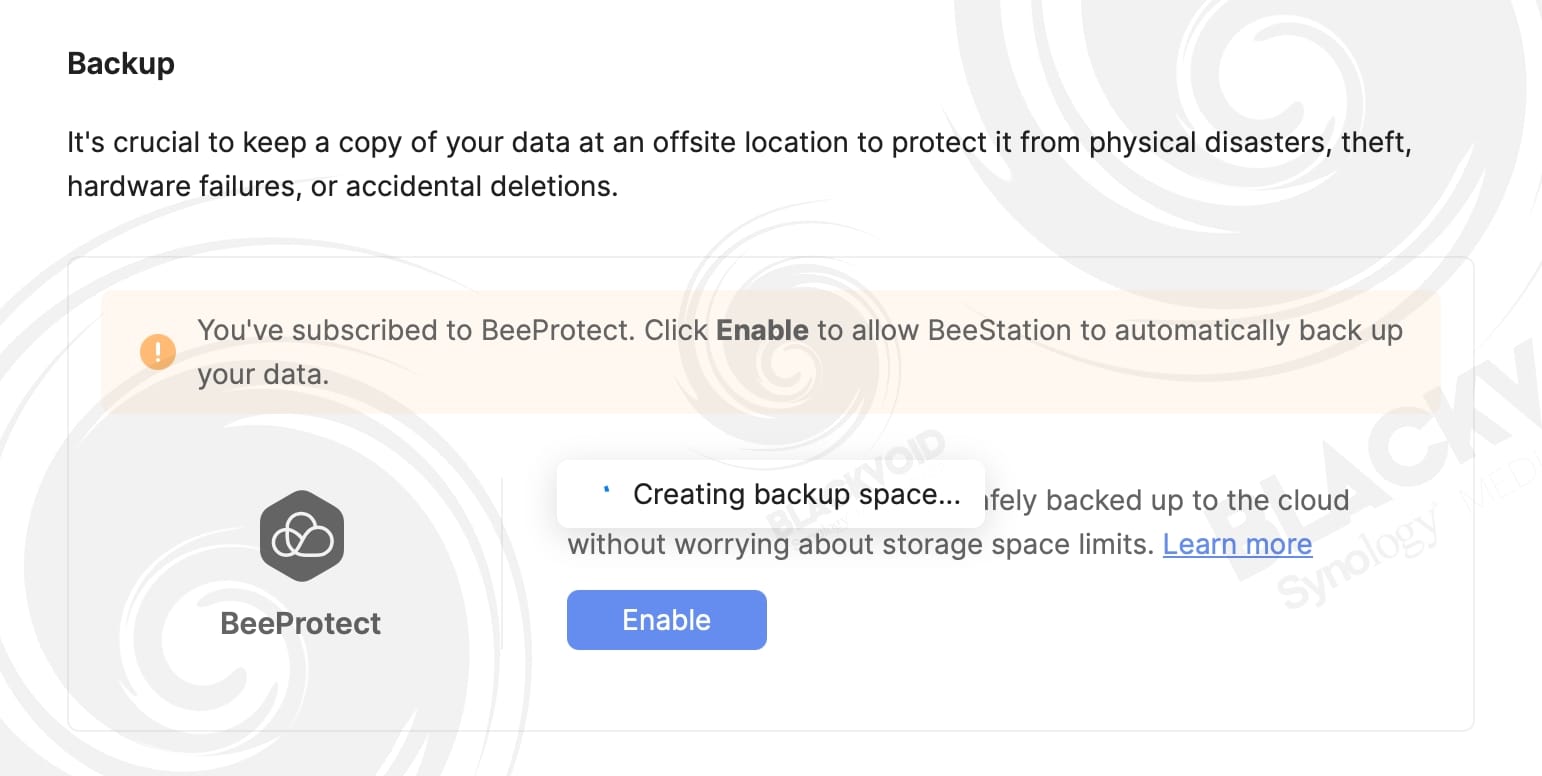
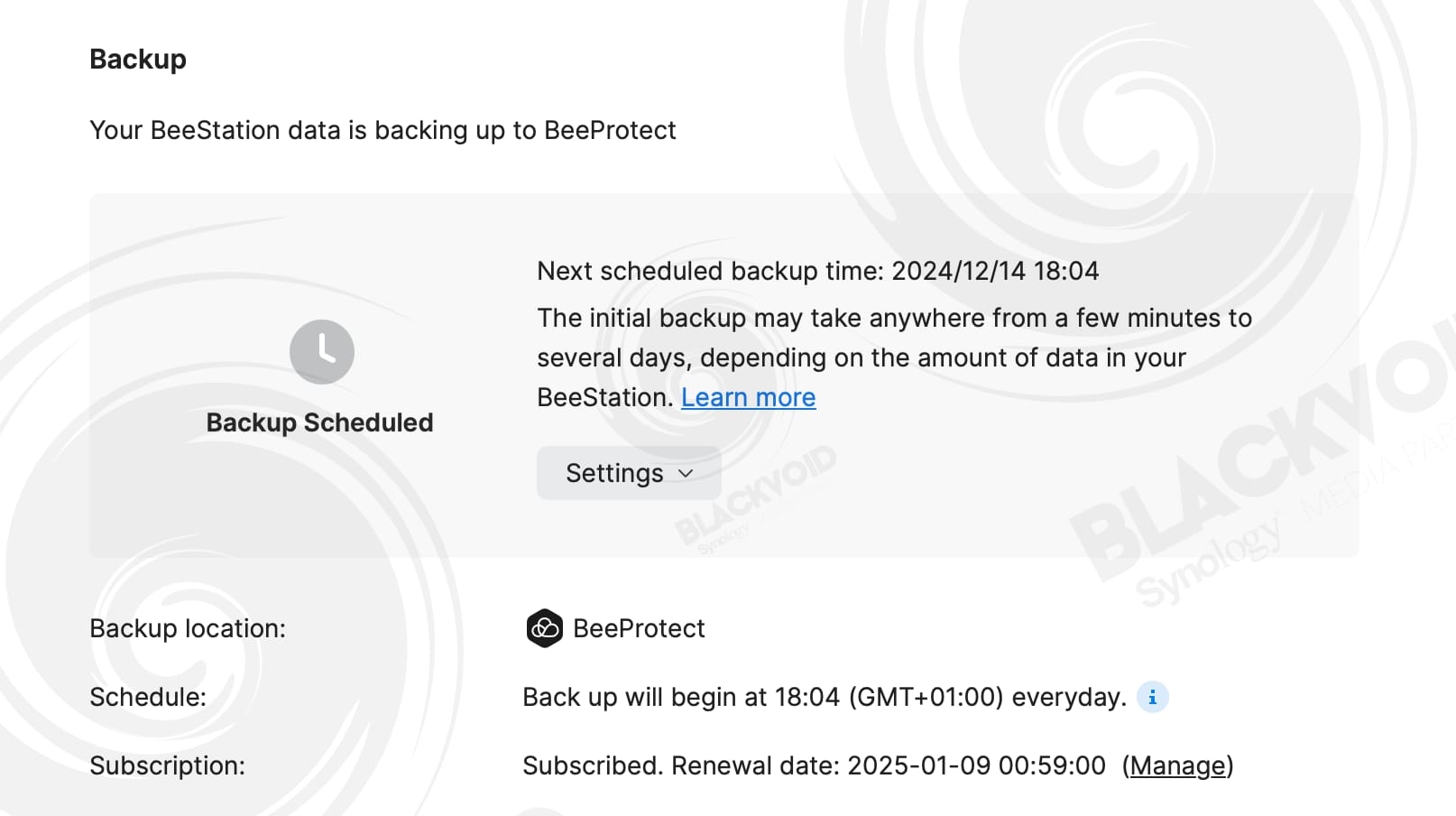
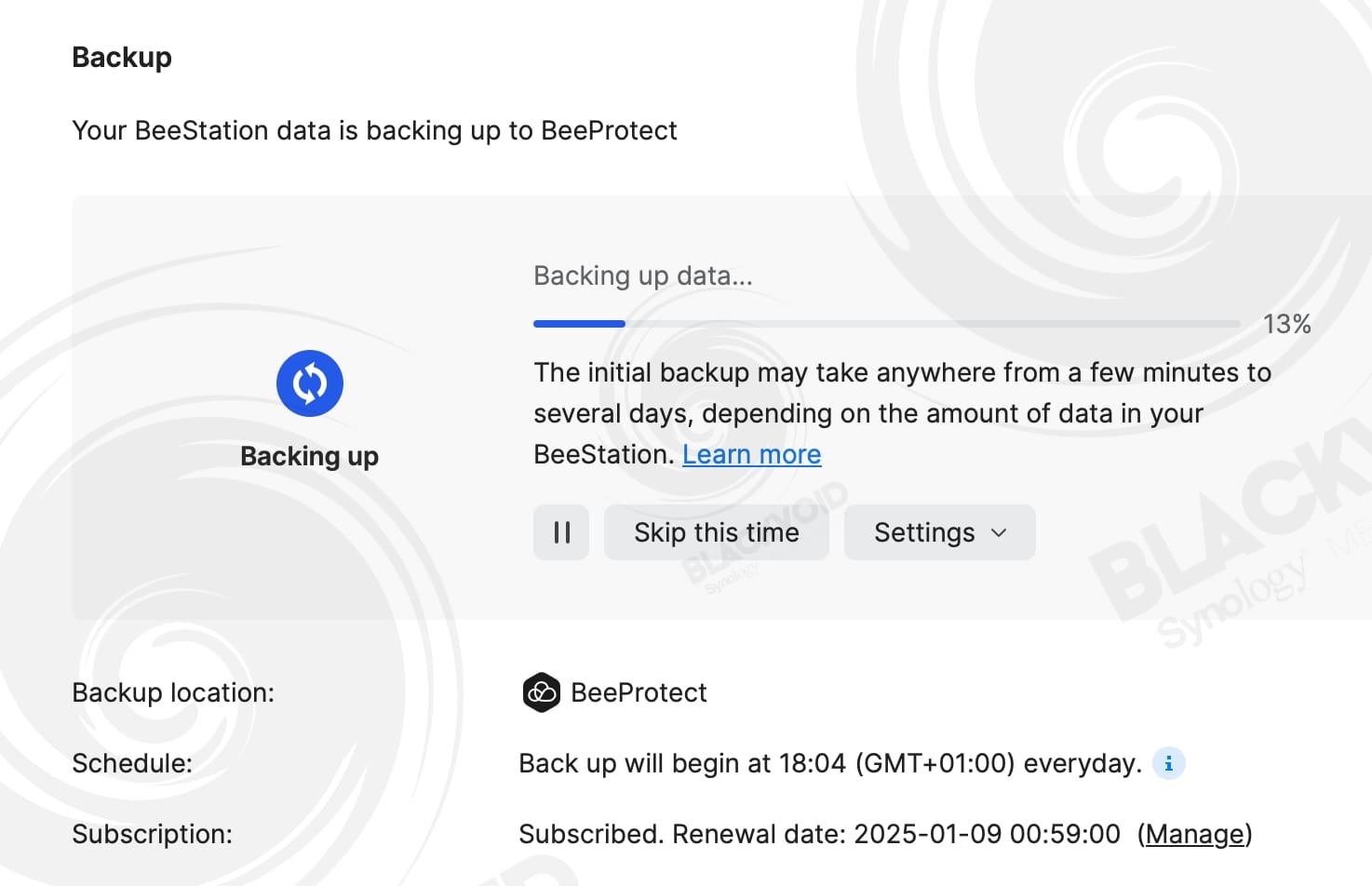
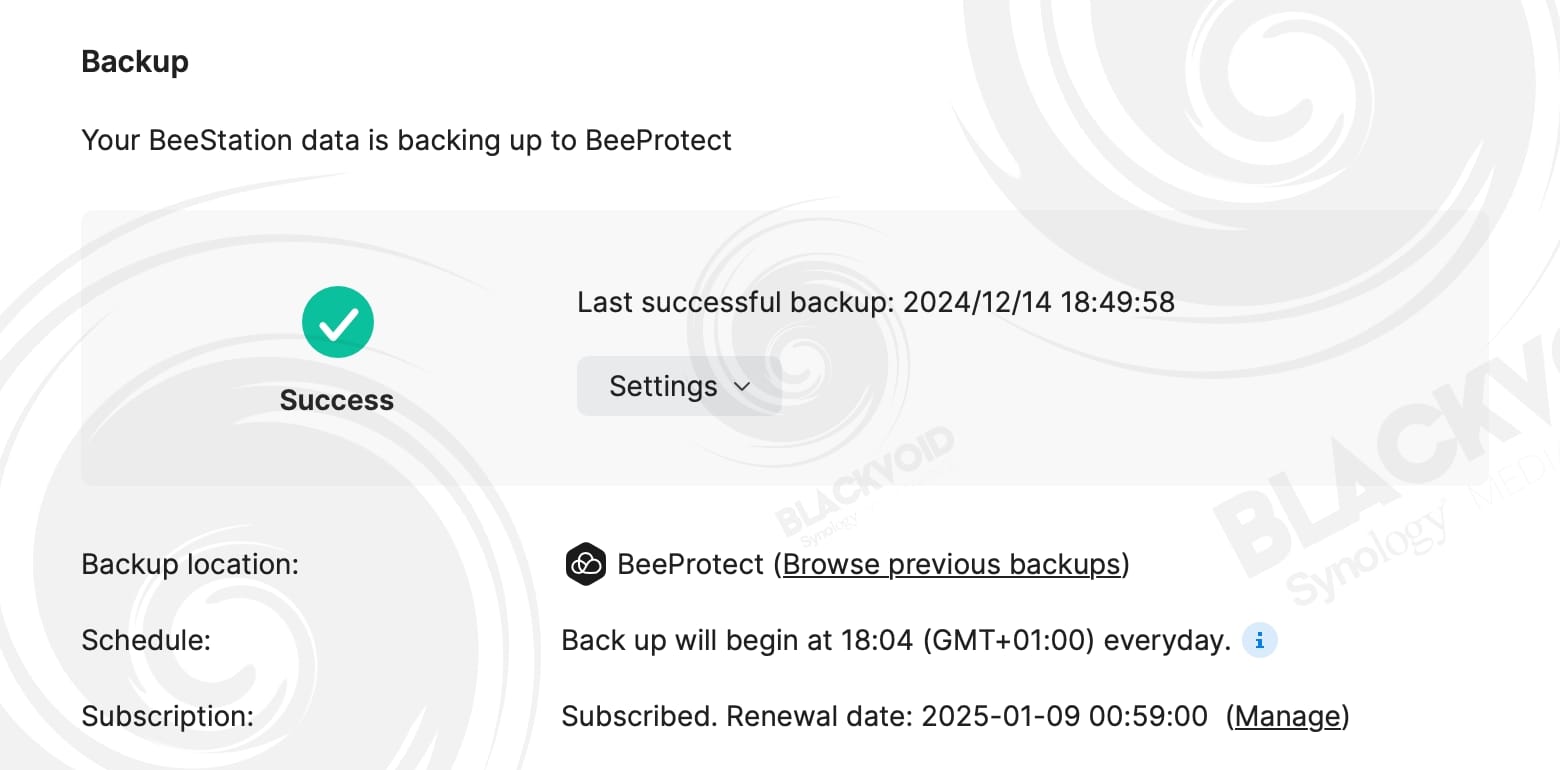
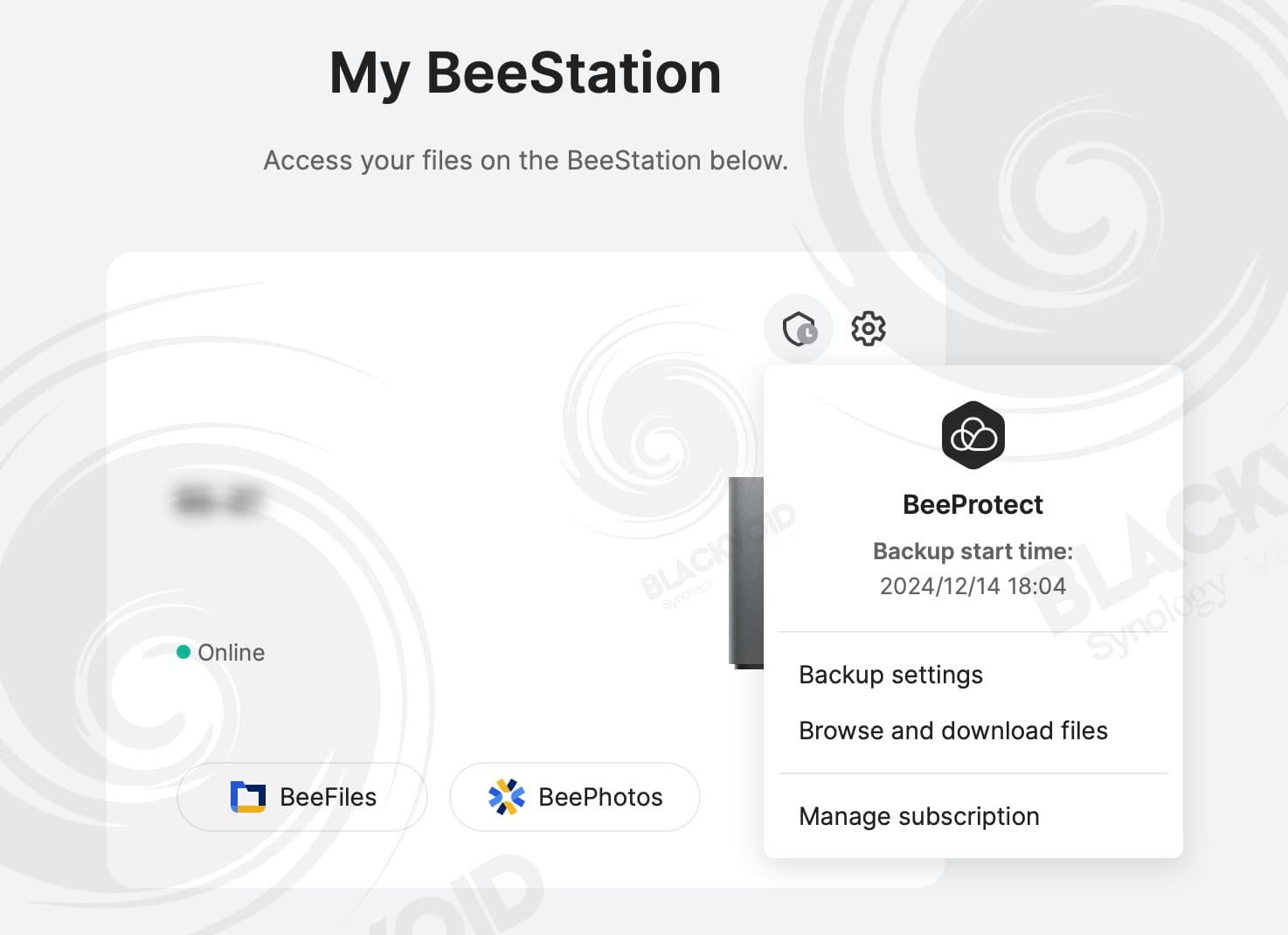
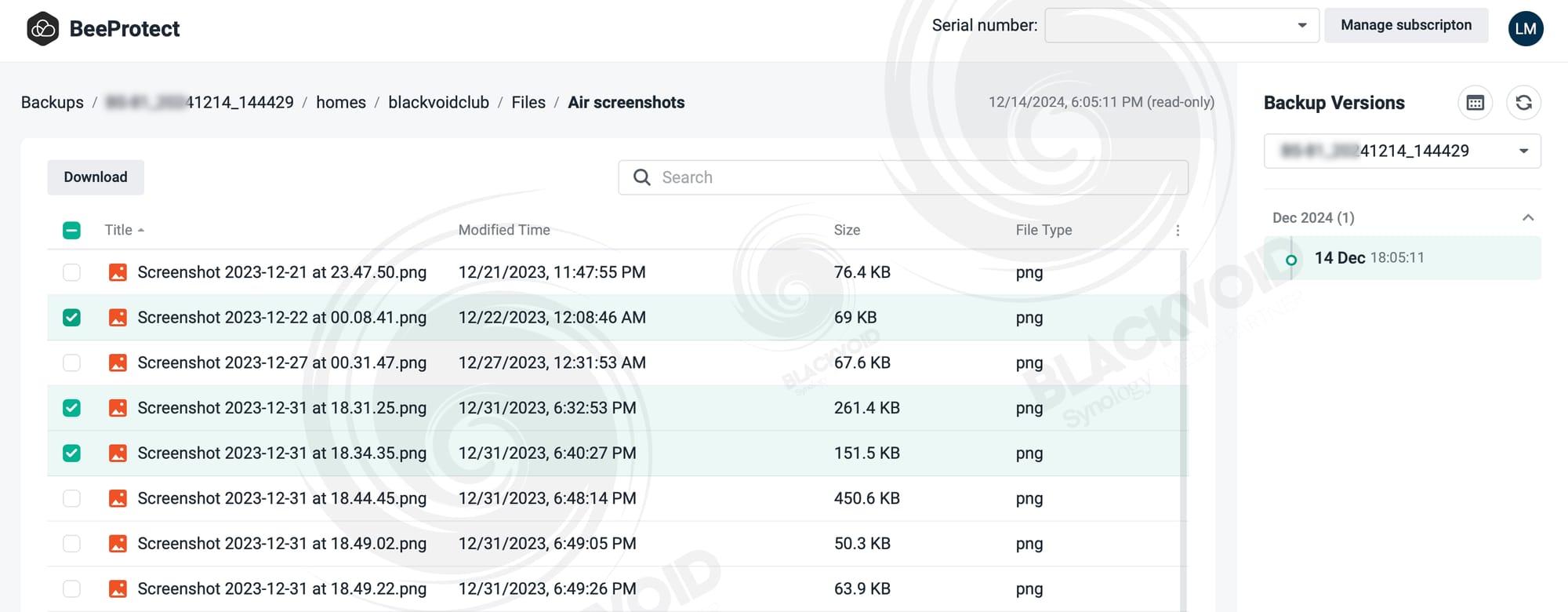
As already mentioned, there are three more backup options that BSM can be configured with.
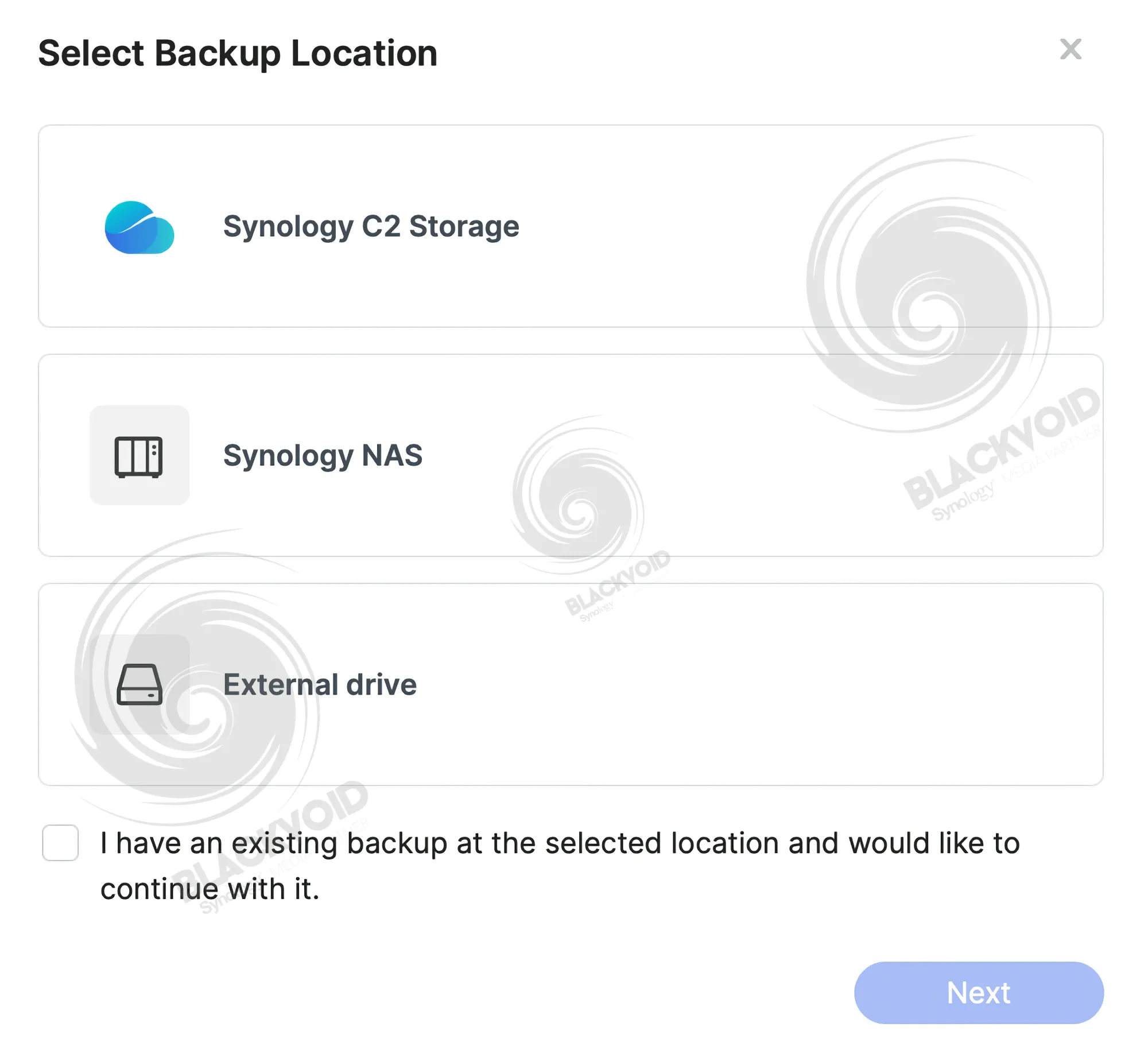
Synology C2 Storage is part of Synology's C2 platform and serves as a cloud-based service. It's designed to be a compatible cloud storage destination for DSM's and BSM's Hyper Backup platform, providing end users with a straightforward solution to back up their on-premises content. Like BeeProtect, C2 Storage is a commercial service offered in two main tiers and requires a valid Synology Account.
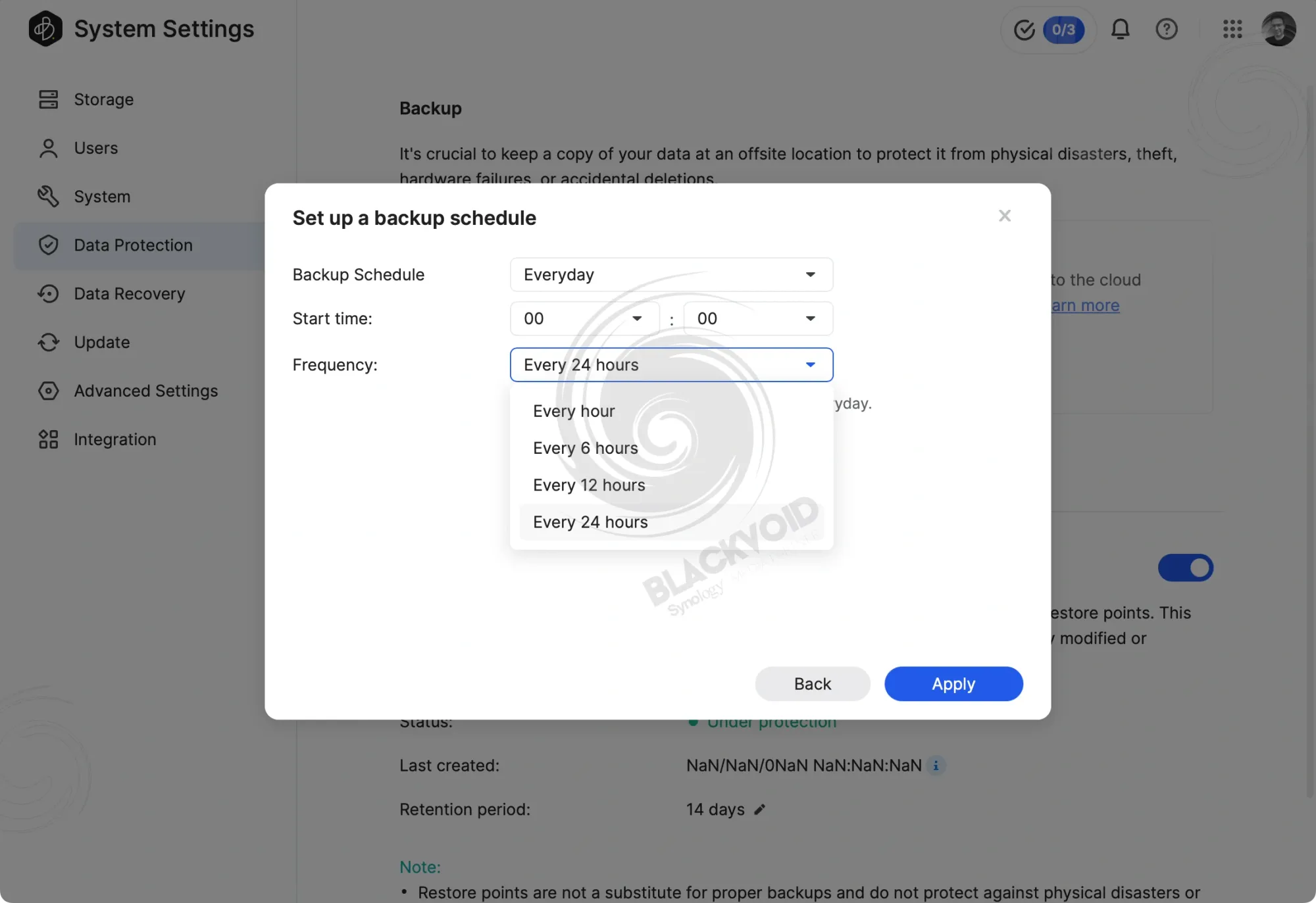
Once the subscription is established, configuring it is simple. The service provides a limited set of options, including the backup schedule, time, and frequency. By default, backups can be scheduled daily or on preselected days along with a specified start time. While daily frequency is standard, users can also choose intervals of 12, 6, or 1 hour.
In terms of speed, the C2 backup depends on the data type, the specific data center, and the upload speed. However, compared to local network or USB transfers, this method will undoubtedly be the slowest.
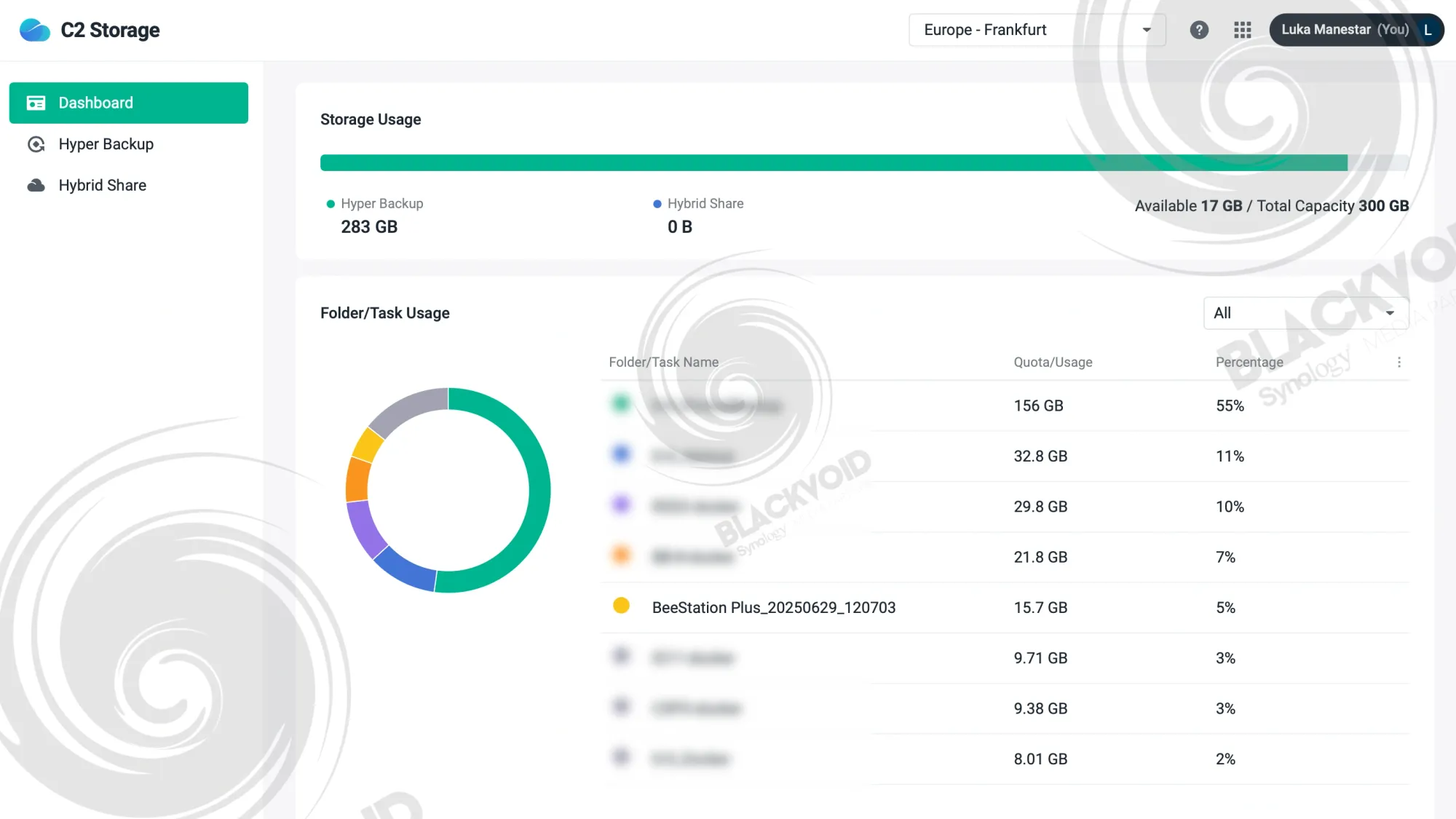
A sample backup of approximately 17GB, consisting of mixed file sizes (large and small), took about 11 minutes to complete, with an average speed of around 26 MB/s.
Backing up to a remote Synology NAS is as straightforward as using the C2 Storage method. The primary difference lies in the need to initially connect to the Synology NAS device intended for use as our remote backup destination.
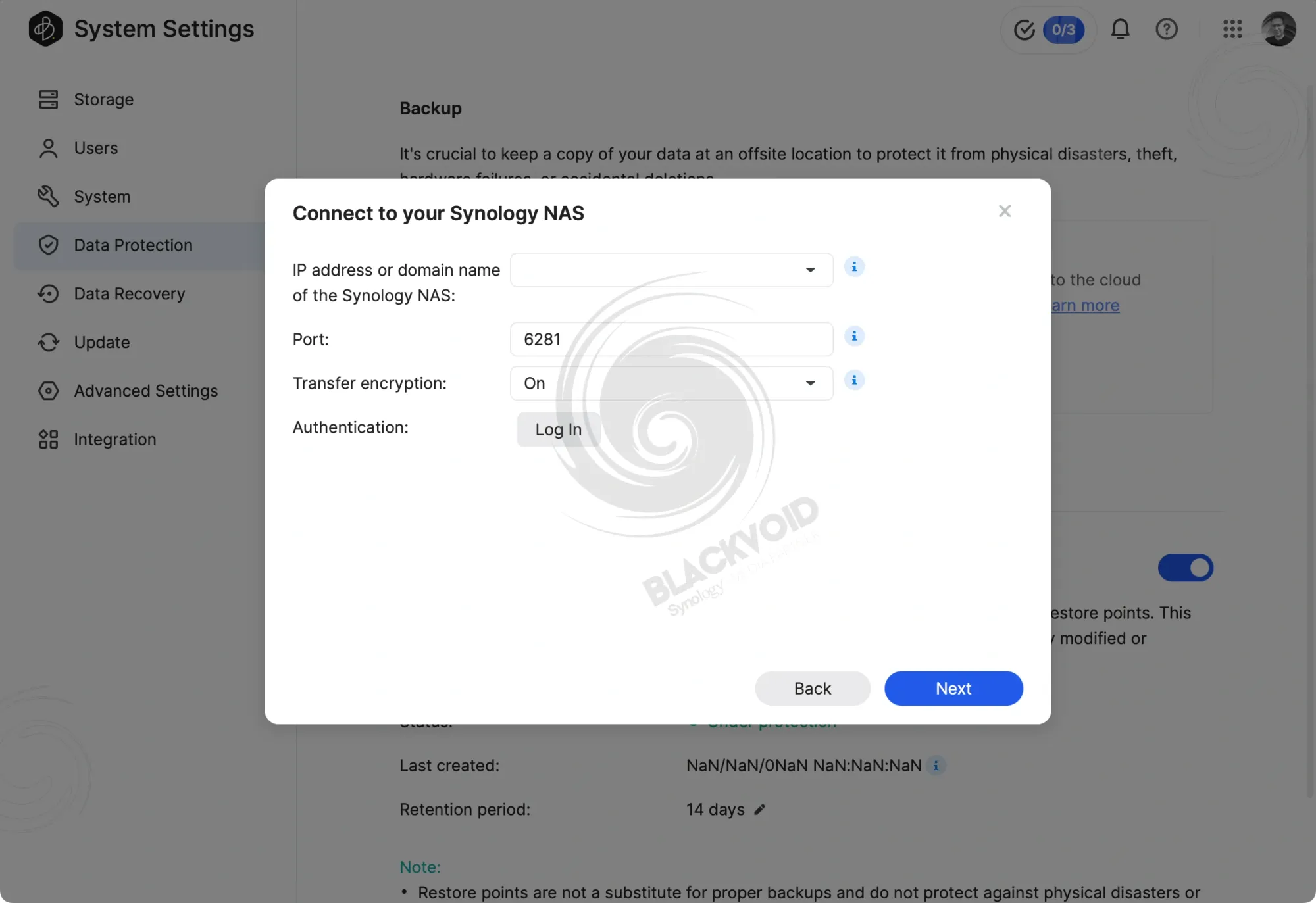
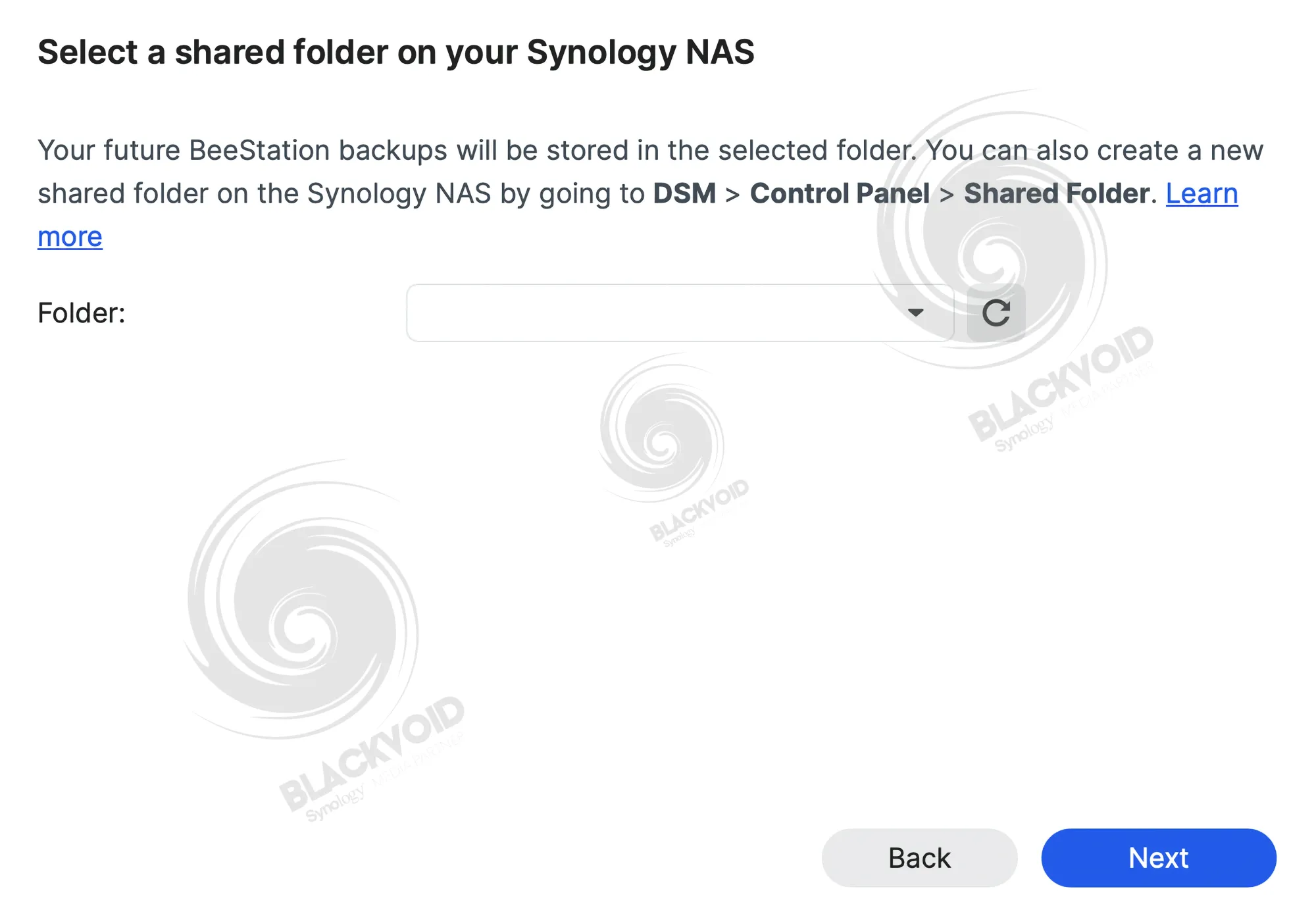
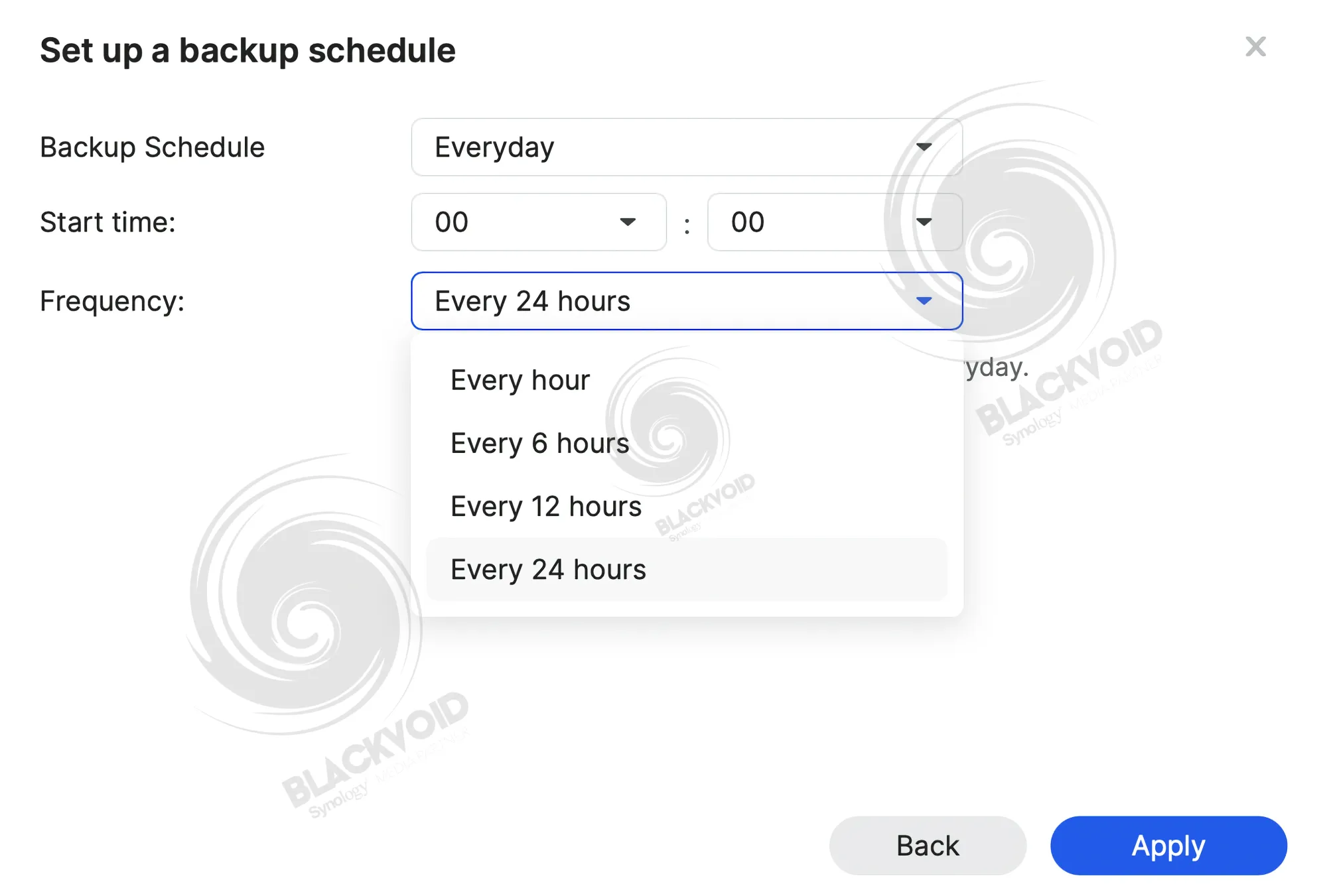
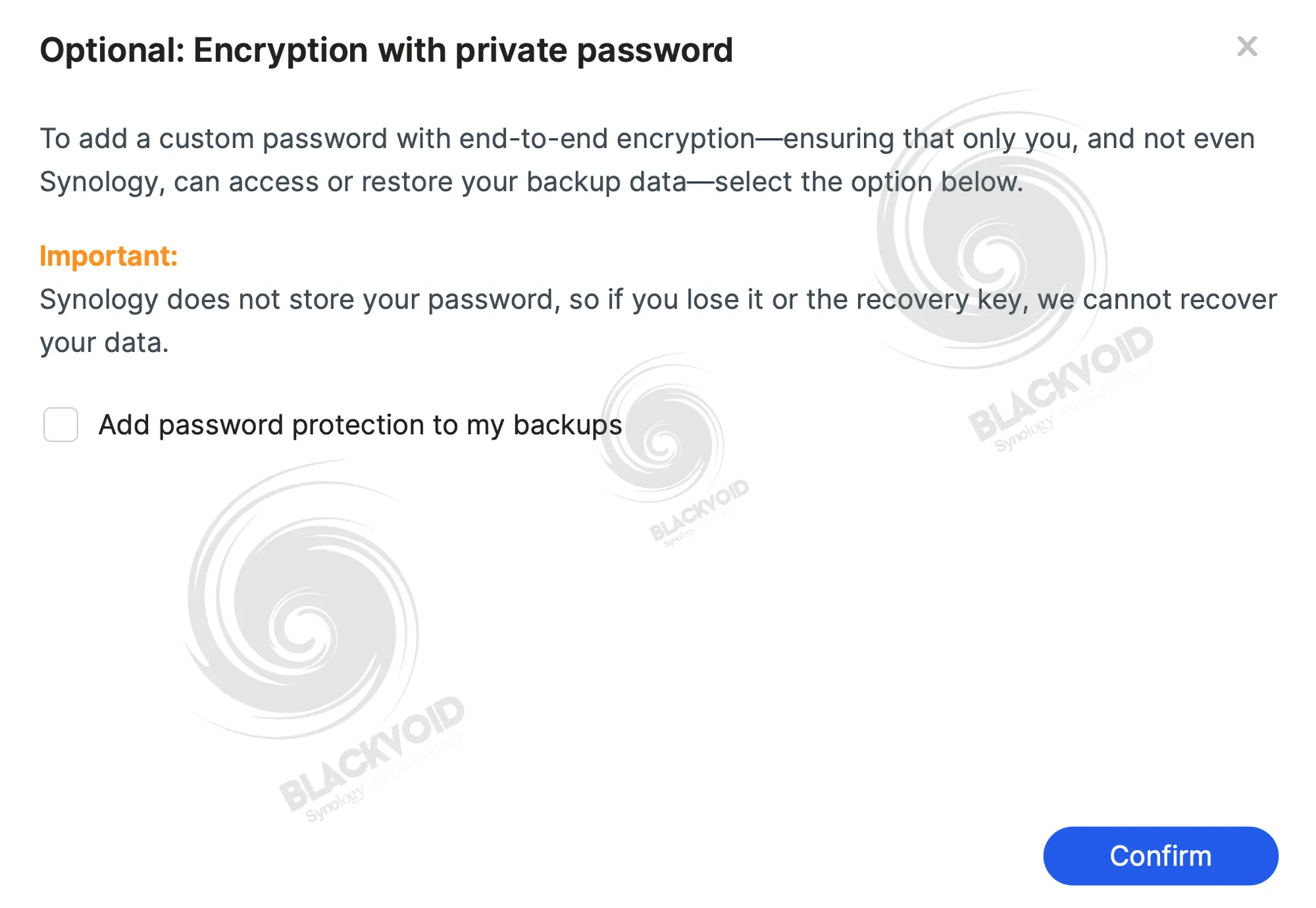
Once configured, the backup will start according to a predefined schedule. While this process involves more steps than the C2 configuration, it is expected due to the flexibility we have to target any compatible Synology NAS.
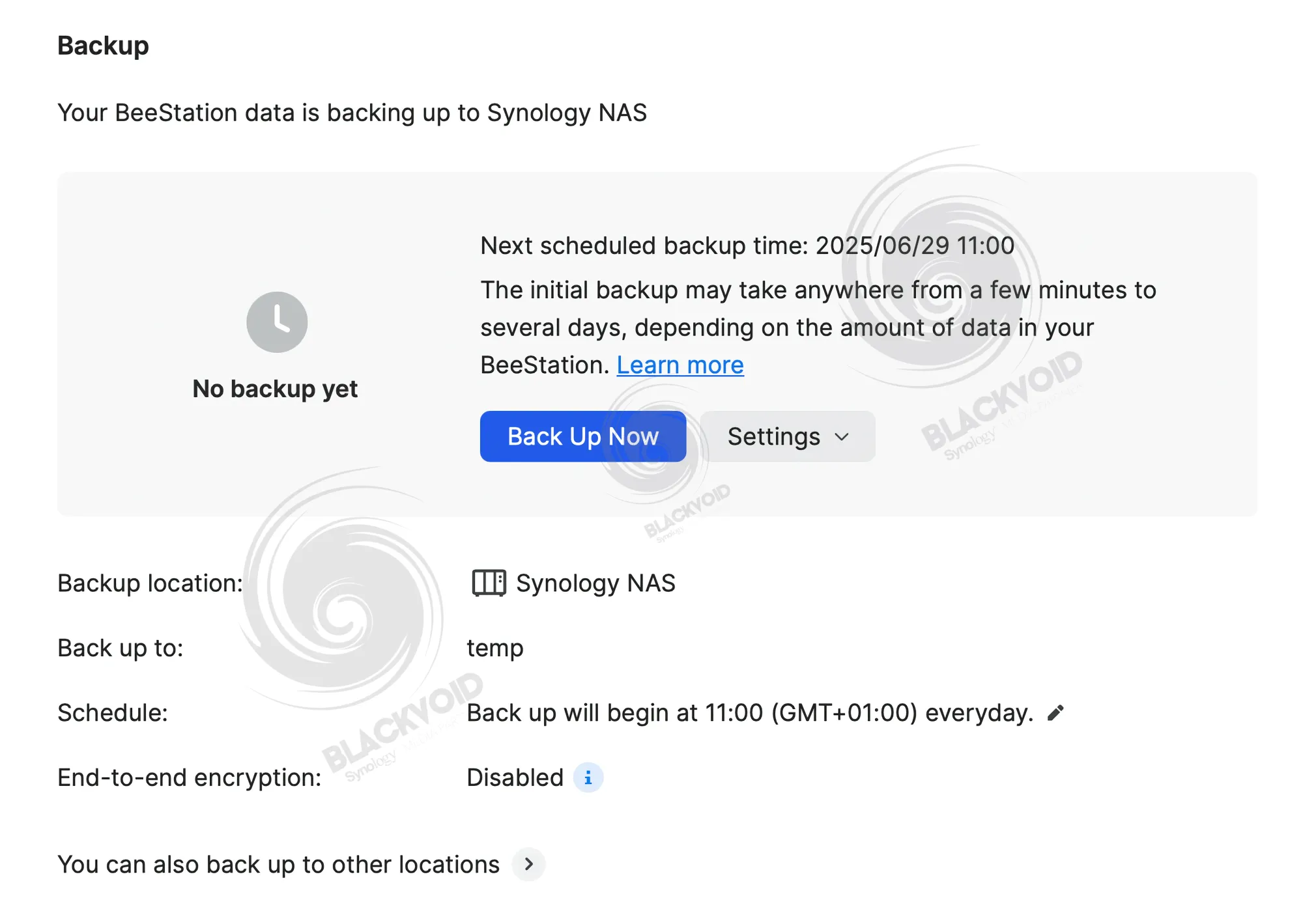
The USB method is the simplest of all. Once the drive is detected, the same schedule window will appear, allowing us to start backing up immediately. The backup process meets all expectations except for the data transfer speed. Although this is typical for an SOHO device, it would be beneficial to have a real-time display to gauge the progress and speed of the data transfer.

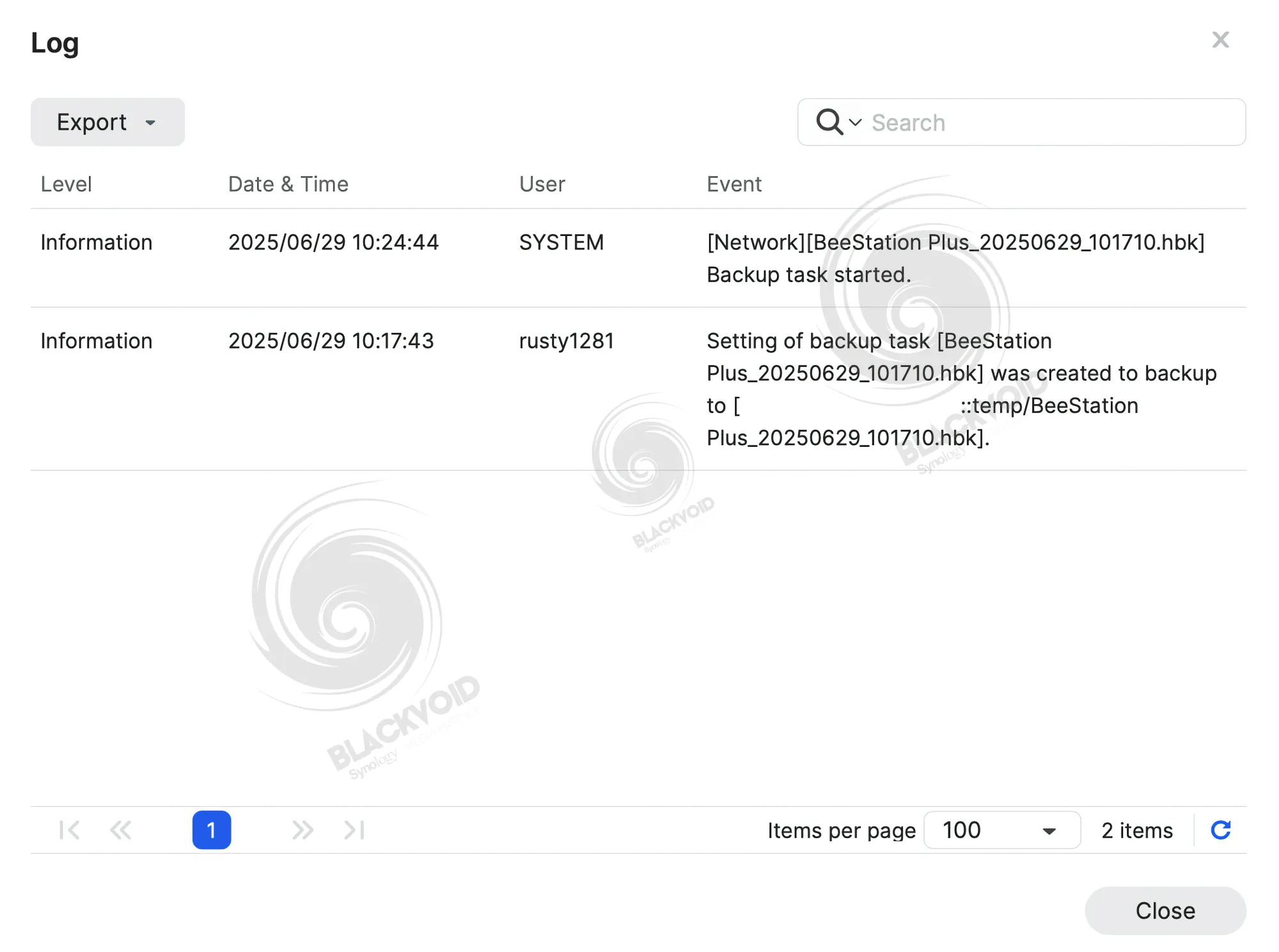
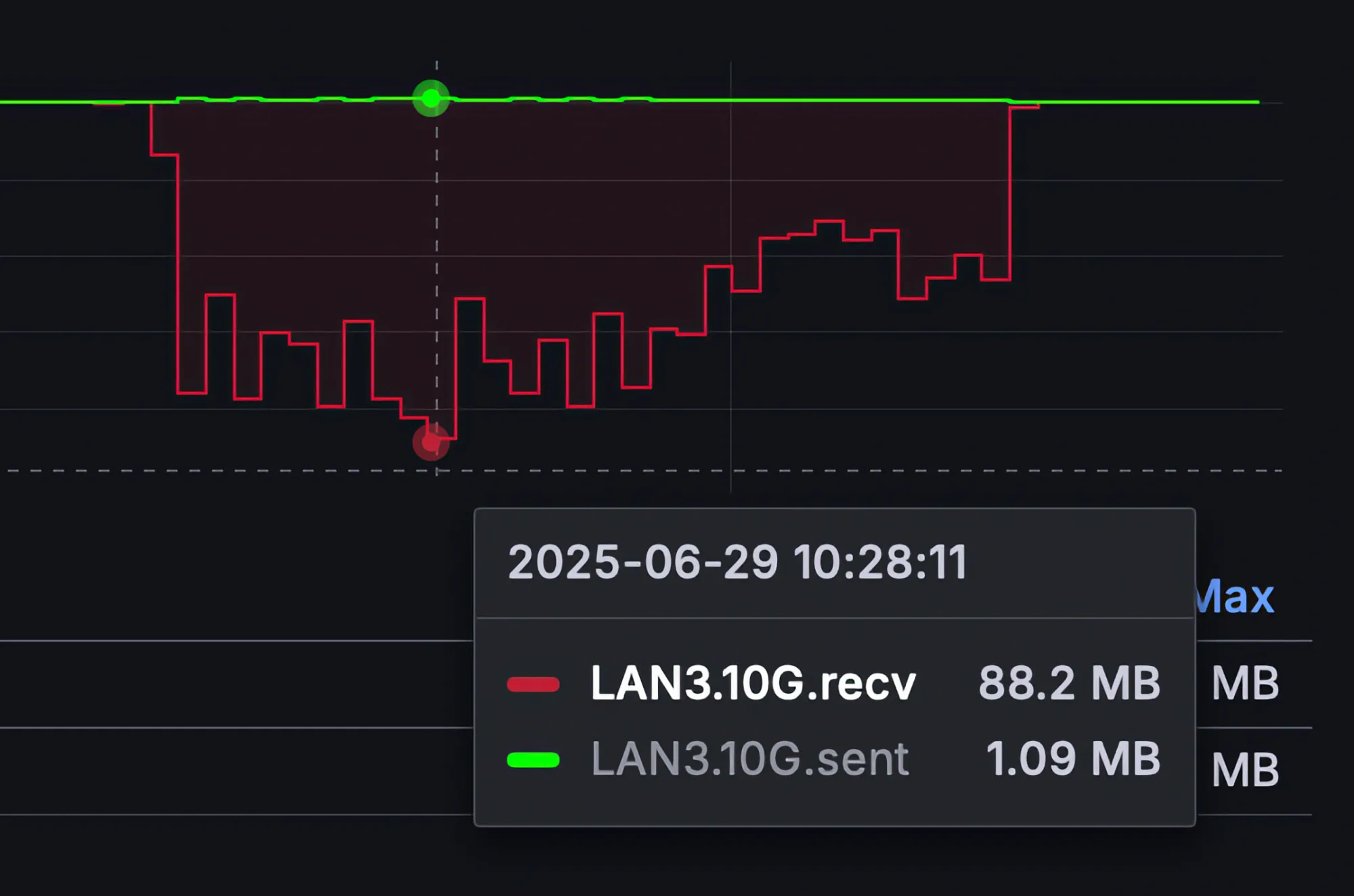
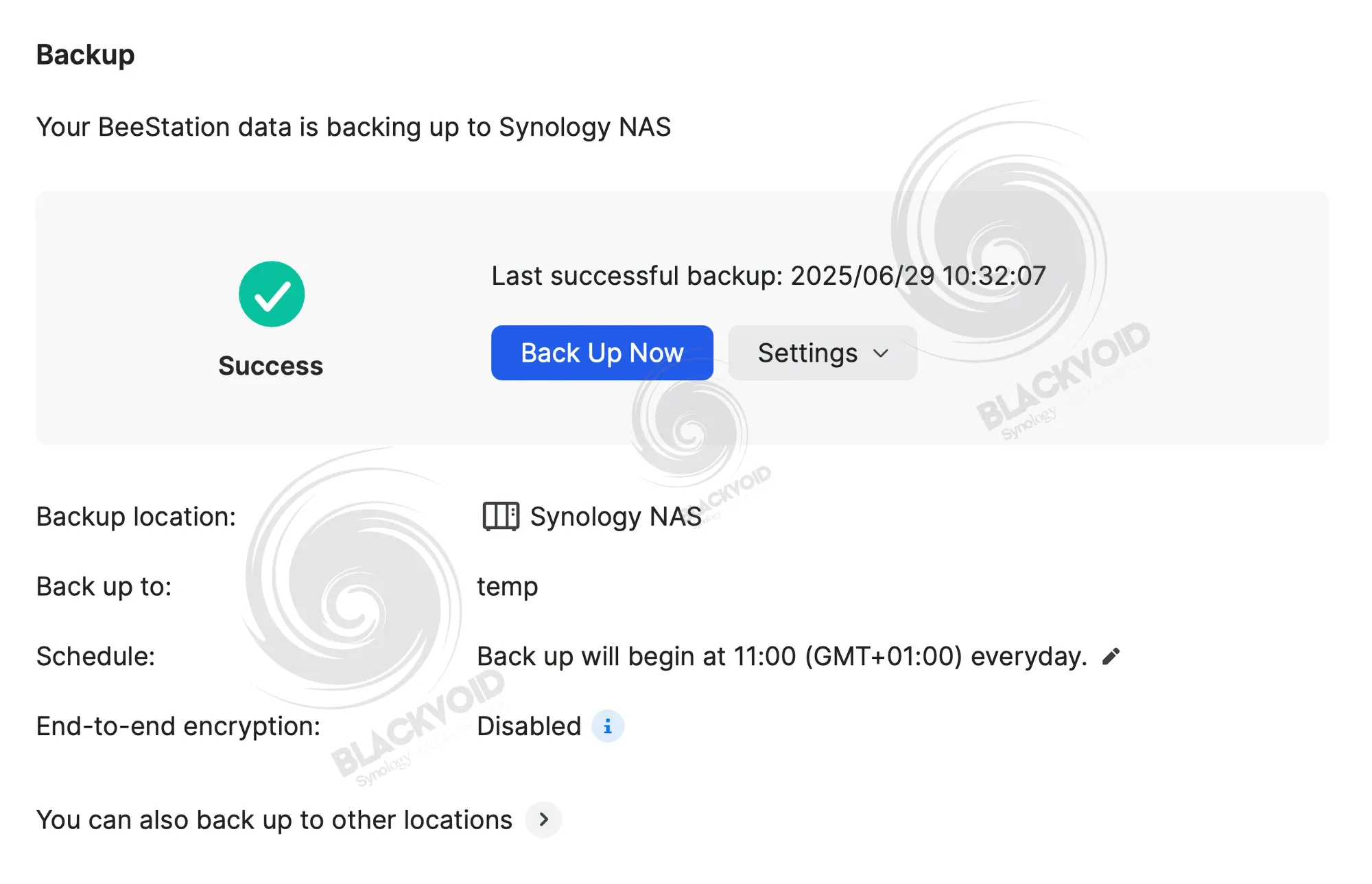
The network backup speed is capped at 100 MB/s due to interface limitations. However, the speed may fluctuate depending on the composition of the data. In a backup test involving the same 17GB backup sample, Beestation took around 8 minutes to complete with an average speed of about 36 MB/s.

One last aspect of backup configuration that wasn't previously mentioned is versioning. Similar to the Hyper Backup configuration on DSM, BSM also supports versioning. Although there aren't any version configuration settings available during job creation, we can manage them afterward.
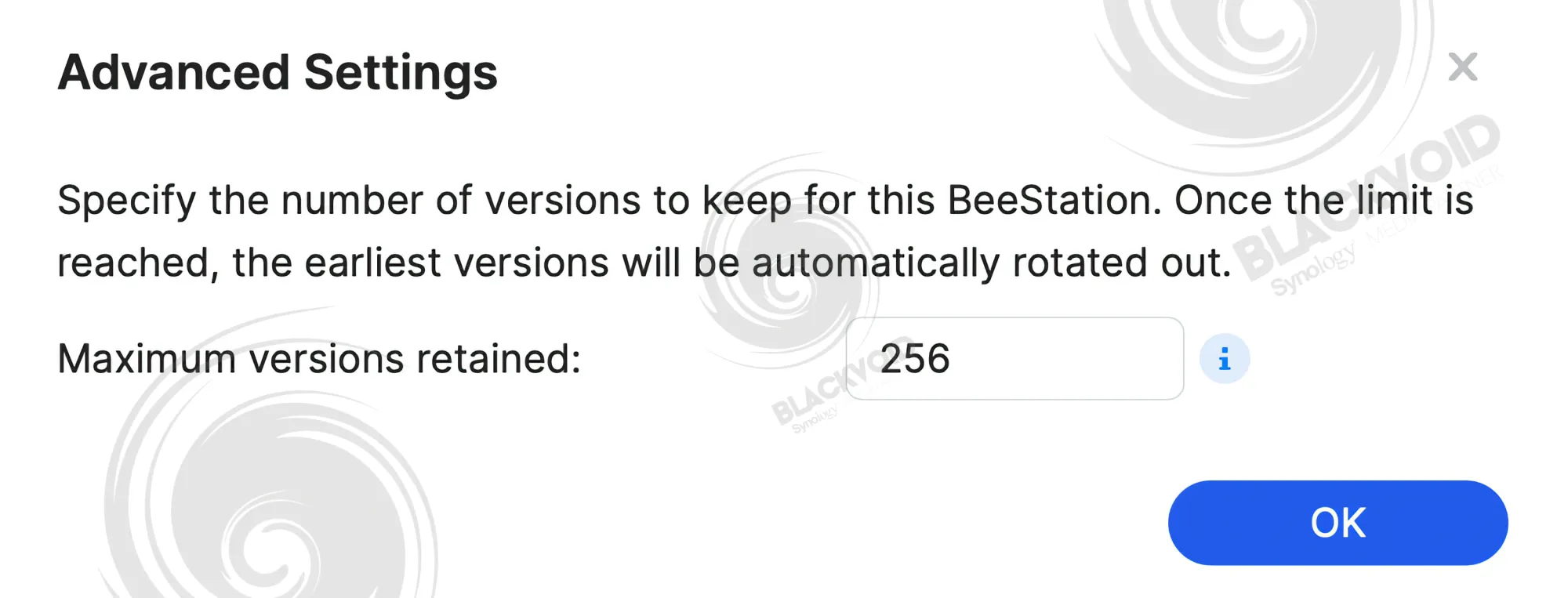
By utilizing the advanced settings options in the backup job, we can specify the maximum number of versions retained to better manage disk space on the Beestation itself.
:: Backup restore
The restore process for C2 or remote Synology NAS involves using the Hyper Backup Vault application on your desktop (or on the actual NAS) or the C2 cloud version. Unless recovery is being done from a USB drive, the process will require data to be copied rather than restored directly to the original location.
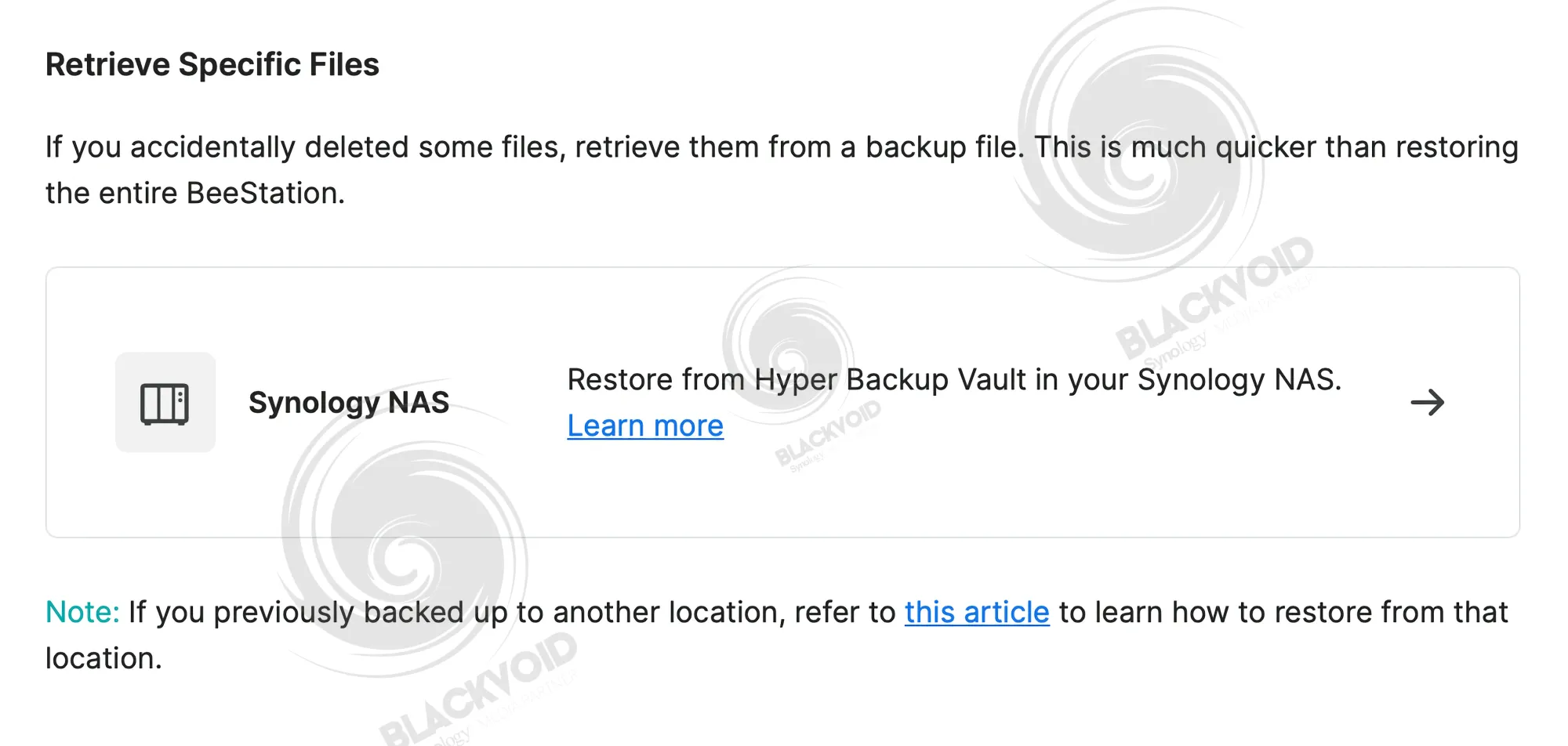
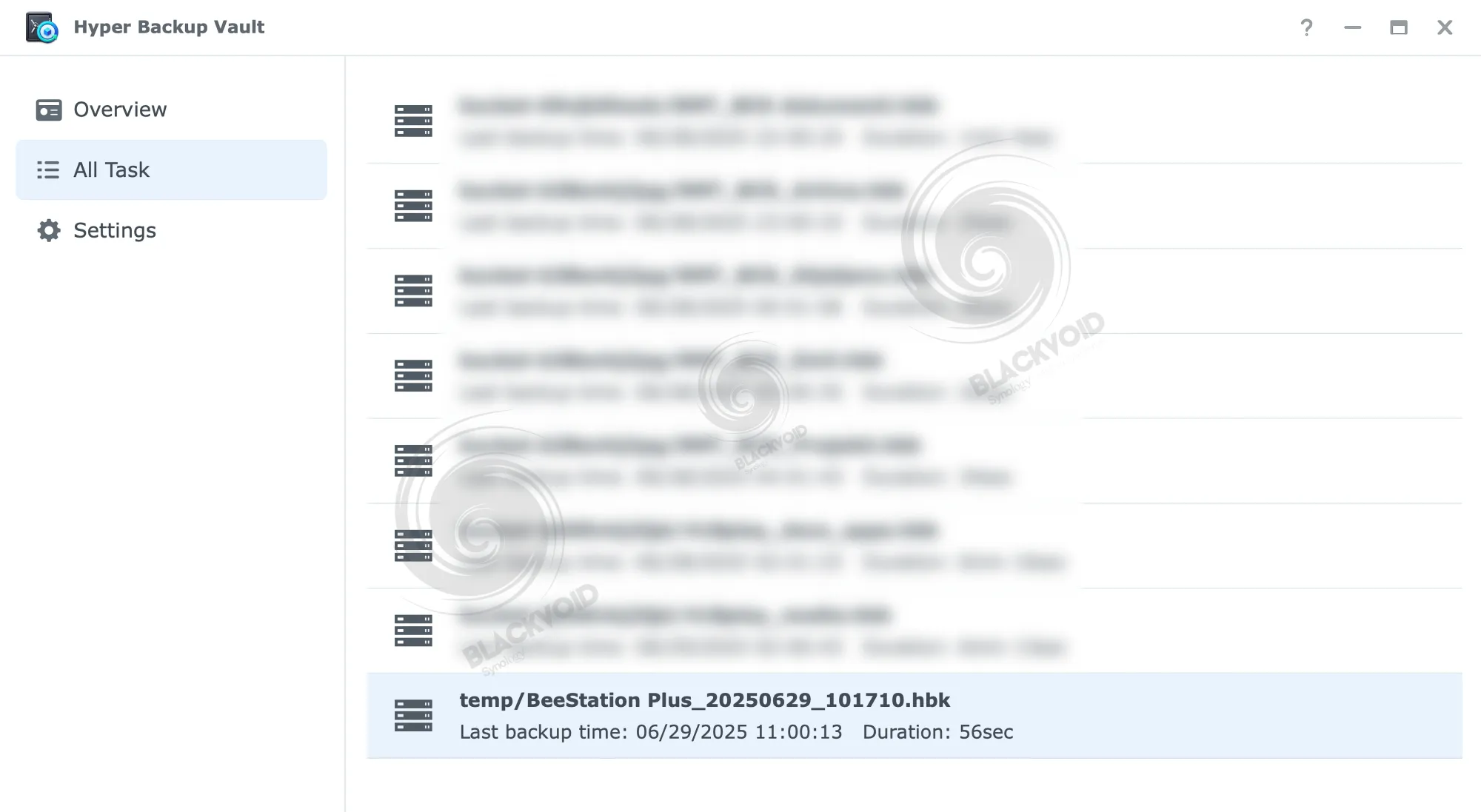
Accessing the Vault application, we have the option to choose between backup versions and select any data that we want to copy to the NAS device or download on any device that we are using the Vault application from.
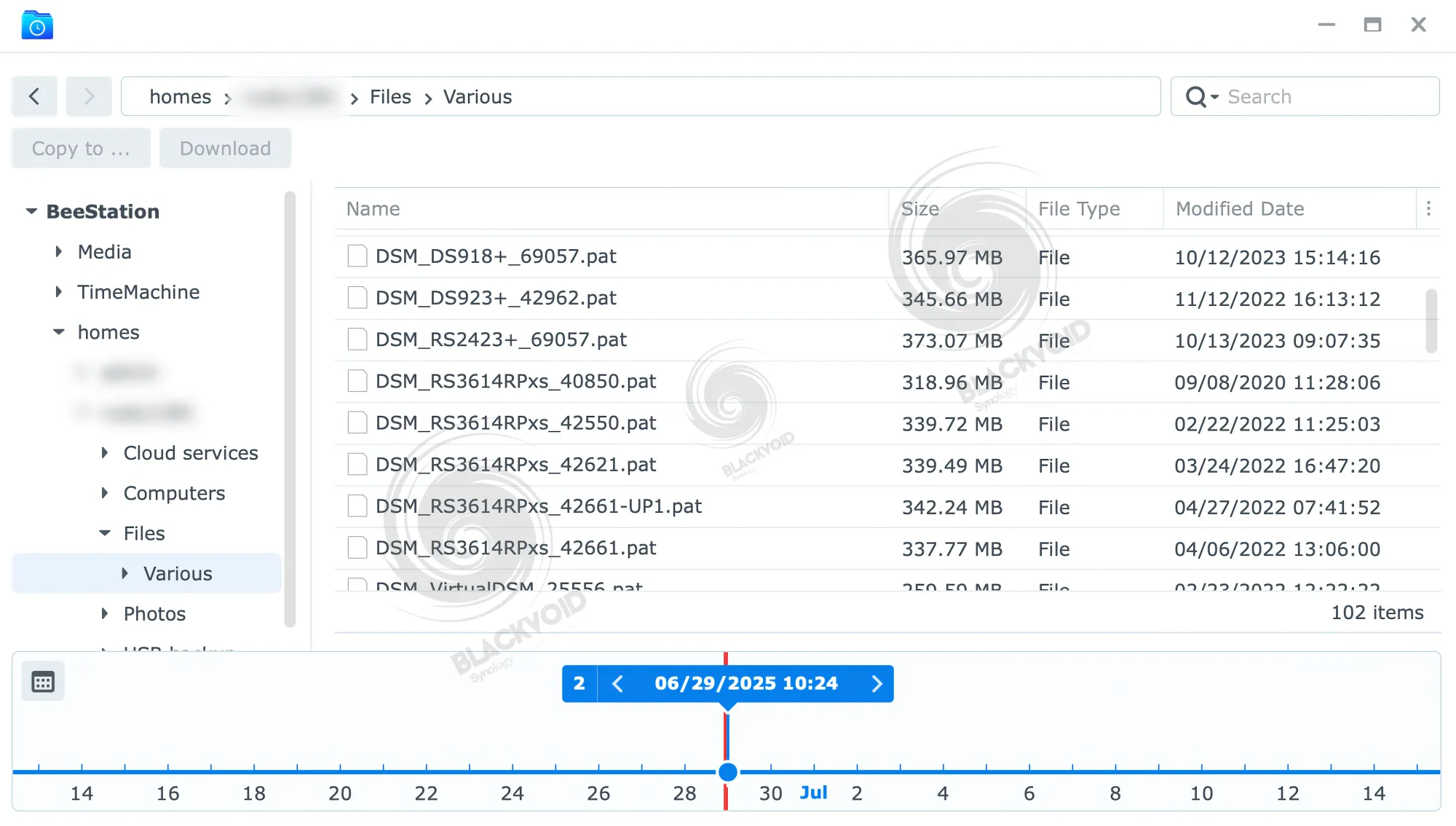
Restoring a single file using the above method is faster than restoring the entire Beestation, which is also an option. Depending on what needs to be restored, we can choose either the former or the latter.
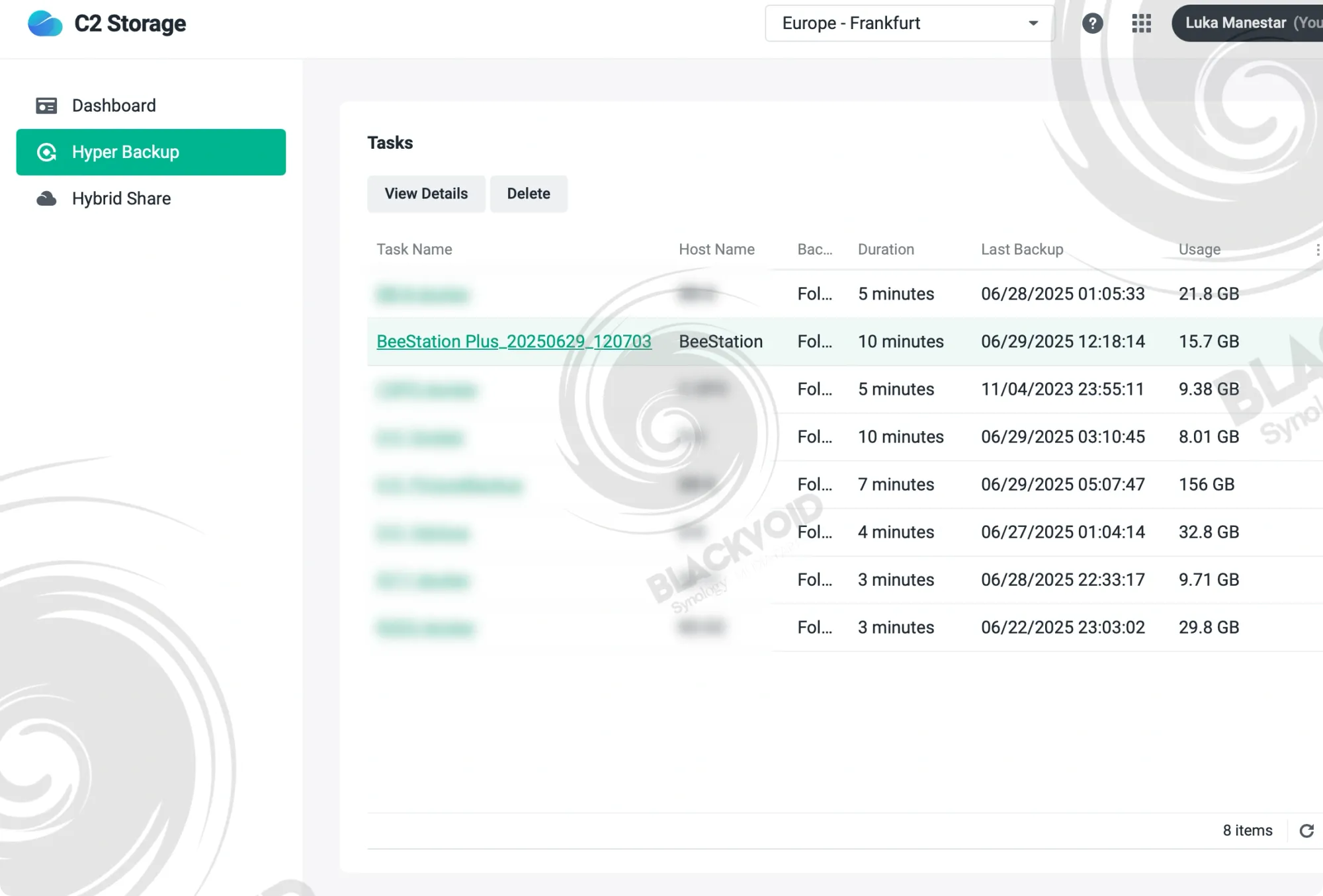
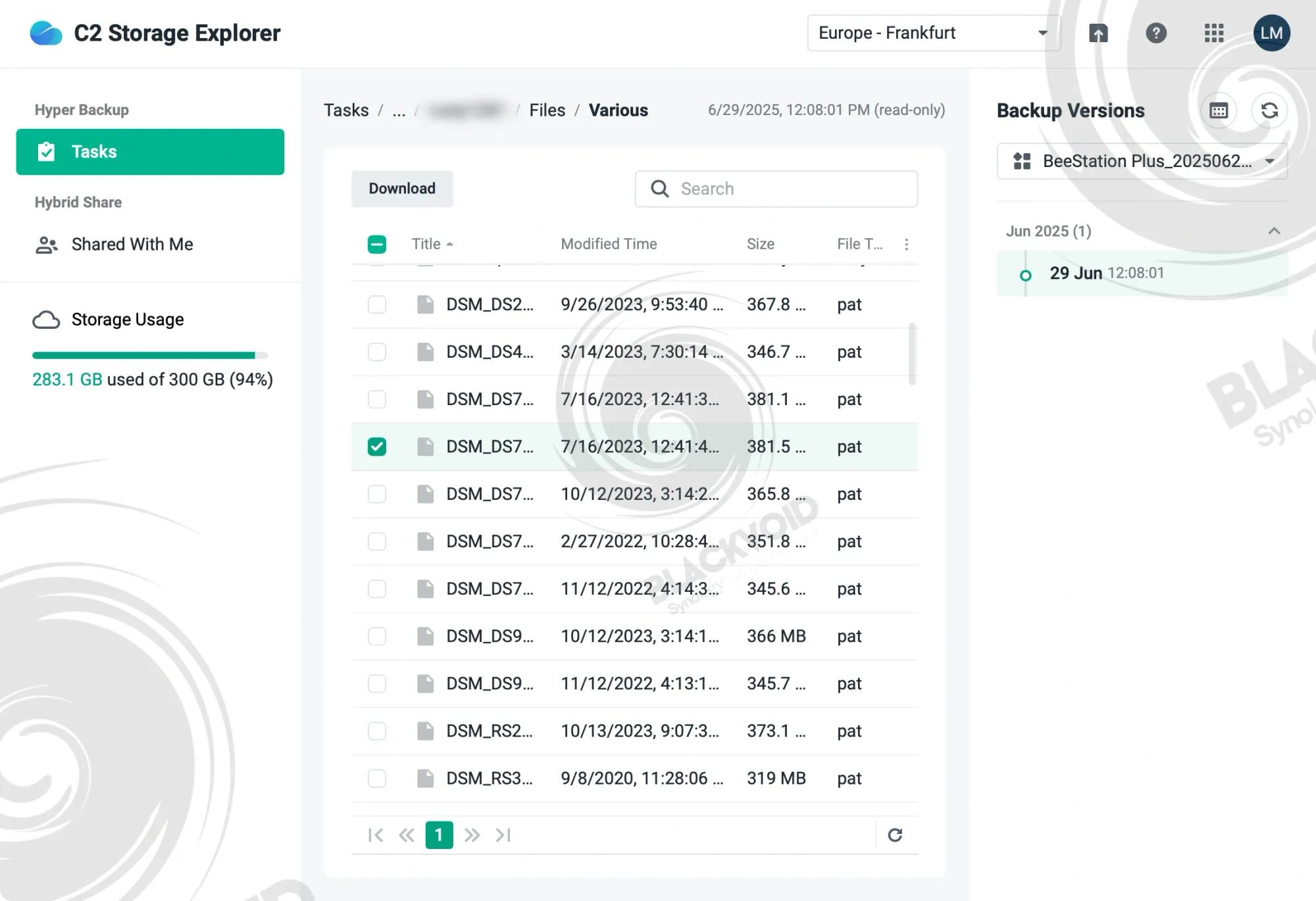
Comparing the C2 and Synology NAS restore methods reveals a different yet similar approach. While both utilize the same "software," the C2 platform has a slight edge in presentation and execution. The advantage lies in its simplicity; the restore process involves simply clicking on the job name and selecting the data to be downloaded. There is no need to install a desktop client to access the data; a valid C2 login suffices. Just like with the local NAS restore process, data cannot be restored to its original destination and is instead downloaded to the device accessing the C2 Storage Explorer page. Consequently, the imported data must be transferred again using appropriate Bee apps (details to follow) or via a simple SMB transfer.
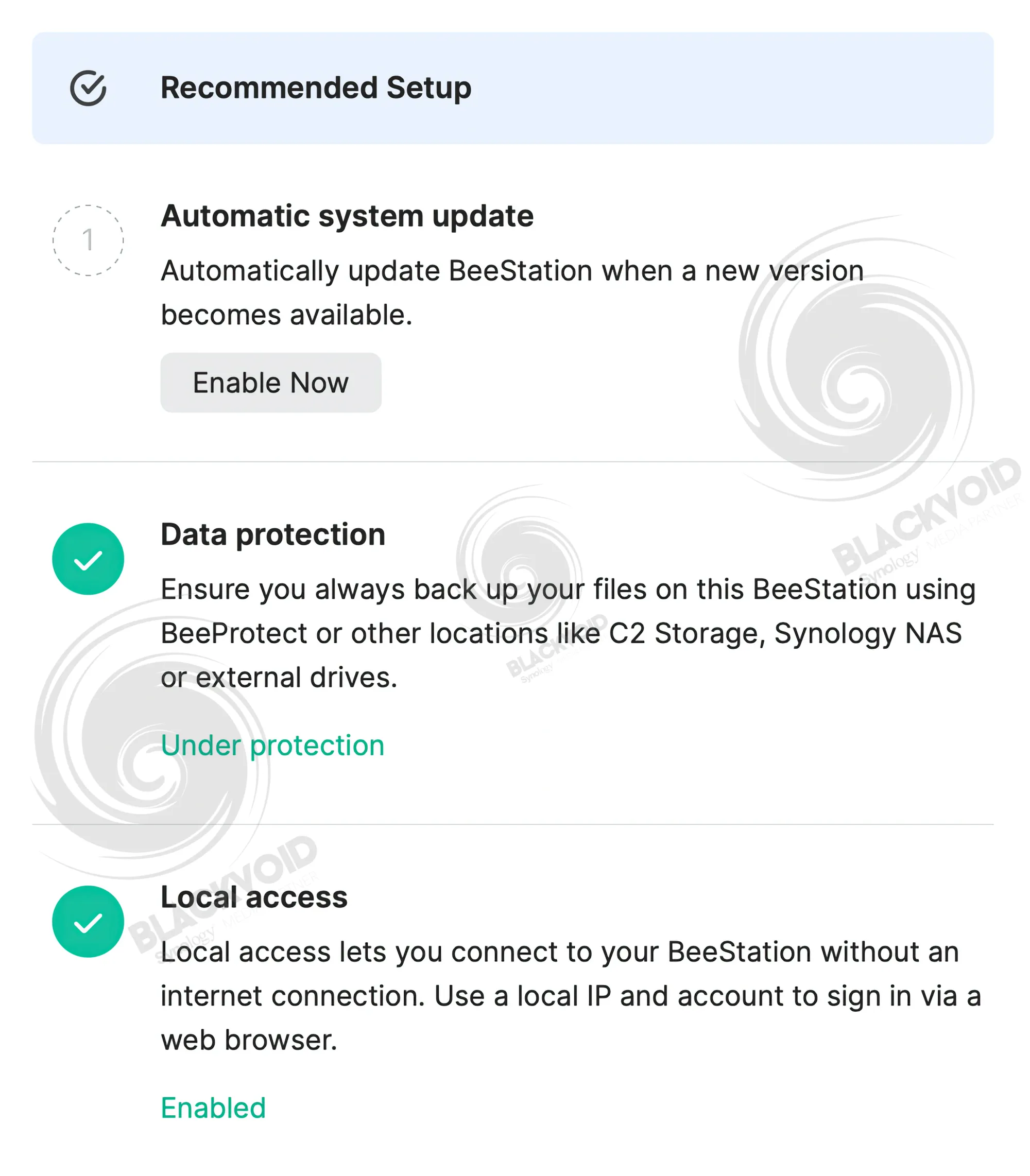
As evident, there are numerous options to backup the Beestation, and while data loss can occur for various reasons, restoring it should be just a few clicks away. Configuring a backup of the unit, as indicated by the top three tasks in the UI (mentioned at the beginning of the article), should indeed be prioritized, as we never know when disaster might strike.
: BSM, BeeFile, and BeePhotos
Now that we have covered the external elements, settings, configuration, and backup, it would be a good time to see just how well the Beestation handles data, followed by the new supported feature, PLEX.
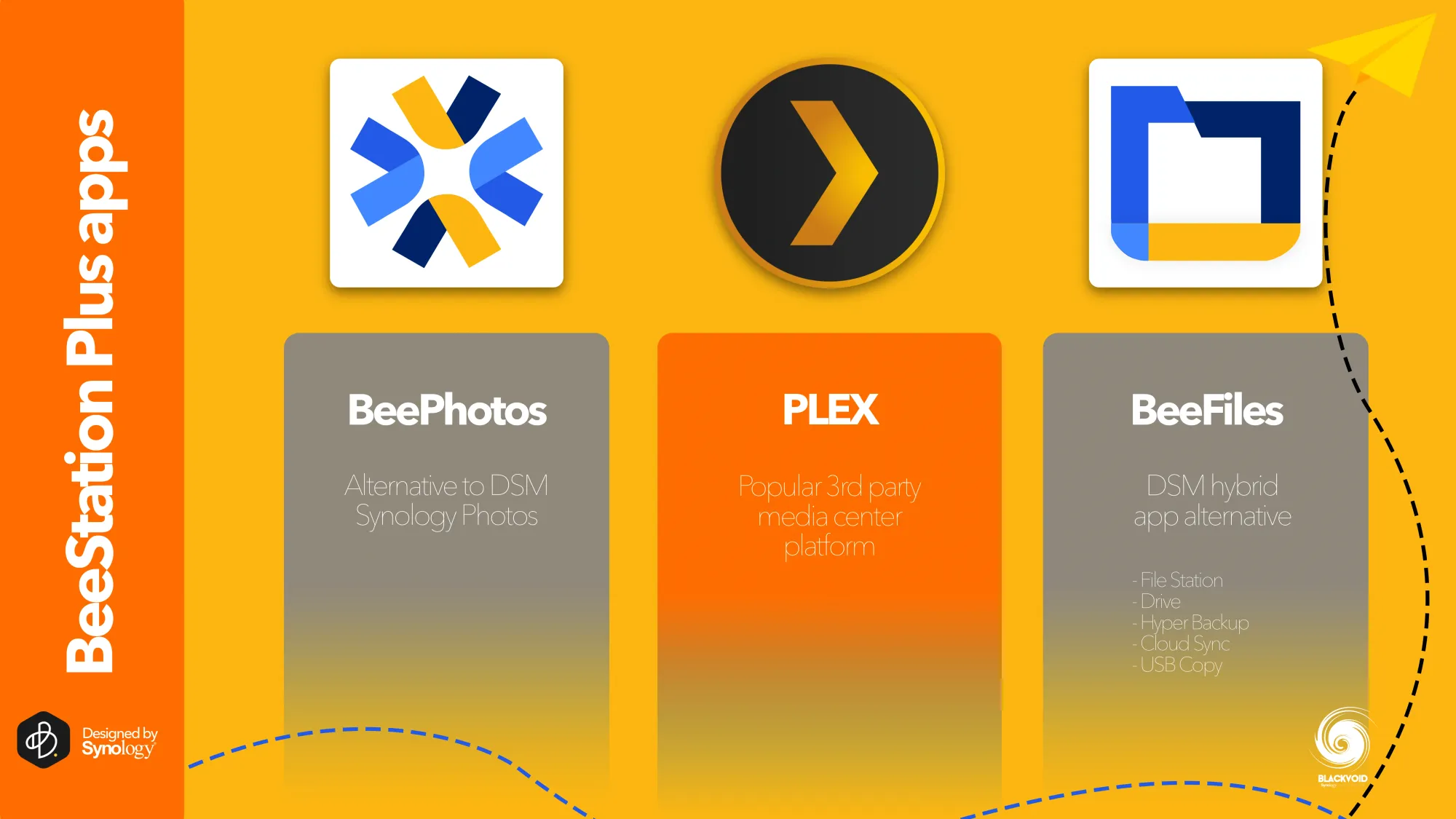
The software platform powering Beestation is encapsulated by a singular operating system called BSM. This OS comes bundled with all necessary features and "apps," distinct from the DSM system that powers their NAS lineup. In the current version 1.3 of BSM, there are still two major applications along with their mobile counterparts. These are BeeFiles and BeePhotos, which serve as comprehensive, all-in-one platforms supporting various functions. They essentially incorporate the well-known features from the versatile DSM into this simplified yet powerful BSM environment.
On top of that, for the first time, BSM now supports "integrations". Unlike DSM's Package Center with over 50 apps, here we have the first officially supported integration, the PLEX media server platform.
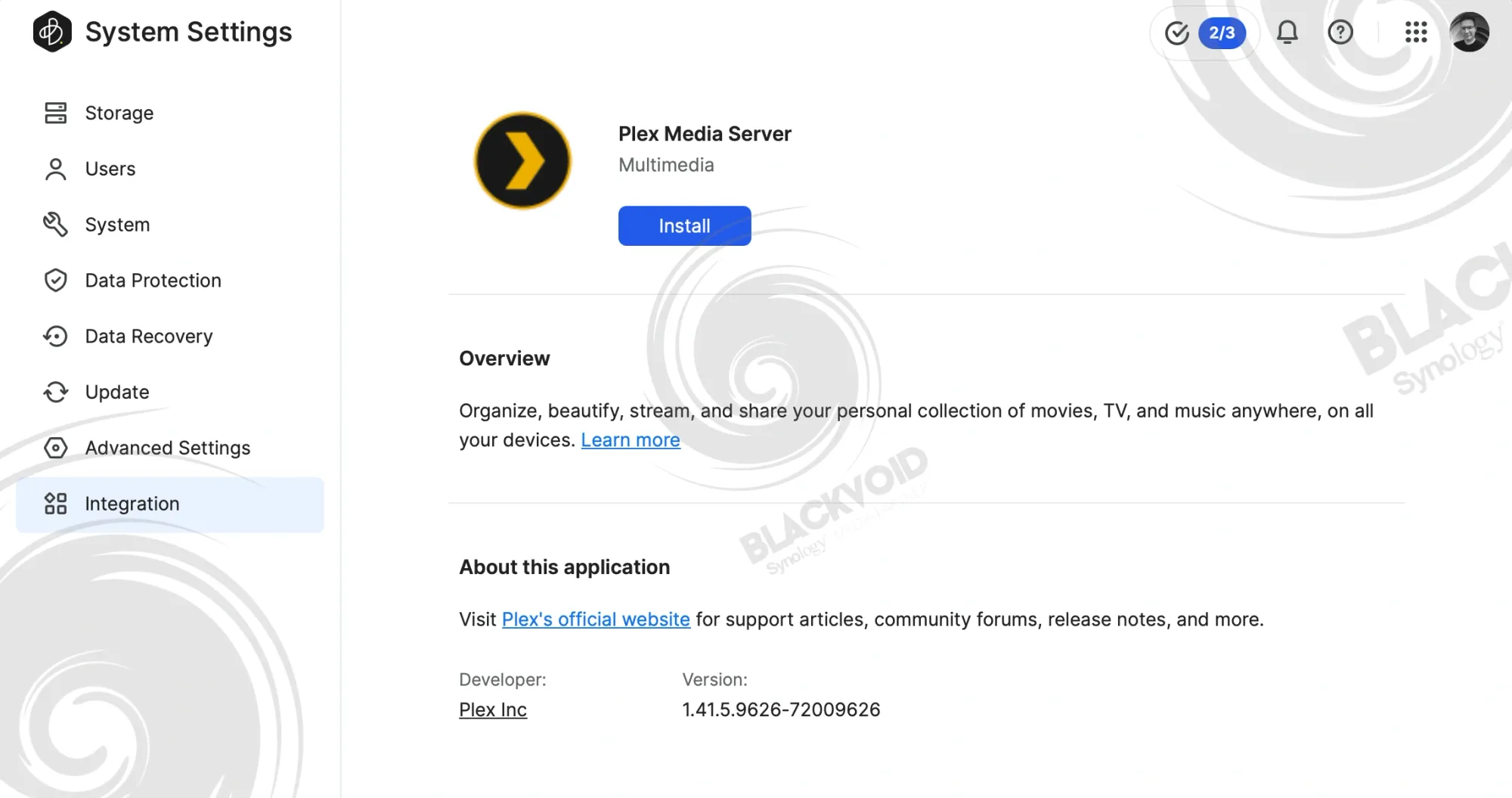
While we'll delve into this specific feature later, it's important to note that Plex is an optional integration and is not installed by default. The installation process is streamlined and can be completed with a single click, reinforcing that BSM is designed to provide a straightforward user experience for everyone.
:: BeeFiles - a versatile all-in-one file manager
It's reasonable to begin with the more complex of the two applications, BeeFiles, as it offers extensive features and is likely to be utilized in a wider range of scenarios than BeePhotos. Naturally, this will vary depending on the individual user, but generally speaking, BeeFiles provides a broader scope of use.
Available as both a web and desktop application, BeeFiles offers several key functionalities. Beyond file and folder management, it includes synchronization features, backup to external devices, USB backups, and connectivity with third-party public cloud platforms like OneDrive, Google Drive, and Dropbox.
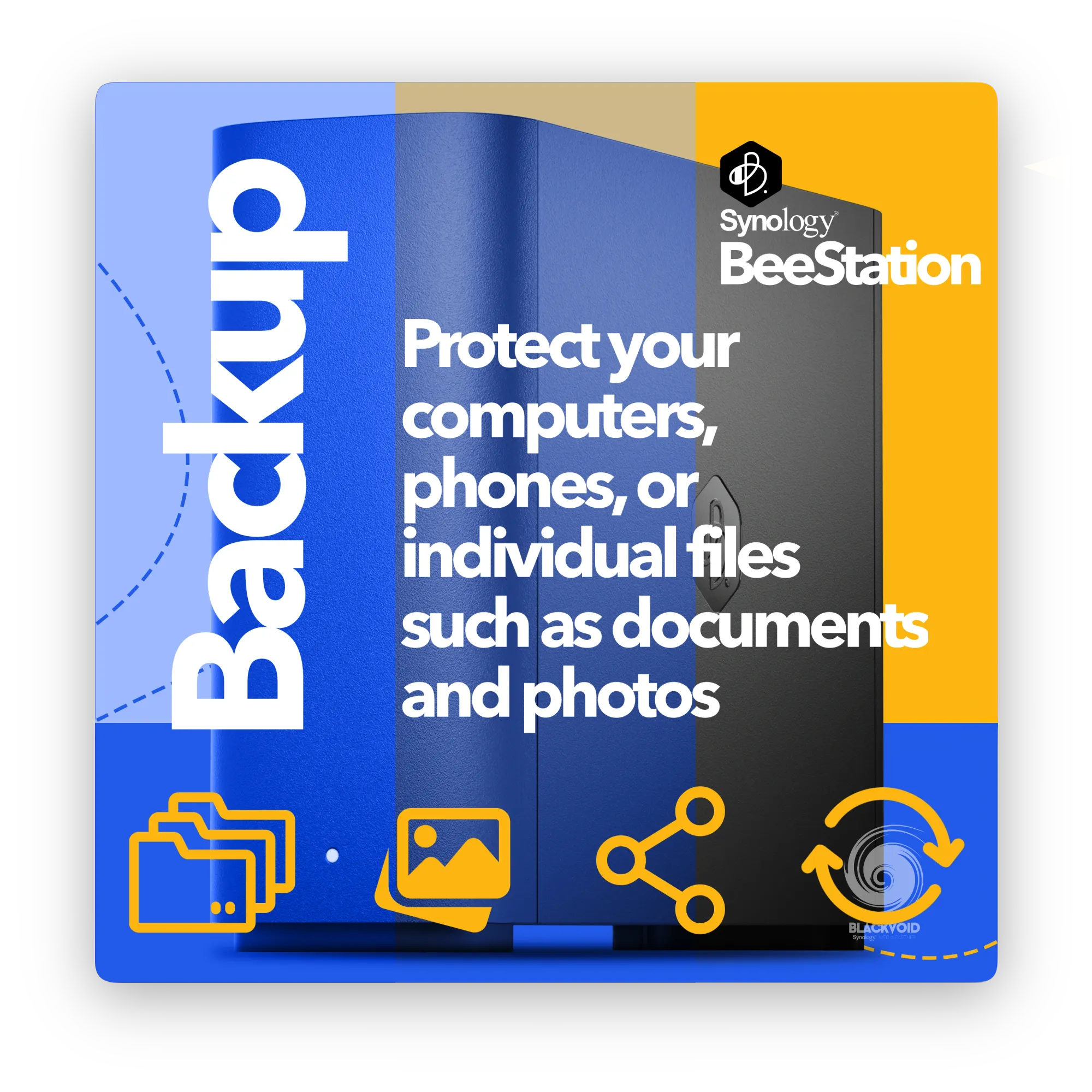
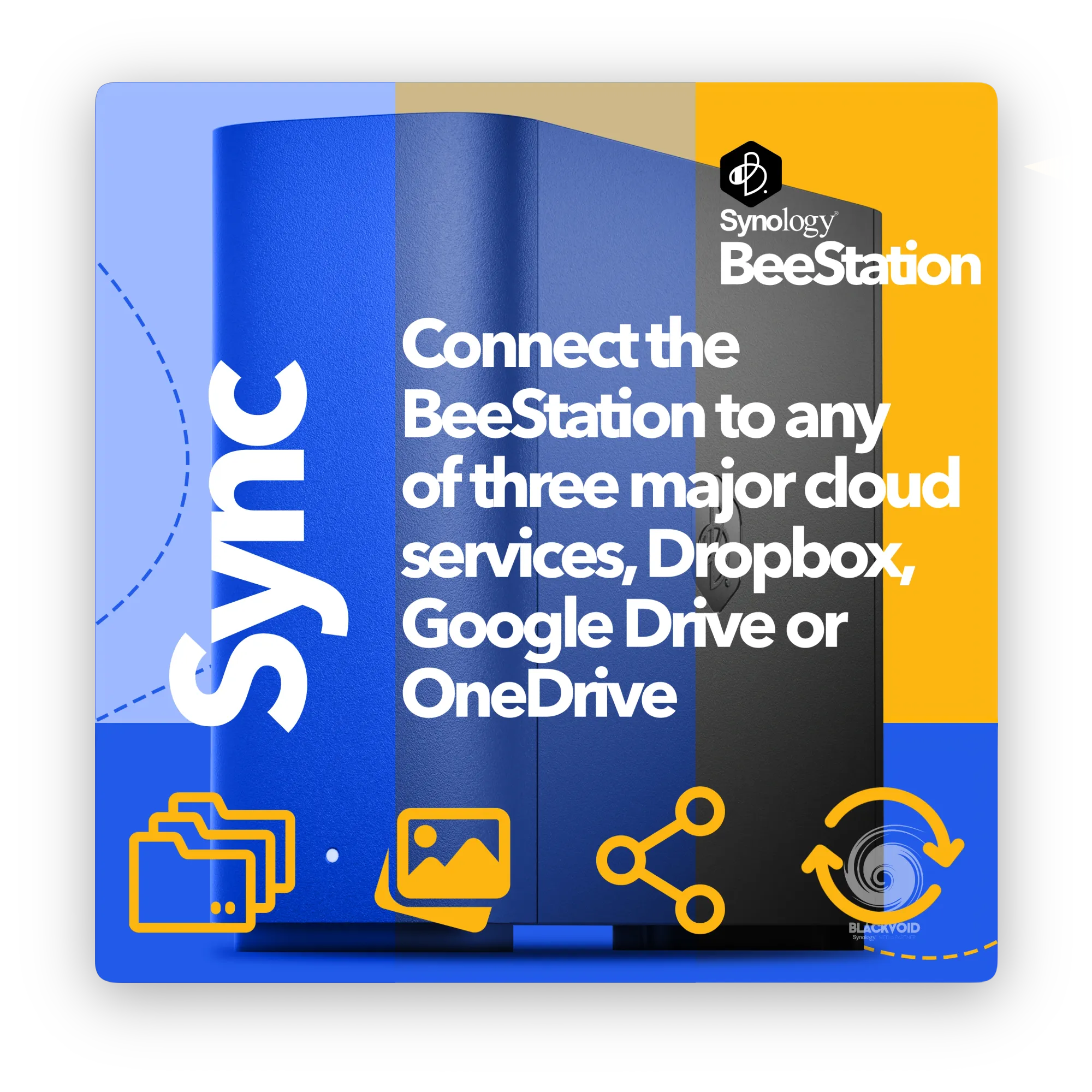

A significant advantage of the Beestation experience, accessible through BeeFiles, is the ability to quickly share files not only with local users but also with remote guests.
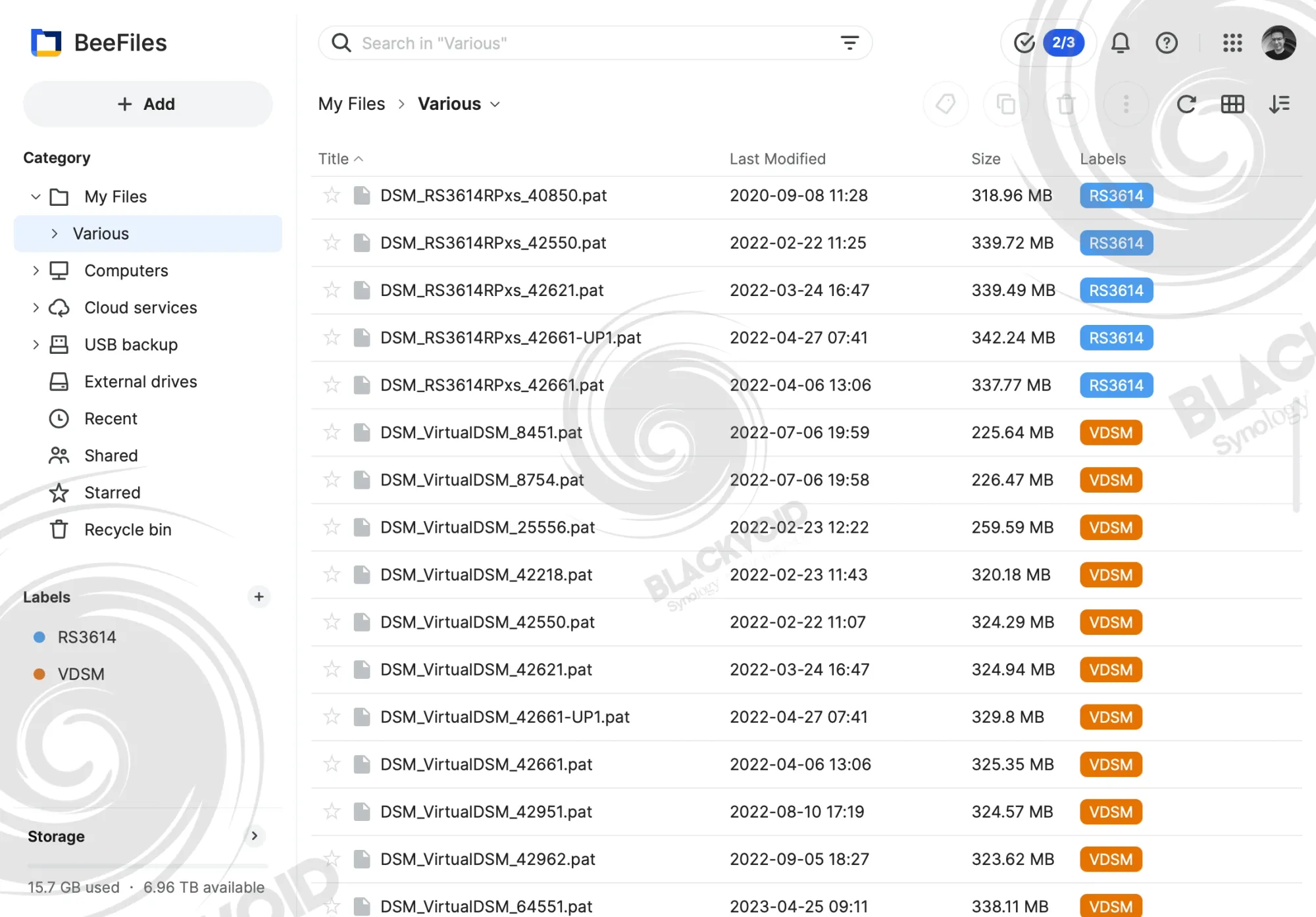
The main interface of BeeFiles is user-friendly, with primary functions and sections located along the top and left columns. The center displays content in two view formats: lists and thumbnails. Users can upload content using the "+Add" button or through a simple drag-and-drop method, consistent with modern web-based platforms. BeeFiles supports basic copy, paste, and move operations, as well as labels and "favorites" options to help users quickly identify and search through large amounts of similar data.
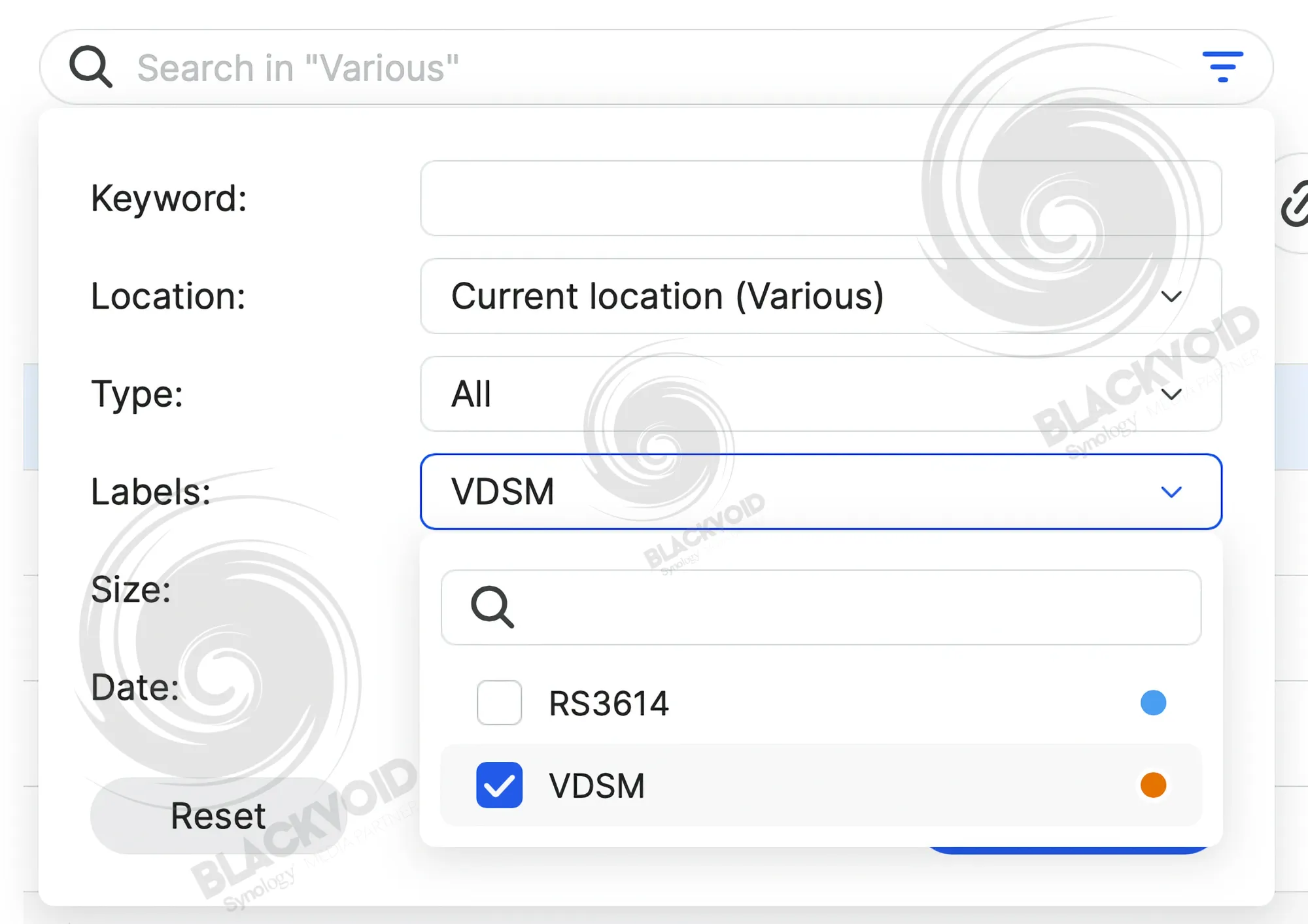
Regarding search functionality, the simple search field can be expanded with multiple options that help users quickly locate specific content. These options include searching by label, date, size, or file type.
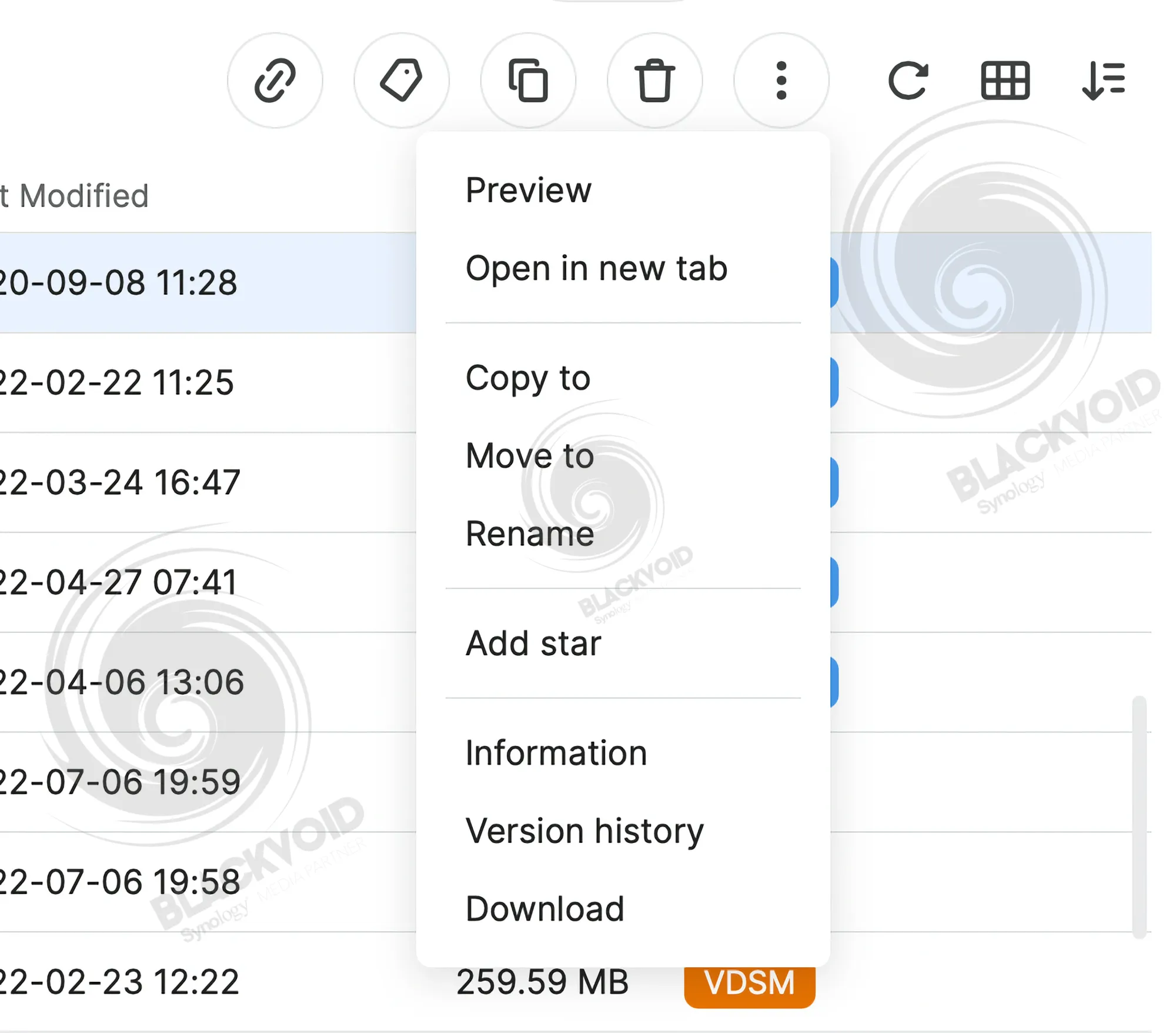
The clean and fast interface, distinct to BSM and not merely a replication of the popular DSM, presents all functionalities through a top action button bar that expands into a drop-down menu. These actions can also be accessed with a simple right-click on a single or multiple selected files. It provides basic functions such as the previously mentioned copy, move, and labels, as well as version history, preview, and download options.
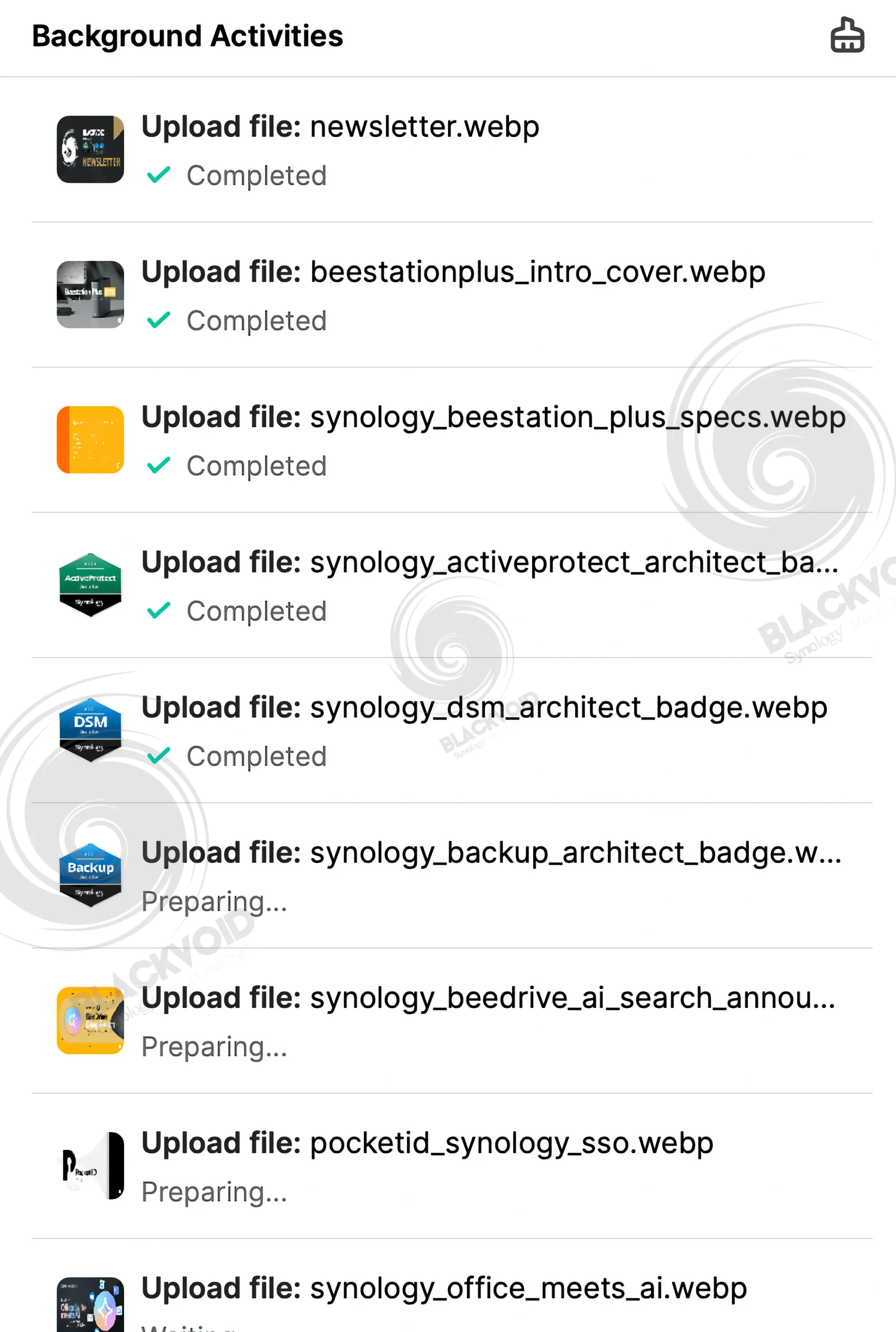
BeeFiles supports all popular file formats for viewing directly in a web browser, including MOV, WEBP, HEIC, and HEVC-coded files. The web viewer also offers simple features like 90-degree rotation, as well as options to share, print, and download files. Although BeeFiles doesn't support slideshow viewing, users can navigate through files using the arrow keys on a keyboard or by tapping/swiping on a tablet or mobile phone.
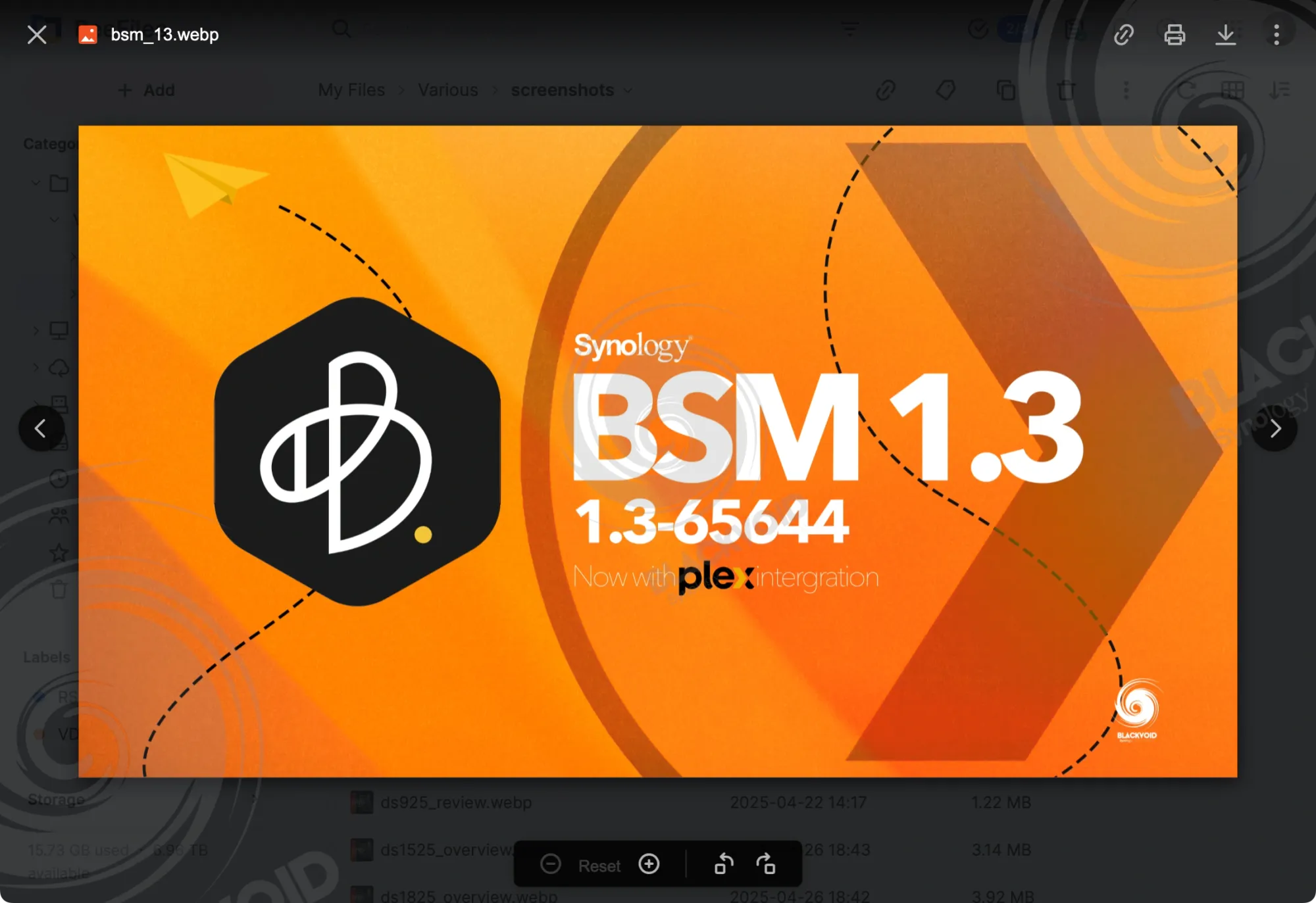
:: Sync functionality
While most users will primarily use Beestation as a file manager for copying and storing data, others may utilize it for automated backup and sync tasks. As Beestation is promoted as a device for backup, sync, and sharing, it makes sense that BSM could be a commercial cloud alternative for the likes of Google Drive, OneDrive, or Dropbox.
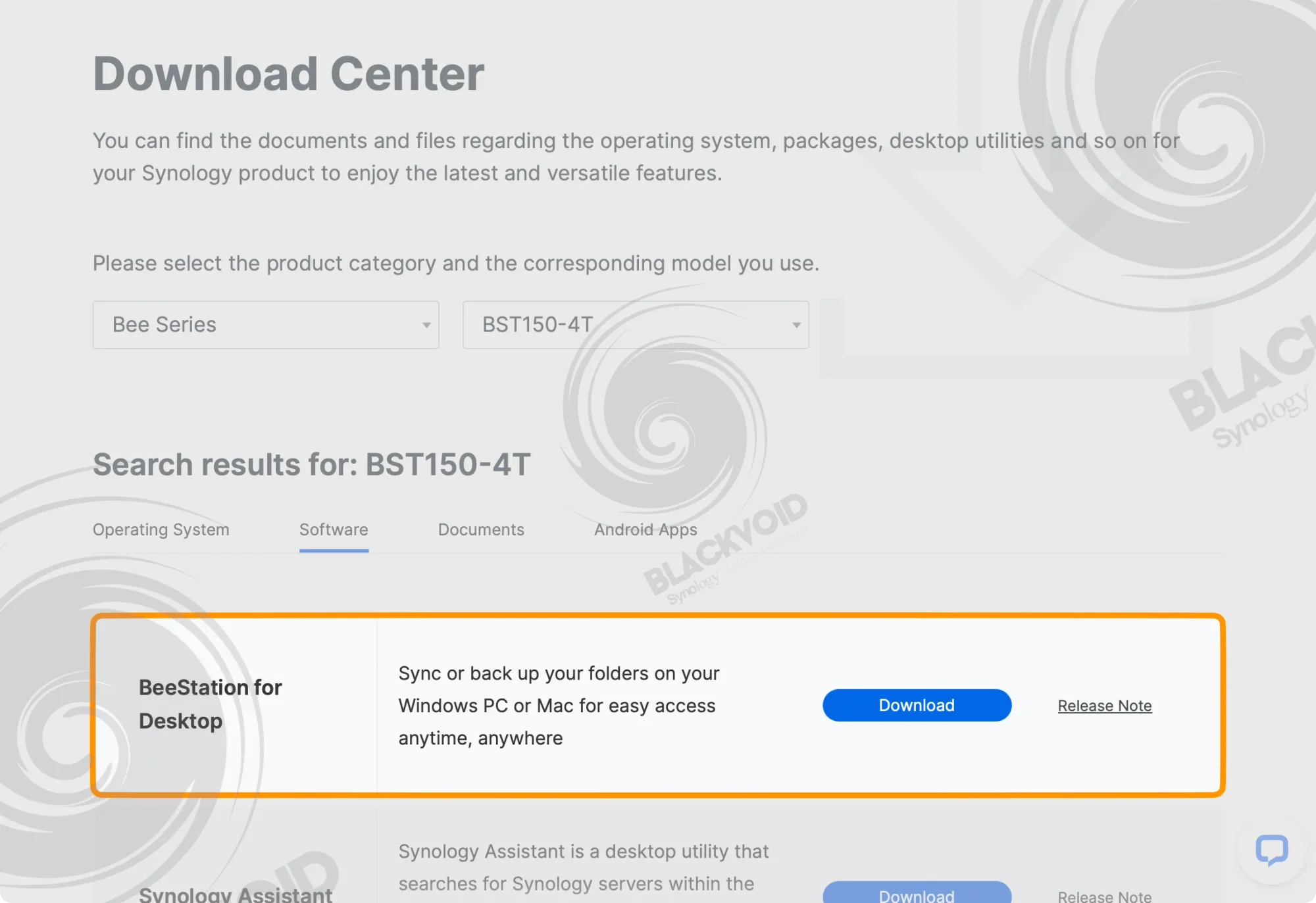
As mentioned earlier, both sync and backup features are available through the desktop app, while cloud services can be configured using the web interface. The client app can be downloaded from the Synology Download Center and installed, followed by a quick sign-in, users are given the option to connect to any accessible Beestation linked to the registered Synology Account.
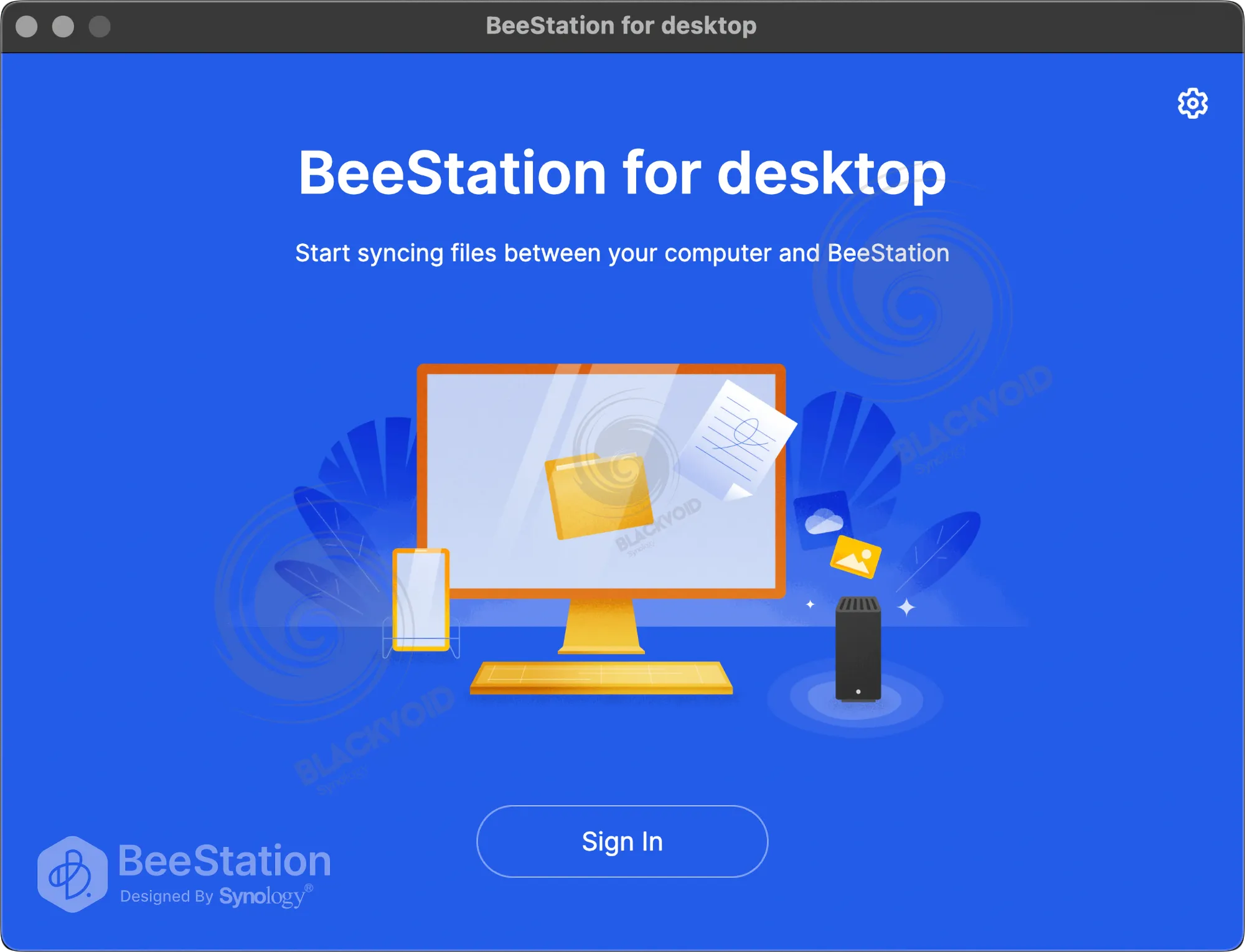
The wizard guiding the initial connection is straightforward. Aside from selecting a different local destination for storing synced data, the rest of the settings are self-explanatory.
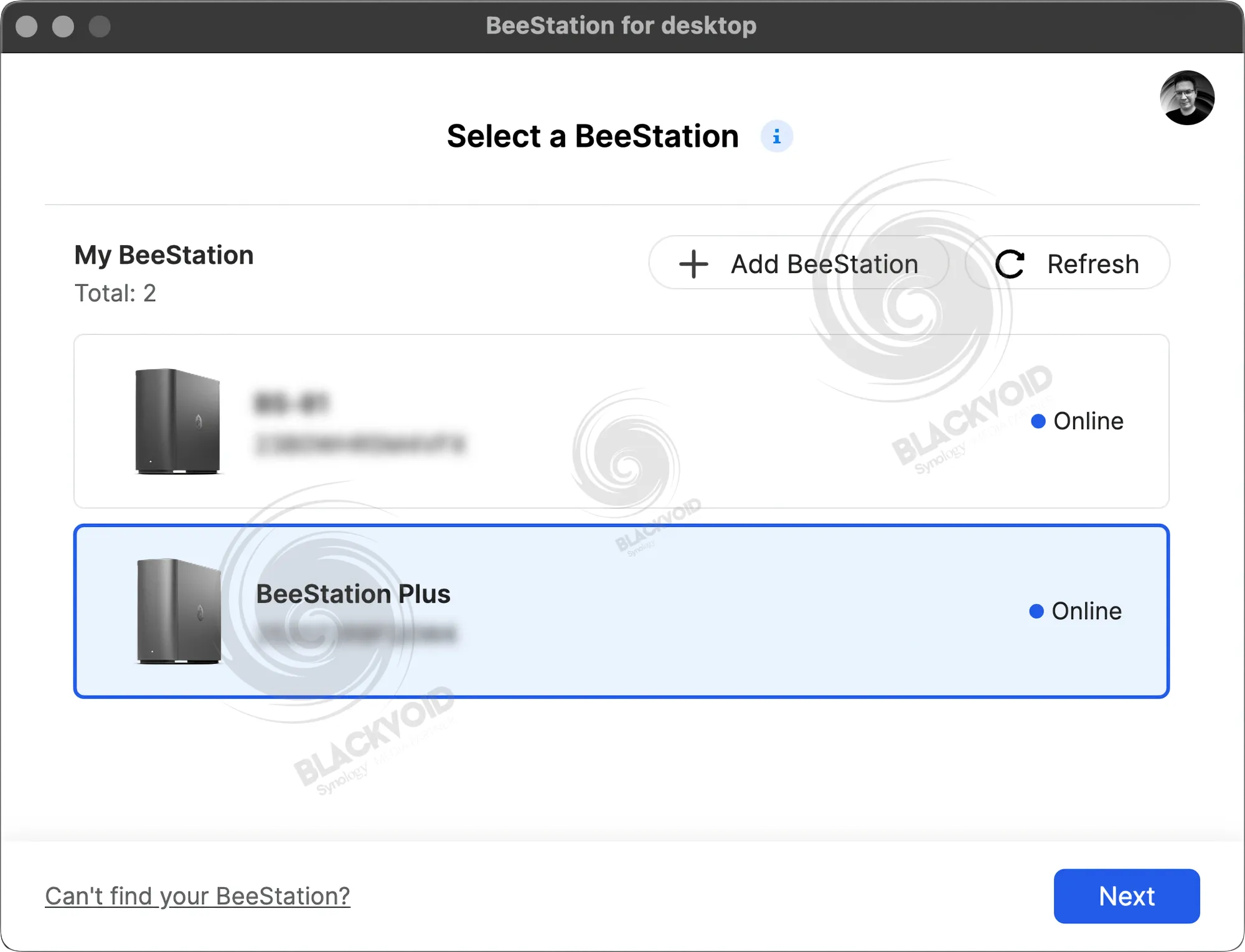
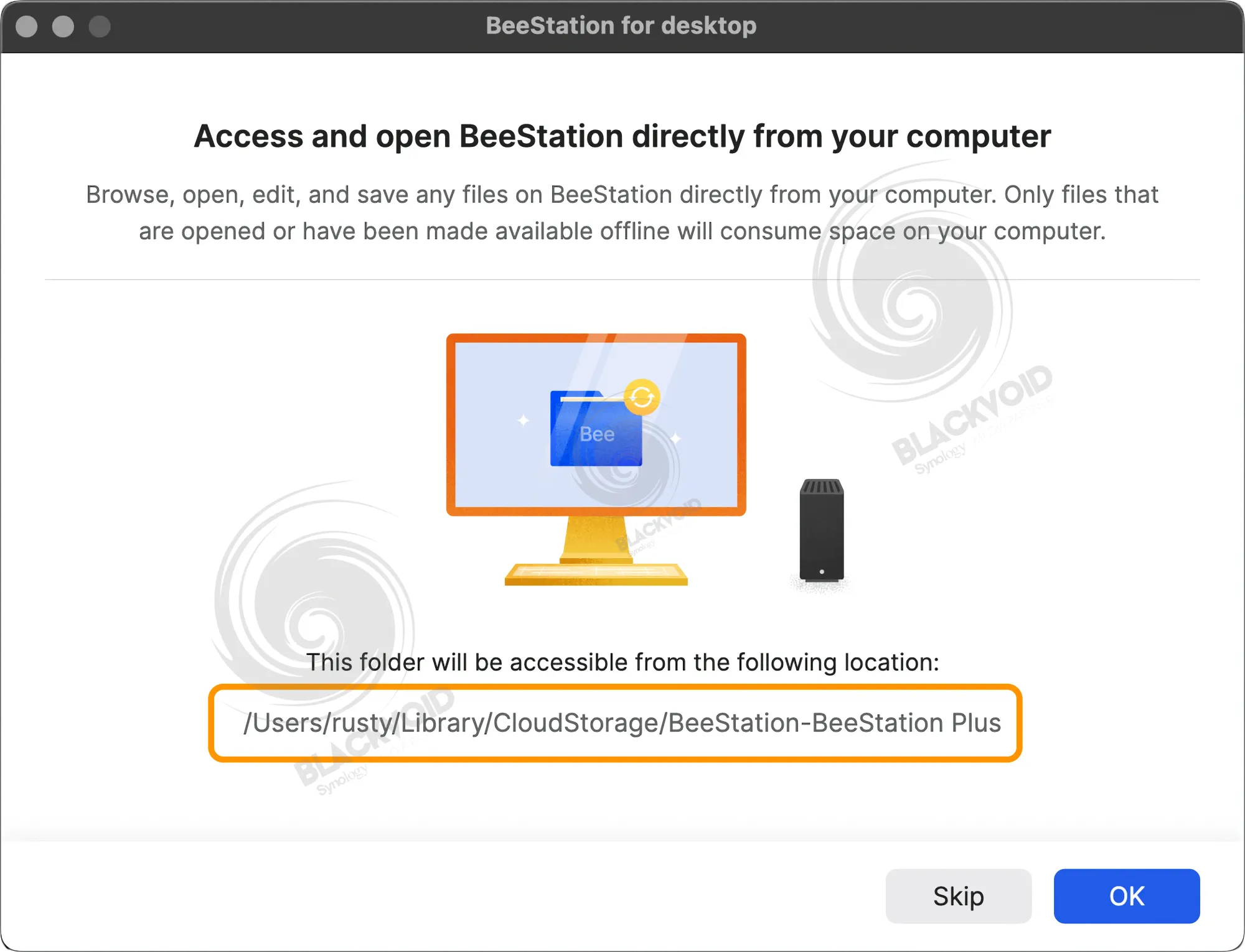
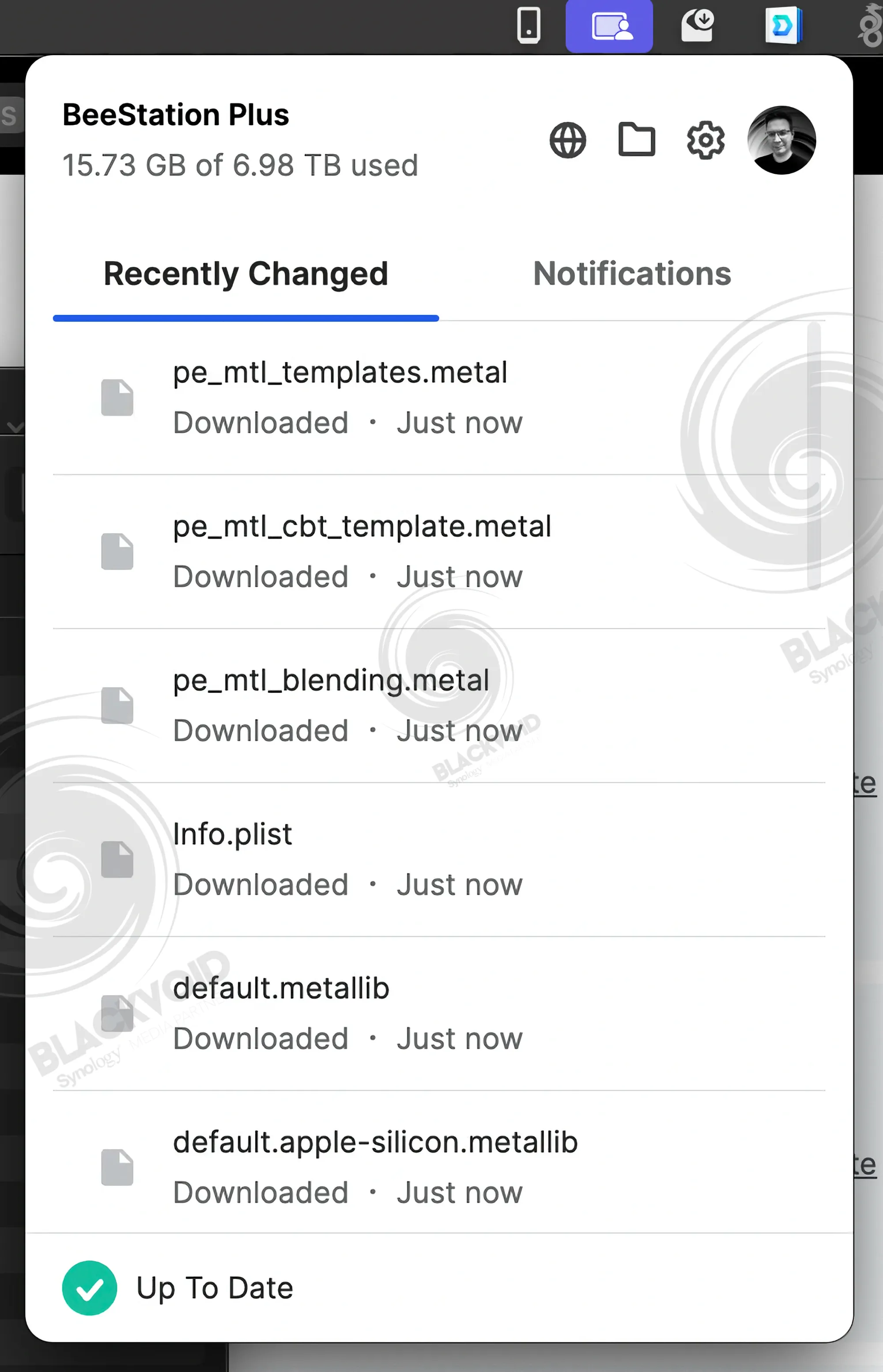
Similar to the Synology Drive server on the DSM OS, the Beestation for Desktop app uses "streaming" data by default. This means that upon connecting to the Station, the client does not download the entire content to the desktop machine. Instead, it displays a list of all content, indicating that the files are still "in the cloud." On macOS Finder, this is marked by a small cloud icon next to the file name. A local copy will not occupy space on the computer until the content is accessed or pinned.
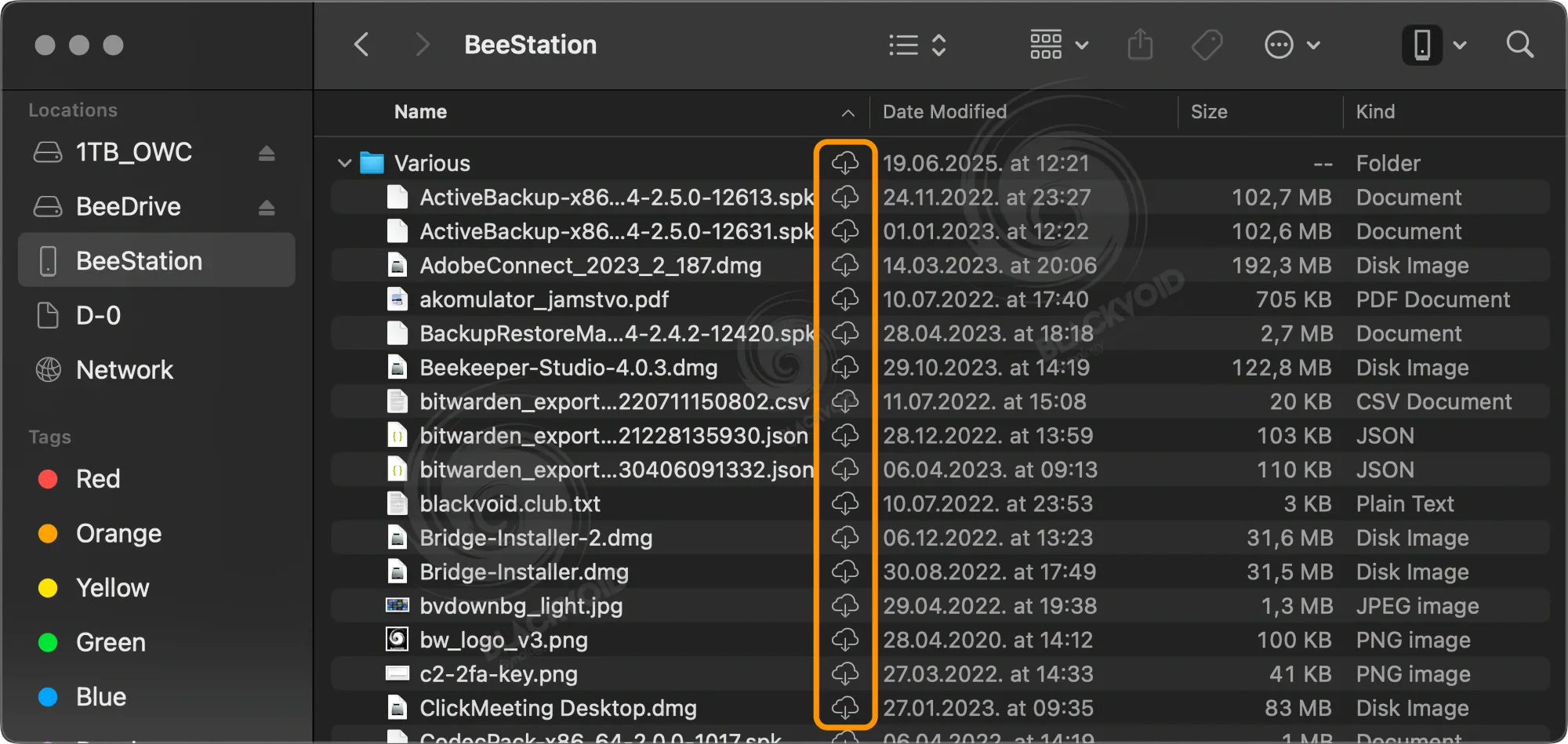
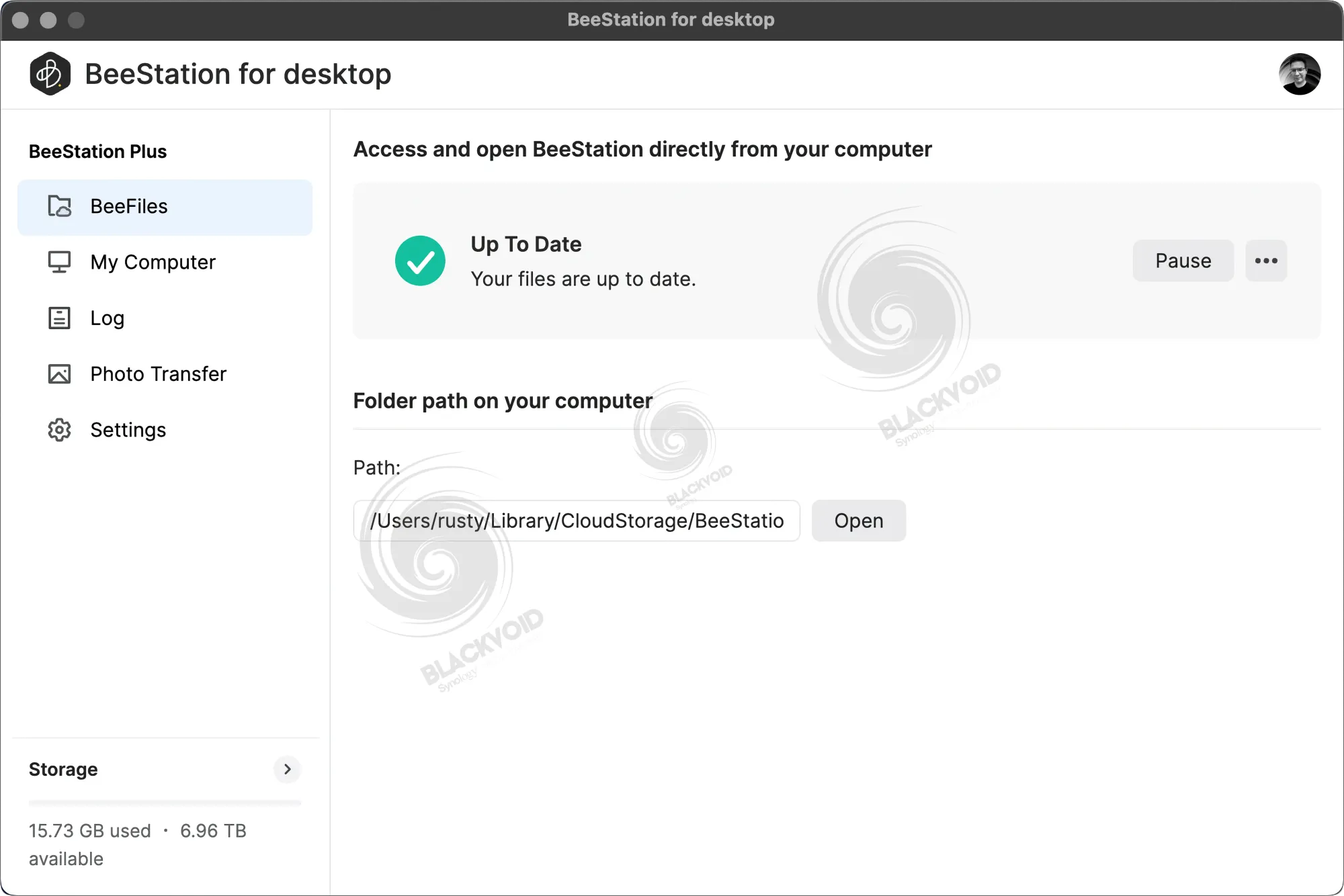
The process is easy, fast, and straightforward, providing a local sync engine that maintains bi-directional synchronization with the Beestation, occupying space only with requested files. For users focused on syncing or backing up local computer content with the NAS, it's also possible to configure the Beestation for the desktop to accommodate these needs.
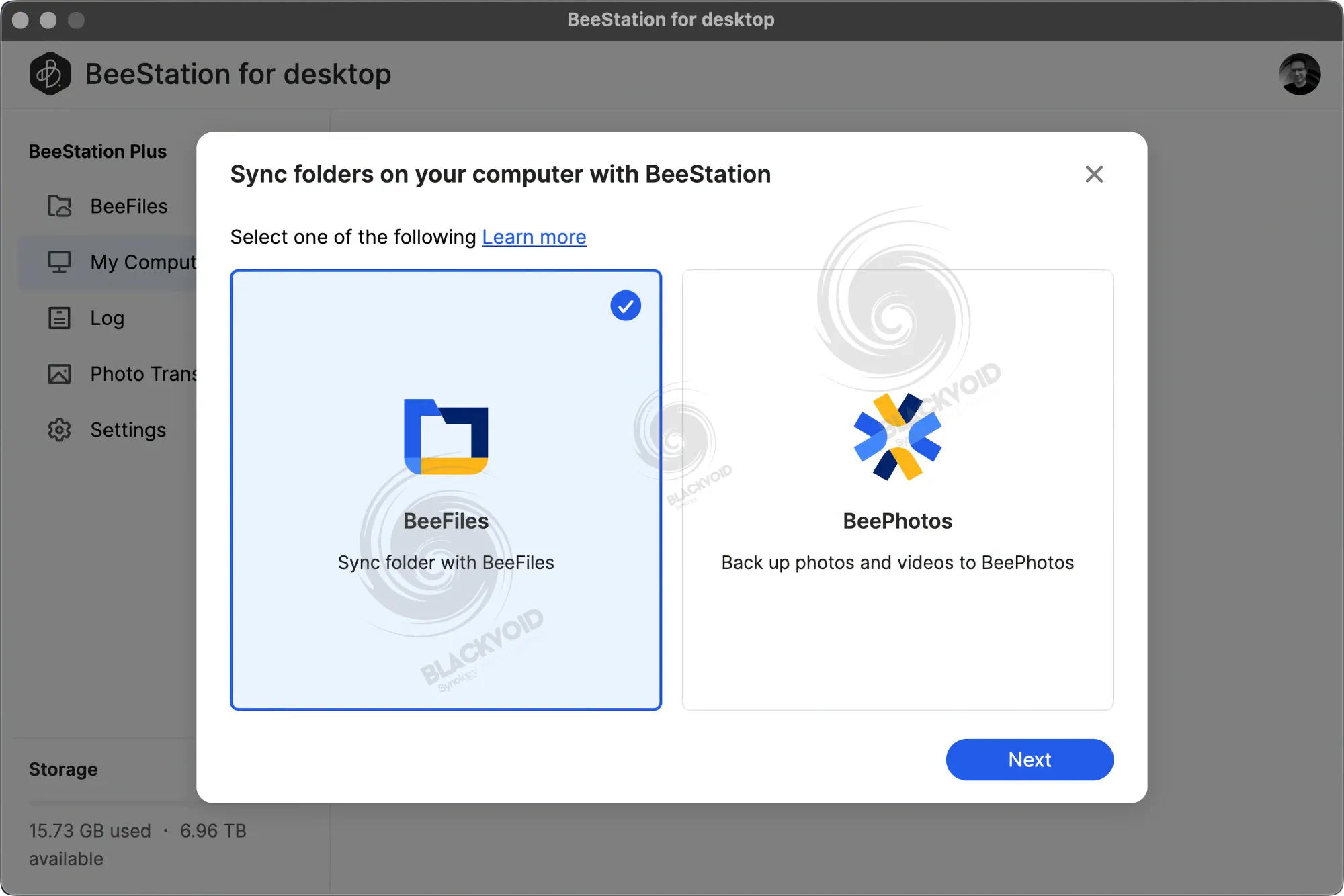
It's noteworthy that this functionality supports either bi-directional or one-directional sync. The bi-directional option is known as the "sync" function, while the one-directional is referred to as the "backup." The reason for this distinction is that the backup task does not provide the option to schedule the actual task; it immediately syncs new content from the computer to the Beestation.
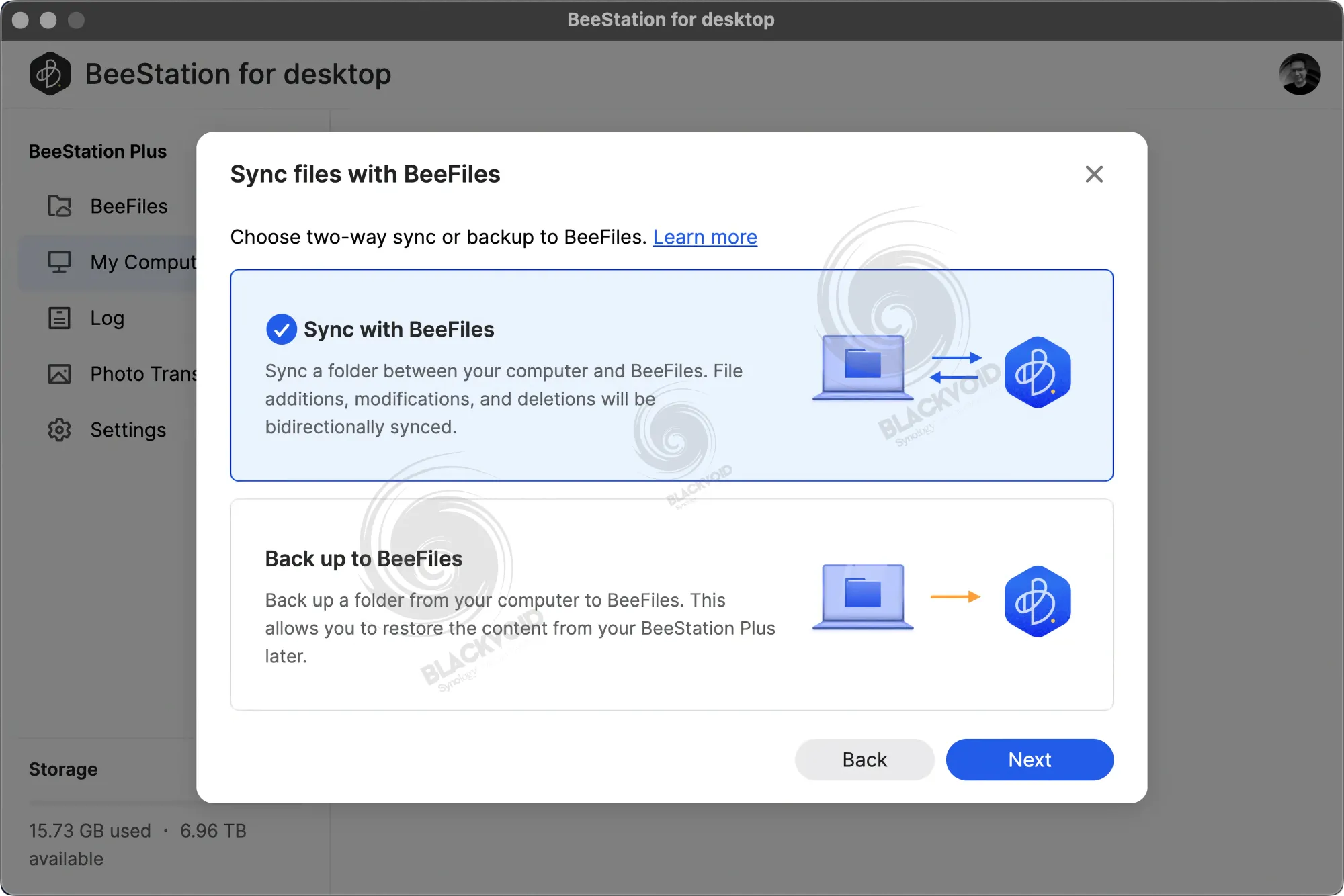
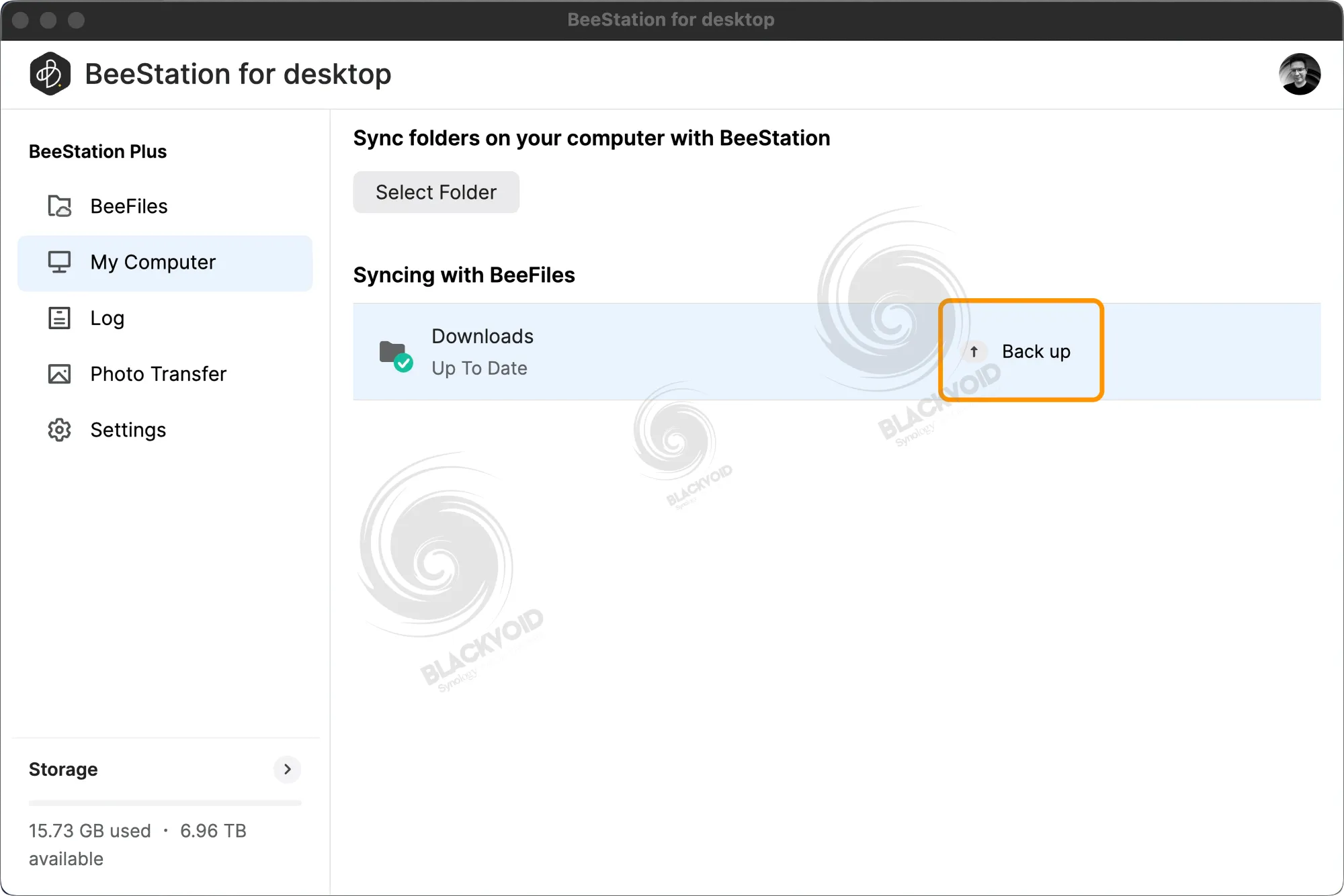
Data being backed up can be viewed both through the desktop app and the web interface. This approach allows for the creation of multiple backup or sync tasks, depending on how organized or separate you want the data to be.
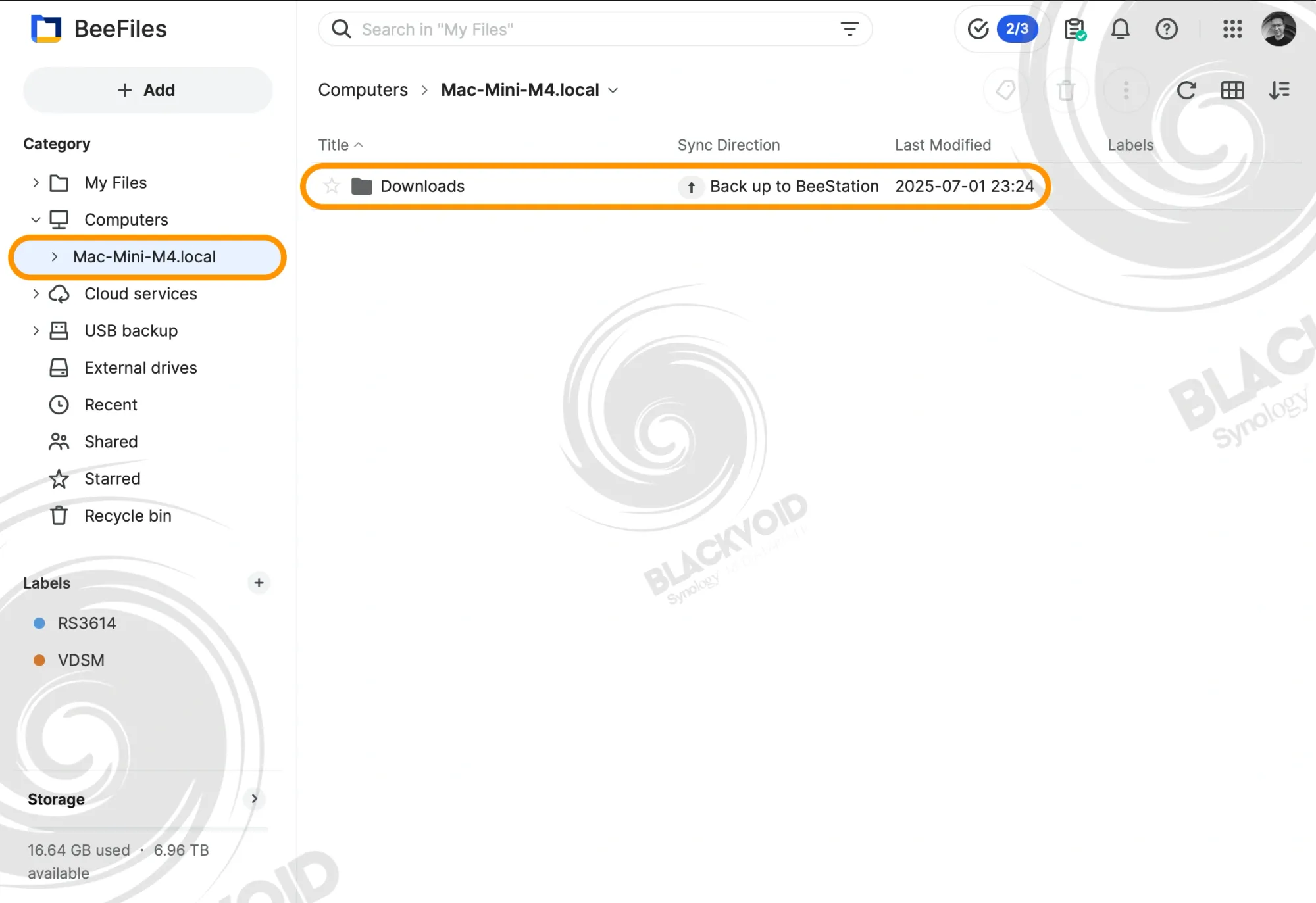
What if we have multiple Beestations—one with a larger capacity and another for different purposes, such as personal backups and business needs? Fortunately, the desktop app supports switching between Beestations. In this scenario, any configured job remains tied to its respective Beestation, allowing new jobs to be configured via the desktop app once it connects to the new device.
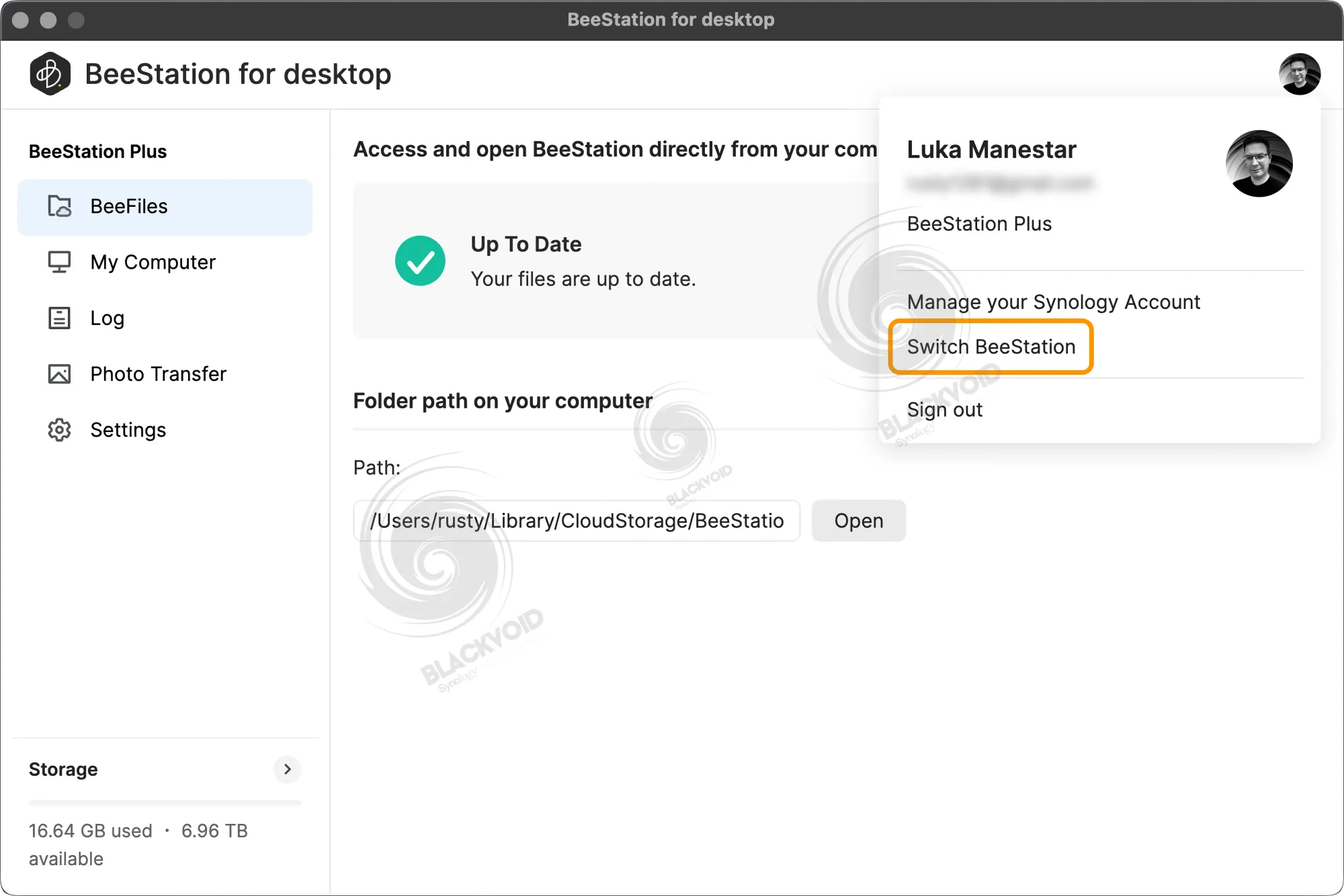
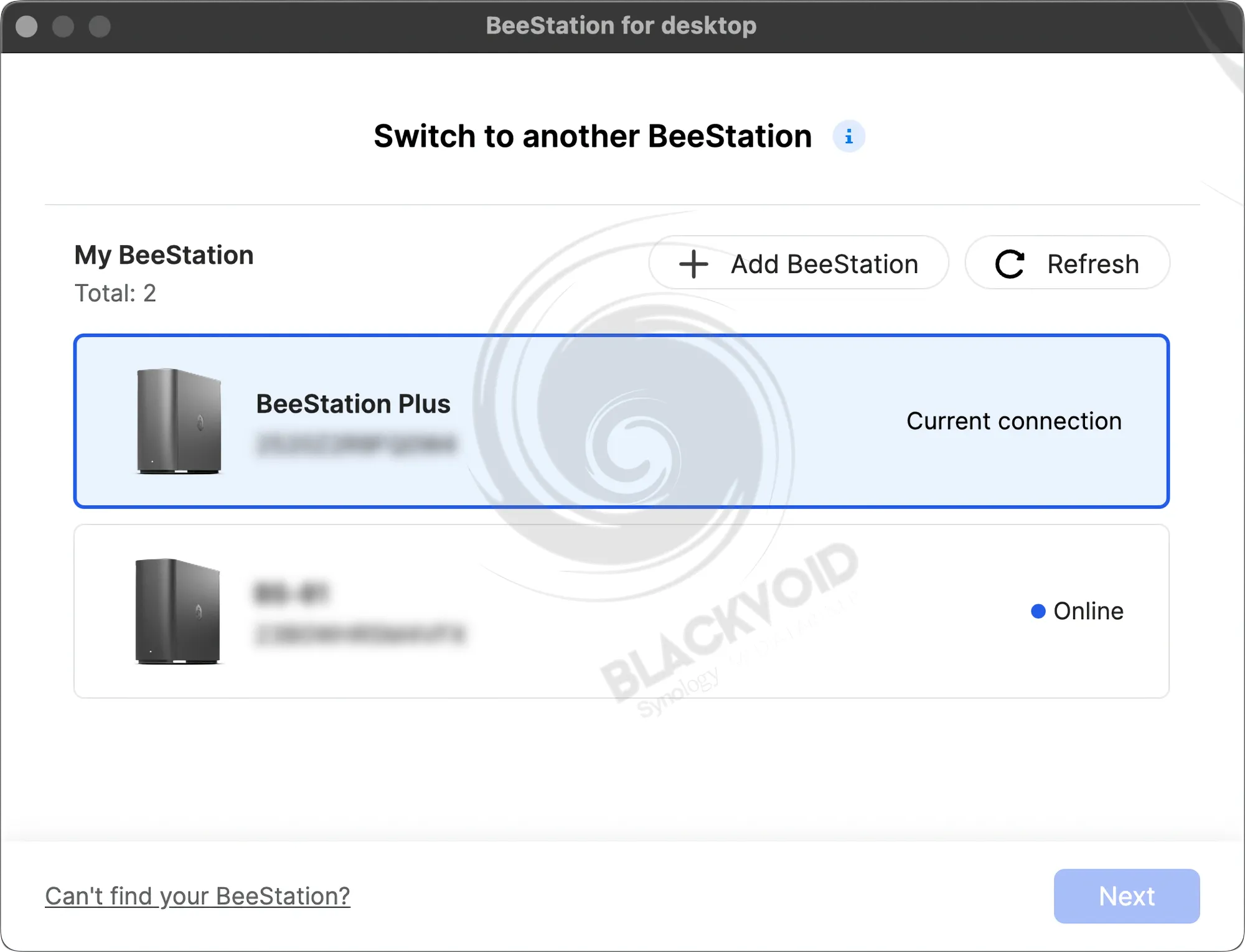

This way, we can easily switch from one device to another, clearly maintaining all configured tasks for a specific Beestation, ensuring there is no possibility of mix-up. It may seem that this task could be confusing or complex, but it's quite the opposite. Like the rest of BSM, swapping Beestations is as straightforward as any other configuration step we've encountered so far.
:: Cloud services
The same straightforward process can be applied when connecting the Beestation to any of the three major cloud services: Dropbox, Google Drive, or OneDrive. Over time, BSM has introduced additional team and business options from these providers, increasing the total number to six.
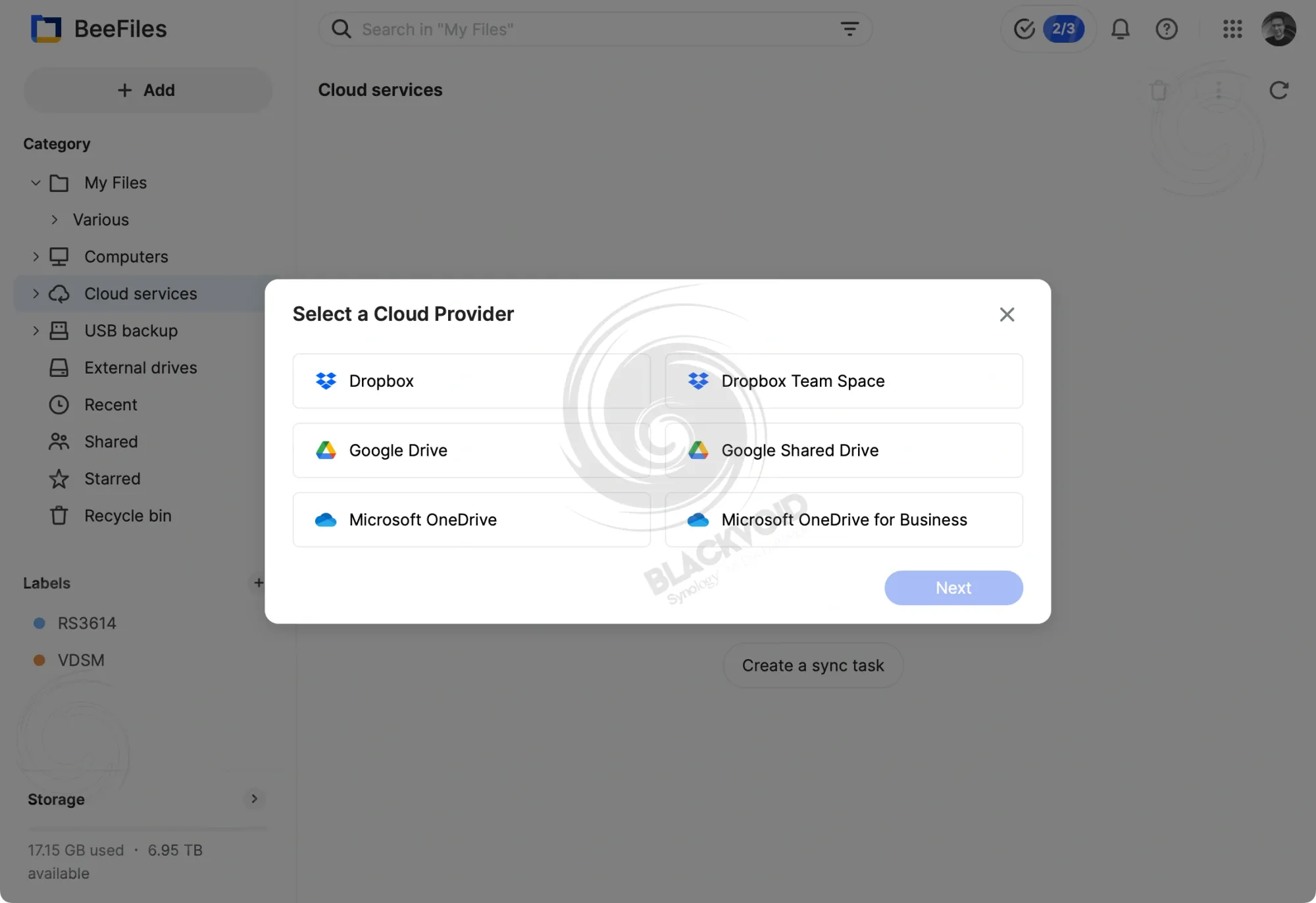
Each provider utilizes the same method for connecting with the BSM. This involves authenticating with the provider, selecting the sync direction, and choosing the designated local folder where the content will be saved. By default, the sync direction is set to two-way, but there is also an option to select a one-way sync from the cloud to Beestation.
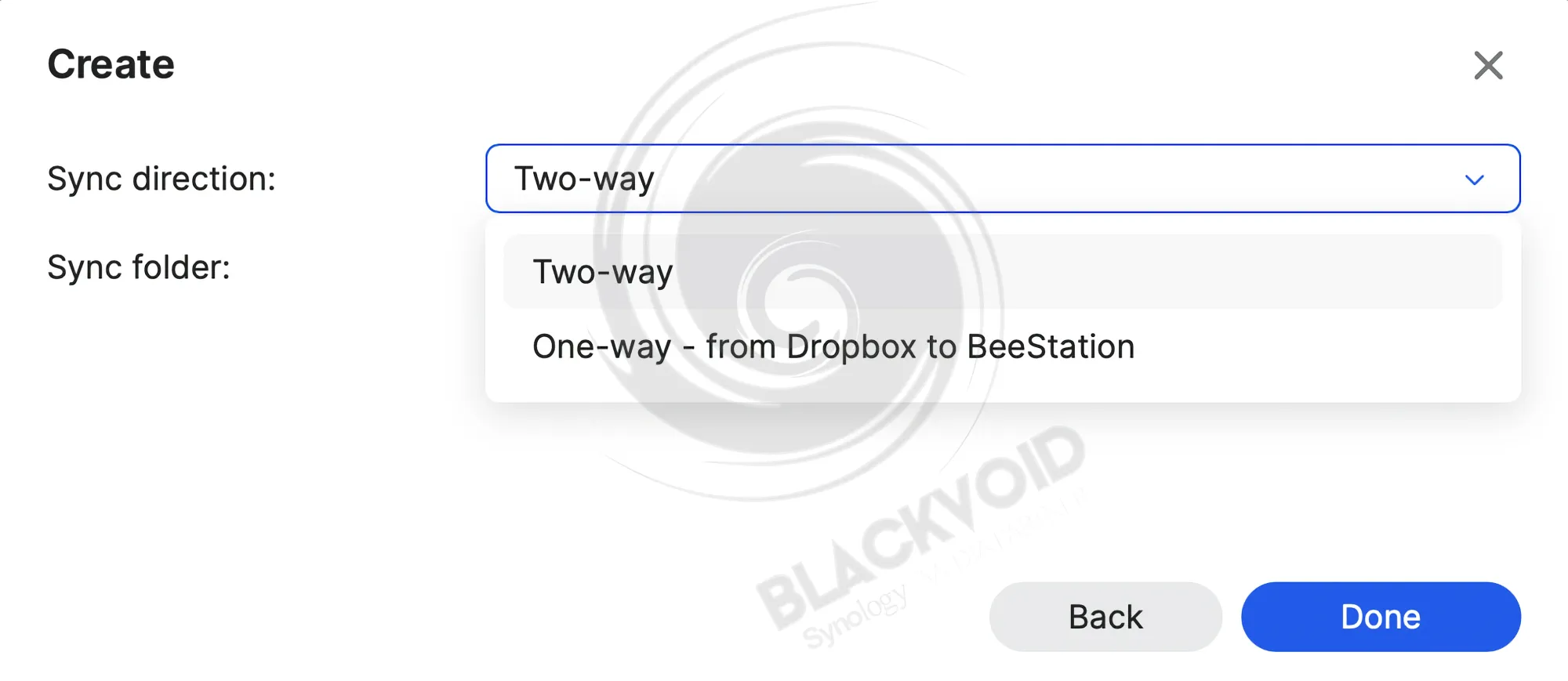
Multiple connections with the same provider can be initiated; however, each must terminate in a unique local folder. The progress of the sync process will be documented in the log file. Additionally, we have the option to pause and resume the sync as needed.

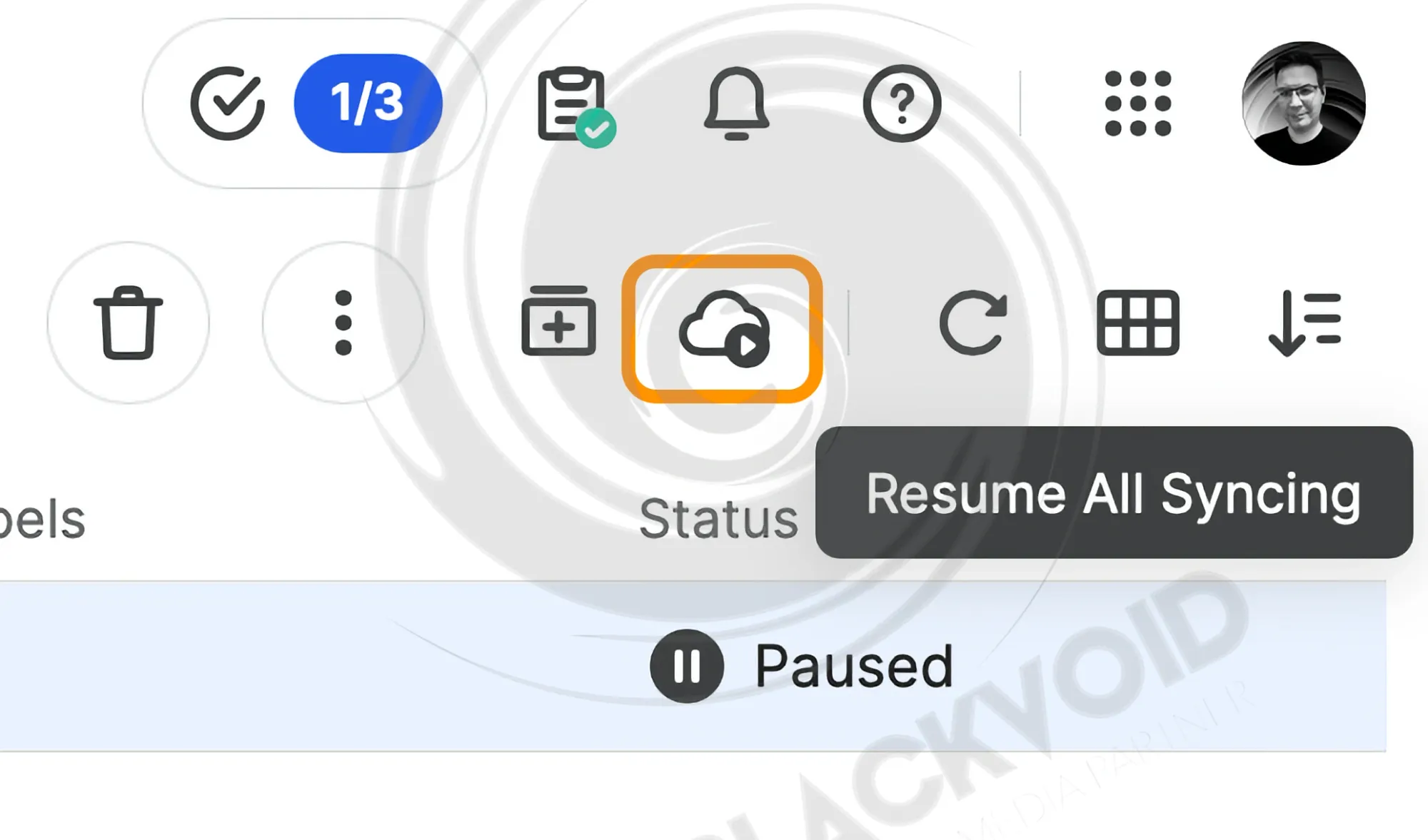
Once the sync is complete, all data will be accessible through the BeeFiles interface under the cloud services section. From there, we have the option to generate public links, add tags, and apply all the settings that were mentioned previously.
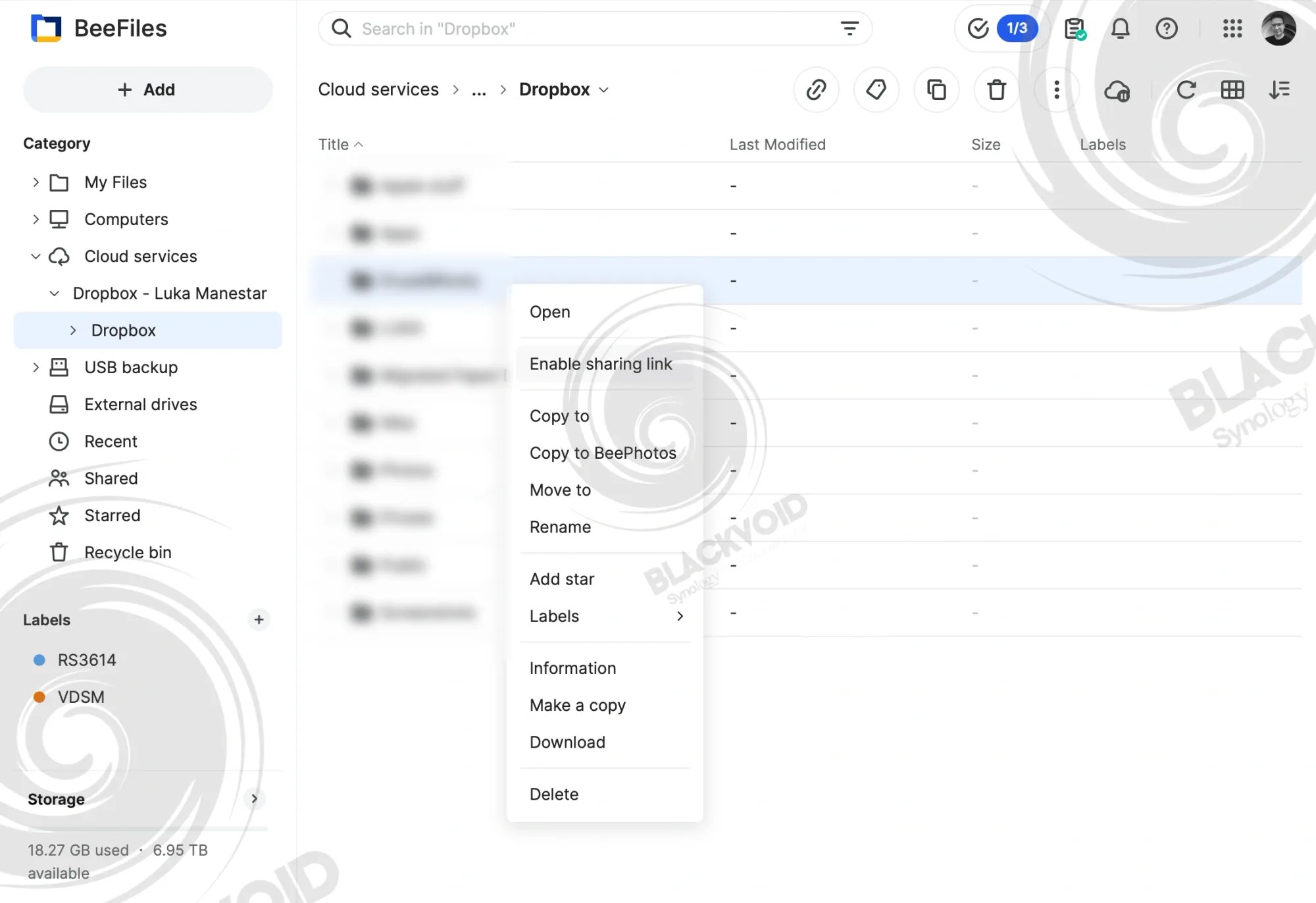
If there's ever a need to terminate the connection with any cloud service, we have two options: Unlink and Delete. The Unlink option will terminate the connection with the cloud provider but retain the local content that has been synced. The Delete option, on the other hand, will terminate the connection and delete all local content. This setup provides a straightforward method to maintain a local backup of your cloud data. The cloud services location, along with all synced data, is also included in any local or remote backup procedures discussed earlier, making the Beestation a crucial component of the entire process.
In a sentence, Beestation can be both a cloud sync alternative and connect to them to allow the user access to the same data via the BSM web UI. Also, it provides backup options along the way.
:: BeePhotos - AI-powered photo station
Unlike the BeeFiles app, BeePhotos is a more focused application designed specifically for viewing, collecting, and sharing photos and videos with Beestation users and guests. While it compares closely to DSM's Synology Photos app, BeePhotos lacks a few features, such as the folder view and sorting options when viewing all photos. However, it is largely similar in functionality.
Simplicity is key for users, as populating the app can be achieved in multiple, nearly one-click methods. On a computer, we can use a web browser with its drag-and-drop feature or the Beestation for Desktop app. Likewise, the BeePhotos mobile app offers options to manually upload photos and videos from the gallery, as well as automatically back up the device.
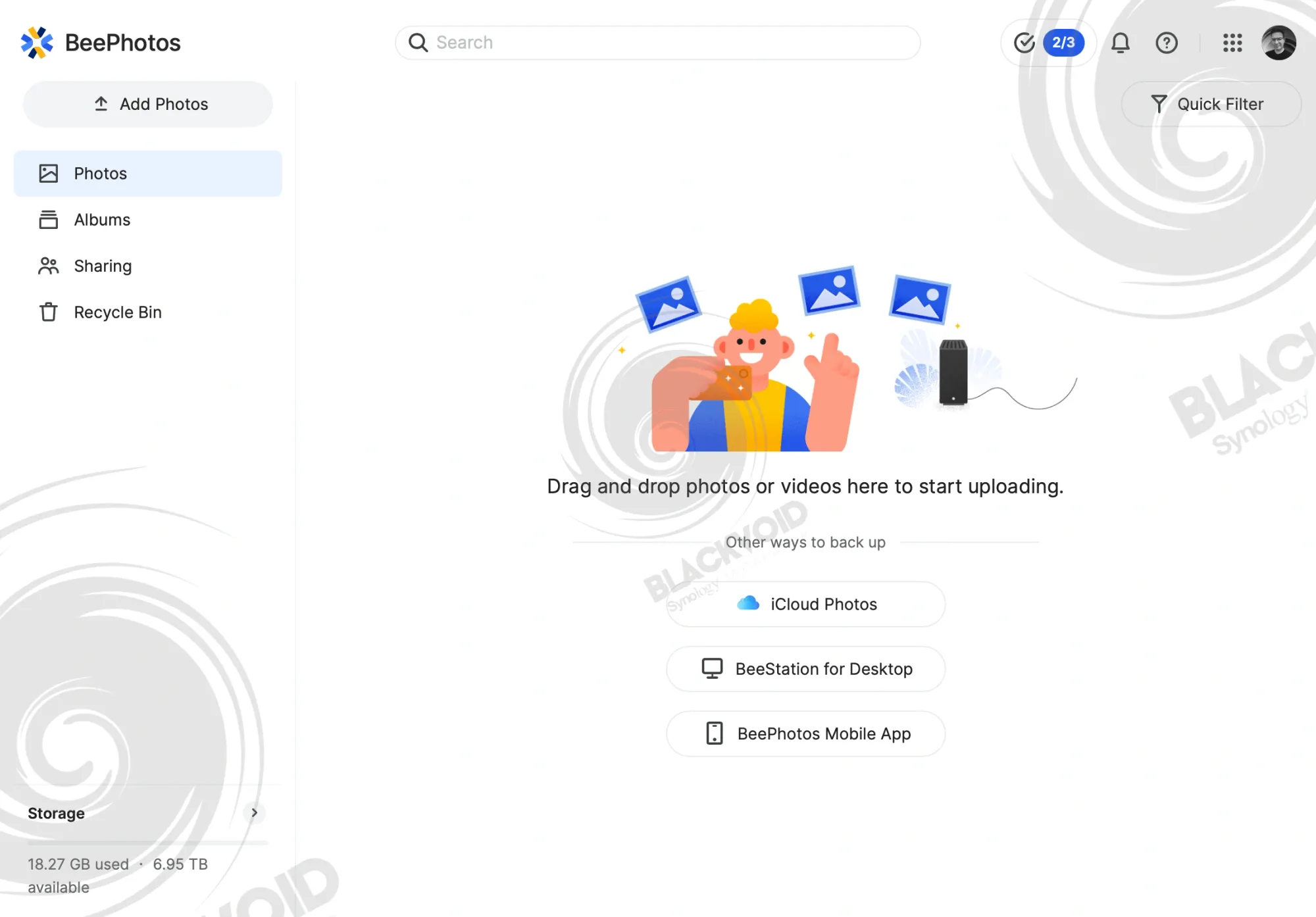
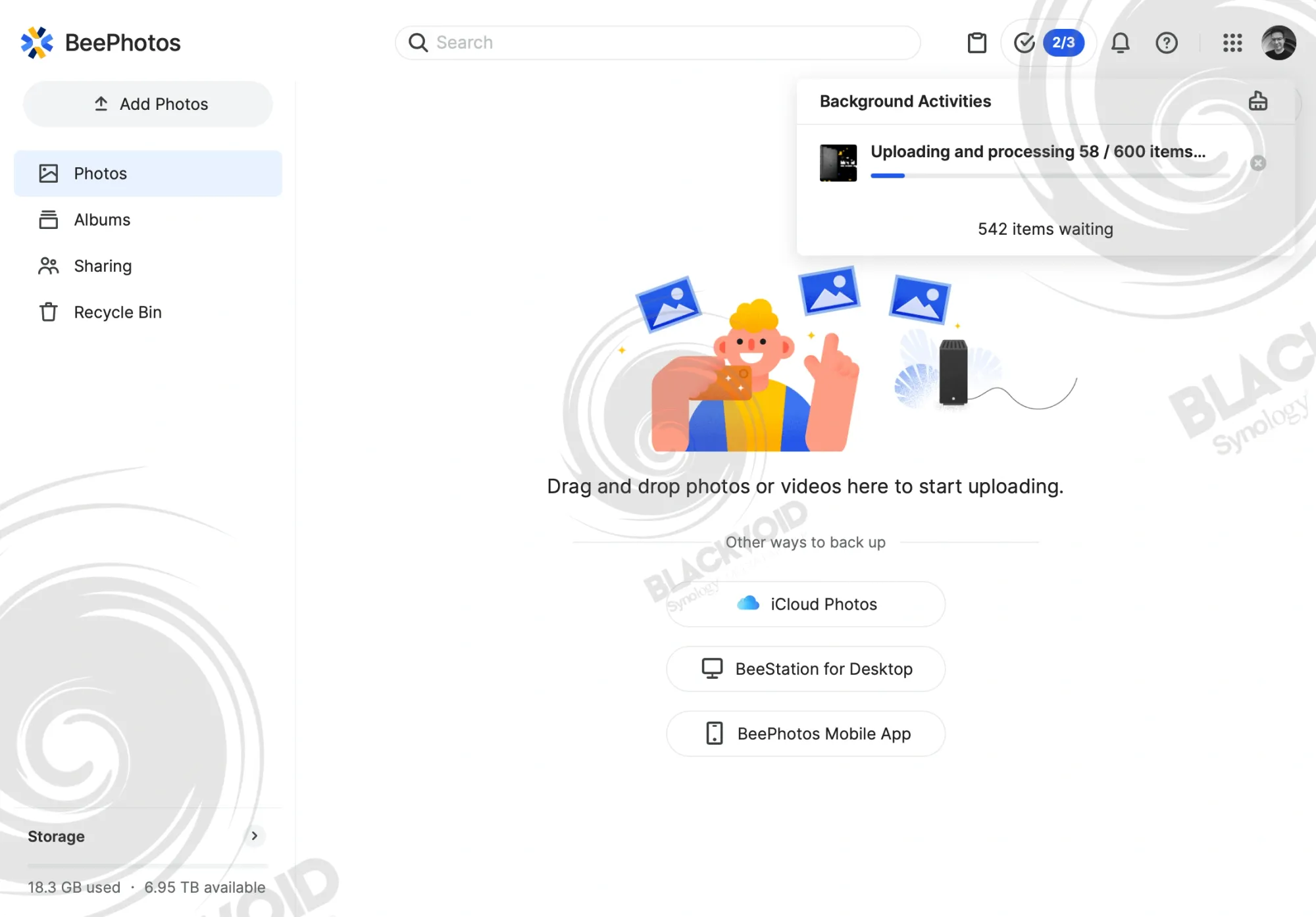
The timeline view is the default and sole viewing option, represented by a descending list of years on the far right side of the window. The app is best utilized for searching, tagging, or filtering the extensive list of photos and videos.
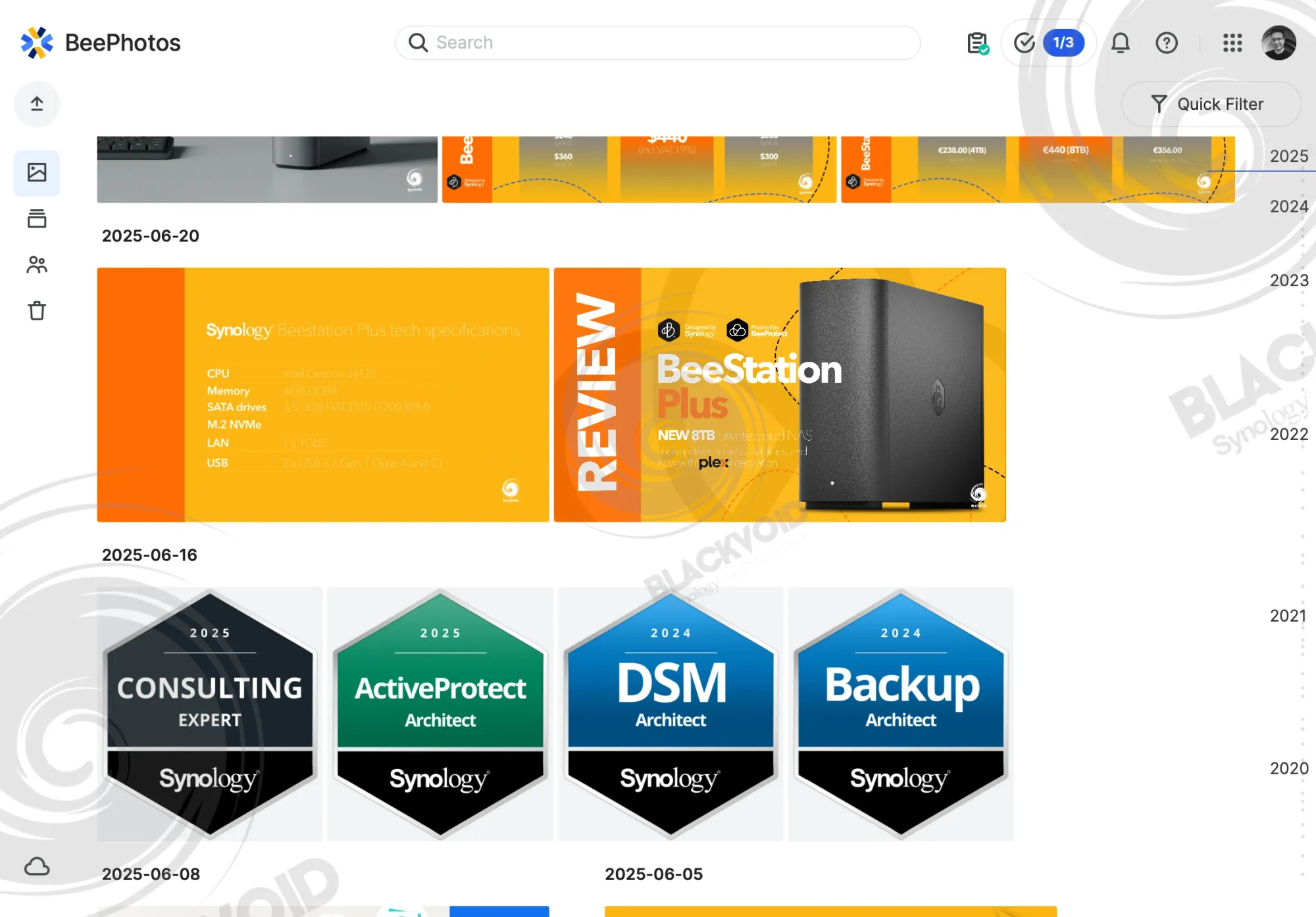
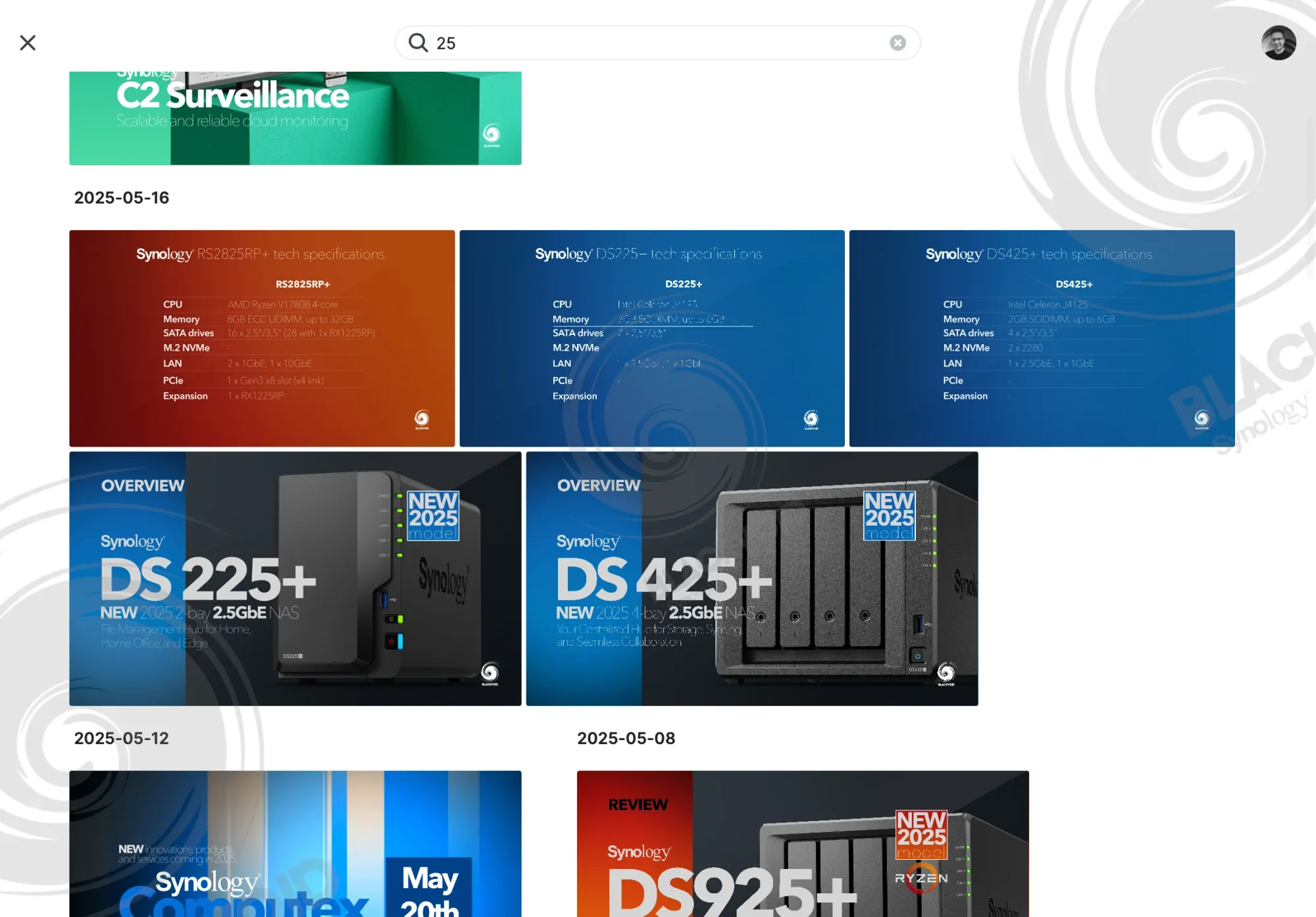
Due to the absence of a folder view—unlike the Synology Photos app on the DSM side—BeePhotos provides equivalent functionality with a quick filter. This feature allows us to efficiently locate the necessary files without the need to scroll through an extensive list. In addition to default filter conditions like file type, date, geolocation, and people, additional filter options can be activated to further refine our search scope.
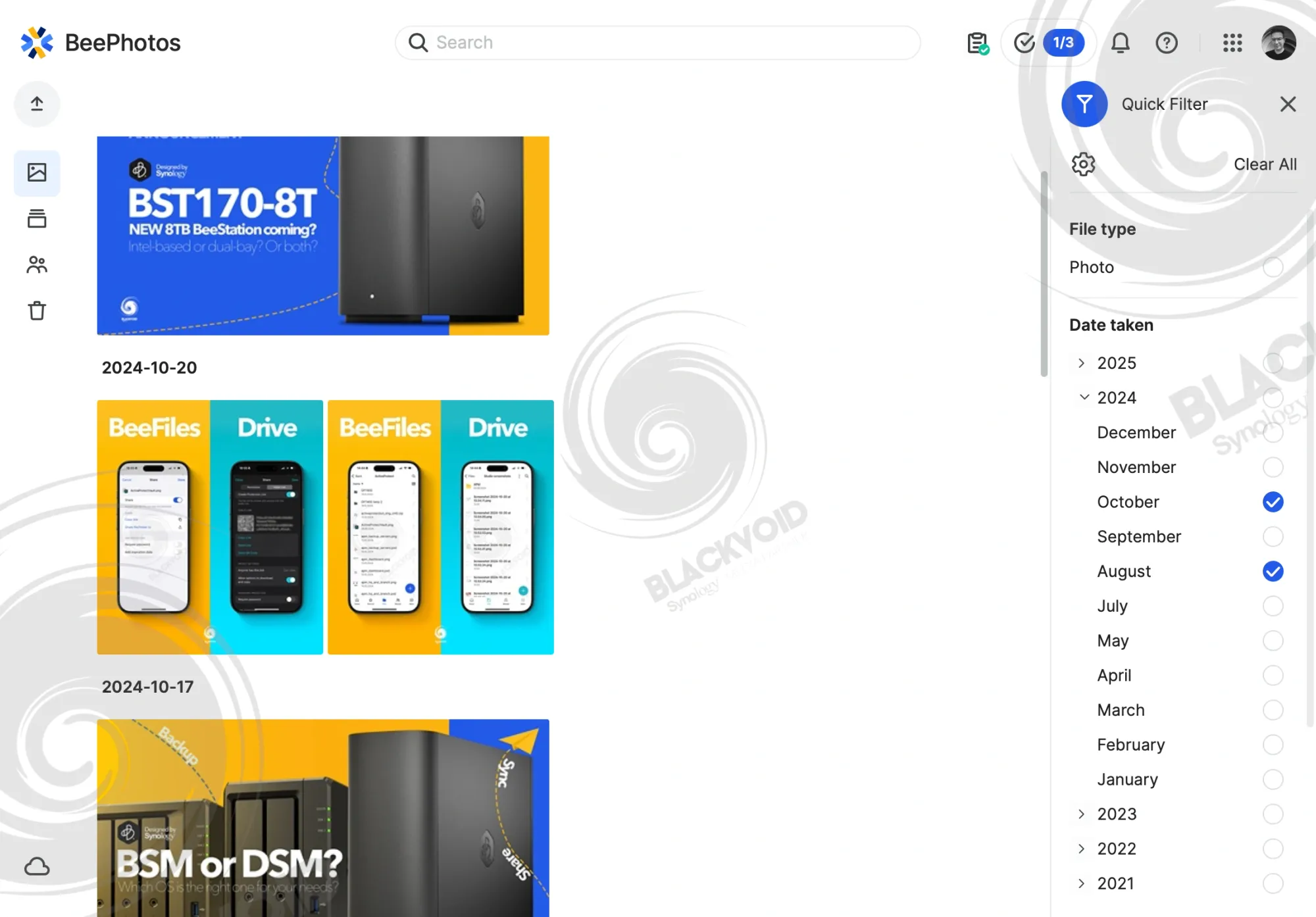
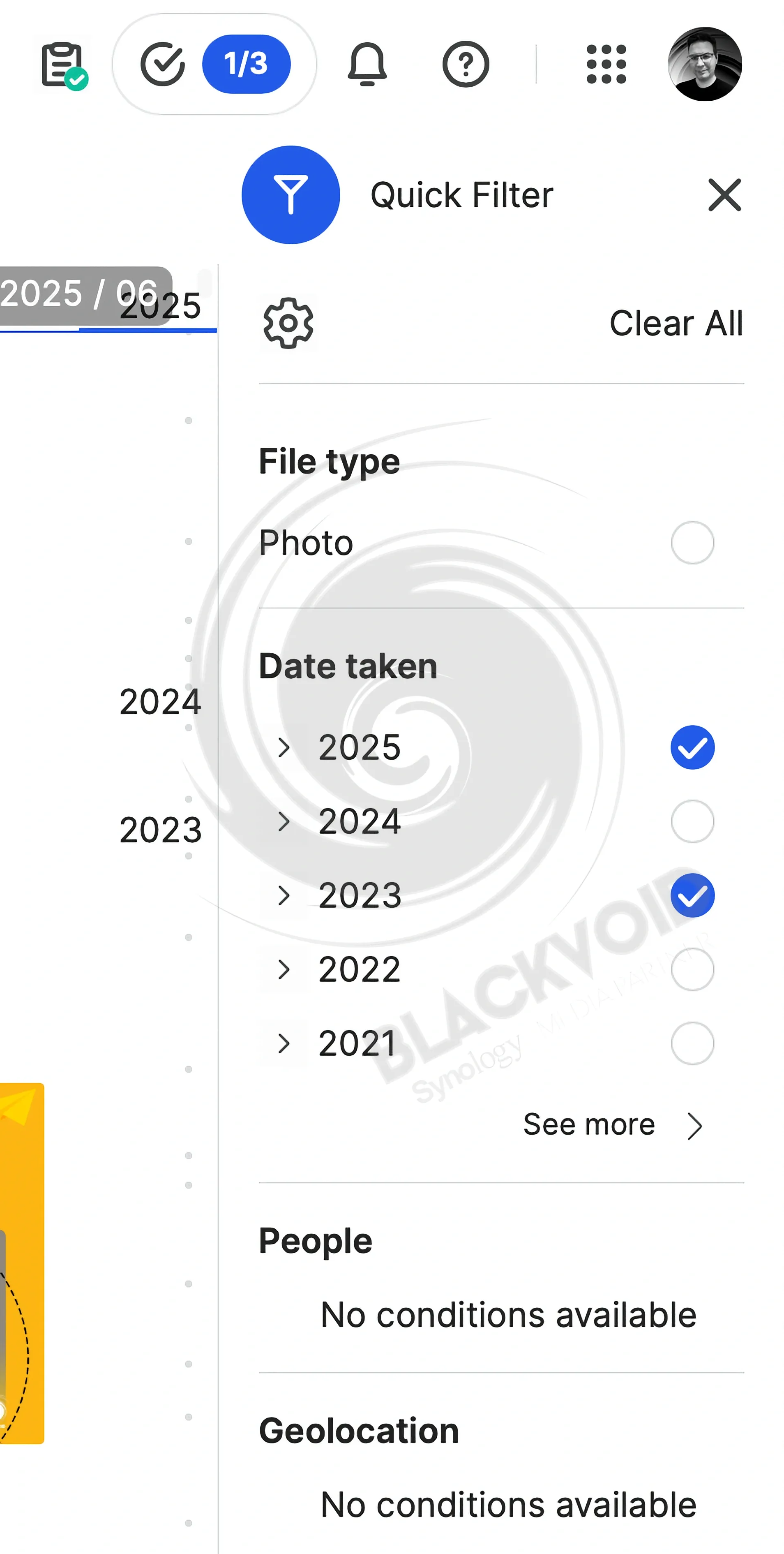
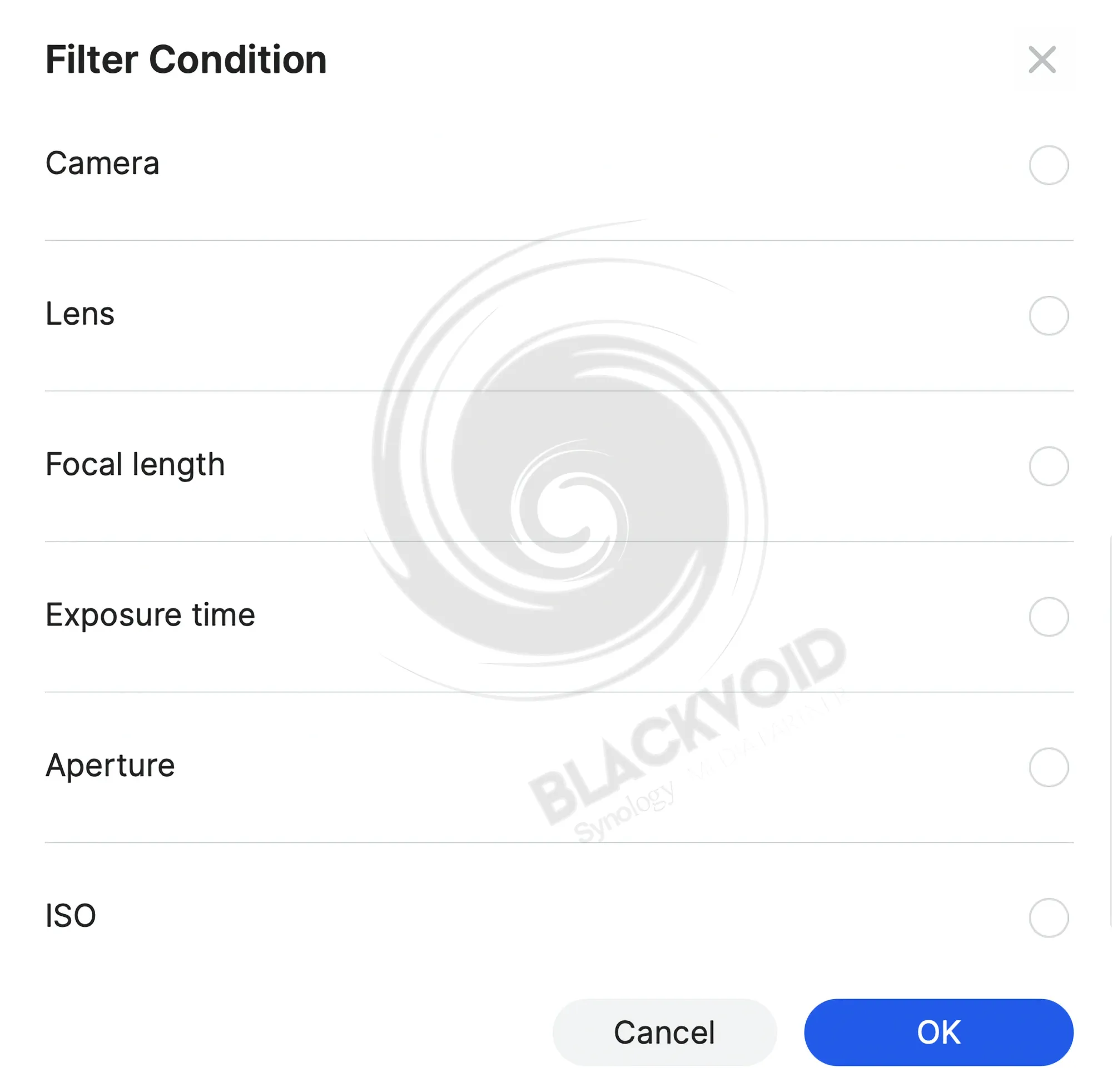
Of course, all of this functionality depends on the presence of metadata within the file, which varies based on the device used to create it. Even with search and filter options, the most effective way to group images is by using virtual albums. These are termed 'virtual' because the content is not duplicated; instead, it is virtually organized into a specific album, making it more easily accessible under a designated name.
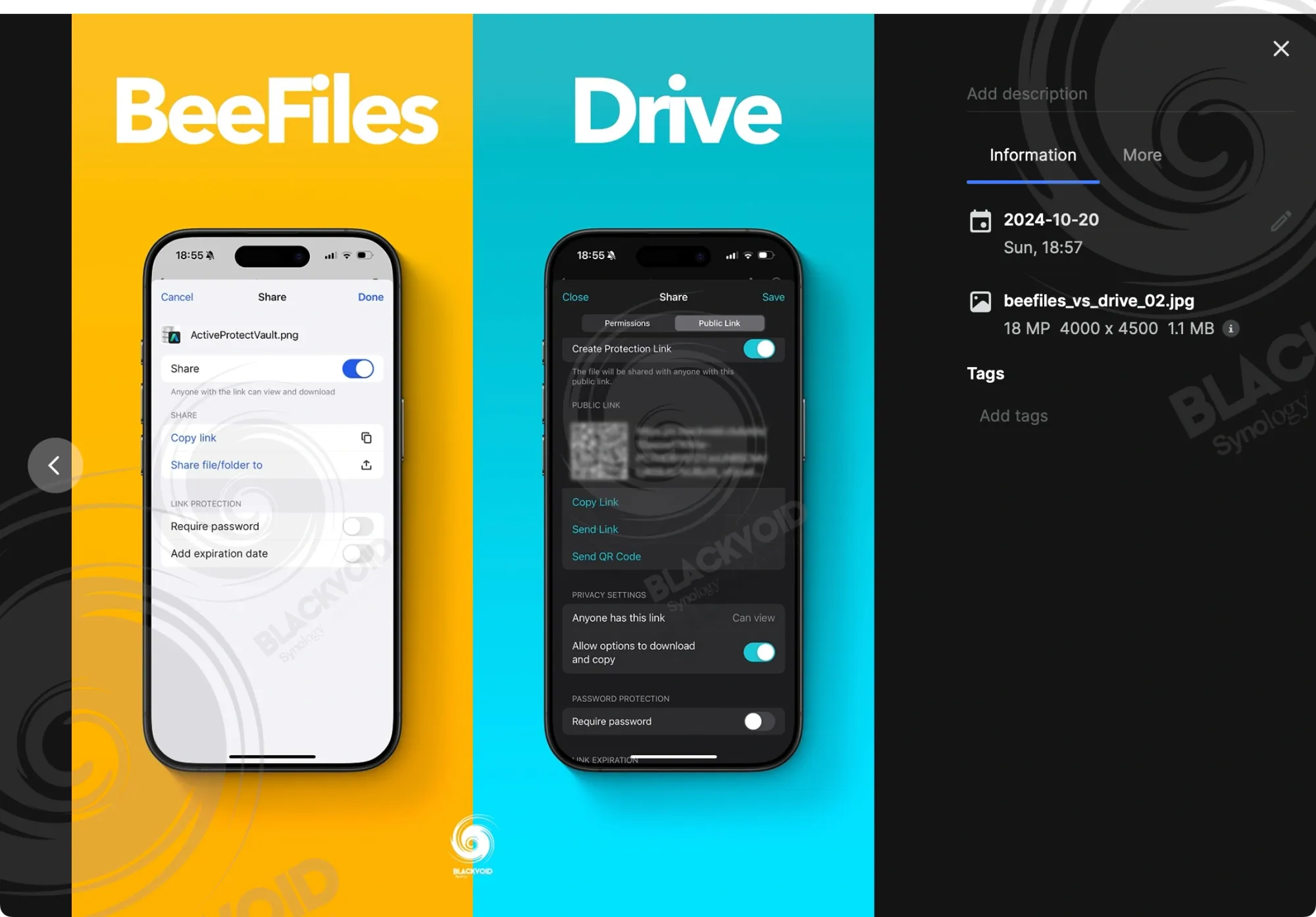
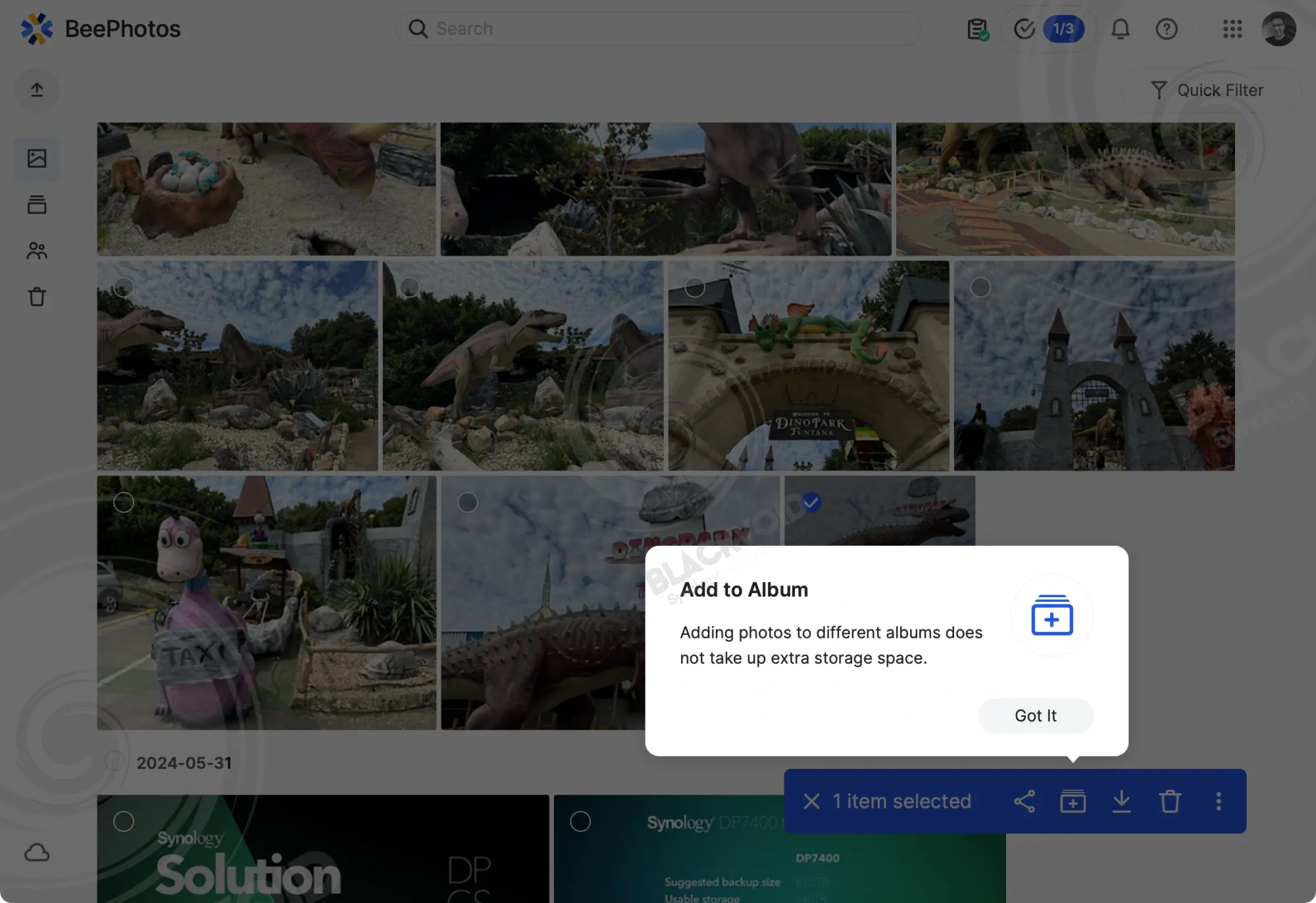
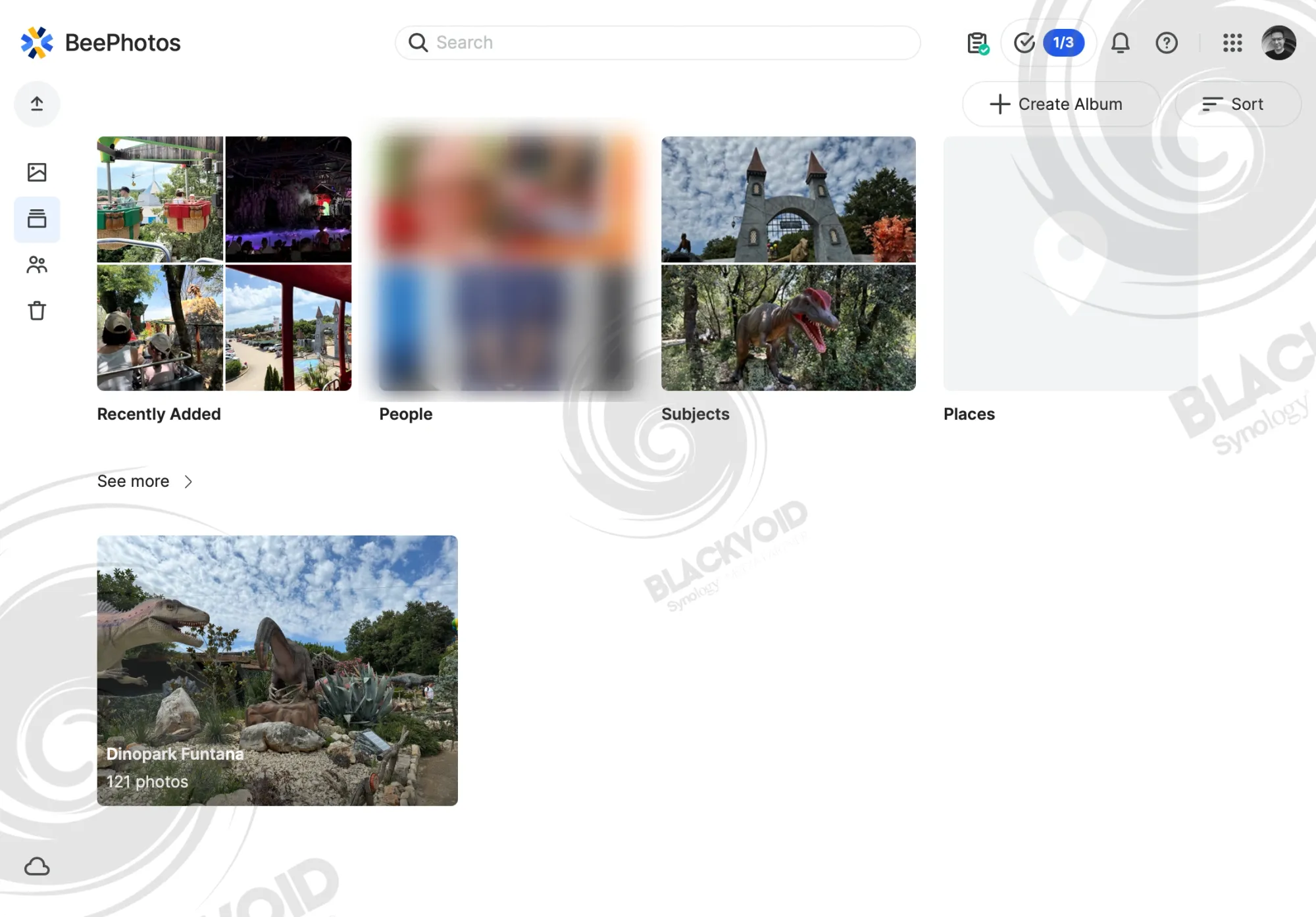
BeePhotos utilizes several predefined virtual albums, such as People, Subject, and Places, in addition to those we can create ourselves. The albums include a sort function, although they lack filtering and other features like sharing, renaming, and a photo request option. With the photo request feature, we can send a link to anyone, enabling them to upload images directly into the specified album.
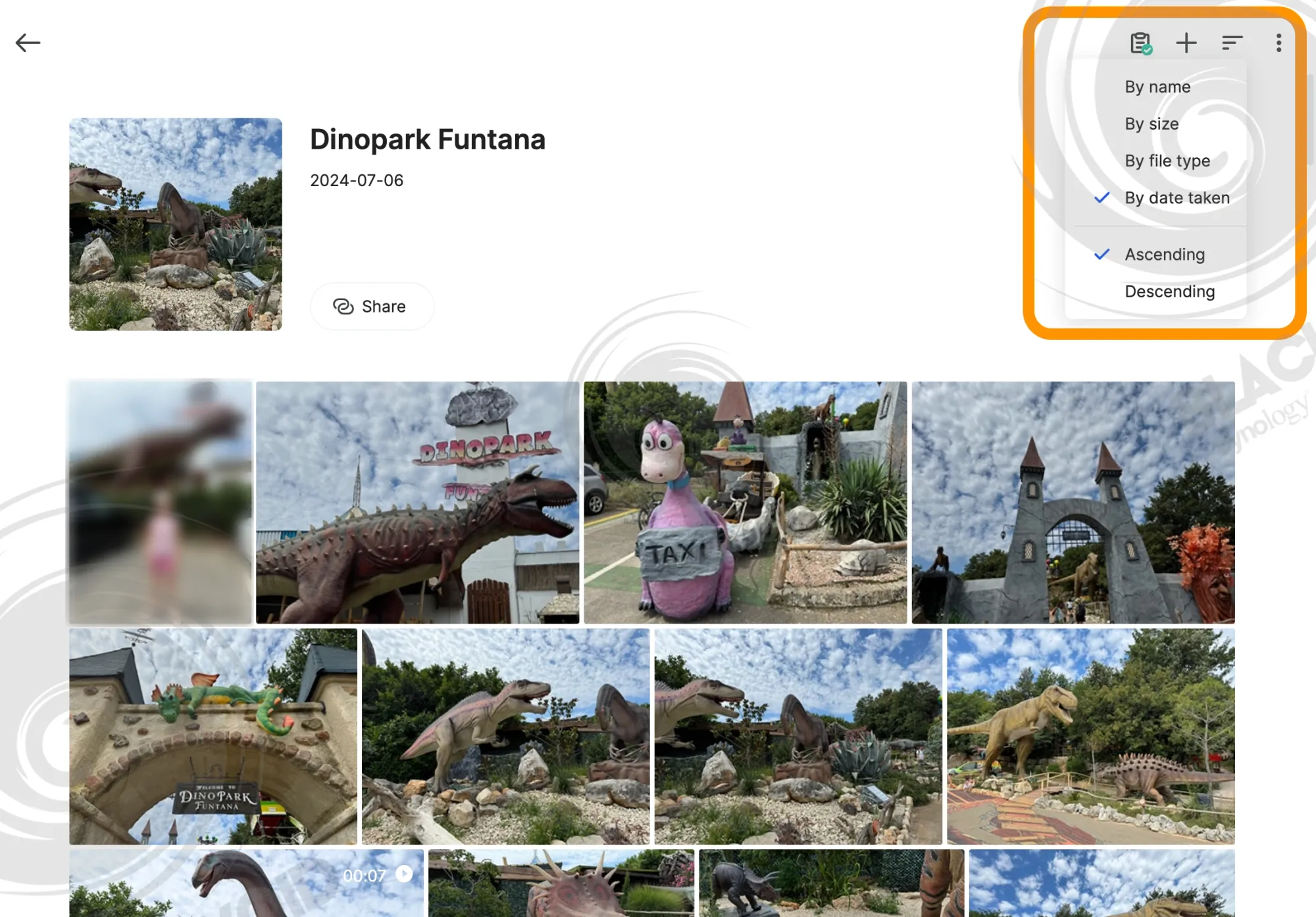
This feature is particularly useful for collecting content from multiple sources without the hassle of individual coordination and curation. It allows multiple users working on the same project to combine images or videos in a single, easily accessible location, eliminating the need for one person to manage everything.
Speaking of sharing, BeePhotos offers a public share link option, enabling recipients to access specific albums. An added benefit is that the link can be protected with both a password and an expiration date.
: PLEX - private media server
So far, we have covered many elements of the system settings section of the BSM. However, one feature is both new and unique to BSM 1.3 on the new Beestation Plus model. With the Plus model's internal hardware upgrades, the BSM has evolved, introducing a new option to expand existing features through "integrations." Although the BSM lacks the traditional DSM Package Center, integrations extend its capabilities beyond BeeFiles and BeePhotos.
Interestingly, Synology's first integration choice is the third-party app, PLEX.
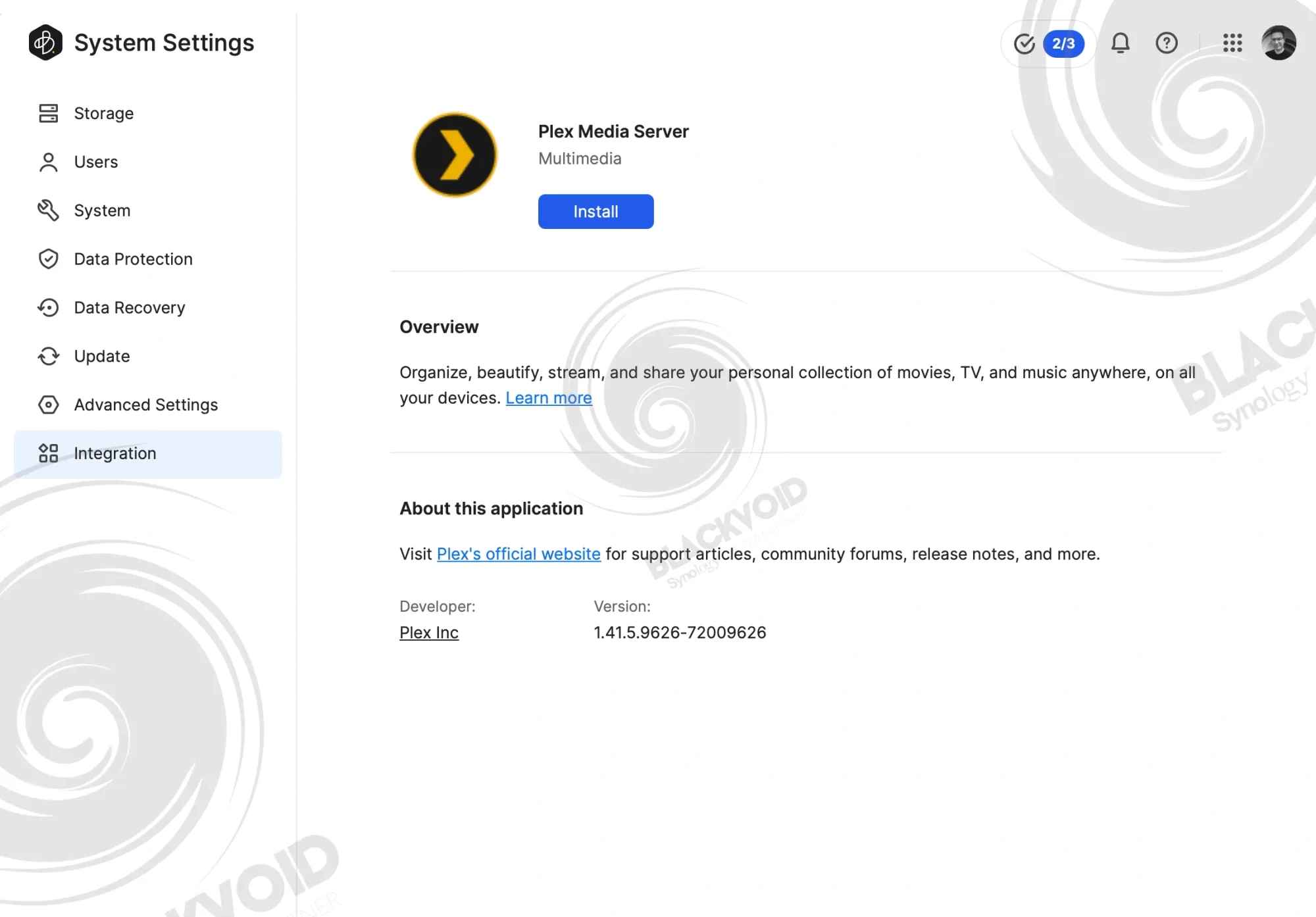
For those unfamiliar with why Synology is promoting Plex on this device rather than their own Video Station, the reason is straightforward: Video Station was deprecated with DSM 7.2.2. While BSM is a separate OS, it still has DSM roots, and given Plex's popularity, it made sense to support a more polished and widely supported media platform rather than pushing their own.
Additionally, the BeeStation Plus runs on an Intel-based CPU with QuickSync, offering a budget-friendly device with media streaming capabilities. These capabilities were removed from several NAS units following their transition to AMD-powered CPUs. While those devices can still run Plex, they do not offer the same full-feature set as an Intel Celeron-based unit.
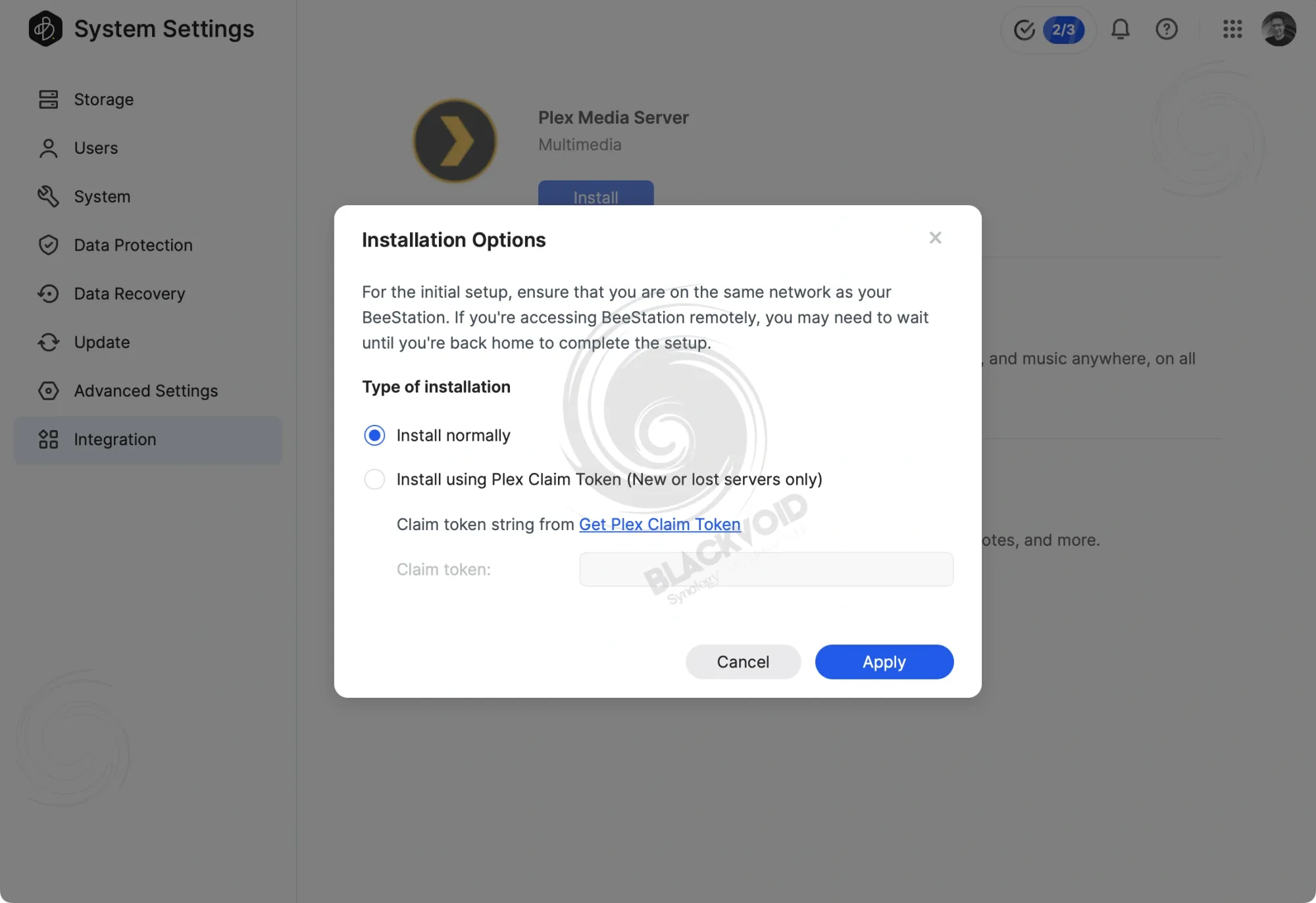
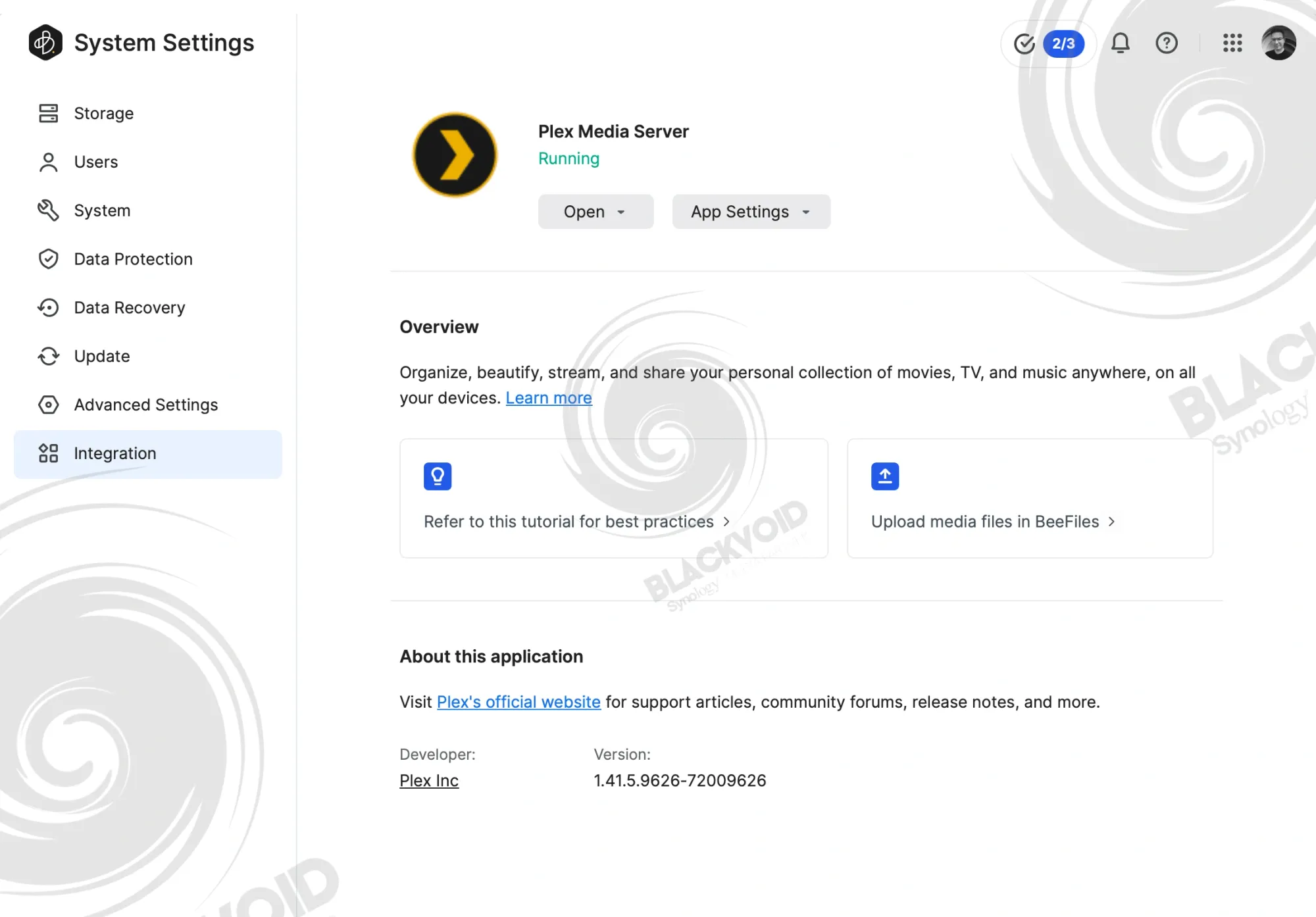
Anyone who has installed a Plex server before is aware that the process involves more than simply installing the server. However, with BSM, the only additional step is uploading your content. Unlike other systems, BSM comes pre-configured with all the necessary libraries for Plex, including Movies, TV Shows, and even personal home movies or photos. Indeed, Plex can also serve as a media server for photos.
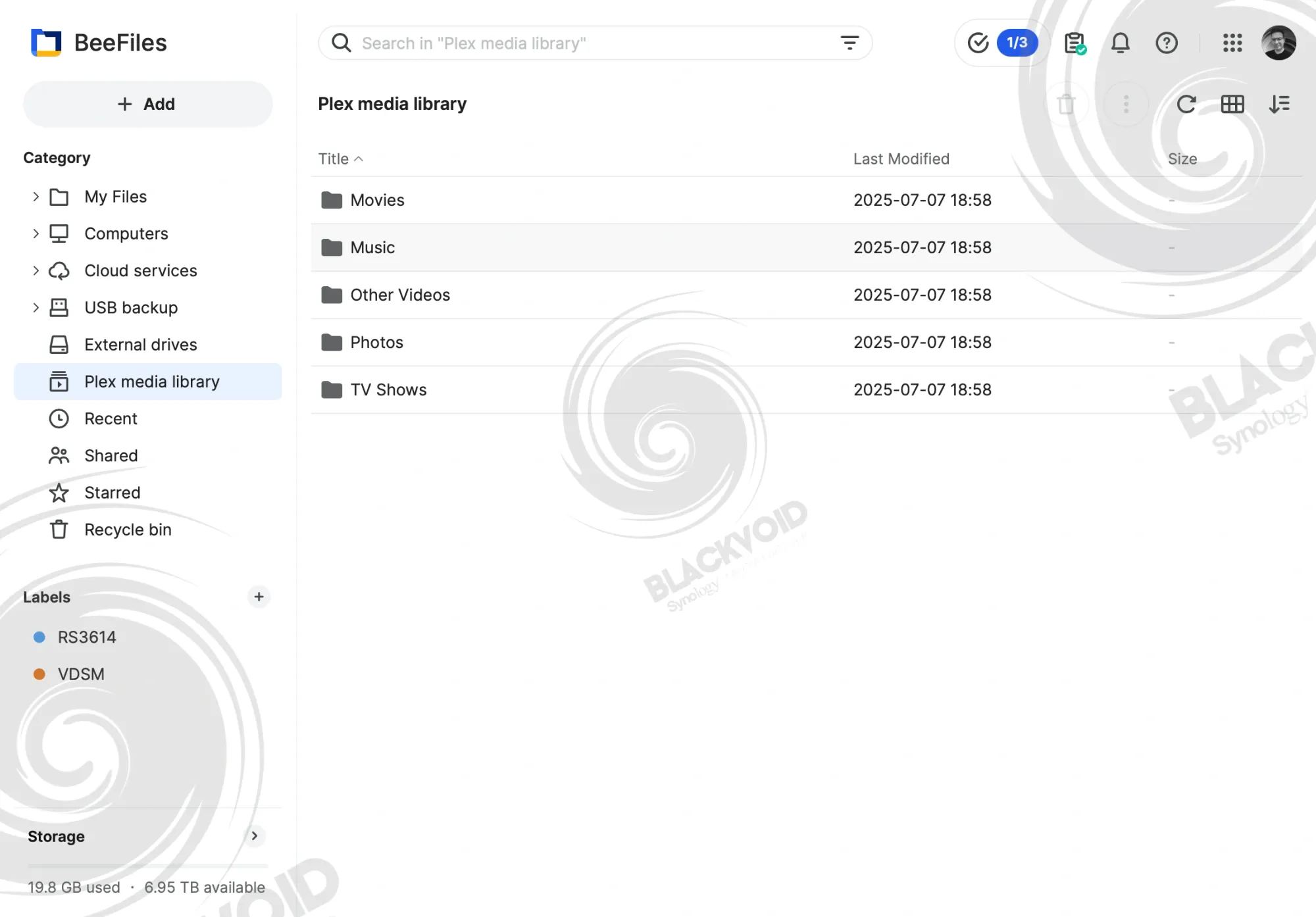
When we say "pre-configured," it means that BSM automatically opens and creates the necessary folders, displaying them within the BeeFile interface. By simply uploading your content, we can start populating the root folders. Once Plex is configured to monitor these specific folders, the content will begin to appear.
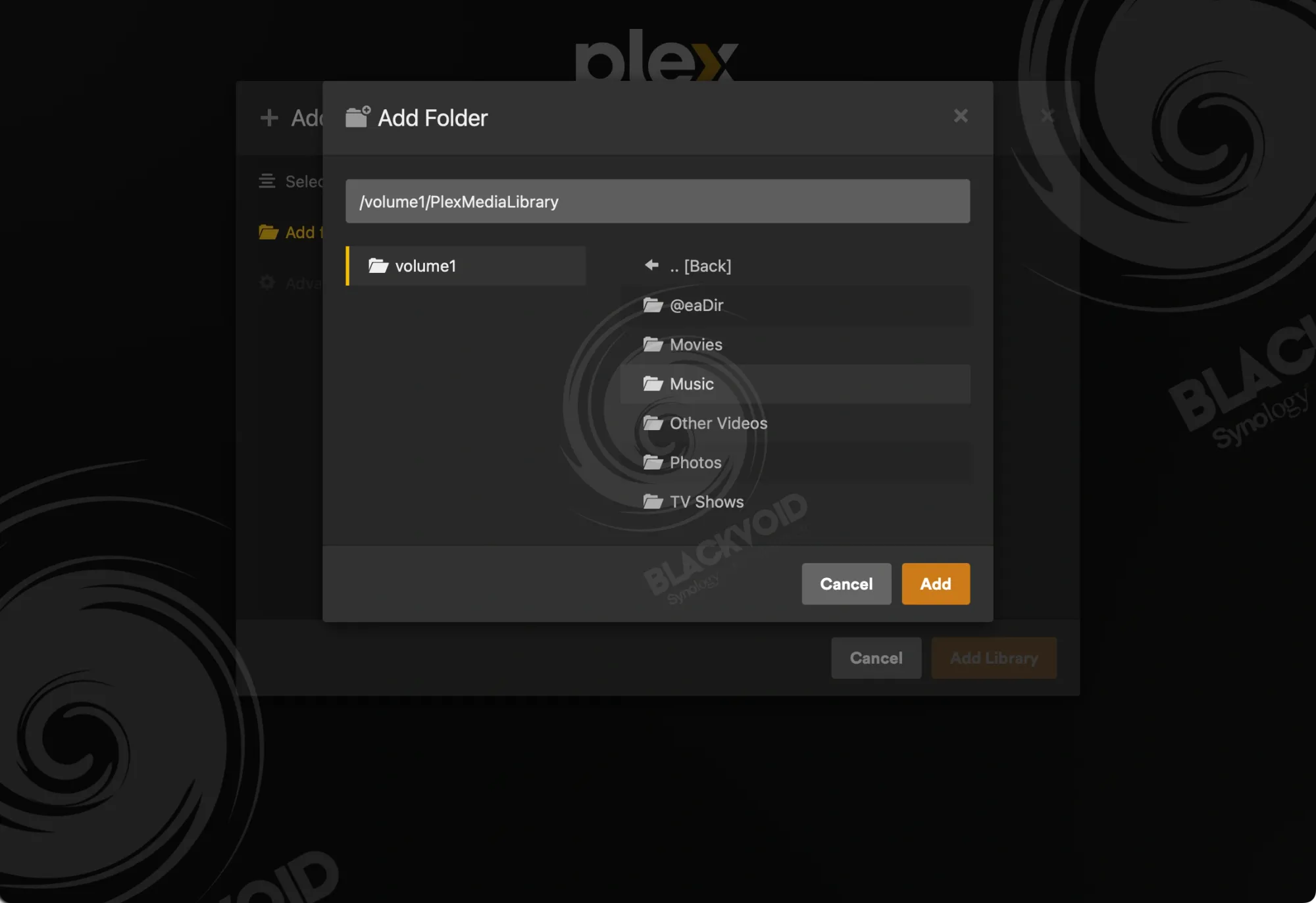
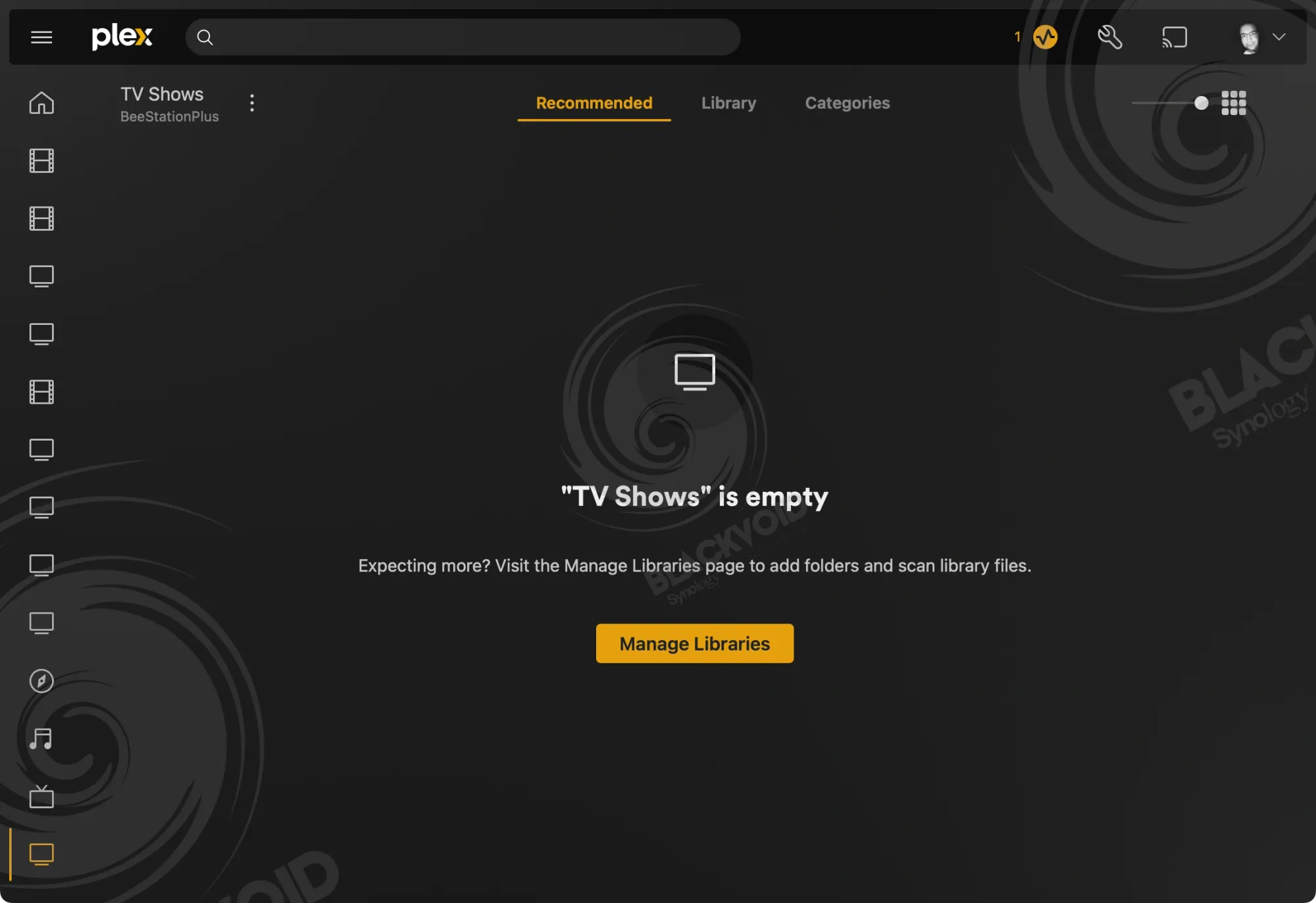
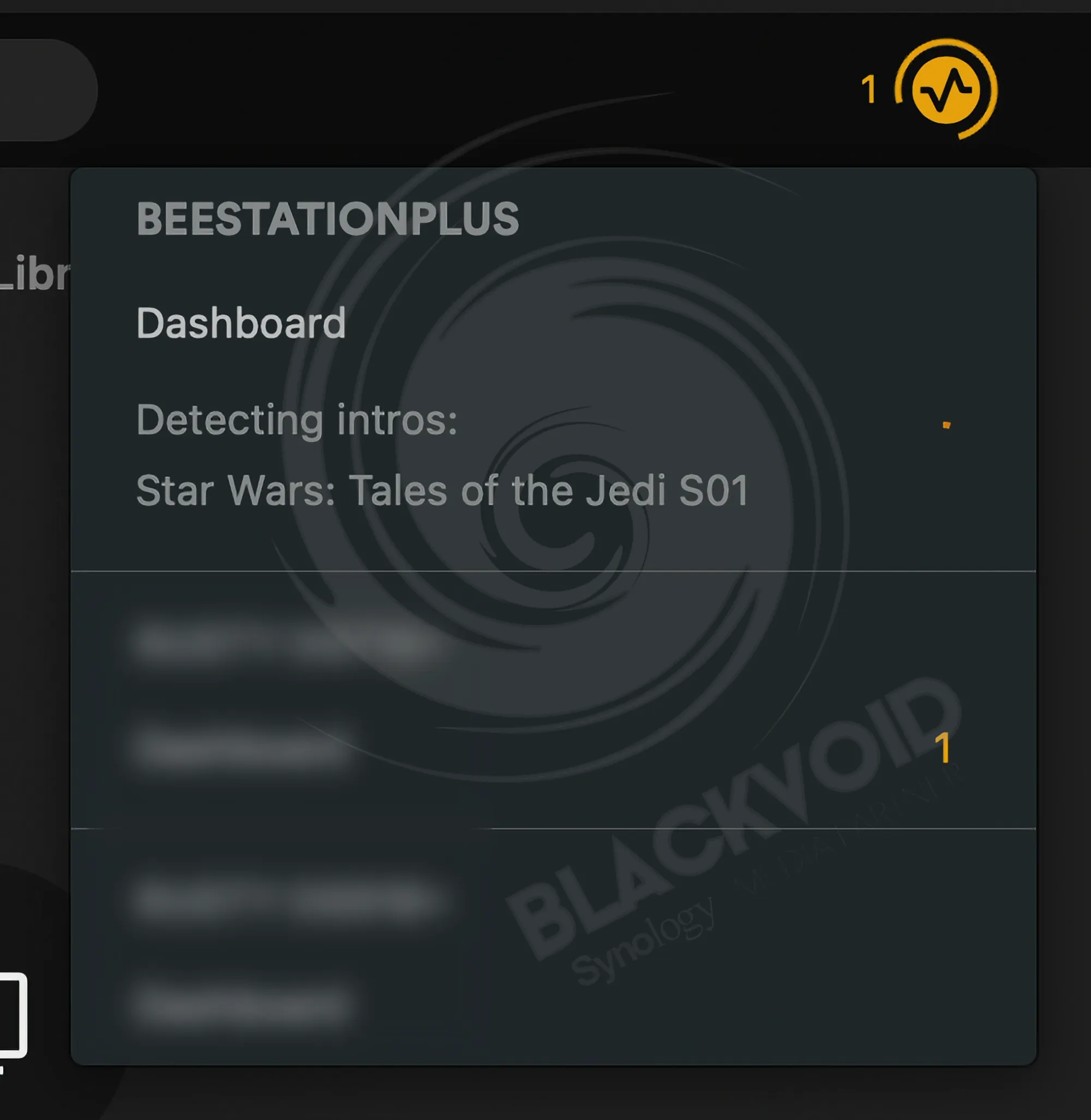

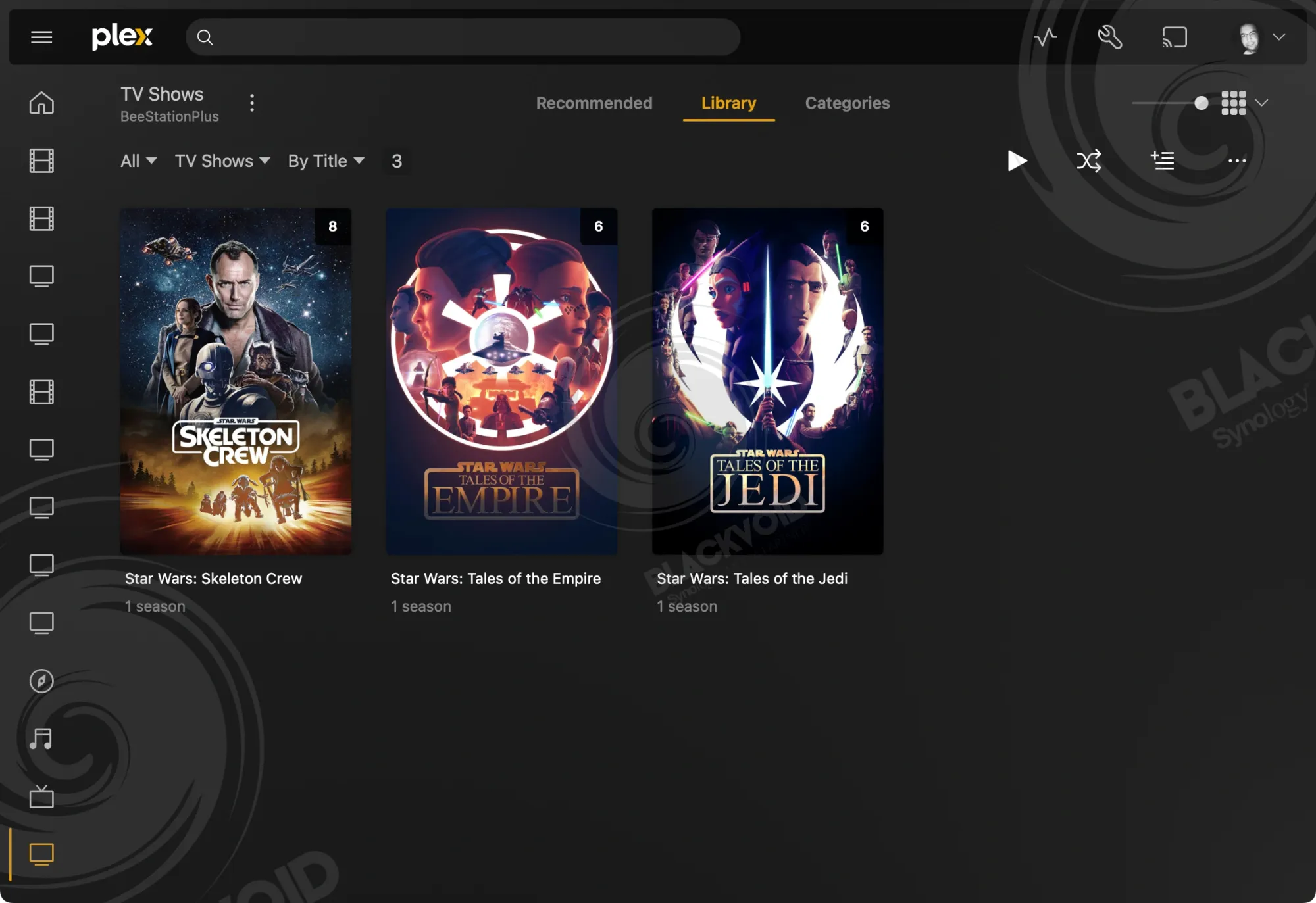
It's important to note that this device operates with the same CPU found in several NAS devices. The Intel Celeron J4125 model provides ample power to handle any library size and supports multiple concurrent streams.
Plex users should aim for "direct play" to minimize the performance impact on the Beestation. In this mode, the NAS streams the content while the Plex client app handles the heavy lifting of audio and video decoding.
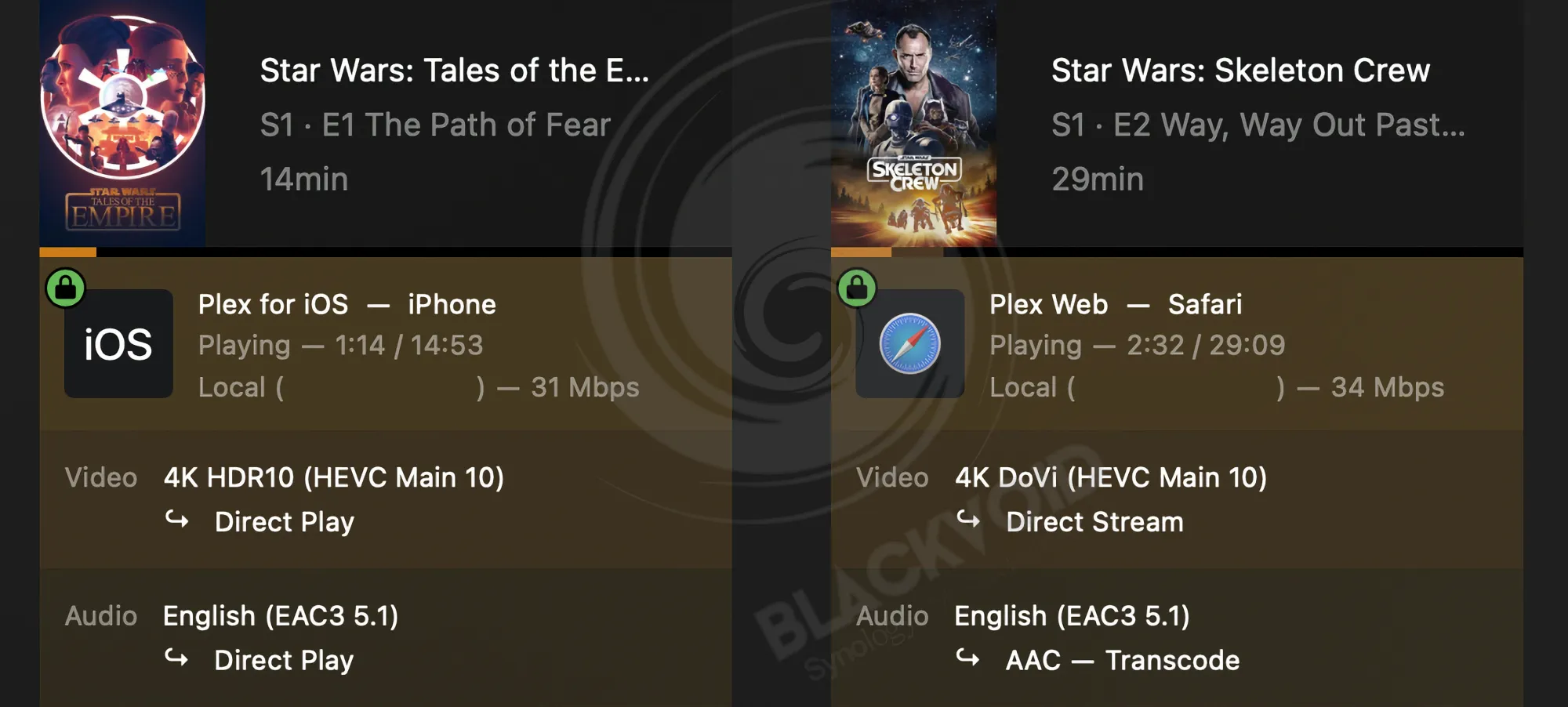
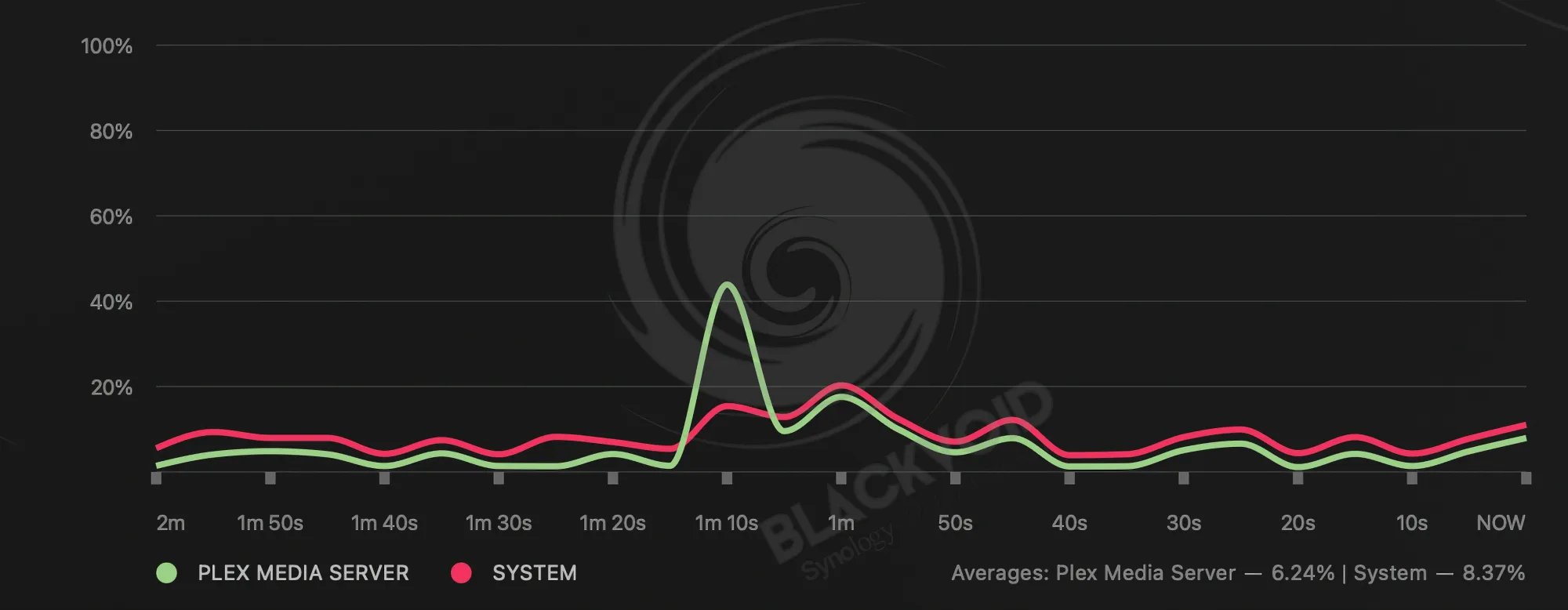
Testing with an iPhone 15 Pro using the official Plex app and through Safari with the Plex web client, Beestation effortlessly handled playing two parallel 4K Dolby Vision and HDR10 files. The impact on CPU and RAM was minimal, leaving ample capacity for other NAS operations.
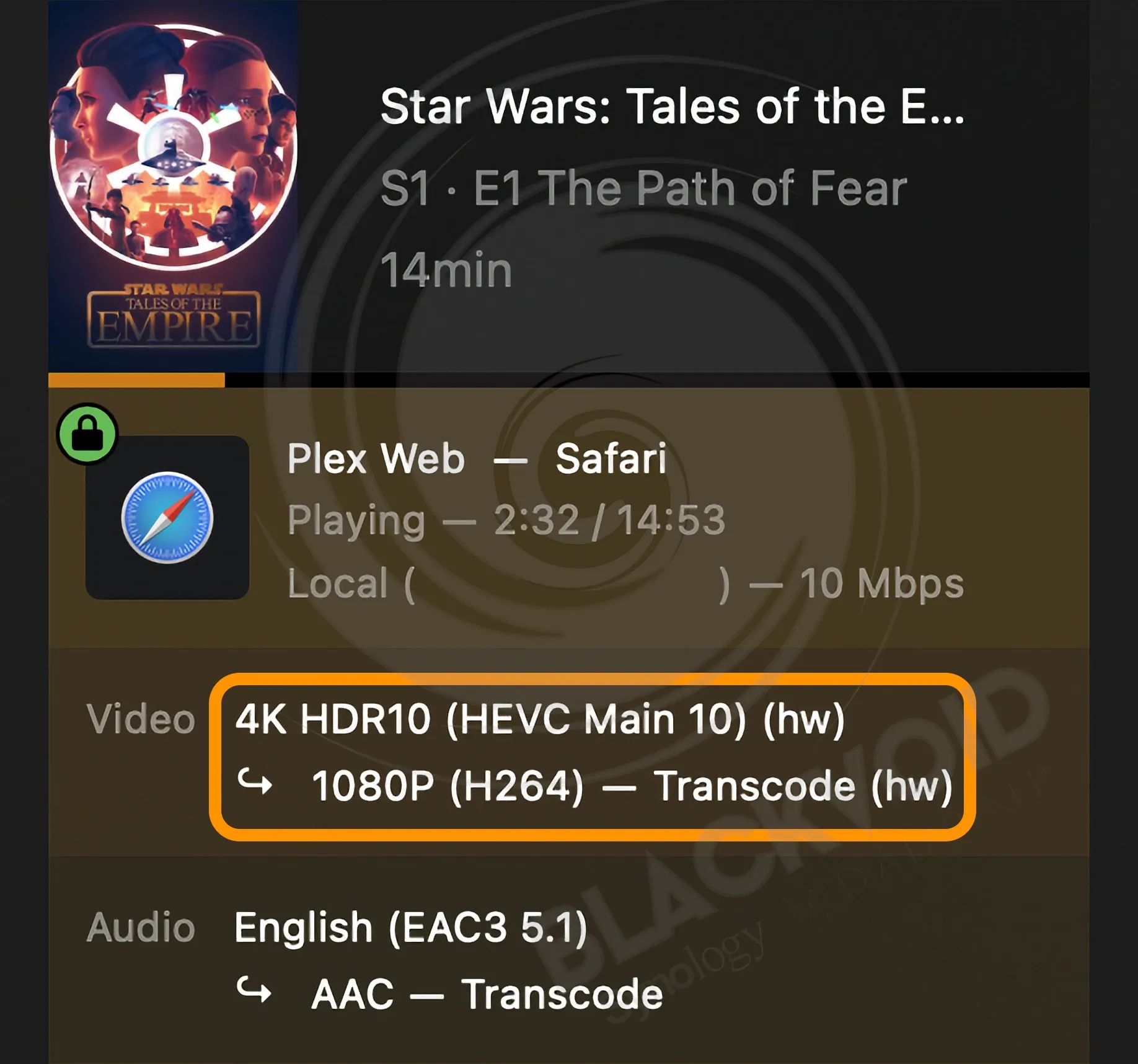
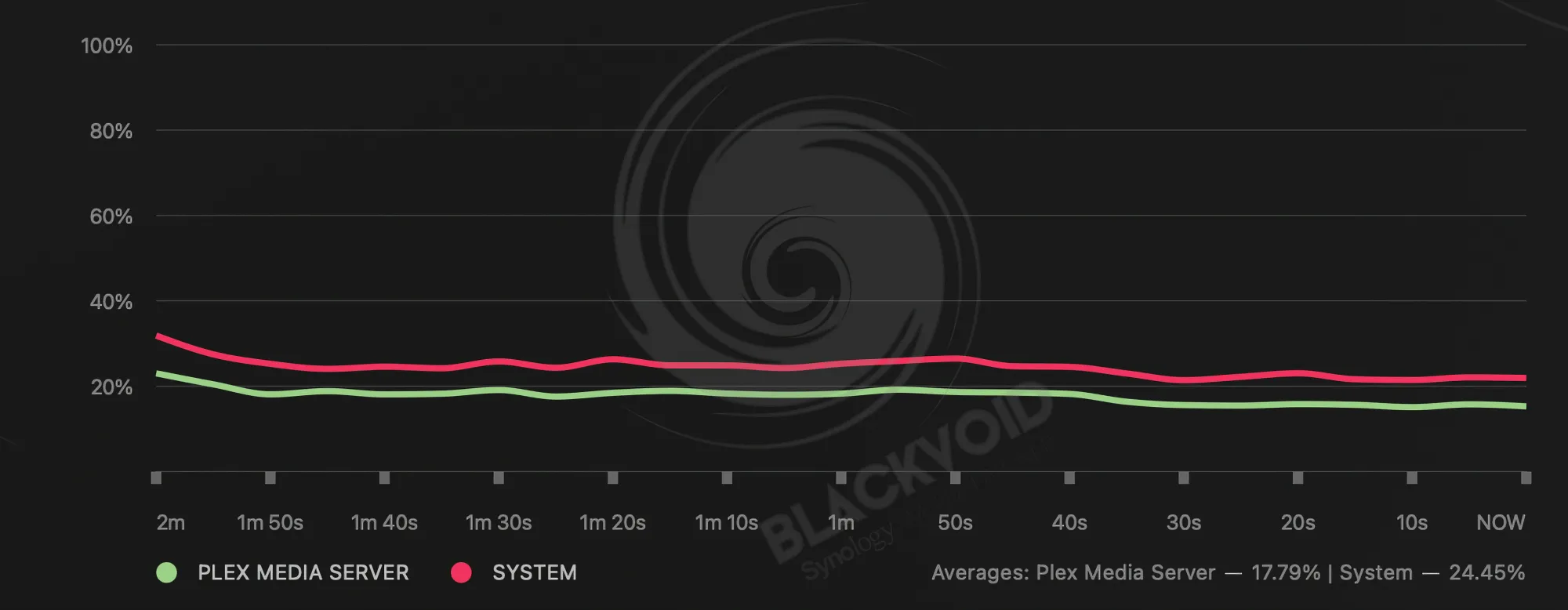
With a Plex Pass subscription, the Plex server gains access to hardware transcoding capabilities. The Celeron CPU natively supports QuickSync technology, enabling minimal CPU utilization during transcoding processes, such as converting 4K content into a 1080p stream.
As expected, Beestation Plus handled this process seamlessly, with playback continuing smoothly from 4K to 1080p after a brief transition.
Additionally, features like "Skip Intro" and "Skip Credits," available with Plex Pass, worked flawlessly, making Beestation an excellent choice for binge-watchers and a worthy Plex media server device.
While this is great news, some might question the practicality of using such a device as a Plex server, given its single 8 TB drive. Beyond redundancy issues, 8 TB might not be sufficient for an average movie or TV show enthusiast today.
BSM, as an operating system, specifically through BeeFiles, does not offer the same functionalities as DSM's File Station, particularly the remote mount feature. This feature allows access to remote storage devices (like other Synology NAS) via SMB or NFS network protocols by presenting that content as part of the local folder structure.
With this in mind, we could create local BeeStation folders and then mount remote SMB shares to them, allowing the Plex server to present content stored on a different device than the actual BeeStation Plus.
:: Local access and remote shares
Before proceeding, note that the following steps are unnecessary unless there is a need to pull in Plex content from a remote location. Additionally, access to the root account and SSH on the BeeStation is required. This is supported and can be enabled via the BSM System Settings.
Under Advanced Settings > Synology Technical Support, toggling the Remote Access switch will generate a temporary SSH username, password, and port. With these credentials, we gain command line access and, using sudo elevation, actual root permissions.
At this point, we can begin the unsupported process of mounting remote folders to present them as Plex sources on the BeeStation. Why is this considered unsupported, even though we are using official Linux command lines? While it is possible and does not involve making system file changes at the BSM layer, it can only be performed via the command line and not through the BeeFiles web interface. Due to this limitation, it is best treated as an unsupported feature within a bit of a grey area.
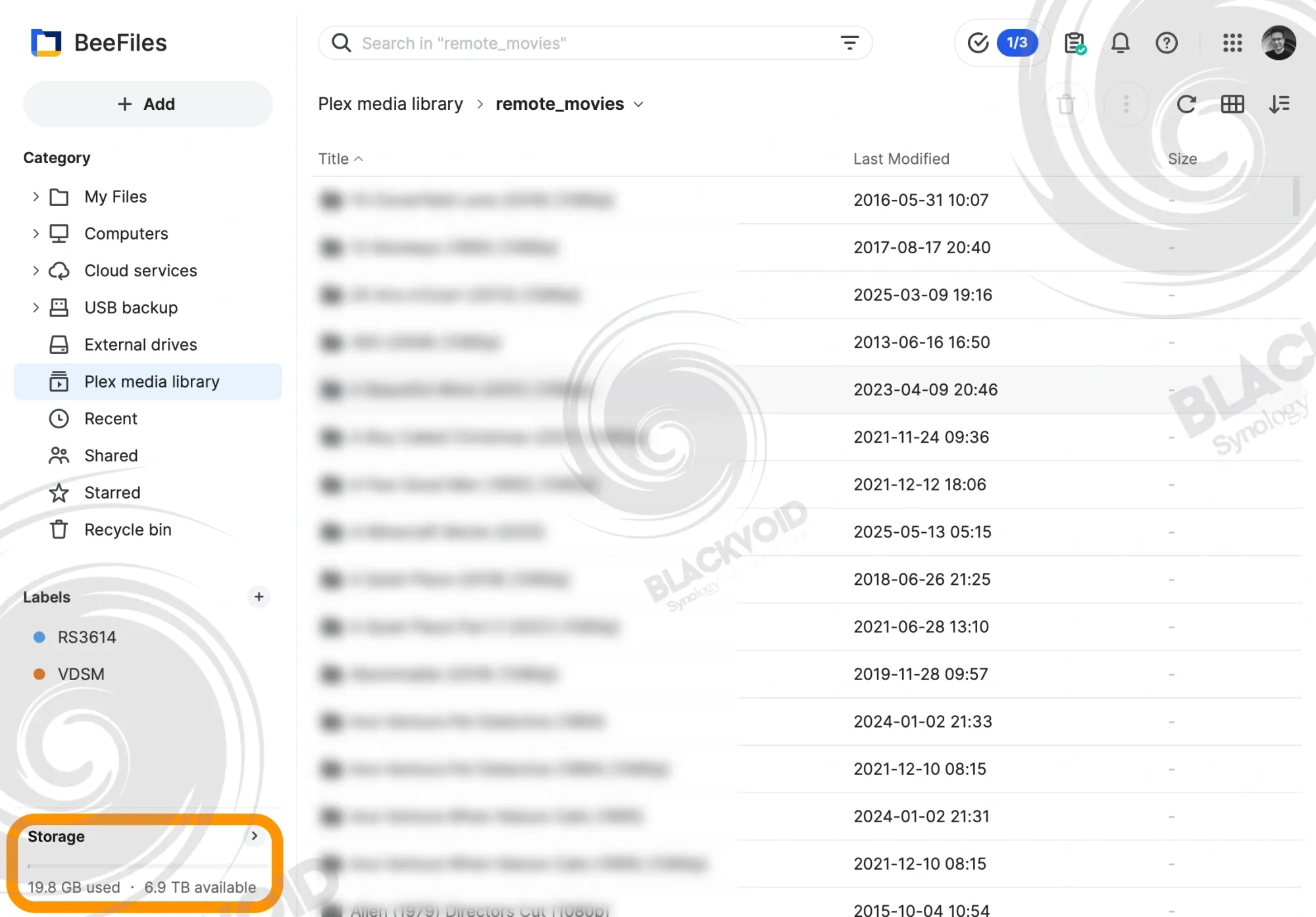
Once we have SSH access elevated to root (using sudo -i command), we can simply use the following command line to create a remote folder mount point.
mount -t cifs //server_address/share_name /volume1/PlexMediaLibrary/remote_movies -o username=your_username,password=your_password
The //server_address/share_name is the network address or IP address of the device hosting a shared folder of choice, while /volume1/PlexMediaLibrary/remote_movies is the location and name of the local Beestation shared folder that will host the remote mount path.
username and password parameters are the remote account credentials that are needed to pass the authentication.

root user and group ID unlike the rest of the Plex defined folders. This can be configured via SSH after the fact if needed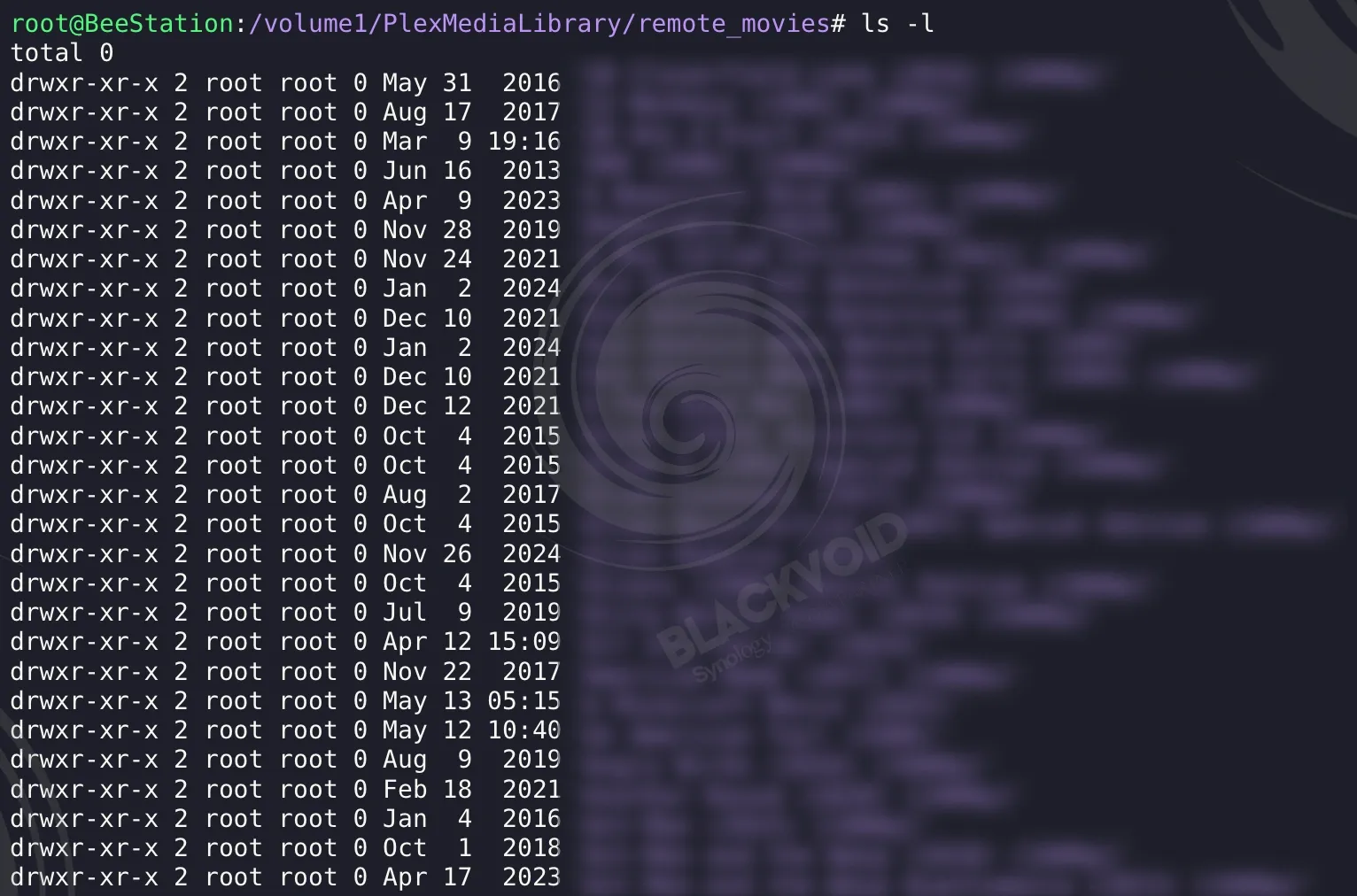
Browsing through BeeFiles or accessing the Plex UI to set up a new library will display the remote content without any issues. Once the library is configured, BeeStation enables streaming content from a remote location using the local Plex server instance.
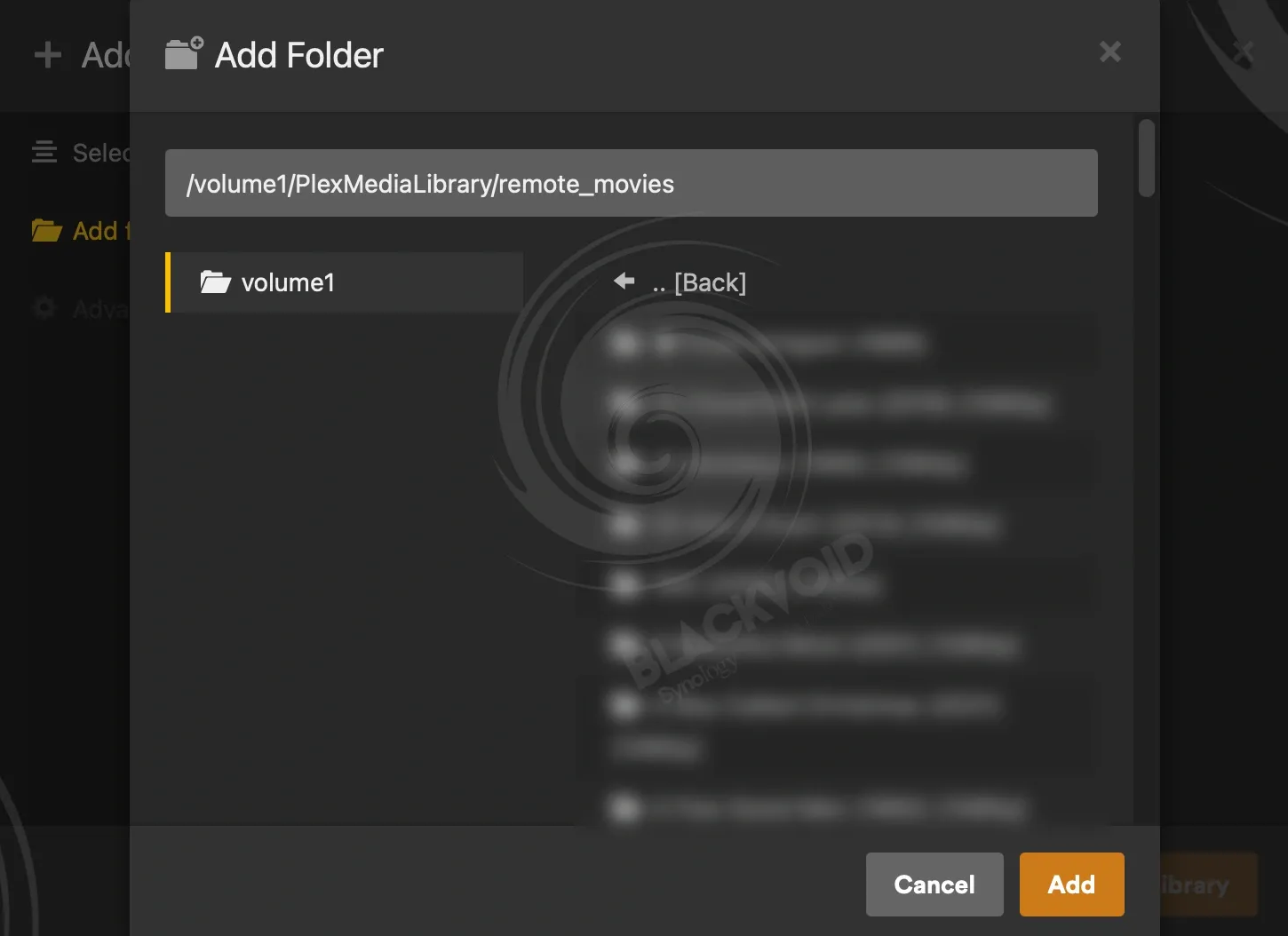

Having the option to run a Plex server on a $440 device that also supports multi-user environments, backup, and sync operations is quite a good deal, especially if we expand its capabilities in this manner.
In a word, Beestation Plus is a more than capable Plex server, and while it lacks disk redundancy and capacity, it can deliver a great media streaming experience.
: Mobile BeeFiles and BeePhotos apps
A complete Beestation experience would not be whole without a mobile app, or in this case, two. While editing and configuring Beestation through the web interface or desktop app is a given, accessing the content itself is optimally done via a mobile device. Over the past eighteen months, BeeFiles and BeePhotos have received some updates; however, these updates have not been substantial, as most functionalities are carried over from the existing mobile versions of Synology Drive and Synology Photos.
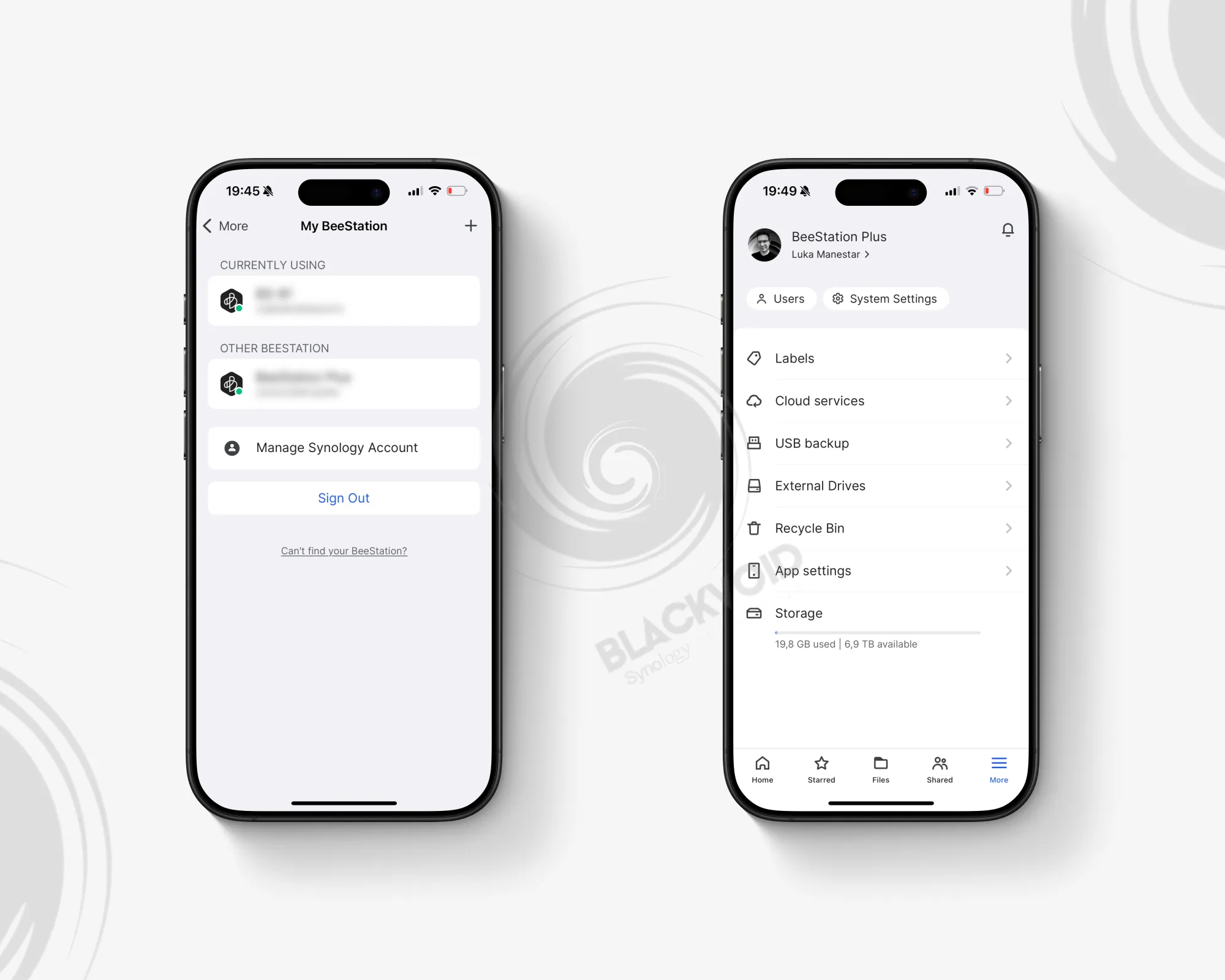
The apps provide all the expected features to manage general file formats, as well as images and videos with BeePhotos. However, they are not yet capable of configuring all the settings and features available through the web interface.


Based on the user's needs, one can browse, search, share, and stream any file. The entire experience is modern, streamlined, and distinctive in visual presentation compared to other Synology mobile apps. As anticipated, the mobile apps align with the visual theme of the BSM system.
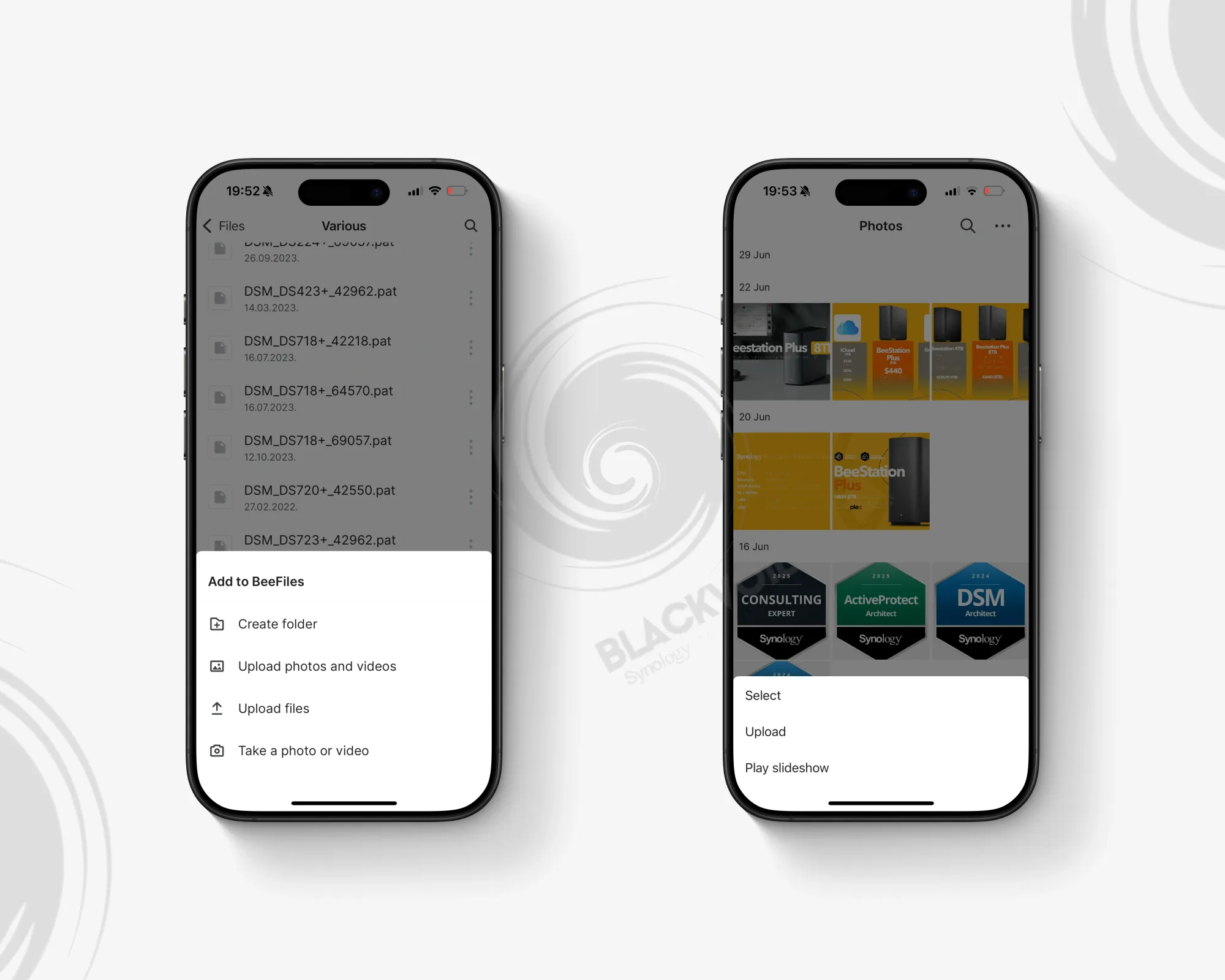
Regarding performance, the overall look and feel are satisfactory, though there's a slight issue with the BeePhotos browsing experience. Viewing photos and videos is not problematic, but quickly flipping through a large section of items results in a delay as thumbnails take time to generate.
While this might be anticipated, revisiting the same content often results in thumbnails being regenerated, which negatively impacts the user experience. To be clear, there is no significant lag, but it is noticeable enough to detract from a completely smooth experience.
It's important to note that the album view, unlike the timeline, does not encounter the same issues, so browsing through them provides a great user experience.
The following video will provide a clearer insight into this experience. For context, all images are in WEBP format with an average size of approximately 500KB.
Demo of BeePhotos performance
A similar experience can be observed when using the upcoming BeeDrive Deep Search interface, which I hope will see performance improvements, as a comparable visual browsing experience is evident there. Although this is not a deal breaker, it could be a concern for those expecting to swiftly browse the timeline view.
While BSM only offers two mobile apps, the previously mentioned Plex server effectively acts as a third app for consuming content hosted on the Beestation. This is, of course, contingent on having Plex integration enabled on the Beestation, but it is worth mentioning.
Plex is not a Synology app, as you're likely aware, and, therefore, it is not part of the BSM update cycle. The mobile Plex experience is undergoing changes as Plex Inc. rolls out a new UI and UX from the ground up. Although the interface is not yet available on all platforms, it has been released for mobile devices.
Any issues in this regard should be attributed to the mobile Plex app rather than BSM or Beestation. Having tested it for some time, I can confirm that bugs persist, regardless of the Plex server device in use.
: Conclusion
With BeeFiles, BeePhotos, and Plex, users effectively have a $400 device that transcends basic sharing, backup, and sync capabilities. It also streams a wide array of media, including movies, TV shows, music, audiobooks, and more. This makes the Beestation Plus an ideal device for home and prosumer users seeking a simple, turnkey solution.
The Beestation Plus stands out with its simple three-step setup, out-of-the-box configuration, multi-user support, and backup capabilities, making it a central choice among solutions, including some offered by Synology. While it may lack an additional drive for redundancy or more storage, it compensates for this with its simplicity and feature set.
However, Beestation Plus isn't for everyone. Tech enthusiasts seeking to tinker with installations or explore various apps may need to consider other solutions, as this closed, proprietary platform might not meet their long-term needs. For example, while the Intel Celeron J4125 could theoretically support Docker capabilities, as seen in other Synology NAS devices, that would contradict the core philosophy of the Beestation.
Potential users should be aware of the Beestation's features and limitations. Although there are limitations, the Plus model has advanced the series in the right direction, likely leading to positive feedback from future customers. Built on the tried and true DSM NAS platform, the BSM offers a streamlined user experience with a plethora of features, packed into a compact, silent, fast, and secure self-hosting solution.
While the "cloud" may be the future for many scenarios, the Beestation Plus offers a platform for a modest price that anyone can utilize without extensive IT skills, ensuring your personal and private data remains exactly that—yours and private.
